‘48
01
Willi Donnell Smith is born on February 29 in Philadelphia, Pennsylvania to Willie Lee Smith, an ironworker, and June Eileen Smith, an artist and homemaker.
‘63
01
Smith attends Jules E. Mastbaum Technical High School in Philadelphia and begins his first job as an illustrator for the dress shop Prudence and Strickler.
Related Articles
︎ Prudence Harvey Recollection
‘64
01
Smith takes a class in fashion illustration at the Philadelphia Museum College of Art.
Related Articles
︎ Alvin Bell Recollection
‘65
01
Designer Arnold Scaasi hires Smith as an apprentice.
02
Smith enrolls in the fashion design program at Parsons School of Design with two scholarships and takes liberal arts classes at New York University.
Related Articles
︎ Bonnie Brownfield Recollection
WilliWear to Streetwear
Jonathan Michael Square
 Willi Smith for Digits, Fall/Winter 1972 Collection, 1972
Willi Smith for Digits, Fall/Winter 1972 Collection, 1972
Willi Smith was an industry wunderkind when he spotted
Bethann Hardison on the corner of Broadway and 40th
Street. He admired her style and assumed that she was a
designer. “At that time, my style wasn’t very girly. It was
just really sporty,” said Hardison.1 One of Smith’s assistants arranged for Hardison to visit his showroom, and
Smith asked her to join his design team. Upon learning
that she was a showroom assistant at Ruth Manchester
Ltd., he asked her to model for him, initiating a friendship
that would last until his death.
This encounter between Smith and Hardison encapsulates Smith’s design process, which was fueled by the individuality and eclectic styles that saturated the streets of New York City in the seventies and eighties. “People who wear WilliWear clothes make fashion,” Smith told Morning Call in 1984. “I feel the person who wears my clothes is the person who wants to express himself . . . he doesn’t want to be intimidated by clothing.”2 In Hardison’s words, “You used to see WilliWear everywhere. It was a brand that you would see everyone wearing on the street. That’s why editors started referring to it as streetwear.”3
Under the umbrella of what was then sportswear, Smith’s reverb loop with the street set in motion streetwear, a moniker that has been interpreted and misinterpreted ever since. Streetwear, as molded by Smith, was an inclusive term that aimed to democratize the way fashion was consumed and experienced. But despite Smith’s popularization of streetwear, or “street couture” as he came to call it, his influence on the category has been overshadowed by brands emerging in the nineties that were closely associated with hip-hop culture, such as FUBU and Karl Kani.
This encounter between Smith and Hardison encapsulates Smith’s design process, which was fueled by the individuality and eclectic styles that saturated the streets of New York City in the seventies and eighties. “People who wear WilliWear clothes make fashion,” Smith told Morning Call in 1984. “I feel the person who wears my clothes is the person who wants to express himself . . . he doesn’t want to be intimidated by clothing.”2 In Hardison’s words, “You used to see WilliWear everywhere. It was a brand that you would see everyone wearing on the street. That’s why editors started referring to it as streetwear.”3
Under the umbrella of what was then sportswear, Smith’s reverb loop with the street set in motion streetwear, a moniker that has been interpreted and misinterpreted ever since. Streetwear, as molded by Smith, was an inclusive term that aimed to democratize the way fashion was consumed and experienced. But despite Smith’s popularization of streetwear, or “street couture” as he came to call it, his influence on the category has been overshadowed by brands emerging in the nineties that were closely associated with hip-hop culture, such as FUBU and Karl Kani.
Although it is difficult to pinpoint when the dialogue
between the street and the fashion industry began,
various periods of fashion history exhibit mainstream
fashion sampling from subcultures and the working
class. Notable examples include the robe de gaulle
chemise dress inspired by the simplicity of peasant
clothing and first seen worn by Marie Antoinette in Vigée
Le Brun’s 1783 portrait of the queen, and Balenciaga’s
integration of aprons in his haute couture designs
during the fifties. Fueled by globalization, technological
innovation, and wars, American streetwear’s predecessor sportswear emerged during the late nineteenth century/early twentieth century as casual dress,
like the shirtwaist and activewear that provided alternatives to the contemporary high style of the late Victorian
and Edwardian periods. The breakdown of traditional
sociocultural divisions resulting from the youthquake,
the women’s movement, and the civil rights era accelerated the industry’s embrace of a more casual style and,
in some cases, antifashion within these communities.
Eventually, boundary-breaking baby boomers adapted
activewear, workwear, and military uniforms into their
wardrobes. They took these elements of dress outside of
their original contexts, subverted them into quotidian
style, and ultimately changed their meaning.4
“Streetwear, as molded by Smith, was an inclusive term that aimed to democratize the way fashion was consumed and experienced.”
Like countercultural youths in the sixties, seventies, and eighties, Smith welcomed nonconformity, but was also a garmento who cut his teeth on Seventh Avenue. After leaving Parsons, he landed his first major job at age twenty designing for Glenora, then sportswear brand Digits, where he led the label until 1973. When he formed WilliWear in 1976, Smith was settling in as part of the fashion establishment alongside designers like Halston, Perry Ellis, Anne Klein, and Giorgio Armani.
Smith’s take on streetwear was an eclectic yet irreverent twist on sportswear that elicited various identities from preppy silhouettes to billowing ensembles inspired by his passion for Indian and West African cultures. For example, his fall 1985 collection featured a plethora of themes, including colorful women’s suiting styled to transform the models into Spanish matadors juxtaposed against tapered plaid ensembles that emulated preppy country-club style. Smith focused on separates that allowed consumers to mix and match pieces from current and previous collections. He was a master of deconstructed suiting and had a penchant for gender-neutral silhouettes. He preferred plaids and stripes, bold prints and colors in natural, washable fibers that afforded the wearer both comfort and play.
 Willi Smith for Digits, Fall/Winter 1972 Collection, 1972
Willi Smith for Digits, Fall/Winter 1972 Collection, 1972Along with Arthur McGee, Scott Barrie, Patrick Kelly, and
Stephen Burrows, Smith worked at a time that welcomed
the creative perspective of African American designers.
He laid the groundwork for other designers of color interested in redefining who could have access to fashionable
designs. He told Women’s Wear Daily in 1972, “I have it
through my head now to give women simple, packaged
clothes that adapt to a lifestyle, rich or poor. People really
only need a few clothes. My idea is that a woman could go
into a store, pick up a pack in blue, green, and black and
in it would be five pieces that all work. The only change a
woman should have to make in her wardrobe for spring
into winter is a coat.”5
By designing pieces that favored a multitude of silhouettes, bodies, and gender identities, Smith was the first
designer to unite womenswear and menswear under the
same label.6 His gender-neutral designs extended to the
patterns he produced for Butterick and McCall’s, some
of which included images of men and women modeling
the same designs on the packaging and catalogue
editorial. He wanted his clothes to reach the widest
consumer base possible. Today, Smith’s fluid designs
would no doubt be championed and embraced by queer
and queer-allied consumers alike; they have influenced
labels that eschew gender norms, such as Eckhaus Latta,
Y/Project, Vaquera, and GmbH.
Parallel to and postdating the success of WilliWear, a
streetwear movement inspired by the early hip-hop
scene in New York City’s outer boroughs was accelerating. These Black-owned-and-designed labels like Cross
Colours, Karl Kani, and FUBU, which would become
popular shortly after Smith’s death, were formed outside
the fashion system. Smith, perhaps unwittingly, provided
a model for the success of these fashion companies.
Nineties streetwear designers Maurice Malone and April
Walker have both credited Smith for creating the first
bridge between the street and the runway,7 creating
fashion that was both inspired by and available to people
on the street.8
Today, luxury fashion and streetwear designers have joined forces. Designers like Virgil Abloh, Olivier Rousteing, and Kim Jones, who mix tailored suiting and couture-quality garments with T-shirts, sneakers, and hoodies, are leading Louis Vuitton, Balmain, and Dior. Brands like Supreme, A Bathing Ape (BAPE), and Kith have been elevated to luxury label status due, in part, to their overwhelming popularity among millennials and Gen Zers. Though these brands do not have the same affordable prices as WilliWear, the creators of these labels are driven to create fashion that reflects diverse audiences. Unlike early models of fashion, their aspirational luxury items are not inspired by or reserved solely for high-income consumers. Smith was the first to level the playing field.
Streetwear has come to describe a way of dressing among youth subcultures that is in contradistinction to—often in defiance of—high fashion. Although Smith was creating for and within traditional markets, he endeavored to refashion them for a wide and diverse audience through affordable collections and collaborations with music, art, and architecture. This model has been continuously reinterpreted and evolved by urban streetwear, high street, and luxury brands. Smith welcomed all to buy, wear, and enjoy his clothing, fueling a movement that is to this day helping us rethink accessibility and power in the fashion industry.
Jonathan Michael Square is a writer and professor of history at Harvard University, specializing in fashion and visual culture of the African diaspora. Square received a Ph.D. in history from New York University, a master’s from the University of Texas at Austin, and a bachelor’s from Cornell University.
Today, luxury fashion and streetwear designers have joined forces. Designers like Virgil Abloh, Olivier Rousteing, and Kim Jones, who mix tailored suiting and couture-quality garments with T-shirts, sneakers, and hoodies, are leading Louis Vuitton, Balmain, and Dior. Brands like Supreme, A Bathing Ape (BAPE), and Kith have been elevated to luxury label status due, in part, to their overwhelming popularity among millennials and Gen Zers. Though these brands do not have the same affordable prices as WilliWear, the creators of these labels are driven to create fashion that reflects diverse audiences. Unlike early models of fashion, their aspirational luxury items are not inspired by or reserved solely for high-income consumers. Smith was the first to level the playing field.
Streetwear has come to describe a way of dressing among youth subcultures that is in contradistinction to—often in defiance of—high fashion. Although Smith was creating for and within traditional markets, he endeavored to refashion them for a wide and diverse audience through affordable collections and collaborations with music, art, and architecture. This model has been continuously reinterpreted and evolved by urban streetwear, high street, and luxury brands. Smith welcomed all to buy, wear, and enjoy his clothing, fueling a movement that is to this day helping us rethink accessibility and power in the fashion industry.
Jonathan Michael Square is a writer and professor of history at Harvard University, specializing in fashion and visual culture of the African diaspora. Square received a Ph.D. in history from New York University, a master’s from the University of Texas at Austin, and a bachelor’s from Cornell University.
 Willi Smith for Digits, Fall/Winter 1972 Collection, 1972
Willi Smith for Digits, Fall/Winter 1972 Collection, 1972- Bethann Hardison, interviewed by the author, 6. June 11, 2019.
-
Polly Rayner, “WilliWear Designer Creates ‘Basic Clothes with a Sense of Humor,’” Morning Call 7. (October 21, 1984).
-
Bethann Hardison, interviewed by the author, July 12, 2019.
-
Ted Polhemus, “Street Wear,” in Encyclopedia of Clothing and Fashion, ed. Valerie Steele (Farmington Hills: Gale, Cengage Learning, 2004): 225–29; Jennifer Craik, “Fashioning Sports Clothing as Lifestyle Couture,” in Uniforms Exposed: From Conformity to Transgression (Oxford: Berg, 2005): 161–74.
-
Ki Hackney, “Willi,” Women’s Wear Daily (January 1, 8. 1972), 4–5.
-
Rajat Singh, “Fashion Flashback: Willi Smith,”
February 17, 2017, Link.
-
“Designers of the Hottest 90s Brands Assemble at
Liberty Fairs & Agenda Shows, Las Vegas,” September
10, 2018, Link; Taylor
Lovaas, “Maurice Malone Breaks Down Hip Hop and
Fashion History from Mojeans to the Hip Hop Shop
+ Gives Advice to Young Designers,” Aug. 19, 2016,
Link.
- Elena Romero, Free Stylin’: How Hip Hop Changed the Fashion Industry (Santa Barbara, CA: Praeger Publishers, 2012), x.
To Be American
Dario Calmese
In contrast to the restrictive and fantastical designs of the European fashion houses during his time, Willi Smith’s WilliWear exuded and evolved the core tenets of American design: comfort, utility, and durability. His garments sat alongside Calvin Klein and Donna Karan in Vogue spreads, and his loose, easy separates were a favorite among Japanese women seeking to emulate the relatively liberated lives of their U.S. counterparts. His suiting draped the shoulders of artist Edwin Schlossberg, the bridegroom of America’s princess, Caroline Kennedy, on their wedding day1 (a sly nod to Ann Lowe, the “Negro dressmaker” who designed the wedding gown for her mother, Jacqueline Kennedy Onassis). And his keen adoption of cross-disciplinary collaborations and new media amplified the mass appeal of WilliWear’s democratic vision. Smith established a new archetype for U.S. design values that led to an internationally successful brand. So why have Black Americans continually struggled to maintain a foothold in the world of fashion design?
“It’s so hard to make the Black girls look expensive,” recalls designer Charles Harbison, referring to a conversation during his days as an assistant at Michael Kors. The brand had requested a Black model to come in for a fitting but was stumped deciding on a look that would elevate her enough for the show. “That experience stuck with me,” he said. Class, race, and aspiration have always collided within fashion; a spectacle to induce desire. Coded in the language of Harbison’s quote is the question, “Who would desire to be Black?”
“It’s so hard to make the Black girls look expensive,” recalls designer Charles Harbison, referring to a conversation during his days as an assistant at Michael Kors. The brand had requested a Black model to come in for a fitting but was stumped deciding on a look that would elevate her enough for the show. “That experience stuck with me,” he said. Class, race, and aspiration have always collided within fashion; a spectacle to induce desire. Coded in the language of Harbison’s quote is the question, “Who would desire to be Black?”
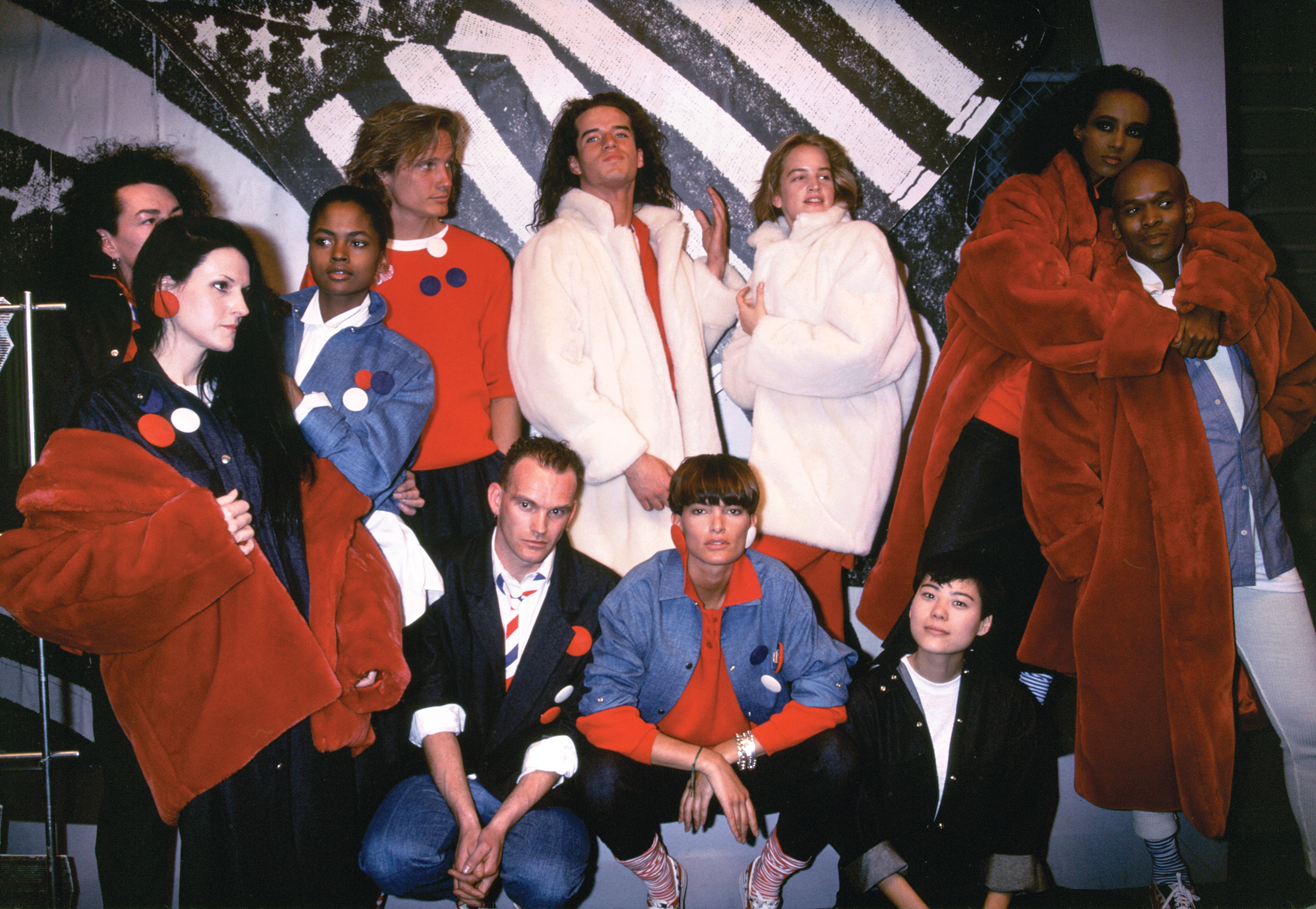 Willi Smith for WilliWear, Fall 1985 Presentation, Photographed by Peter Gould, 1985
Willi Smith for WilliWear, Fall 1985 Presentation, Photographed by Peter Gould, 1985

Willi Smith for WilliWear, Spring 1986 Presentation, Photographed by Peter Gould, 1985
In the introduction to his book of collected essays, Notes of a Native Son, James Baldwin admits his internalized disdain for Negroes “because they failed to produce Rembrandt.”2 Reinterpreted in the world of U.S. fashion, one can ask, “Where is our Ralph Lauren?” However, the history of the fashion system and, more importantly, the history of the United States make that answer painstakingly clear. Since the late Middle Ages, fashion represented a concept of luxury, doused in opulent materials and stringent social protocol that was exclusive to aristocratic communities. “It was society ladies who put hats on other society ladies,” remarked fashion photographer Richard Avedon, referencing the style customs prominent in America and abroad at the funeral of his longtime collaborator, revered fashion editor Diana Vreeland.3 The term “society” is key to understanding that the fashion system was not constructed with Black people in mind. Avedon’s fateful meeting with Vreeland predated by two decades the Voting Rights Act of 1965, a piece of legislation meant to guarantee Black people full integration into U.S. society. Our Rembrandts have and do exist, but their creations have often been distributed through channels that dilute the source: Mary Todd Lincoln’s exquisite gowns, unattributed on lists of America’s most fashionable first ladies, were designed by Elizabeth Keckley, a former enslaved person; the wrap dress now associated with Diane Von Furstenberg began in Stephen Burrows’s studio. History is controlled by those in power.
Fashion is a hungry baby, and brands rely heavily on a motley crew of editors, writers, photographers, and investors to endorse brands. Today’s fashion shows cost upwards of $300,000, not including runway sample or staff salaries.4 Access to capital is the hobgoblin of the industry and can cripple designers, regardless of race; however, Black designers have often been held to a different standard, expected to convince investors that they have the taste level to dress society ladies as well as the acumen to run a sustainable business. Less than five percent of the Council of Fashion Designers of America (CFDA) members are Black.5
From Women’s Wear Daily’s sixties proclamation of the “Black explosion” to the miscategorization of many contemporary designers as “streetwear,” industry press coverage has been a double-edged sword, giving Black designers much-needed publicity while ghettoizing Black fashion production.6 “It’s upsetting, you know,” says Kerby Jean-Raymond, creative director of Pyer Moss in a 2016 interview with Elle magazine.7 “I’ve never seen Ralph Lauren, Rick Owens, or Raf Simons described as white designers.” In reference to the contemporary fashion press’s penchant for tossing Black design into the streetwear category, Jean-Raymond muses, “I just want to know what’s being called ‘street’—the clothes or me?” By continually categorizing designers based on race, the fashion press not only negates Black pluralism, but also flattens the dimensionality of their lives, experience, and creative output. Smith himself became weary of the monodimensional acknowledgment of designers of color. “You know, in the sixties and seventies there was this tremendous exposure given to designers based on their Blackness,” he states in a 1981 interview with Black Enterprise. “When the hype was over, people thought there were no more Black designers. In a way, it’s a blessing. Now we can get on with being what we are—designers.”8
Fashion is a hungry baby, and brands rely heavily on a motley crew of editors, writers, photographers, and investors to endorse brands. Today’s fashion shows cost upwards of $300,000, not including runway sample or staff salaries.4 Access to capital is the hobgoblin of the industry and can cripple designers, regardless of race; however, Black designers have often been held to a different standard, expected to convince investors that they have the taste level to dress society ladies as well as the acumen to run a sustainable business. Less than five percent of the Council of Fashion Designers of America (CFDA) members are Black.5
From Women’s Wear Daily’s sixties proclamation of the “Black explosion” to the miscategorization of many contemporary designers as “streetwear,” industry press coverage has been a double-edged sword, giving Black designers much-needed publicity while ghettoizing Black fashion production.6 “It’s upsetting, you know,” says Kerby Jean-Raymond, creative director of Pyer Moss in a 2016 interview with Elle magazine.7 “I’ve never seen Ralph Lauren, Rick Owens, or Raf Simons described as white designers.” In reference to the contemporary fashion press’s penchant for tossing Black design into the streetwear category, Jean-Raymond muses, “I just want to know what’s being called ‘street’—the clothes or me?” By continually categorizing designers based on race, the fashion press not only negates Black pluralism, but also flattens the dimensionality of their lives, experience, and creative output. Smith himself became weary of the monodimensional acknowledgment of designers of color. “You know, in the sixties and seventies there was this tremendous exposure given to designers based on their Blackness,” he states in a 1981 interview with Black Enterprise. “When the hype was over, people thought there were no more Black designers. In a way, it’s a blessing. Now we can get on with being what we are—designers.”8
At the time of Smith’s death, WilliWear generated more
than $25 million per year ($55 million in 2019 dollars)
and was carried in more than 1,100 global stores.9 Smith
subverted the spectacle Guy Debord described as the “unreal unity” masking “the class division on which the
real unity of the capitalist mode of production rests.”10 Via WilliWear, Smith upended the class divisions inherent
in the history of fashion by designing clothes not for the
queen but “for those who waved at her from the sidelines.”
His loose, liberated designs enhanced all body types, and
pieces were sold affordably. Beneath his genial manner,
Smith’s agenda was clear. “Who made the rule that everything in America that’s not expensive has to be horrible?”
he proclaimed to the Washington Post.11 Growing up watching the ways in which his mother and grandmother fashioned themselves, he understood that great style did not have to come at a great cost. The street, not bourgeois tastes, dictated trends. WilliWear flattened the fashion authority, undermining its aspirational reach and coating the white gaze with a Black aesthetic.
“When the hype was over, people thought there were no more Black designers. In a way, it’s a blessing. Now we can get on with being what we are—designers.”
In the nineties, after Smith’s passing, the garment
industry experienced a financial slump, which created a
space for voices that did not come through the traditional
fashion system. Brands like Karl Kani, Russell Simmons’s
Phat Farm, FUBU, and Cross Colours blossomed, epitomizing what was then called the “urban market.” Backed
by garmentos and the music industry, these brands
redefined streetwear and infused the industry with much
needed capital. This delineation between “fashion” and “streetwear” gave rise to brands like Sean Combs’s Sean
John and Baby Phat by Kimora Lee Simmons, which
sought to fuse the two worlds (Sean Combs went on to
win the CFDA Menswear Designer of the Year Award in
2004). Like Smith, they brought fashion to the streets, but while Smith designed for a broader clientele and
occasionally drew inspiration from Black culture, these
brands unapologetically centered Blackness in their
design aesthetic, branding, and target audience. However,
this alternative aesthetic, combined with a general lack of appreciation for the nuances of Blackness—within
fashion and America at large—would mark future Black
designers as “urban” despite their creative output.
The success of today’s cadre of Black designers continues to rely on subverting the fashion system. For his spring 2015 show, Jean-Raymond screened a fourteen-minute video showcasing police brutality before one model touched the runway with blood-splattered shoes. Virgil Abloh of Off-White and Louis Vuitton (LV) menswear used social media to usurp the fashion industry gatekeepers until the establishent itself came calling. Dapper Dan appropriated the codes of luxury by screen-printing LV and Gucci logos onto leather goods after the brands refused to allow him to sell their designs legitimately, a “hack” that predated LV ’s prêt-à porter line by thirteen years. He currently has his own Gucci atelier in Harlem. Even the demure Grace Wales Bonner engages the African diaspora through the lens of academia to quietly rewrite the codes of Black masculinity and reclaim the richness of Black culture via the American sportswear tradition. Donning loose, easy separates mixed with razor-sharp tailoring inspired by critical theory and Afro-Atlantic histories, her boyish and fey models not only redefined fashion’s ideal Black male (e.g., Tyson Beckford), but gave new voice to refinement Black peoples have always known and exhibited.
The history of fashion has been dominated by eurocentrism, hailing figures from Phillip the Good down to Alexander McQueen. Designed to advance privilege, the industry has repeatedly devalued the impact of Black peoples and Black culture. Smith’s efforts to connect art and industry, market through new media, and catalyze lifestyle and experience to create brand value laid the groundwork for the diverse voices breaking through industry protocol today. Contemporary Black designers are claiming their place in fashion history and the industry at large by writing a new narrative—not by those who control it, but by those who live it. Not for the queen, but for “those who wave at her from the sidelines.” This is America(n[a]).
The history of fashion has been dominated by eurocentrism, hailing figures from Phillip the Good down to Alexander McQueen. Designed to advance privilege, the industry has repeatedly devalued the impact of Black peoples and Black culture. Smith’s efforts to connect art and industry, market through new media, and catalyze lifestyle and experience to create brand value laid the groundwork for the diverse voices breaking through industry protocol today. Contemporary Black designers are claiming their place in fashion history and the industry at large by writing a new narrative—not by those who control it, but by those who live it. Not for the queen, but for “those who wave at her from the sidelines.” This is America(n[a]).
Dario Calmese is an artist, writer, director, and brand consultant currently based in New York City whose clients range from brands such as Pyer Moss and LaQuan Smith to publications including Vanity Fair and Numéro.
- Teresa M. Hanafin, “A Kennedy Is Wed, an Era Remembered,” Boston Globe (July 20, 1986).
- James Baldwin, opening essay in Notes of a Native Son (New York: Beacon Press, 1955)
- Michael Gross, The Secret, Sexy, Sometimes Sordid World of Fashions (New York: Atria Books, 2016).
- Fawnia Soo Hoo, “What a runway show really costs,” Vogue Business (February 5, 2019), Link.
- “CFDA Members,” CFDA, accessed June 1, 2019, Link.
- Sheila Banik, “Cutting on the Bias,” Black Enterprise 11, no. 12 (1981).
- Jessica Andrews, “Pyer Moss Designer Kerby Jean-Raymond Hates Being Labeled Streetwear,” Elle (February 12, 2016), Link.
- Banik, ibid.
- “Designer Willi Smith Dies,” Baltimore Afro-American (April 25, 1987).
- Guy Debord, The Society of the Spectacle (France: Buchet-Chastel, 1967).
- Gerri Hirshey, “Willi’s Way,” Washington Post Magazine, Style Section (1986).
Wedding Dress for the Black Fashion Museum
Elaine Nichols and Adrienne Jones
 Willi Smith, Wedding Ensemble, ca. 1976–79
Willi Smith, Wedding Ensemble, ca. 1976–79
Throughout their lives, Willi Smith and Lois Alexander Lane worked in parallel to make fashion an inclusive and diverse industry. Smith advocated for the power of personal expression through his adaptable and affordable designs, while Alexander Lane built foundation for African American achievement in fashion. Various examples of Smith’s designs, including an unusual bridal ensemble, are preserved in Alexander Lane’s Black Fashion Museum (BFM) collection, which was donated to the Smithsonian Museum of African American History and Culture in 2007 by Alexander Lane and her daughter Joyce Bailey.
Beginning in the late sixties, Alexander Lane created community-driven institutions that educated and promoted young, aspiring fashion designers. In 1966, she founded the Harlem Institute of Fashion (HIF) to teach African American students Black history, ways to improve their reading, writing, and math skills, and how to navigate the fashion industry.1 In 1979, Alexander Lane established the BFM to provide visual proof that African Americans contributed to the world of fashion from the period of slavery to the modern era. Her work as a historian, organizer, and activist nurtured and preserved Black fashion history. The BFM collection serves as an invaluable resource for understanding the works of Ann Lowe, Geoffrey Holder, Patrick Kelly, Stephen Burrows, and Willi Smith, among many others.2
In 1981, Alexander Lane mounted a seminal exhibition at the BFM entitled Bridal Gowns by Black Designers. Among the numerous traditional gowns was Willi Smith’s rajah-style cotton satin jacket and beige-colored velveteen jodhpurs. It captured the progressive spirit of the time, boldly bent the lines of gender, identity, and cultural dress, and challenged standards for one of society’s most sacred global ceremonies.3
Beginning in the late sixties, Alexander Lane created community-driven institutions that educated and promoted young, aspiring fashion designers. In 1966, she founded the Harlem Institute of Fashion (HIF) to teach African American students Black history, ways to improve their reading, writing, and math skills, and how to navigate the fashion industry.1 In 1979, Alexander Lane established the BFM to provide visual proof that African Americans contributed to the world of fashion from the period of slavery to the modern era. Her work as a historian, organizer, and activist nurtured and preserved Black fashion history. The BFM collection serves as an invaluable resource for understanding the works of Ann Lowe, Geoffrey Holder, Patrick Kelly, Stephen Burrows, and Willi Smith, among many others.2
In 1981, Alexander Lane mounted a seminal exhibition at the BFM entitled Bridal Gowns by Black Designers. Among the numerous traditional gowns was Willi Smith’s rajah-style cotton satin jacket and beige-colored velveteen jodhpurs. It captured the progressive spirit of the time, boldly bent the lines of gender, identity, and cultural dress, and challenged standards for one of society’s most sacred global ceremonies.3
Though little is known about what motivated Smith’s design of the BFM ensemble, possible influences include his experience as a protégé of noted couturier Arthur McGee, whose own non-traditional bridal wear quoted numerous Asian aesthetics, and Smith’s well-documented business and personal interests in India. Smith’s frequent trips to Bombay to oversee design and production with WilliWear manufacturers led to collections that borrowed from traditional Indian garments, such as turbans, cholis, saris, and salwar kameez. His interpretation of dhoti pants became a WilliWear icon.
Like these early WilliWear designs, the BFM ensemble includes an admixture of what were accepted as male and female symbols of dress interpreted through a global lens. The coat resembles a man’s sherwani with a Nehru collar and five functional buttons on the left placket. In the seventies when this jacket was made, placement of buttons on the left side of a garment indicated that it was intended for female wearers. Another symbol of femininity is the jacket’s delicately gathered and flared skirt with a narrow matching belt that, when tied, hangs almost the complete length of the skirt. A decade later, Smith added a headdress by David Madison. Made of pussy willow, statice, and chair caning, this unconventional accessory resembles a woman’s fifties/sixties round, bucket-style or floral pouf hat. The ensemble is completed by masculine pants, more specifically jodhpurs—riding trousers named for a city in the state of Rajasthan in northern India, and historically worn by men of royal or noble birth for weddings, formal occasions, and sporting events.
Like these early WilliWear designs, the BFM ensemble includes an admixture of what were accepted as male and female symbols of dress interpreted through a global lens. The coat resembles a man’s sherwani with a Nehru collar and five functional buttons on the left placket. In the seventies when this jacket was made, placement of buttons on the left side of a garment indicated that it was intended for female wearers. Another symbol of femininity is the jacket’s delicately gathered and flared skirt with a narrow matching belt that, when tied, hangs almost the complete length of the skirt. A decade later, Smith added a headdress by David Madison. Made of pussy willow, statice, and chair caning, this unconventional accessory resembles a woman’s fifties/sixties round, bucket-style or floral pouf hat. The ensemble is completed by masculine pants, more specifically jodhpurs—riding trousers named for a city in the state of Rajasthan in northern India, and historically worn by men of royal or noble birth for weddings, formal occasions, and sporting events.
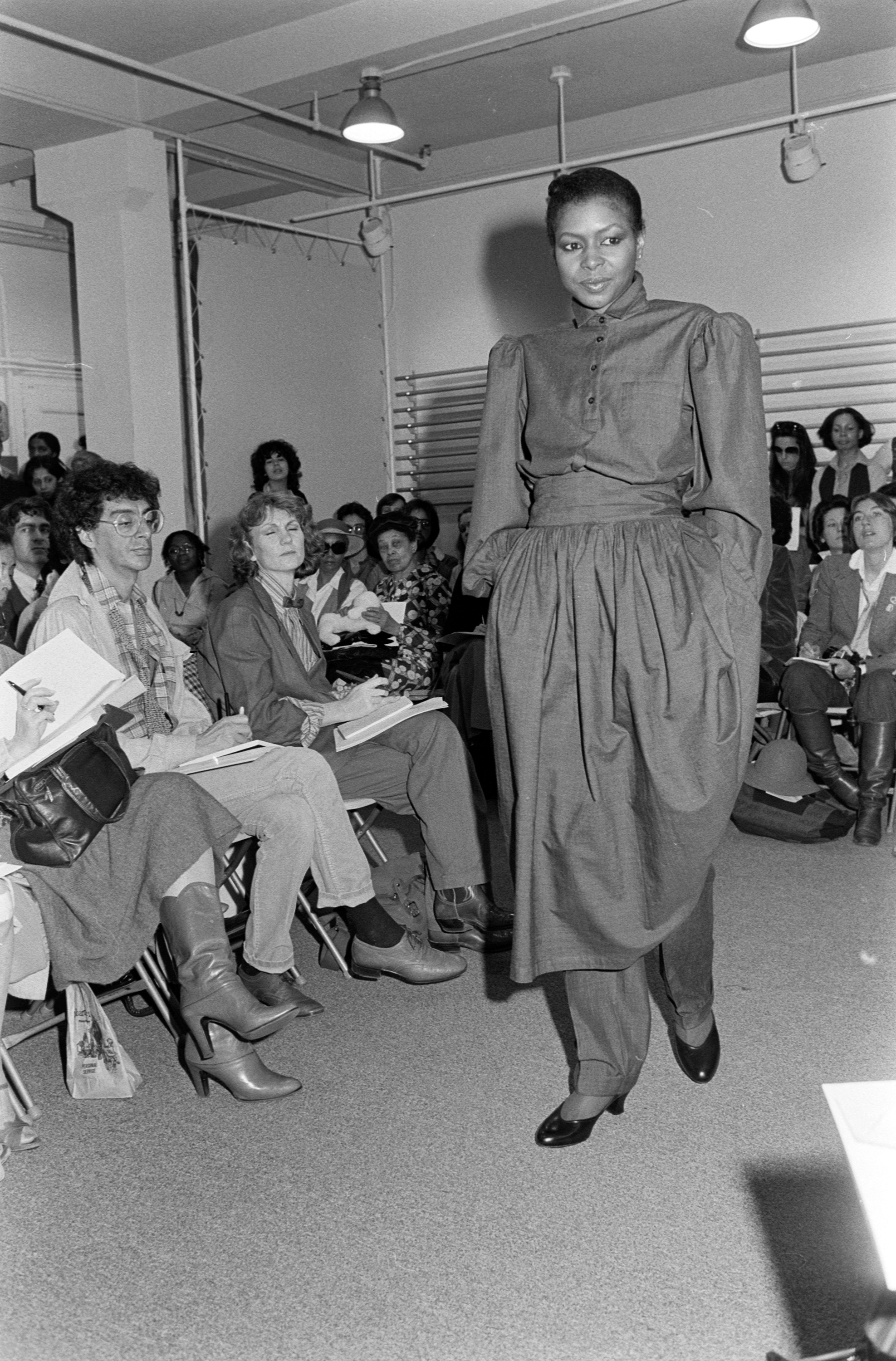
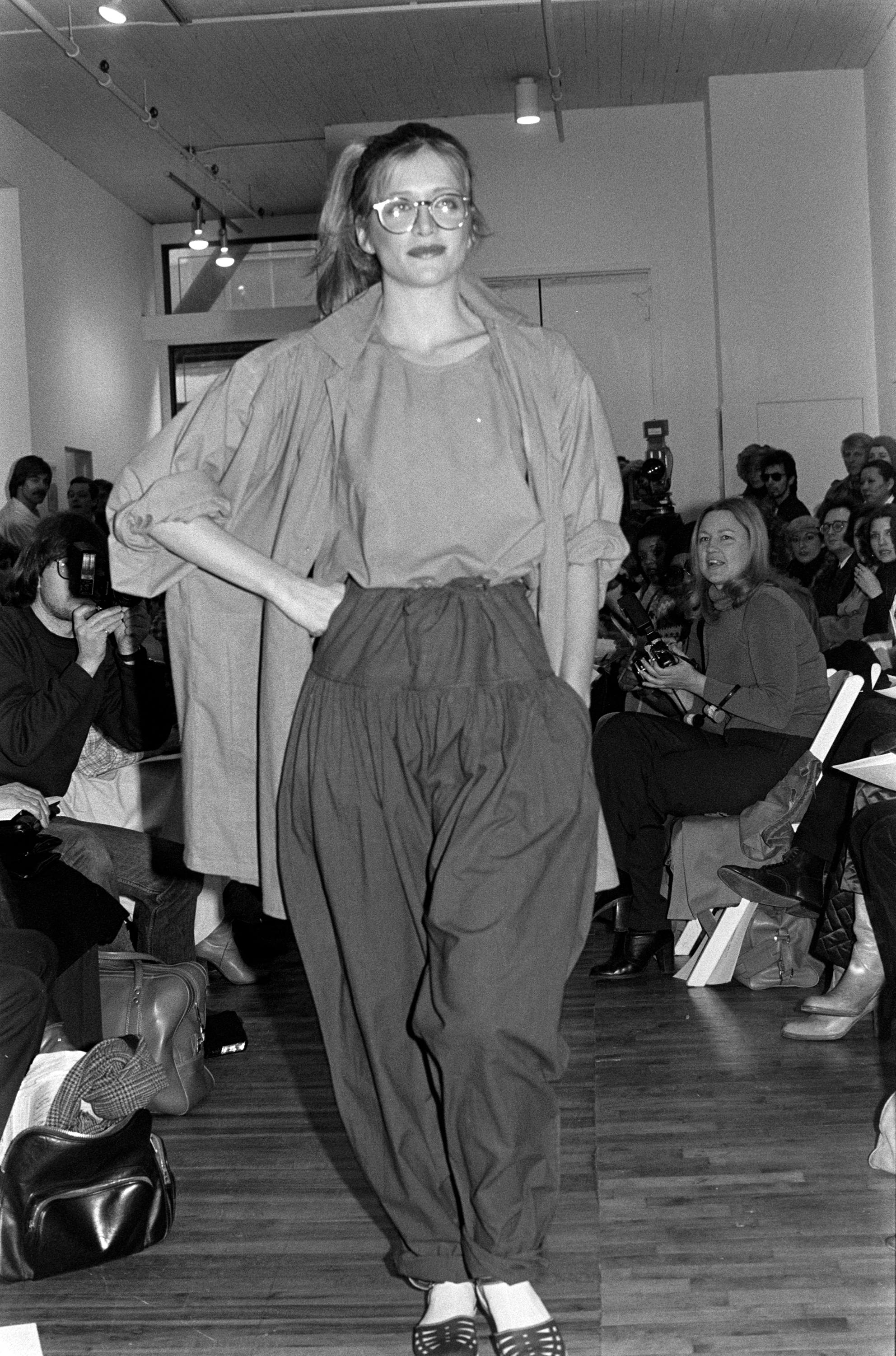
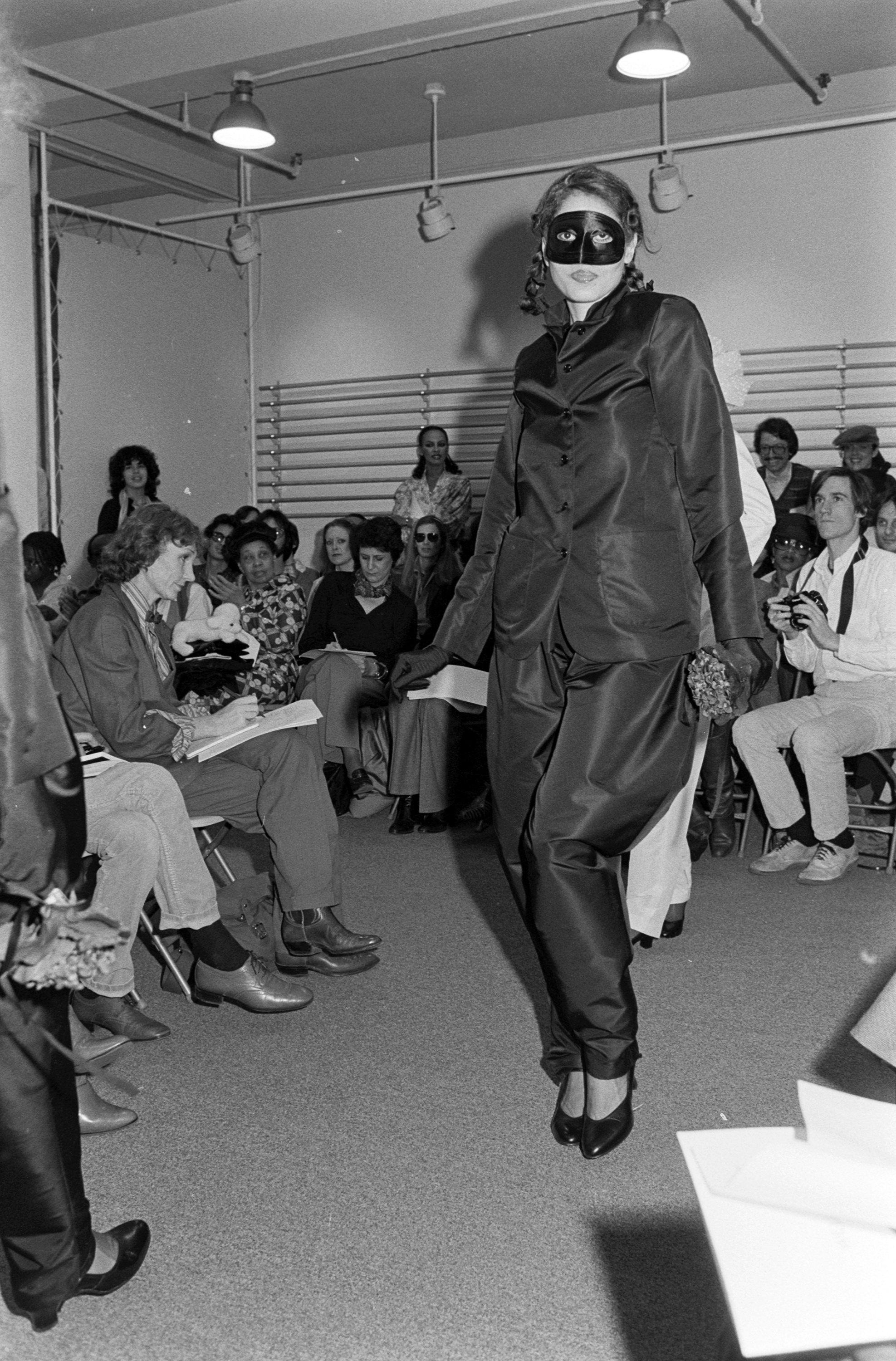
Willi Smith for WilliWear, Fall 1978 Presentation, 1978
Although WilliWear was recognized for its gender fluidity, Smith typically used the opportunity to design wedding attire for friends and collaborators to indulge in ultra feminine silhouettes with high necks, bare shoulders, and voluminous fishtails layered in silk and tulle. Smith’s rajah wedding ensemble is a rare example of his moving away from Western matrimonial traditions. It represents stylistic, gendered, and ethnic inclusion, personal empowerment, and “control of the self by the wearer,” rather than subversive resistance to the norm.4 This celebration of individuality and freedom of expression is what made Smith one of the most successful designers of his time.
Elaine Nichols is the supervisory curator of culture at the Smithsonian National Museum of African American History and Culture (NMAAHC). Nichols has also worked at the South Carolina State Museum as curator of history.
Adrienne Jones is a professor at Pratt Institute. Jones holds degrees in Art Therapy (M.S.), Art Education (B.S.), Fashion Design (A.A.S.), and has won many awards and honors, including being presented with the Innovative Visionary Icon of the Decade by African American Wome in Cinema, in 2015.
Adrienne Jones is a professor at Pratt Institute. Jones holds degrees in Art Therapy (M.S.), Art Education (B.S.), Fashion Design (A.A.S.), and has won many awards and honors, including being presented with the Innovative Visionary Icon of the Decade by African American Wome in Cinema, in 2015.
- Elaine Nichols, “Something Beautiful and Useful: The Work of Lois Kindle Alexander Lane and the Black Fashion Museum Collection at the NMAAHC,” unpublished research paper, April 27, 2015; Renee Minus White, “Harlem Institute of Fashion: Focus on Fashion,” New York Amsterdam News (October 30, 1976), Link.
- Nichols, ibid.
-
Ozeil Fryer Woolcock, “Social Swirl: Black Fashion Museum Founder Was in Atlanta,” Atlanta Daily World (September 20, 1981), Link; BFM Archives, NMAAHC, “A Stitch in Time, 1800−2000,” Box 150, Folder 2, #12.
- Carol Tulloch, “‘My Man, Let Me Pull Your Coat to Something’: Malcolm X,” in The Birth of Cool: Style Narratives of the African Diaspora (London: Bloomsbury Academic, 2016), 127-50.
Attitudes
Horacio Silva
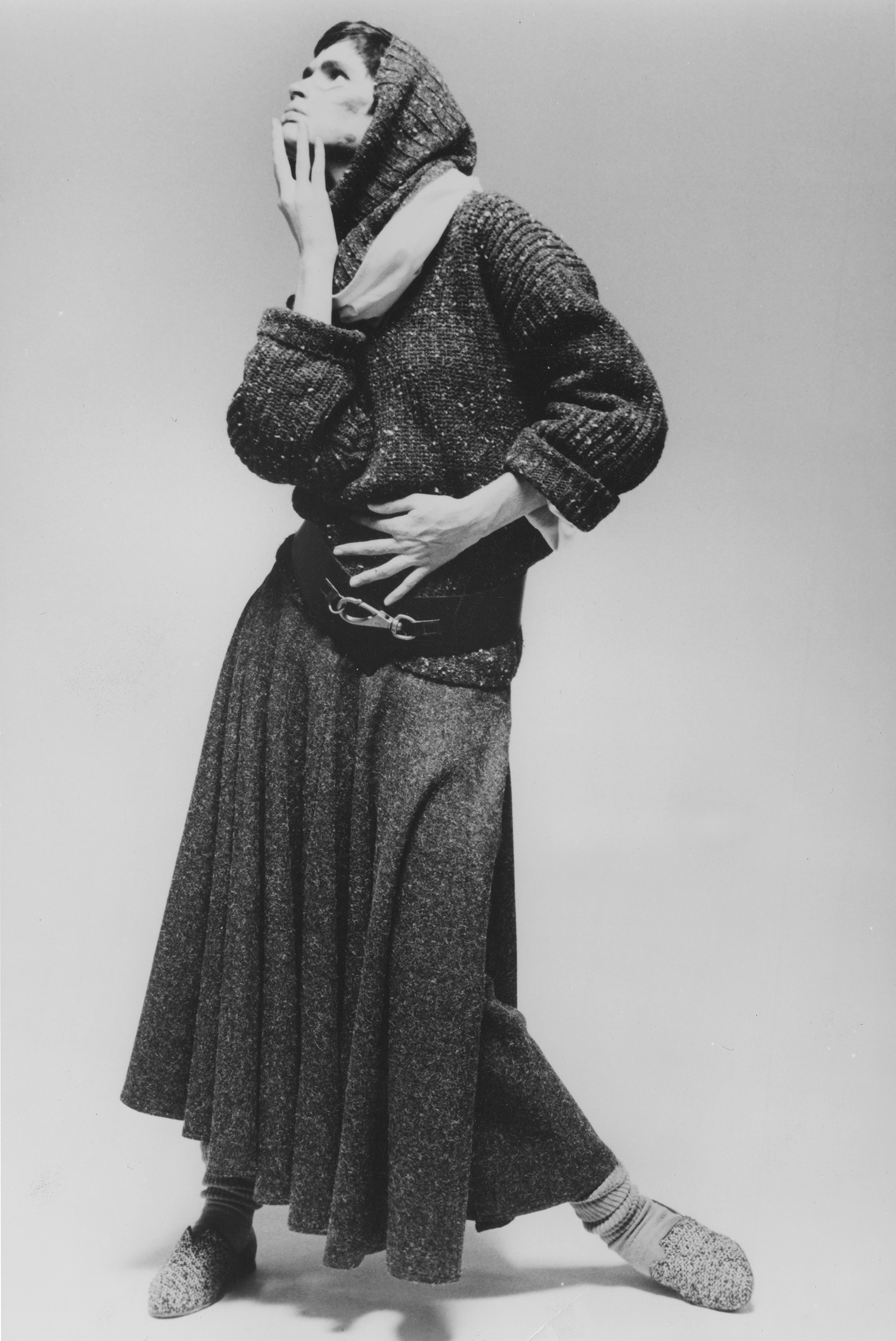 Willi Smith for WilliWear, SUB-Urban Fall 1984 Collection, Photographed by Max Vadukul, 1984
Willi Smith for WilliWear, SUB-Urban Fall 1984 Collection, Photographed by Max Vadukul, 1984Willi Smith, a product of the pop era, was influenced by agenda-setting visionaries like Malcolm McLaren, Andy Warhol, David Bowie, and the clamor and glamour of his beloved Harlem church ladies. His fashion presentations also suggested a love of drag ball culture, a budding scene whose efflorescence coincided with Smith’s move to New York in 1965.
Friends recall his being a Harlem habitué and a regular at drag dives like the Gilded Grape. Fittingly, his collections were often broken down into sections whose nomenclature—Varsity, Work Epic, Renegades, Igloo—bring to mind the categories of the balls. It’s hard not to hear the hyperarticulated, stentorian pronouncements of ball emcees when reading WilliWear program notes: “drill cloth, poplin, corduroy” and “architectural outerwear ready for layering.”
Horacio Silva is the head of content and special projects for Metrograph and is a renowned writer and editor for the world’s most prestigious publications and brands.
Friends recall his being a Harlem habitué and a regular at drag dives like the Gilded Grape. Fittingly, his collections were often broken down into sections whose nomenclature—Varsity, Work Epic, Renegades, Igloo—bring to mind the categories of the balls. It’s hard not to hear the hyperarticulated, stentorian pronouncements of ball emcees when reading WilliWear program notes: “drill cloth, poplin, corduroy” and “architectural outerwear ready for layering.”
Horacio Silva is the head of content and special projects for Metrograph and is a renowned writer and editor for the world’s most prestigious publications and brands.

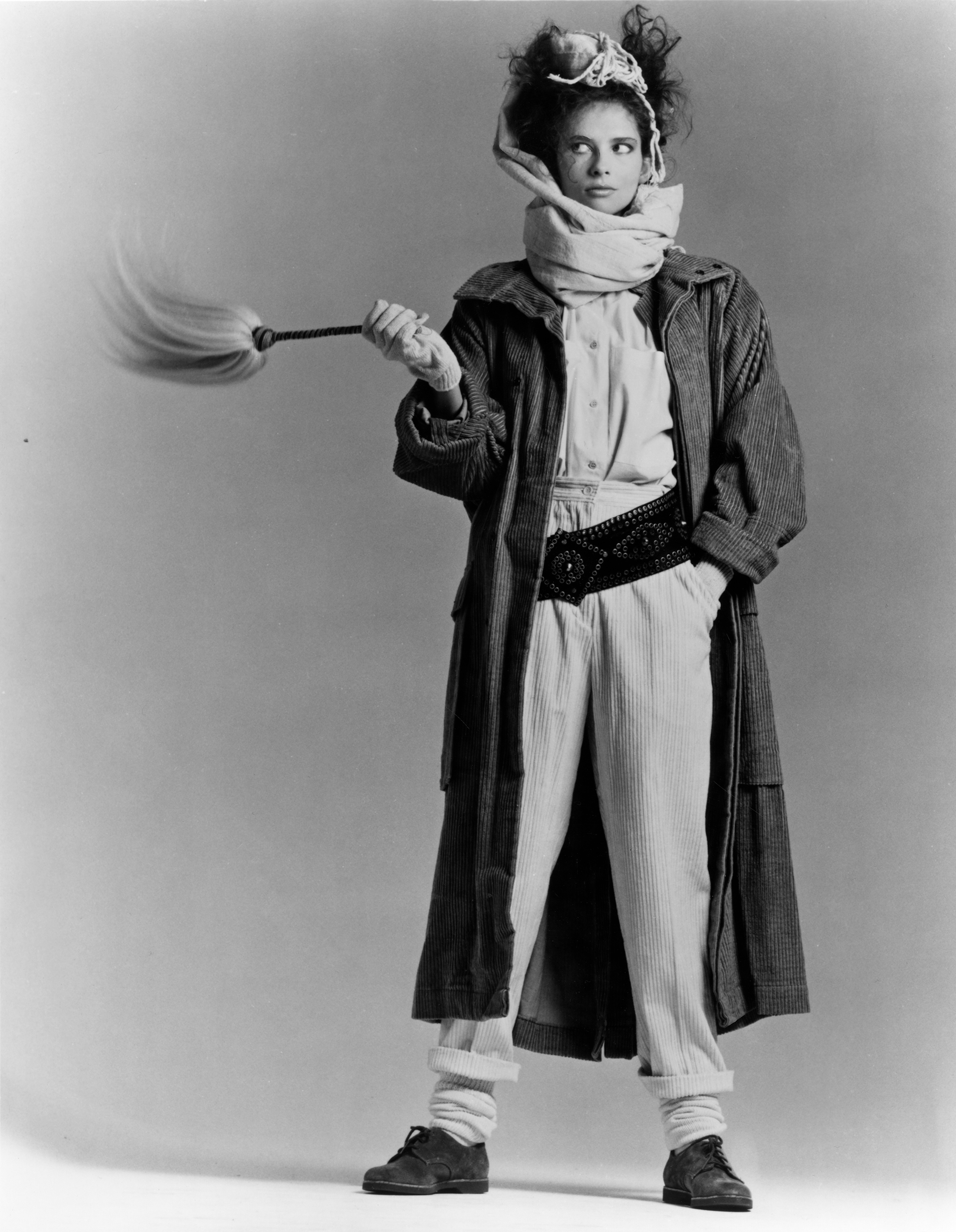





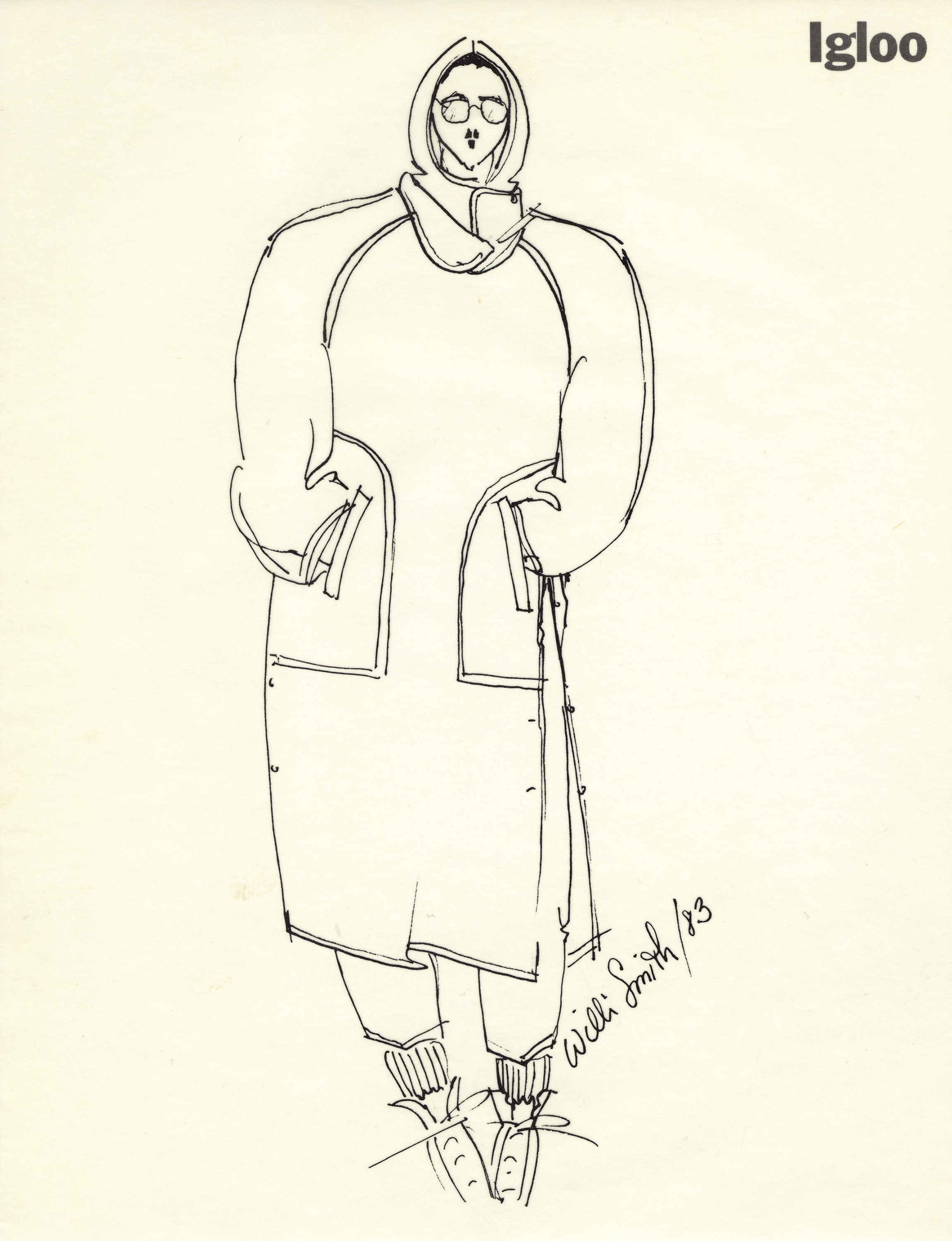
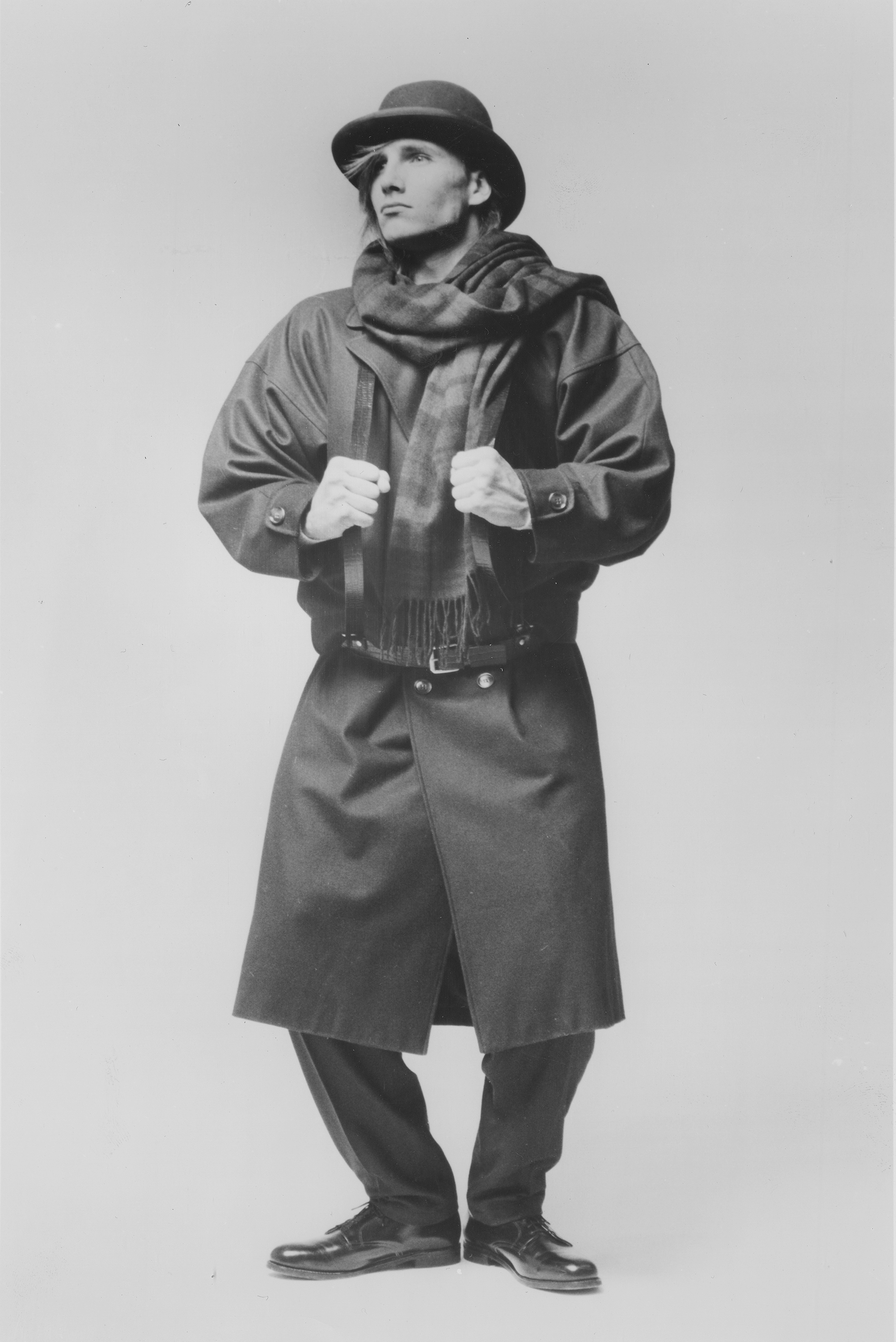

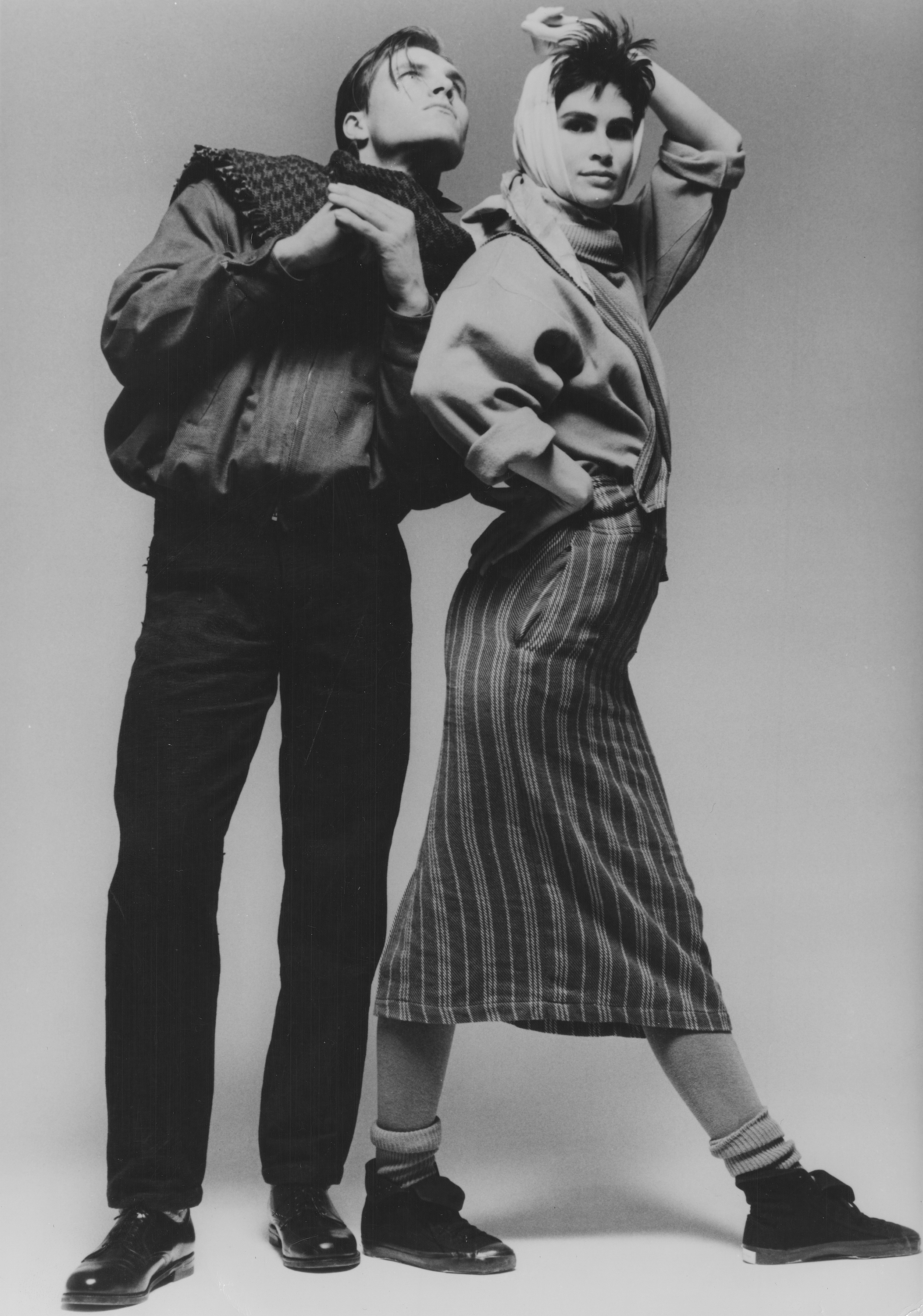



The Greatest Showman
Horacio Silva
 Willi Smith for WilliWear, Fall 1985 Collection, Photographed by Peter Gould, 1985
Willi Smith for WilliWear, Fall 1985 Collection, Photographed by Peter Gould, 1985
A Merlin of Midtown, possessed of the can-do moxie of a Broadway
producer, Willi Smith was a pioneering conjurer of glamour and spectacle whose
influence lives on in the experiential multidisciplinary offerings of today’s genre-bending
designers and cultural producers, from Council of Fashion Designers of America/Vogue
Fashion Fund winner Telfar Clemens to Kanye West and Baz Luhrmann.
Beyond wanting to simply dazzle the eye, Smith was a masterful media manipulator who used every arrow in his quiver to bring his artful message to the masses. In the pre-internet era, before style had highjacked culture, before the star-crossed love affair of the fashion and art worlds, Smith knew full well that these pyrotechnics would help to amplify his message.
WilliWear fashion shows were considered to be more performance art than runway outing, and with good reason. Smith is often compared to his eighties American contemporaries such as Betsey Johnson and Perry Ellis, but in truth he shared more in common with emerging enfants terribles of European fashion Franco Moschino and Thierry Mugler—showmen who, with their increasingly performative runway presentations in Milan and Paris, respectively, were applying the defib paddles to the clinically dead shows of the time.
Beyond wanting to simply dazzle the eye, Smith was a masterful media manipulator who used every arrow in his quiver to bring his artful message to the masses. In the pre-internet era, before style had highjacked culture, before the star-crossed love affair of the fashion and art worlds, Smith knew full well that these pyrotechnics would help to amplify his message.
WilliWear fashion shows were considered to be more performance art than runway outing, and with good reason. Smith is often compared to his eighties American contemporaries such as Betsey Johnson and Perry Ellis, but in truth he shared more in common with emerging enfants terribles of European fashion Franco Moschino and Thierry Mugler—showmen who, with their increasingly performative runway presentations in Milan and Paris, respectively, were applying the defib paddles to the clinically dead shows of the time.
Smith rejected the lifeless legacy of the couture salon with its
soporific music, hippy swagger, and death-stare froideur, preferring instead to
collaborate with artists from all disciplines—most notably with the pioneering
video artists Juan Downey and Nam June Paik—decades before the word
“collaboration” became as hollow as “luxury.”
Though practically unheard of in New York fashion at the time (save for Halston’s shenanigans, which once included Lily Auchincloss’s frying bacon on the runway), Smith’s harnessing of drama and theatrical vision in the pursuit of high-impact fashion moments, his playing limbo with the markers of fashion and art, and his willingness to expand the fashion project into a broad church of creativity are today de rigueur.
Horacio Silva is the head of content and special projects for Metrograph and is a renowned writer and editor for the world’s most prestigious publications and brands.
Though practically unheard of in New York fashion at the time (save for Halston’s shenanigans, which once included Lily Auchincloss’s frying bacon on the runway), Smith’s harnessing of drama and theatrical vision in the pursuit of high-impact fashion moments, his playing limbo with the markers of fashion and art, and his willingness to expand the fashion project into a broad church of creativity are today de rigueur.
Horacio Silva is the head of content and special projects for Metrograph and is a renowned writer and editor for the world’s most prestigious publications and brands.
 Willi Smith for WilliWear, Spring/Summer 1987 Presentation, 1986
Willi Smith for WilliWear, Spring/Summer 1987 Presentation, 1986



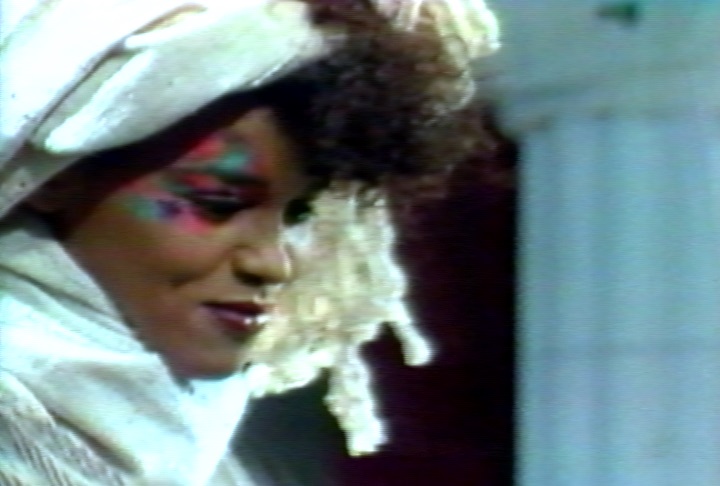








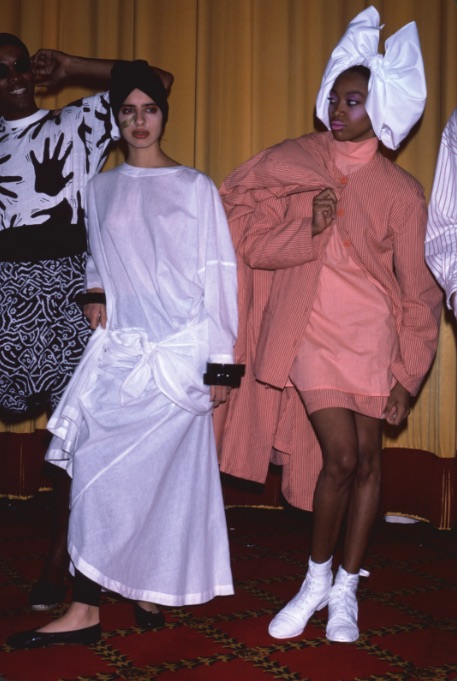


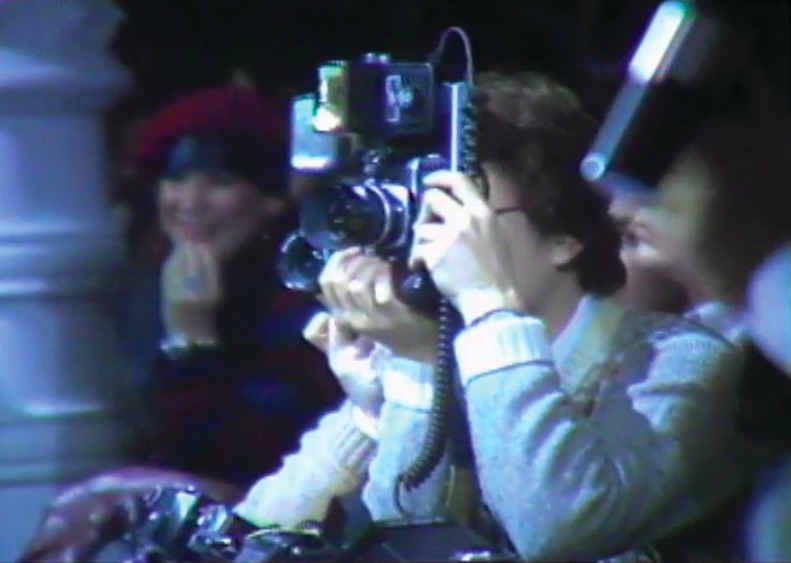


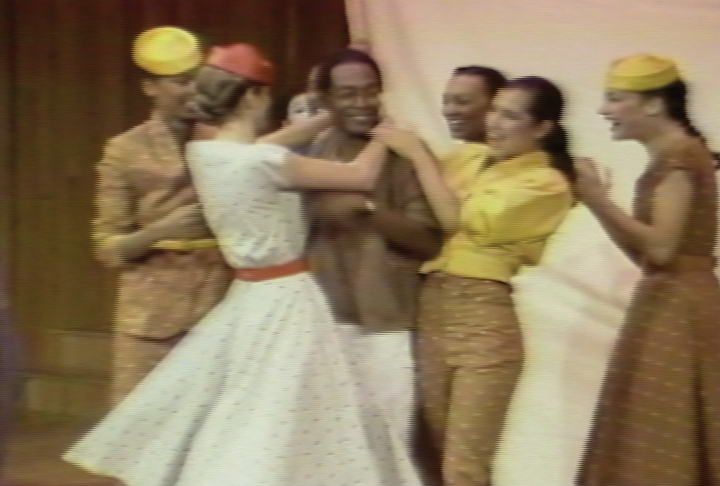
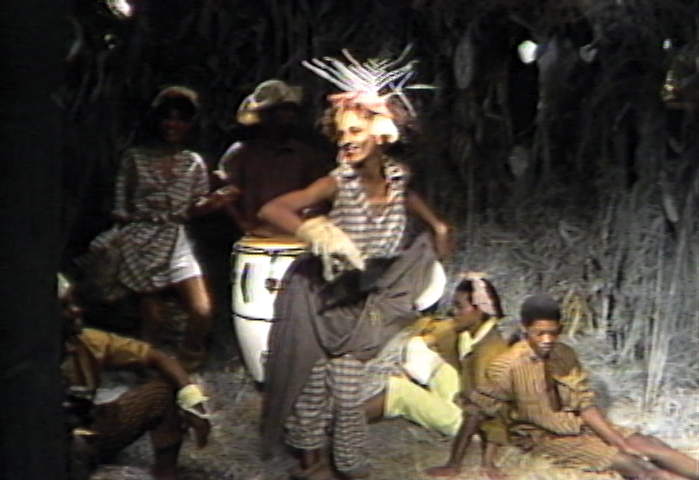
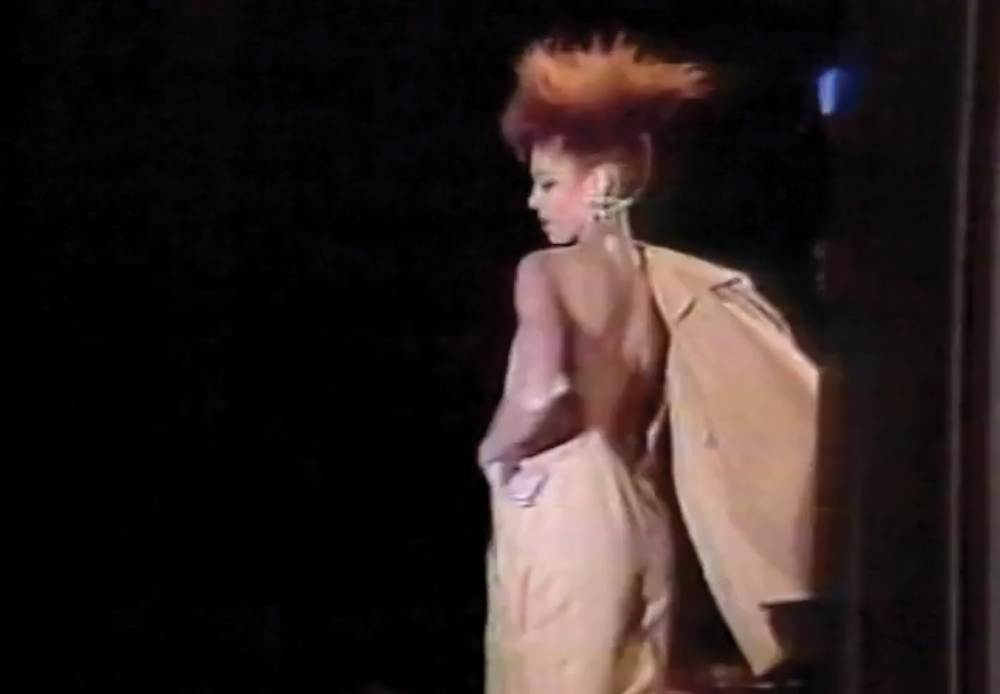


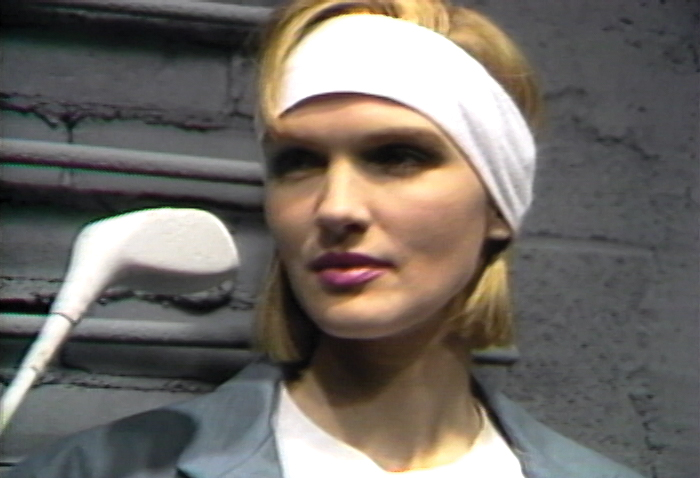

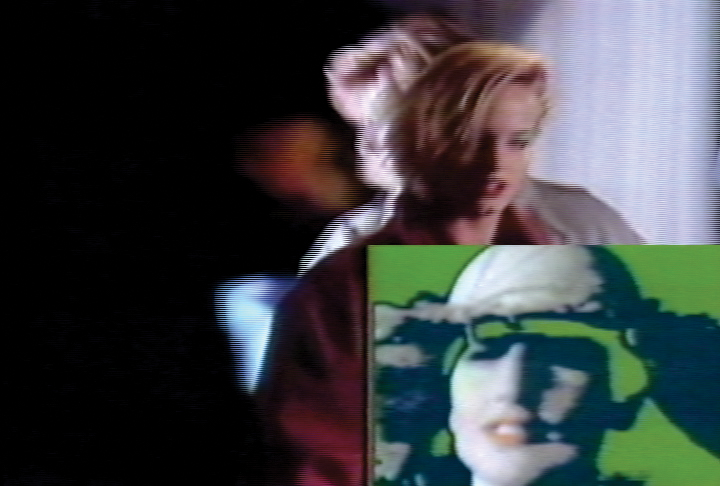
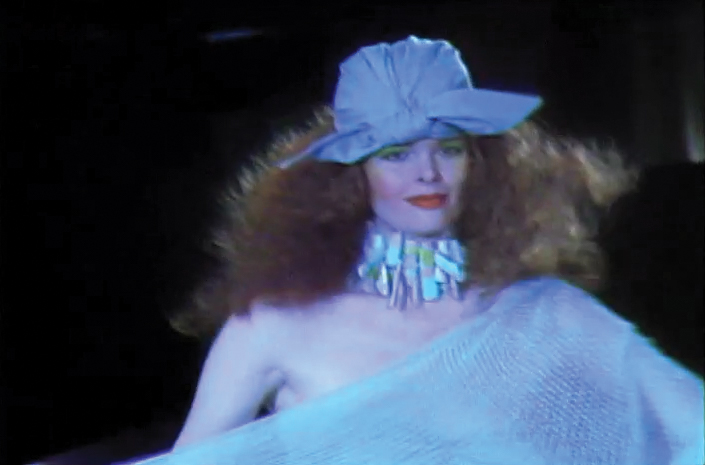
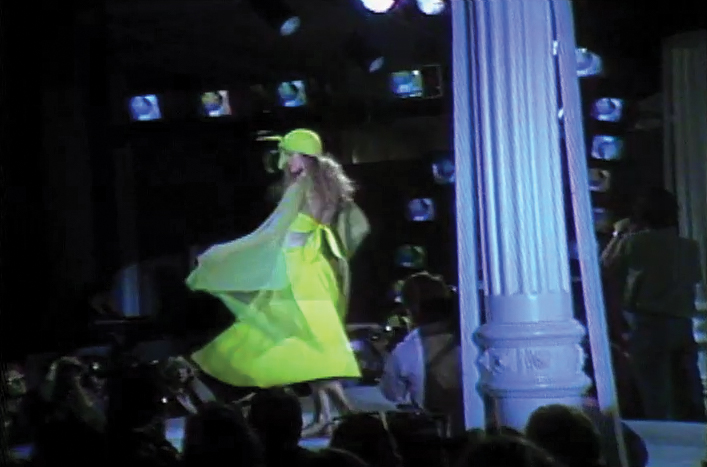
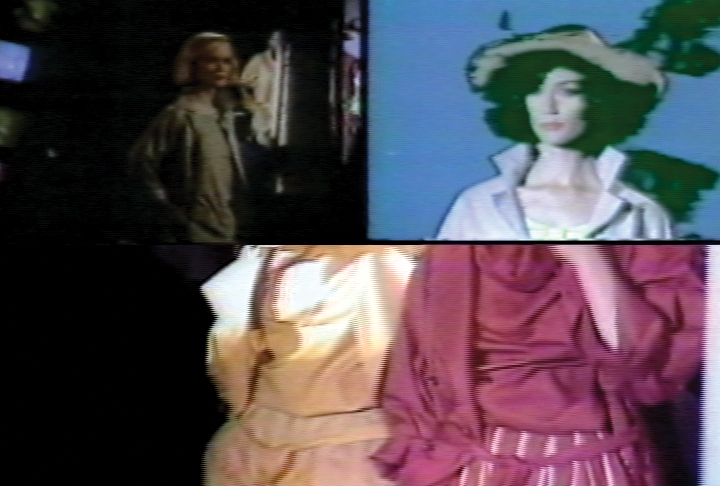


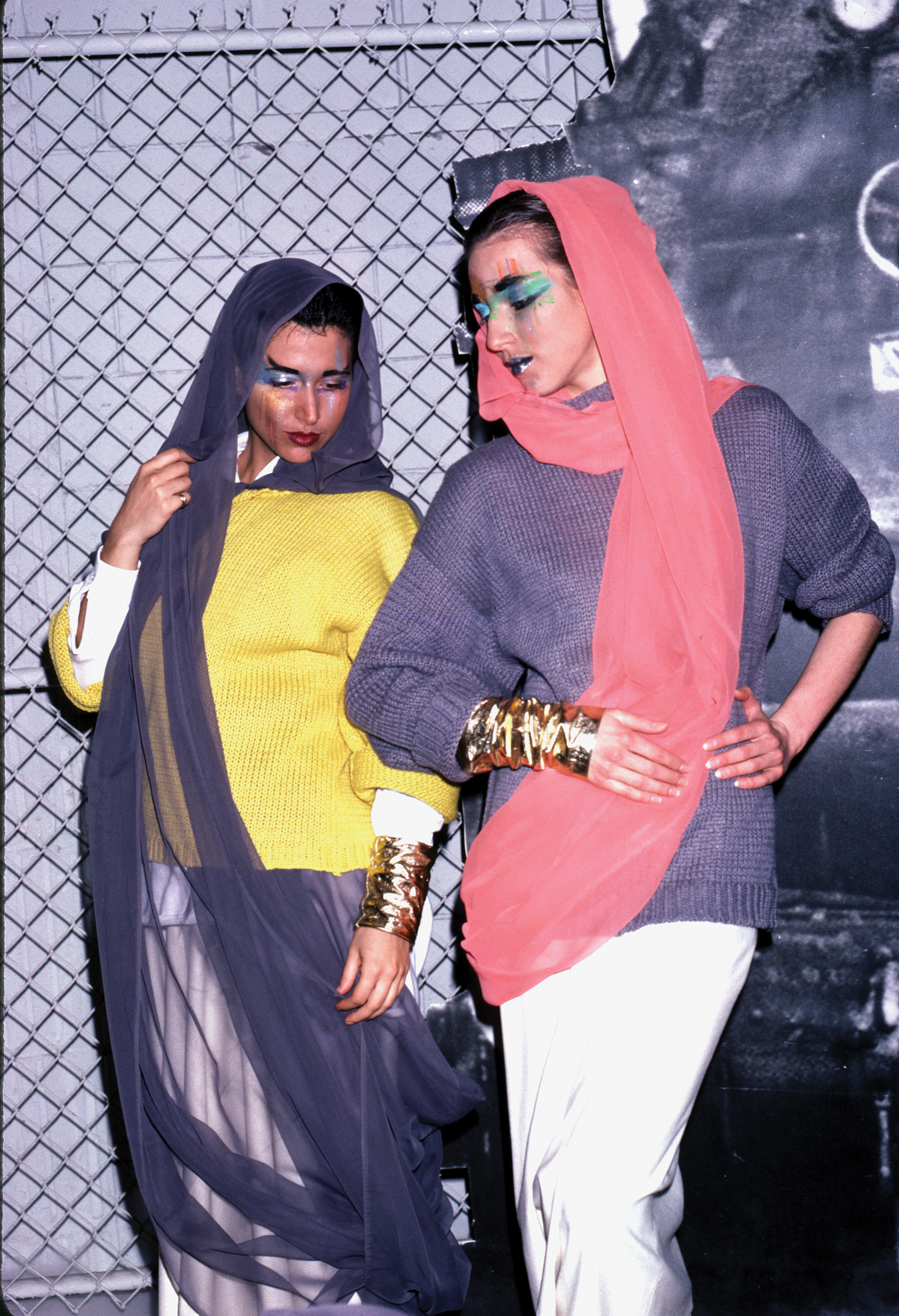

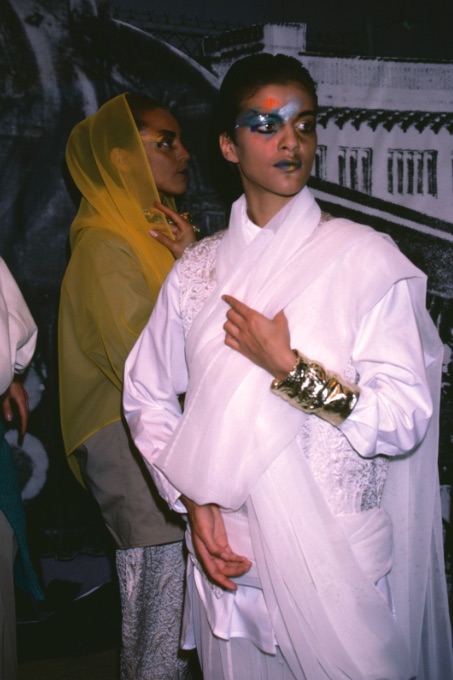
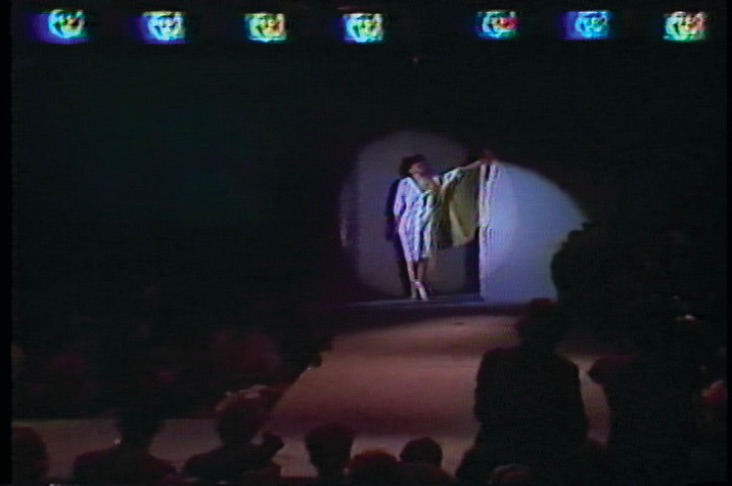
Willi Smith for WilliWear, City Island
Spring 1984 Presentation, 1983

Willi Smith for WilliWear, City Island
Spring 1984 Presentation, 1983

Willi Smith for WilliWear, Fall 1985 Presentation,
Photographed by Peter Gould, 1985

Willi Smith for WilliWear, Street Couture
Fall 1983 Presentation, 1983
Bill T. Jones on Secret Pastures
Interview by Kelly Elaine Navies
 Bill T. Jones and Arnie Zane, Promotional Photography for
Secret Pastures, Photographed by Tom Caravaglia, 1984
Bill T. Jones and Arnie Zane, Promotional Photography for
Secret Pastures, Photographed by Tom Caravaglia, 1984Bill T. Jones and Willi Smith came together on two
seminal projects: Secret Pastures, a production of the Bill T. Jones/Arnie Zane Dance Company, and Made in
New York, a short film by Les Levine. In both cases, Smith
provided garments that facilitated the action, basic cuts
that moved without overpowering the meaning of the
movement. Beyond their professional exchange, Jones
and Smith experienced similar struggles as creative
visionaries who were Black, gay, and victims of the AIDS
epidemic. This excerpted conversation with Jones was
conducted by Kelly Elaine Navies, museum specialist of
oral history, as part of the National Museum of African
American History and Culture’s Oral History Initiative,
which documents, collects, and preserves oral histories
of iconic elders of African Americana and others who have
shaped the culture in significant ways.
Kelly Elaine Navies:
Bill T. Jones:
Kelly Elaine Navies:
Who brought you and Willi Smith together?
Bill T. Jones:
I don’t remember the first meeting with Willi Smith. I just knew that we were being put together by the Brooklyn Academy of Music (BAM) to work on Secret Pastures for the Next Wave Festival. You know, you were just assigned a costume designer in those days. I remember that Willi was the kind of Black man that I didn’t know. A sophisticated, accomplished, gay Black man. But he was playing that kind of celebrity game, as well. The BAM Producers Council was formed to pull together various successful, glamorous people to support BAM’s growing mission. And the Next Wave brought in performers like me and Arnie Zane, who were just entry level. I mean, had I ever performed at an opera house before or on a big stage? No. They made that possible. And they put Willi into it.
KEN:
And this is how Secret Pastures evolved?BTJ:
Secret Pastures. We thought it was an incredibly sophisticated, tongue-in-cheek title referencing soap operas. You know, As the World Turns. It was going to be called a quasi-narrative, something outlandish like An Island in the Pacific, Artificial Man. I am this kind of hulking Frankenstein-type creature that Arnie, the professor, has made and activated. And he’s going to take me with a group of other people, who were our company. We were gonna explore this island and so on. Keith Haring, who was a friend, sort of said, “Yeah. Yeah.” He was down for anything. He would do the decor. He would make the posters and so on. And Willi knew Keith. Willi was in the scene, and see, Keith, at that point, was probably on the cover of five art magazines—Art in America, Art Forum, ARTnews. He was on all of those covers. Willi was sort of in his milieu. Fashion, you know. And why not the costumes? I think you’ve probably read that the opening night of Secret Pastures was an event. I remember Madonna was there with Andy Warhol. These were Keith’s friends. Then there’s Willi Smith, who was doing the costumes. So there was a fashion angle to it. And our company, who had just been rolling around on the stage, doing this kind of odd gymnastics with a formatless attention, we were suddenly being photographed and on the cover of Dance Magazine. It all happened so fast.
KEN:
BTJ:
What do you remember about the interactions with Willi Smith and Keith Haring and the collaboration overall?
BTJ:
In addition to designing the costumes, Willi brought in Marcel Fieve, who was Belgian and a very adventurous hairdresser. Nobody in the dance world was thinking about hair and makeup except Twyla Tharp, and Twyla was an outlier. She didn’t want anything to do with the downtown world, and the downtown world didn’t want anything more to do with her since she’d already done that, in her mind, ten or fifteen years before. I remember that the opening night at BAM, Keith and Tim Carr [the programming consultant for Next Wave] were so scandalous, because the program they had printed up said “Hair and Makeup by Marcel Fieve.” So everybody who opened the program just fell on the floor and said, “Oh. Look at that. That says it all. ‘Hair and makeup.’ They’ve lost their soul. Our Bill and Arnie have really lost their soul.” ’Cause we’re doing hair and makeup. But, you know, souls are lost and found. And we were darlings, but we were also very ambitious.
KEN:
BTJ:
Were you attracted to Willi Smith’s style? Did you wear WilliWear?
BTJ:
I was attracted to the concept of WilliWear—that he was trying to look at the street and make fashion. That he would wanna work with us. That he was a successful man. Long stretch limousine. But he had a drug problem. He’d just cleaned up from it, I believe. And we would talk about things. I had never had a Black friend I could talk to about “What does it mean?” “Why are you in an interracial relationship?” And I remember him saying to me—I respect his memory, but I think he would appreciate me telling this story—“Look, man. You know, I had a Black lover. I did. But it turned into colored business. In the middle of the night, the police were coming. Somebody’s been called. We’re fighting and so on and so forth. You know?” And then he said, “And I wasn’t interested in being a white princess. ’Cause, you know, let’s face it. In a lot of those relationships, I was like the white guys. I was more educated, had more money. So you find some young dude, Black dude, and you become the white princess, and he becomes your stud.” And he said he wasn’t interested in that. Very strong language. Oh, yeah. It was wonderful.
KEN:
BTJ:
KEN:
BTJ:
You connected about being two Black gay men within the arts scene?
BTJ:
We didn’t use that language. No. But that’s what it was. We knew that’s what it was. You know? We knew that we no longer had to be ashamed. But what was the drug addiction about? What was this running to the baths about? That was like trying to taste something? And then AIDS.
KEN:
Yes. Did you talk about AIDS?
BTJ:
I remember we had been seeing Willi. Secret Pastures had happened. We were still hanging out with Keith and all. And it was a Saturday morning, and Arnie was concerned, because he had begun to show some signs of being HIV-positive. And he was on a macrobiotic diet and so on and so forth. He and I were both tested in ’85. In ’86, he had this bump here, which actually was the beginning of—not leukemia, but lymphoma. And that was in May. I remember very well. May of ’86. And he died in March of ’88. Those two years was doctors, doctors, doctors. Sometimes, seven doctors a week. Different doctors, specialists. Different treatments and all. But Willi . . .
KEN:
BTJ:
KEN:
BTJ:
KEN:
BTJ:
He passed away in ’87. The year before.
BTJ:
Saturday morning, Arnie comes downstairs, and I come down. And Arnie is in front of the TV. And he sees a little tiny picture. “Designer Willi Smith has died.” And we knew the rest of us all were gonna die. We all would be dead.
KEN:
You knew it was AIDS?
BTJ:
Oh, we all knew.
KEN:
Because at first, they didn’t discuss that in the newspaper.
BTJ:
Oh, no, they didn’t. They didn’t. They didn’t even say it about Arnie either. But we all knew what was going on. And I think we expected we’re all gonna die. You know? And it was a terrifying moment. But Willi was the first one. And so Willi died in ’87. Arnie died in March of ’88. Keith Haring died in 1990. Boom boom boom.
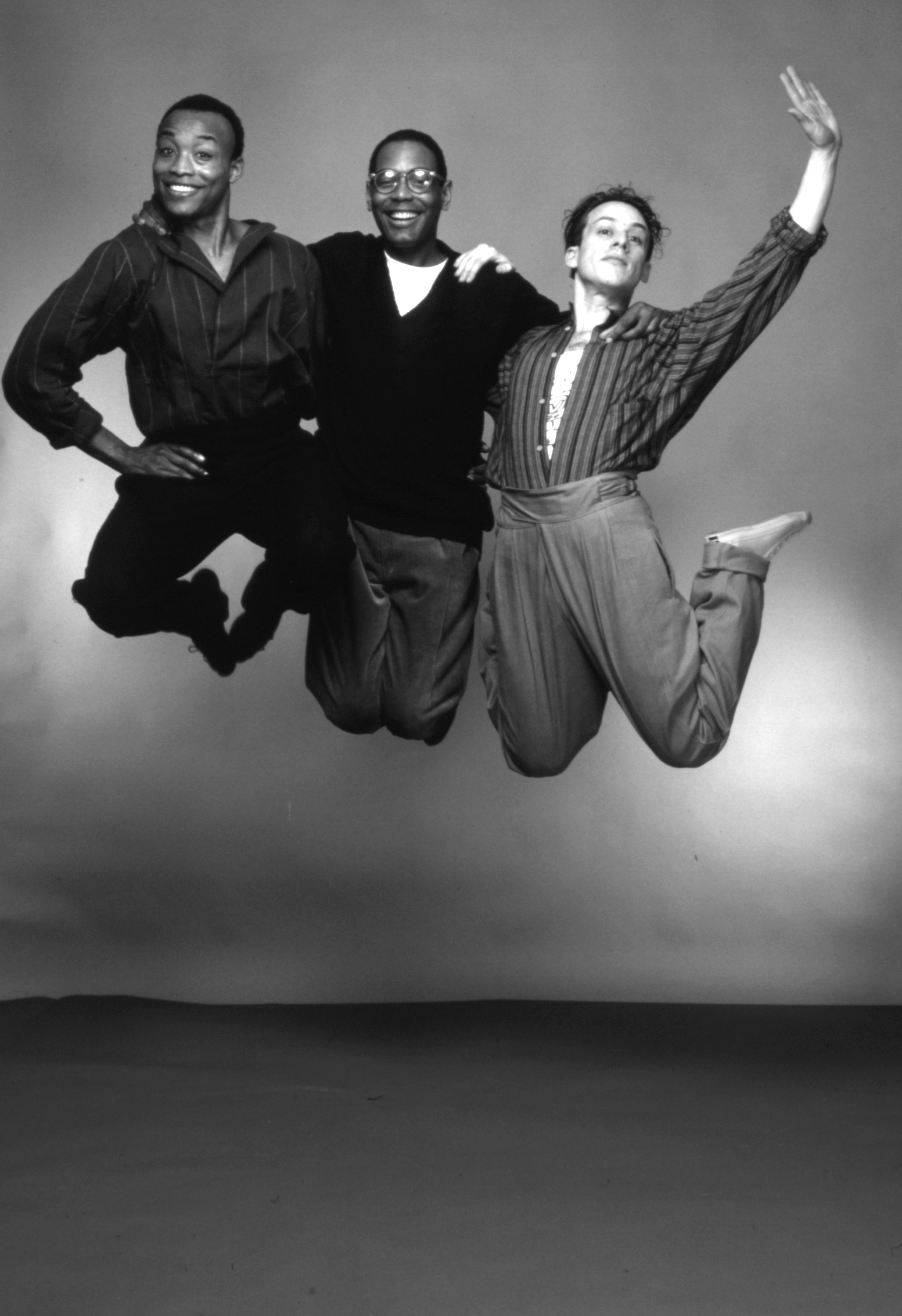 Bill T. Jones, Willi Smith, and Arnie Zane, Photographed
by Jack Mitchell, 1984
Bill T. Jones, Willi Smith, and Arnie Zane, Photographed
by Jack Mitchell, 1984KEN:
BTJ:
KEN:
Hearing that, what you went through and the losses that you experienced in those years, it’s not a surprise that you created Still/Here.
BTJ:
Still/Here was in ’94, now that I think about it. ’84, Secret Pastures. ’94, Still/Here. That’s ten years. Right? Yeah. Still/Here was ’94. Well, I was trying
to roll with it. I still saw myself as a serious artist, a movement-based artist. The body has a poetry to it. This is the same sense of the body when I discovered dance ten years before in State University of New York in Binghamton. And now, how do you put that together with something big like the tragedy of death? And then, a guilty disease. Remember Susan Sontag’s Illness as Metaphor?
KEN:
Yes.
Saturday morning, Arnie comes downstairs, and I come down. And Arnie is in front of the TV. And he sees a little tiny picture. “Designer Willi Smith has died.” And we knew the rest of us all were gonna die. We all would be dead.
BTJ:
KEN:
BTJ:
In which she talks about tuberculosis in the nineteenth century being associated with courtesans and people who lived fast? And now, here we are, faced with another guilty disease, and people are dying every day. Willi dies. And Willi had been so fashionable and so fabulous, and he had stopped doing drugs. He was trying to clean his act up. And he still got caught. I understood something about Willi’s pain. Had there ever been a Black designer who achieved this sort of fame that Willi had? After he won the Coty Award [in 1983], I remember him complaining that people didn’t think he had craft. He said to them, “You all don’t think I know fabric. ’Cause, you know, he used cotton fabrics, affordable fabrics, but they were fun fabrics. And he was making them for the public, and for people who were poor. He didn’t want to go the couture route.
KEN:
Right.
BTJ:
It was ready-to-wear. He had to be “I’m a serious designer. I know what you think design is. But I’m also a contemporary maker. And I’m really trying to make from the street, make from my Black experience.” And so on. So that’s what I appreciated about Willi. He was a man with a lot of sadness. He was often misunderstood.
KEN:
BTJ:
What do you hope people learn about Willi Smith’s work and about your collaboration together?
BTJ:
Willi was a generous man and had a lot of love. I think he was a bit cautious. That whole conversation about interracial relationships? I think he understood that there was a price we had to pay. We could not find our companions among the ranks of Black people. And that said something about who we were, but also something about what the world saw. You know, there used to be this discussion about Black men—straight men would get to a certain level, then their partners would be white women. So was that self-loathing, or was it about education and cultural references? He was trying to find his way through, and he was trying to succeed as a businessman. And Laurie Mallet was very, very important. A decent woman and very ambitious. What would I like to remember? Remember him as being generous. Remember him as being self-made, as we all had to be—making it up. Looking for authenticity. Having to, in some ways, play a role that maybe a young designer doesn’t have to play. Well, a young designer of color, ’cause there are so many more now. We recognized each other, but our disciplines were so different, and our understandings of the world were so different. But I think that he had a lot of faith in the future, and I think he truly believed in beauty. I think he participated in politics through how he lived and what he made. And I think he really was a human being, first and foremost. I would dare say even before being a Black person. He was a maker—a human maker. So his friends were a wide variety of people, and he was not afraid or intimidated by the serious avant-garde. He could come into it. I don’t know how he felt in the fashion world, but he moved with ease in the art world, which was to our advantage.
Kelly Elaine Navies is the Museum Specialist in Oral History for the Smithsonian National Museum of African American History and Culture.
Bill T. Jones, cofounder of the Bill T. Jones/Arnie Zane Dance Company, is a multitalented artist, choreographer, dancer, theater director, and writer who has received major honors, including a 1994 MacArthur “Genius” Award, Kennedy Center Honors in 2010, a 2013 National Medal of Arts, and the Human Rights Campaign’s 2016 Visibility Award.
Real Clothes for Real Dance
Tiffany E. Barber

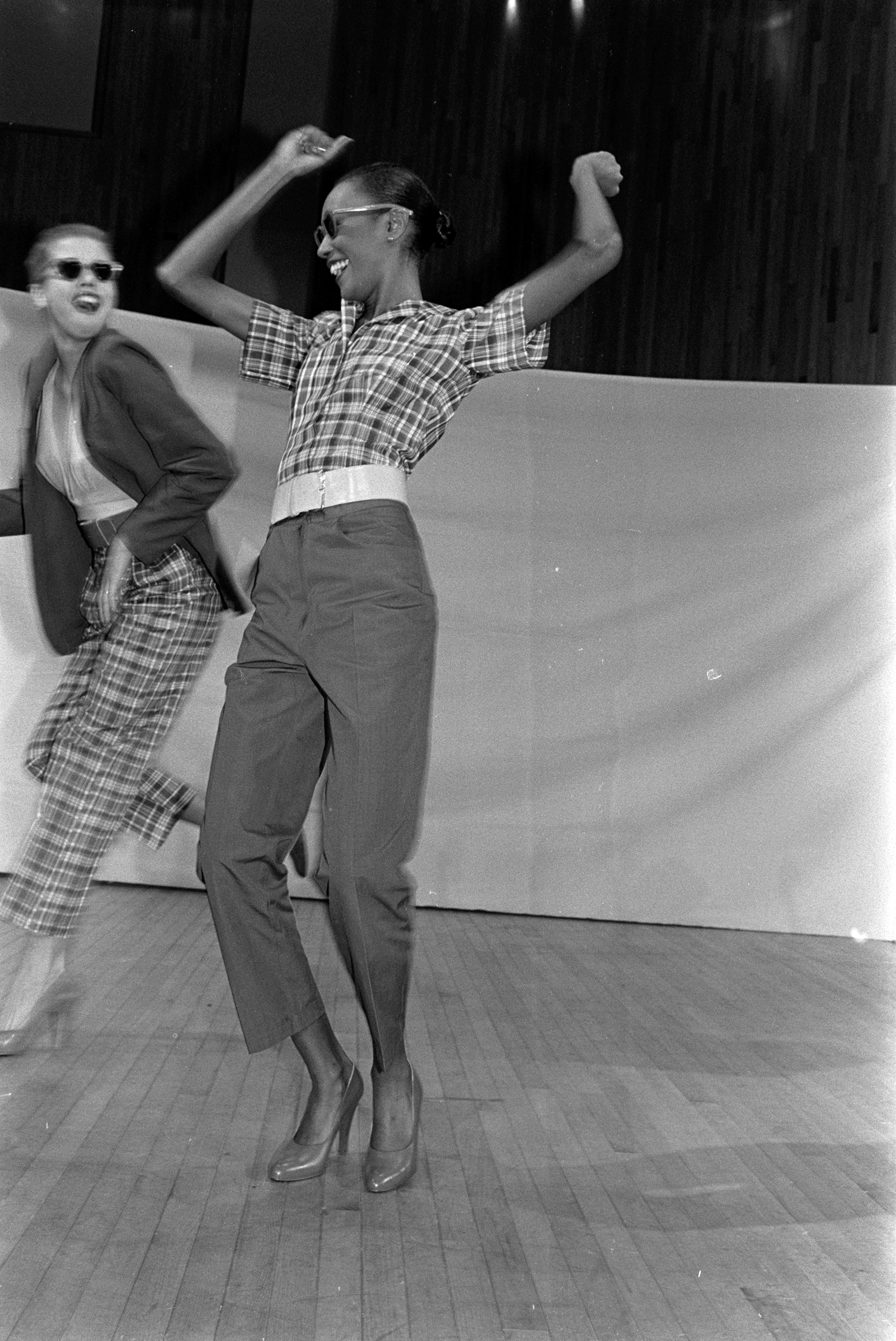
He had great disdain for anything that made him sweat— other than dancing.1
Polly Rayner
Willi Smith’s first runway shows for WilliWear took place at lofts, theaters, and galleries in downtown Manhattan in 1978, combining two of the designer’s favorite things: people and dance. A cohort of dancers doubled as models for these events, showcasing Smith’s innovative approach to clothes and performance to crowds of fashion and art world insiders. A funky balance of form, function, and play, his now iconic workwear jumpsuits with sailor collars and lightweight cotton separates defied social norms concerning gender and sexuality as well as those associated with high fashion. For Smith, fashion was more than a lifestyle. It was real people. It was unstructured movement. These characteristics likewise motivated the designer’s pioneering artistic collaborations, from modern and postmodern dance to video art. Against the backdrop of seventies disco and the ostentatious pop and pomp of the eighties, Smith’s designs for the everyday and the stage represented a different kind of dynamism where contemporary public life and performance not only intersected; they commingled and were co-constitutive.
Dancer-choreographer Dianne McIntyre’s The Lost Sun (1973) and Deep South Suite (1976) were the first of many collaborations Smith would pursue in the years preceding and immediately following the launch and meteoric success of his label. Both dances interweave “high” and “low” cultural forms. Set to pianist Gene Casey’s Antediluvian Mystery, The Lost Sun premiered at the Clark Center for the Performing Arts in New York on January 28, 1973, and featured six dancers whose leg and arm extensions, torso contractions, high jumps, and turns epitomized the virtuosity McIntyre strove to convey in her early work. Smith’s simple yet elegant costumes for The Lost Sun echoed the dancers’ expressivity. The jersey-knit half-sleeve bolero capes, two-piece shirt and skirt sets, turbans, and billowing pants wrapped at the ankle flowed with abandon just as the dancers did. All in white, beige, and yellow, the costume separates, along with their fluid silhouettes and tailored details, served as prototypes for the looks Smith would eventually mass-produce.
Polly Rayner
Willi Smith’s first runway shows for WilliWear took place at lofts, theaters, and galleries in downtown Manhattan in 1978, combining two of the designer’s favorite things: people and dance. A cohort of dancers doubled as models for these events, showcasing Smith’s innovative approach to clothes and performance to crowds of fashion and art world insiders. A funky balance of form, function, and play, his now iconic workwear jumpsuits with sailor collars and lightweight cotton separates defied social norms concerning gender and sexuality as well as those associated with high fashion. For Smith, fashion was more than a lifestyle. It was real people. It was unstructured movement. These characteristics likewise motivated the designer’s pioneering artistic collaborations, from modern and postmodern dance to video art. Against the backdrop of seventies disco and the ostentatious pop and pomp of the eighties, Smith’s designs for the everyday and the stage represented a different kind of dynamism where contemporary public life and performance not only intersected; they commingled and were co-constitutive.
Dancer-choreographer Dianne McIntyre’s The Lost Sun (1973) and Deep South Suite (1976) were the first of many collaborations Smith would pursue in the years preceding and immediately following the launch and meteoric success of his label. Both dances interweave “high” and “low” cultural forms. Set to pianist Gene Casey’s Antediluvian Mystery, The Lost Sun premiered at the Clark Center for the Performing Arts in New York on January 28, 1973, and featured six dancers whose leg and arm extensions, torso contractions, high jumps, and turns epitomized the virtuosity McIntyre strove to convey in her early work. Smith’s simple yet elegant costumes for The Lost Sun echoed the dancers’ expressivity. The jersey-knit half-sleeve bolero capes, two-piece shirt and skirt sets, turbans, and billowing pants wrapped at the ankle flowed with abandon just as the dancers did. All in white, beige, and yellow, the costume separates, along with their fluid silhouettes and tailored details, served as prototypes for the looks Smith would eventually mass-produce.
 Willi Smith for WilliWear, Spring 1979 Presentation, 1978
Willi Smith for WilliWear, Spring 1979 Presentation, 1978
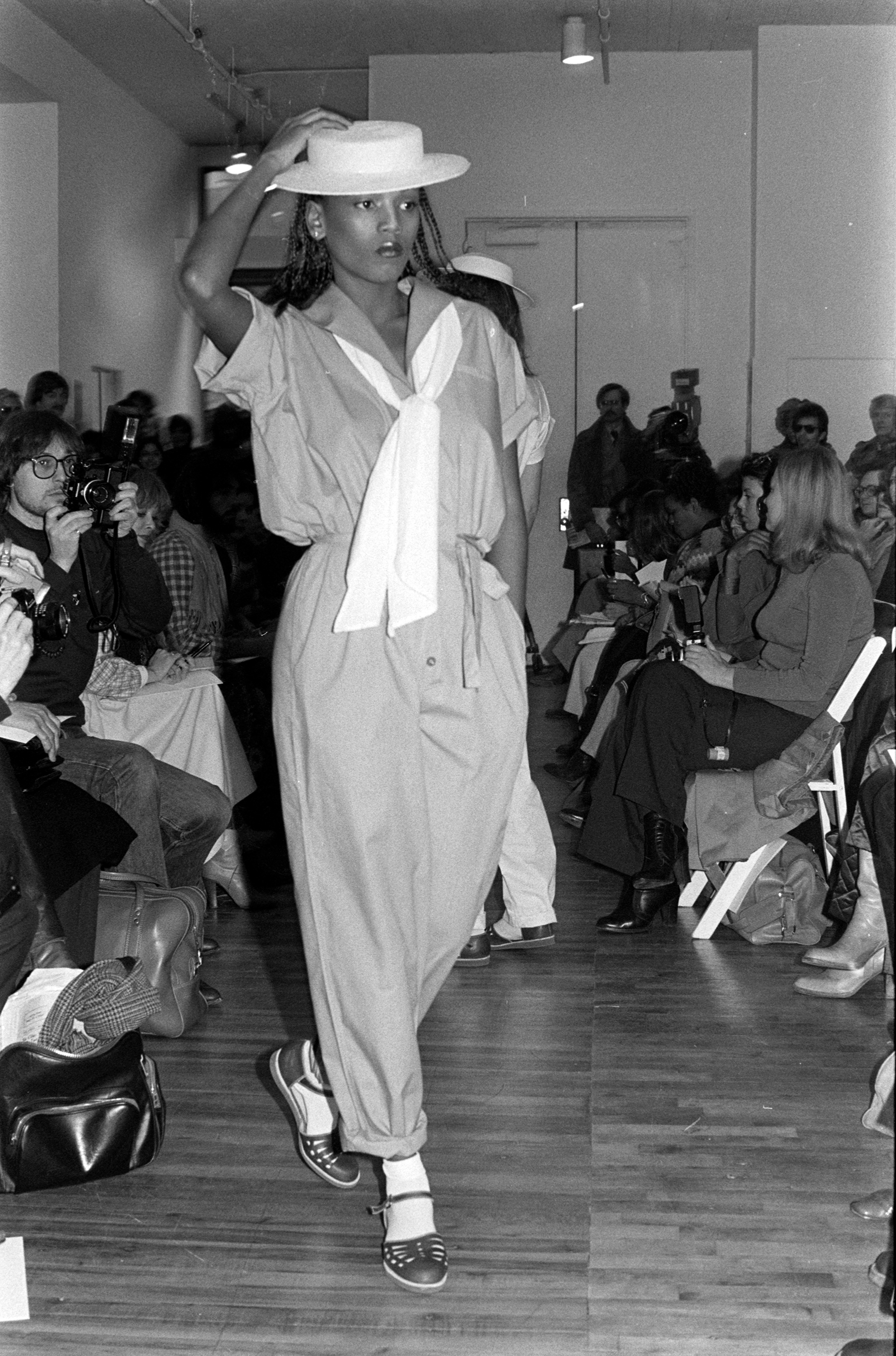
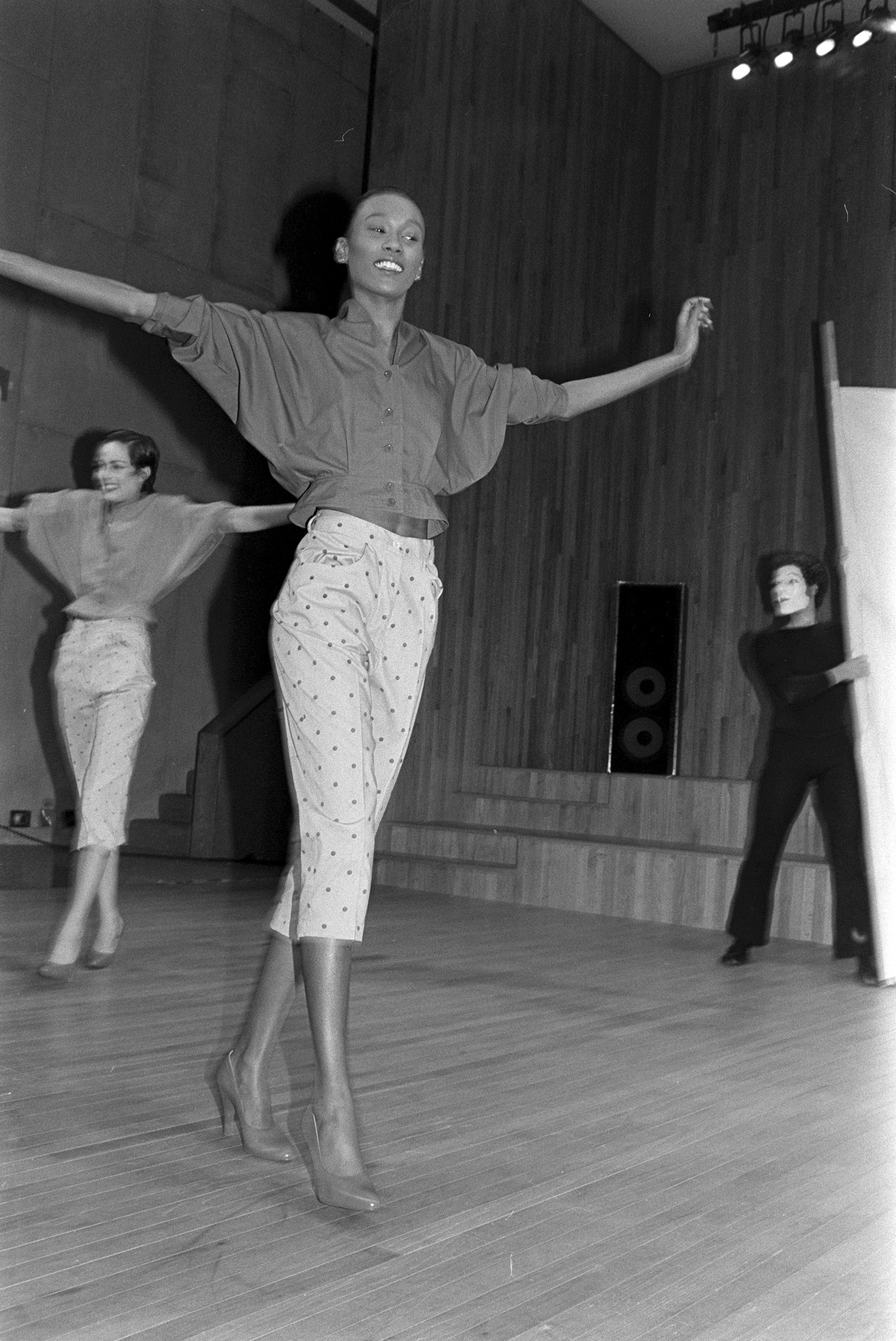
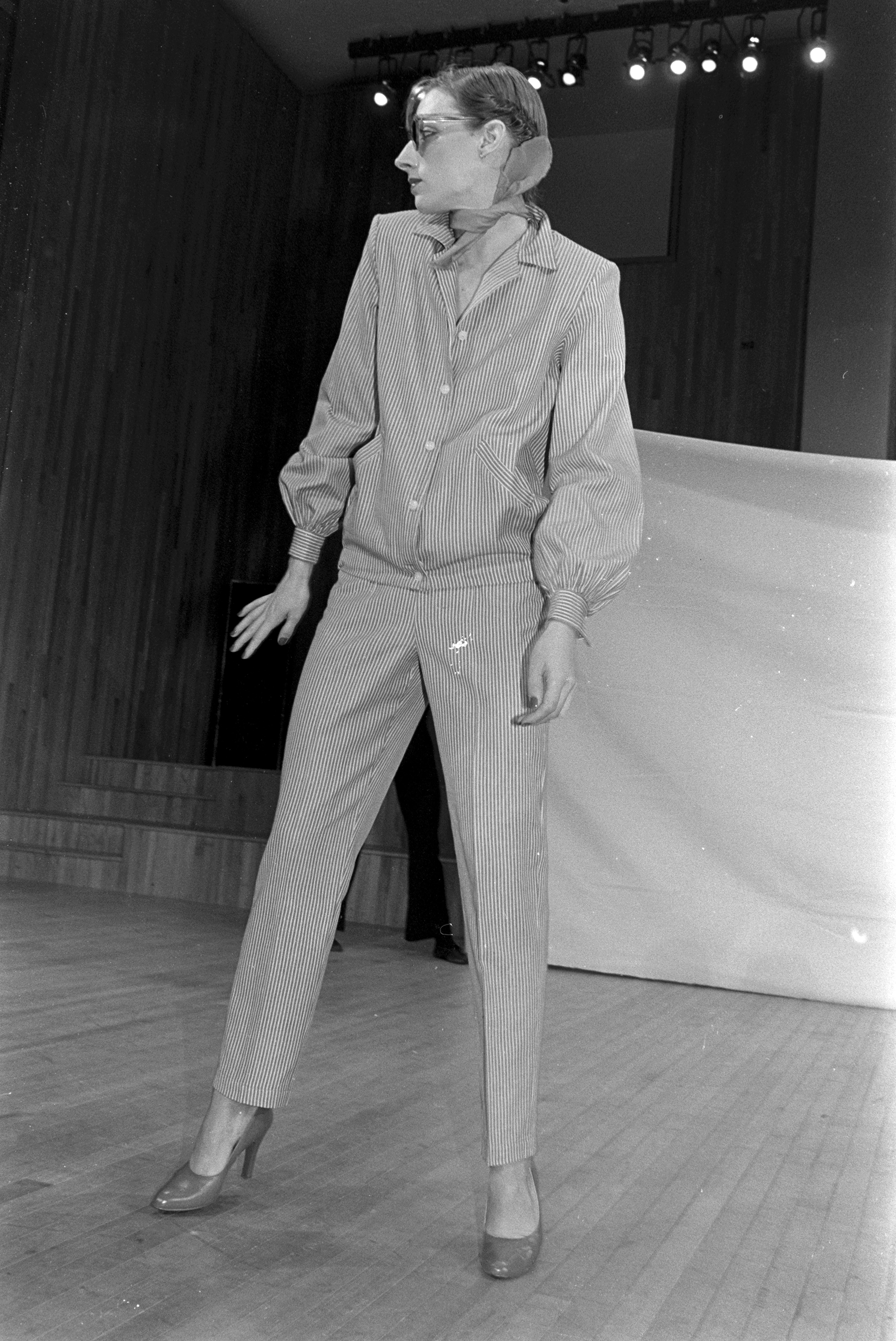
The costumes and choreography for Deep South Suite, a signature piece named after Duke Ellington’s jazz composition of the same name, were inspired by what Smith and McIntyre imagined Black life to be in the American South. Alvin Ailey, pioneer of African American concert dance, invited McIntyre to make the suite for his 1976 Duke Ellington Festival.2 Vivifying the programmatic notes Ellington penned for the composition, McIntyre’s expressive choreography builds with the music across the dance’s four sections. Seven dancers intermix leg extensions, pirouettes, and movements drawn from modern dance techniques with hip rolls and shimmies performed in juke joints and dance halls. In each section, the dancers’ movements closely relate to and elaborate various parts and pitches of the multilayered musical score, moving from joyous camaraderie in the first section to the somber effects of racial violence in the second section. The third section, a duet, explores the possibilities of interracial love, and the final section circles back to the ensemble dancing and waving as a train conductor passes by the crowd. McIntyre saw Deep South Suite as not only an extension of the music but also as an added element necessary for completing Ellington’s orchestration. At various moments, the dancers fall to the ground in unison, reacting to an unseen force. Putting into motion the realities of Black life in the South, the dancers slump, shimmy, jump, partner, and extend their arms and legs high above their heads. Smith’s free flowing skirts, blouses, bandanas, and pants accentuate these movements and the desire for new opportunities.
Smith’s design sensibility in these early creative exchanges was the perfect complement to McIntyre’s explorations of the synergy between dance and jazz music. As an undergraduate at Ohio State University, McIntyre studied structured improvisation with Judith Dunn, a founding member of Judson Dance Theater, and Bill Dixon, a well-known free jazz musician. Structured improvisation often takes the shape of a score—a set of prompts that encourages organized yet open, fluid movement and exploration, the outcomes of which are not predetermined. For Dunn and Dixon, structured improvisation was the grounds for formal and social experimentation. “In addition to creating striking improvised works,” dance scholar Danielle Goldman outlines, the pair’s “collaborations explored and openly acknowledged relations between Black traditions of improvised music and the rather white world of postmodern dance.”3 Dunn’s improvised work incorporated quotidian movement and chance procedures that spanned rolling dice to determine when and where dancers would enter and exit the stage and leaving parts of her compositions open to the performers’ own choices. Dixon, on the other hand, found chance operations limiting and preferred freedom and sponta- neity in the moment. Both, however, assigned dance and music equal value, refusing to see them as independent elements that exist in a hierarchical relationship.


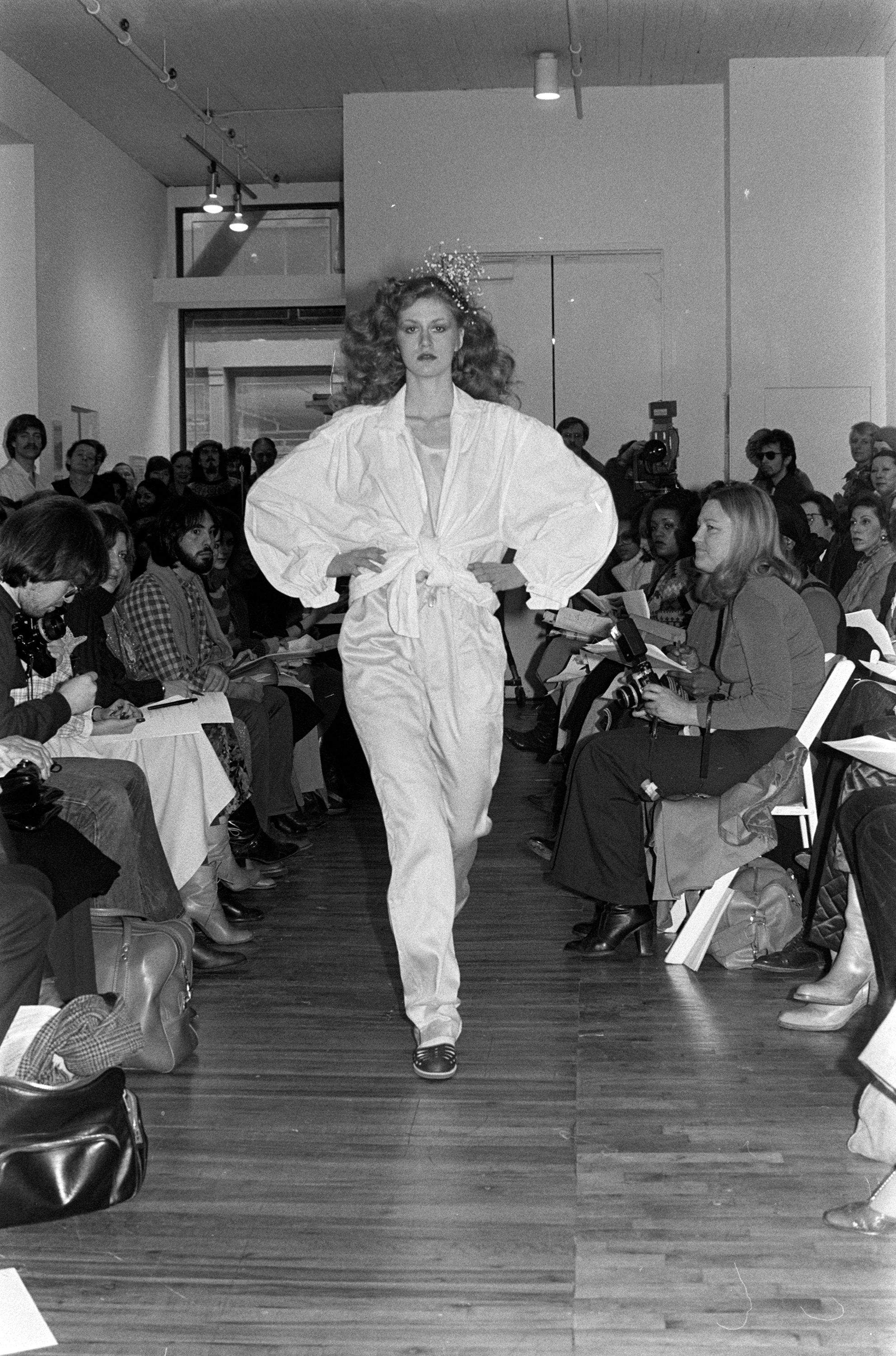 Willi Smith for WilliWear, Summer 1978 Presentation, 1978
Willi Smith for WilliWear, Summer 1978 Presentation, 1978McIntyre’s work elaborates Dunn and Dixon’s process by underscoring the social aspects of dance. For McIntyre, dance is not presentational. She encourages dancers to relinquish their personae in order to inhabit the interior of her choreography, which originates from two extreme ways of working. McIntyre’s dances are either totally improvised or the result of stylized choreography created and set in rehearsals. At times, the movement and the music simultaneously affect one another, generating a unique work of art in the moment. Upon moving to New York in 1970, McIntyre further developed her signature style. She associated with jazz musicians from the Master Brotherhood collective and incorporated Black social dances such as the jitterbug, the shag, and the Charleston into her work. Louise Roberts, director of the Clark Center, mentored her in these beginning stages, giving the budding choreographer free space to rehearse her early dances. Roberts produced McIntyre’s first formal dance concert at the Clark and helped McIntyre establish Sounds in Motion in 1972. During this fruitful period, McIntyre facilitated cross-disciplinary conversations between visual artists, dancers, musicians, critics, and designers, “even though design was somewhat peripheral,” the dancer choreographer remembers.4 Reflecting on what it was like to come of age as artists in the seventies and eighties, she states, “For us, it was all part of the same mix. . . [Willi] never set himself apart; he wanted to be part of the art. . . It was the way things flowed at the time. It was cross-fertilization.”5 Influenced by civil rights struggles and the Black arts movement, McIntyre’s informal convenings paralleled Smith’s collaborative spirit, which soon found new outlets for expression.
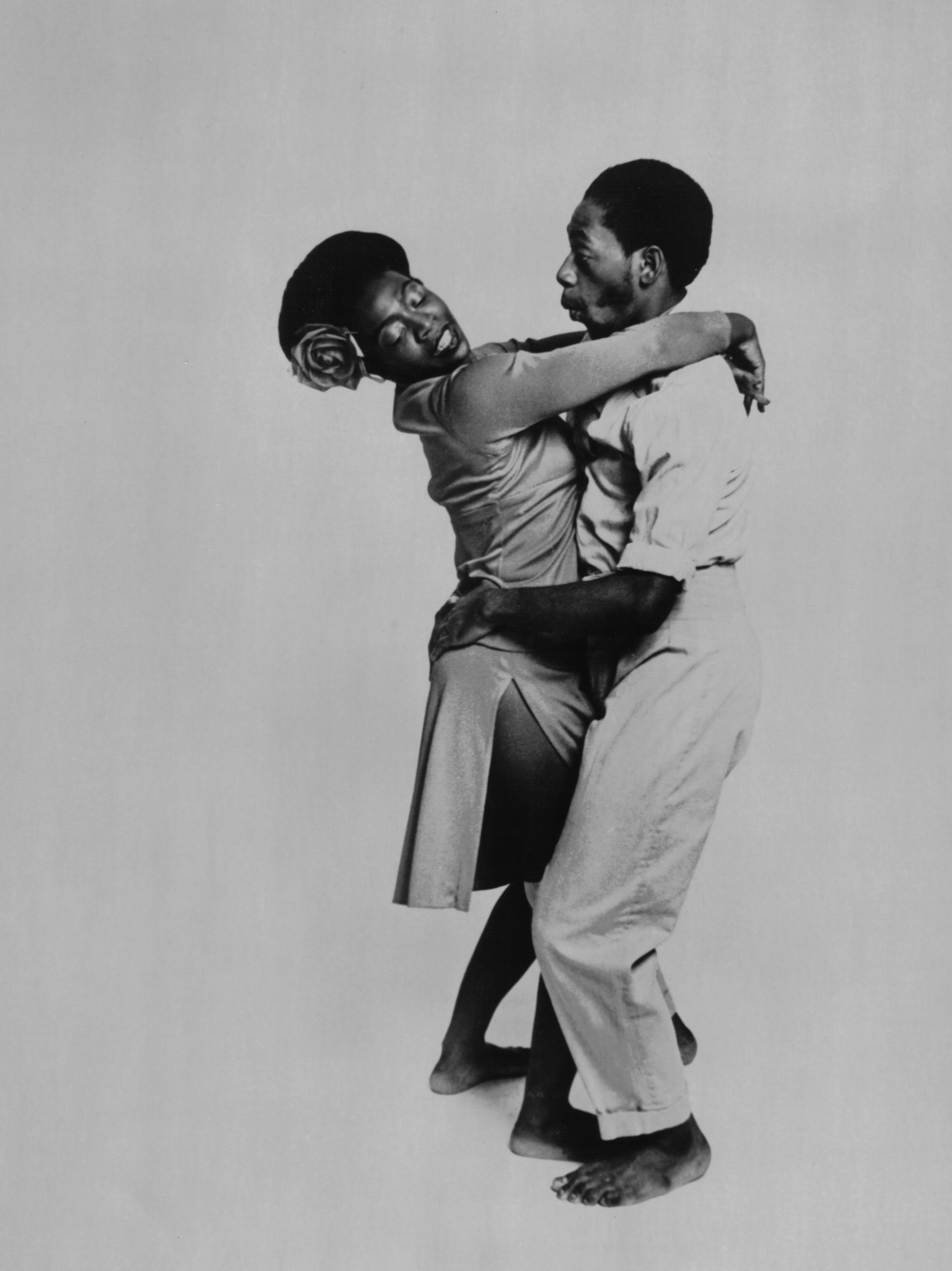 Bernadine Jennings and Leon Brown in Deep South Suite,
Choreographed by Dianne McIntyre, Photographed by Johan Elbers, 1976
Bernadine Jennings and Leon Brown in Deep South Suite,
Choreographed by Dianne McIntyre, Photographed by Johan Elbers, 1976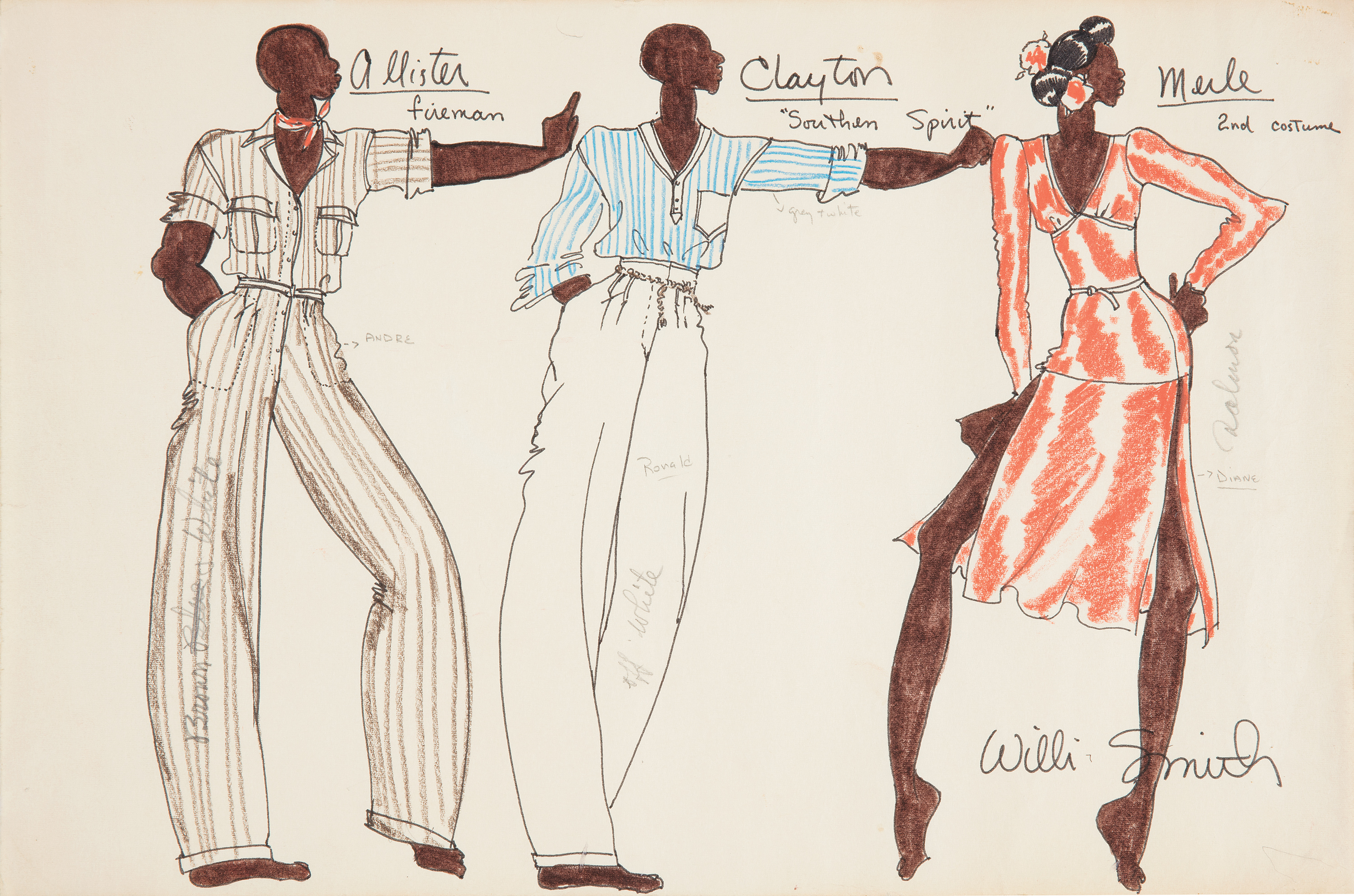
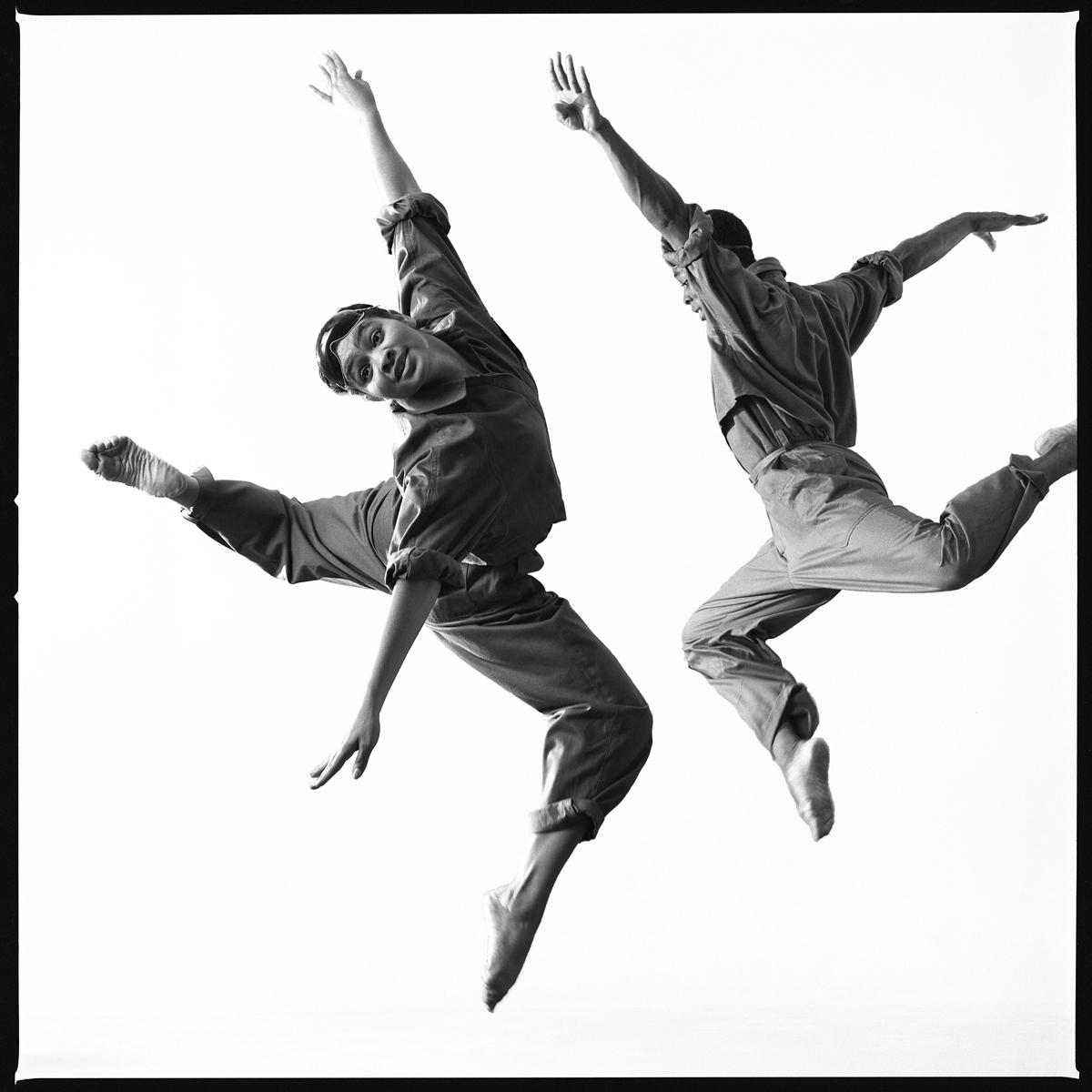

The eighties afforded Smith exciting opportunities as the designer’s brand expanded. Along with his success, Smith’s aesthetic sense matured, as did his interdisciplinary vision. The designer and his partner Laurie Mallet launched a production division, WilliWear Productions, to focus on large-scale collaborations with several of the era’s most compelling contemporary artists. Reflecting on his ambitions during this time, Smith exclaimed, “I want to branch out, I want to be everywhere. . . I want to conquer the world!”6 Notably, dance remained central to the designer’s evolving vision and patronage. In 1983, he funded the premiere of Trisha Brown, Robert Rauschenberg, and Laurie Anderson’s Set and Reset at Brooklyn Academy of Music (BAM), with the next year proving even more monumental. On May 16, 1984, WilliWear produced Artventure, a gala benefiting the Public Art Fund in New York. At the event, the designer premiered Made in New York (1984), video artist Les Levine’s funky, offbeat homage to the city that never sleeps starring Bill T. Jones and Arnie Zane, and sold his new line of artist T shirts. A month later, McIntyre premiered one of her most memorable dances, Take-Off From a Forced Landing, in honor of her mother who in 1939 entered a government aviation program and became one of the first Black women to be trained as a pilot. For the piece, Smith dressed the eight dancers in goggles and a reworked version of his lightweight cotton jumpsuits. Smith first developed this clothing concept for Digits Sportswear, and the uniform repeatedly appeared in his WilliWear collections and costume designs. In November and December later that year, he designed costumes for Secret Pastures, a landmark piece that again featured Jones and Zane, and funded BAM’s 1984 revival of Philip Glass, Robert Wilson, and Lucinda Child’s Einstein on the Beach (1976), a five-hour-long opera in four acts. Both works revolutionized live theater. 7
Secret Pastures epitomizes Smith’s desires to work beyond fashion. The ninety-minute piece premiered at BAM’s Next Wave Festival on November 15, 1984. Featuring a compendium of collaborators working across concert dance and pop art, the piece animates the concept of gesamtkunstwerk—“the total work of art.” Jones and Zane choreographed the movement; Peter Gordon composed the music; Marcel Fieve styled makeup and hair; Keith Haring designed the set elements; and Smith created the costumes. Jones as fabricated man, Zane as the professor, and eleven ensemble characters enliven Secret Pastures’s nonlinear narrative about the divide between primitive and modern experience. The professor and the ensemble execute angular, sharp, and sexually evocative movements, punctuating Gordon’s percussive, punk-inflected score and Haring’s iconographic homoerotic drawings on stage.8 Smith’s asymmetrical frocks and jumpsuits worn over undergarments in neutral colors, swing coats, and signature pants—baggy with a high, wrapped waist—encourage freedom in motion while Jones’s primordial figure, dressed in a unitard, moves awkwardly yet fluidly. In a duet with Zane, Jones learns to walk, dance, and gyrate as Zane inspects and manipulates his limbs. As the piece progresses, the narrative becomes a pretext for dancing, and the choreography becomes more sexually explicit. At one point, the dancers, now wearing bright-colored, tight-fitting athletic wear, transpose Haring’s drawings into a tableau: in a line of intertwined bodies, a dancer’s head crouches in between another dancer’s legs; one appears to bite another’s neck; and yet another dancer throws their head back in ecstasy.
Smith’s unisex, interchangeable costumes designed to be switched from dancer to dancer contrast with Secret Pastures’s sexual charge. His “freewheeling” designs, as he described them,9 instead emphasize form, vitality, and unrestrained movement, all of which Jones and Zane, personal and professional partners, exploited in their own identity-based work of the seventies and eighties. Jones’s interest in movement and speech fused with the visual design sensibility Zane drew from his work as a photographer and experimental filmmaker. The physical contrast between Jones (tall, African American, gracefully athletic) and Zane (short, Jewish, quick, and wiry) also informed the pair’s shared creativity. After attending Lois Welk’s contact improvisation workshop at SUNY Brockport, collaboration became a central component of their choreographic process. Between 1974 and 1979 in Binghamton, New York, the duo was part of American Dance Asylum (ADA) along with Welk and another dancer, Jill Becker. To develop their individual and collective works, the members of ADA employed a process whereby each member informed the activities of the others. Though formative, Jones and Zane had outgrown ADA by 1979. Wanting to live in an area more supportive of both their art and their identity as an interracial gay couple, the pair moved to Rockland County, New York, where they continued to make dances together until Zane’s death in 1988.10 Like Dunn and Dixon, improvisation, and dance more broadly, provided Jones and Zane with techniques for breaking down taboo boundaries between form and identity on the one hand and race, sexuality, and age on the other. Against the grain of aesthetic and social expectations regarding which bodies can and should dance, male-to-male intimacy, and interracial partnerships, the duo worked to be on stage together-intertwining their bodies, lifting and carrying each other across stage, striving for more.11
Smith’s unisex, interchangeable costumes designed to be switched from dancer to dancer contrast with Secret Pastures’s sexual charge. His “freewheeling” designs, as he described them,9 instead emphasize form, vitality, and unrestrained movement, all of which Jones and Zane, personal and professional partners, exploited in their own identity-based work of the seventies and eighties. Jones’s interest in movement and speech fused with the visual design sensibility Zane drew from his work as a photographer and experimental filmmaker. The physical contrast between Jones (tall, African American, gracefully athletic) and Zane (short, Jewish, quick, and wiry) also informed the pair’s shared creativity. After attending Lois Welk’s contact improvisation workshop at SUNY Brockport, collaboration became a central component of their choreographic process. Between 1974 and 1979 in Binghamton, New York, the duo was part of American Dance Asylum (ADA) along with Welk and another dancer, Jill Becker. To develop their individual and collective works, the members of ADA employed a process whereby each member informed the activities of the others. Though formative, Jones and Zane had outgrown ADA by 1979. Wanting to live in an area more supportive of both their art and their identity as an interracial gay couple, the pair moved to Rockland County, New York, where they continued to make dances together until Zane’s death in 1988.10 Like Dunn and Dixon, improvisation, and dance more broadly, provided Jones and Zane with techniques for breaking down taboo boundaries between form and identity on the one hand and race, sexuality, and age on the other. Against the grain of aesthetic and social expectations regarding which bodies can and should dance, male-to-male intimacy, and interracial partnerships, the duo worked to be on stage together-intertwining their bodies, lifting and carrying each other across stage, striving for more.11
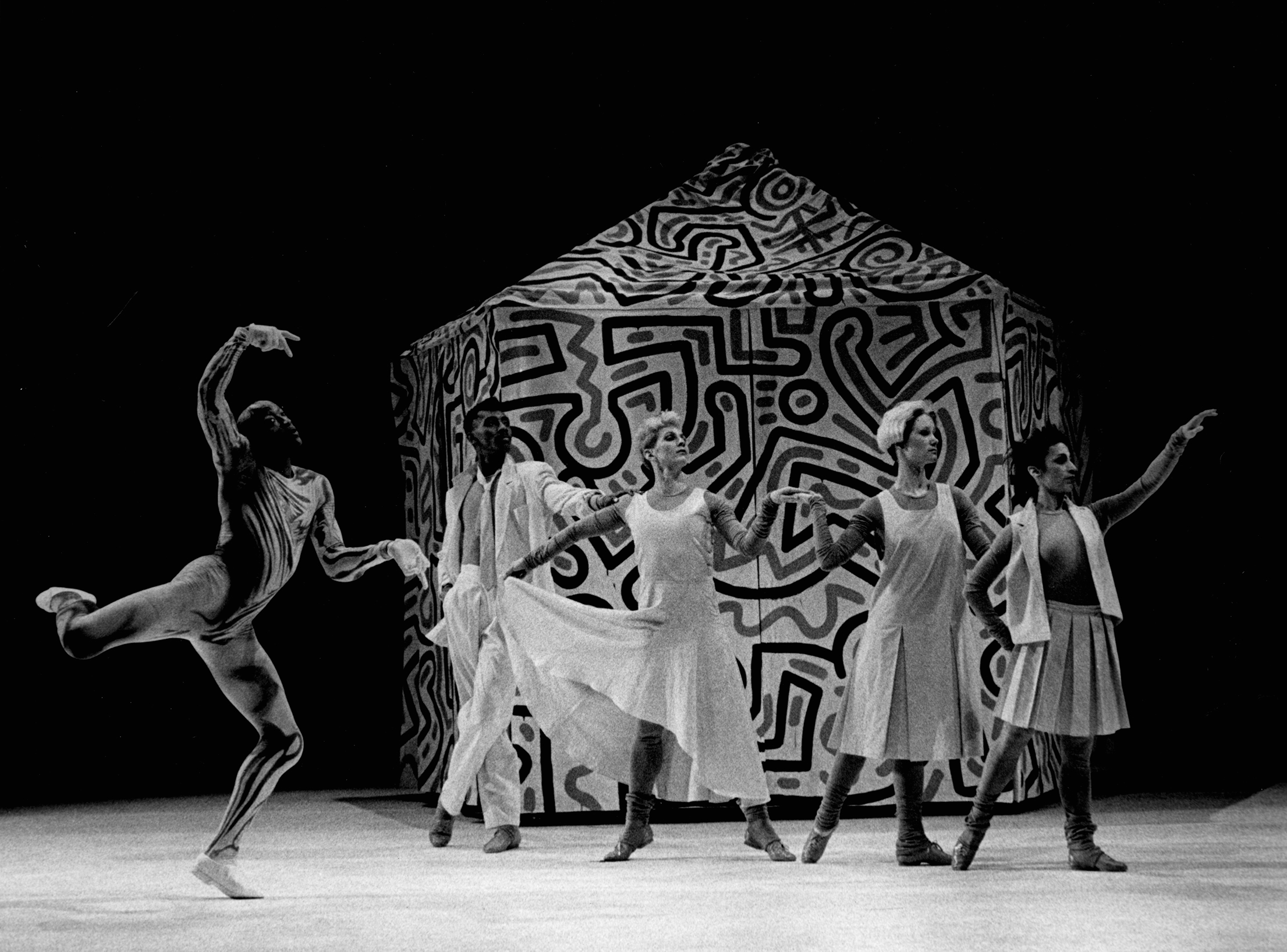 Secret Pastures at Brooklyn Academy of Music, Choreographed by Bill T. Jones/Arnie Zane Dance Company, Music composed by Peter Gordon, Set designed by Keith Haring, Costumes designed by Willi Smith, Photographed by Tom Caravaglia, 1984
Secret Pastures at Brooklyn Academy of Music, Choreographed by Bill T. Jones/Arnie Zane Dance Company, Music composed by Peter Gordon, Set designed by Keith Haring, Costumes designed by Willi Smith, Photographed by Tom Caravaglia, 1984
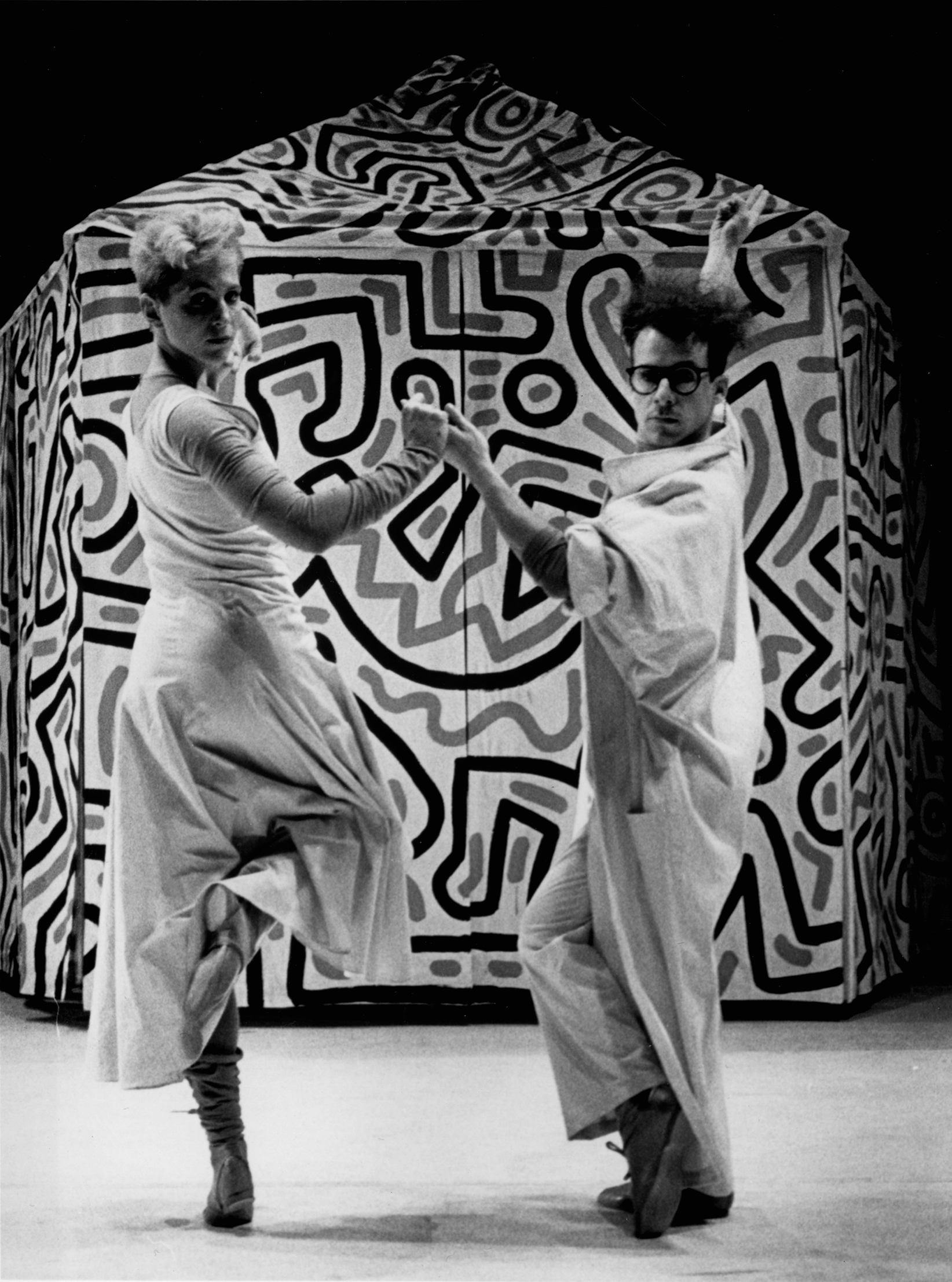
Secret Pastures at Brooklyn Academy of Music, Choreographed by Bill T. Jones/Arnie Zane Dance Company, Music composed by Peter Gordon, Set designed by Keith Haring, Costumes designed by Willi Smith, Photographed by Tom Caravaglia, 1984
For McIntyre, Jones, and Zane, dance and meaningful collaboration engendered radical acts of freedom. They each worked within and beyond concert dance’s constraints to interrogate staid notions of embodiment, culture, and form. By bridging dance with Black sound, improvisation, autobiography, and cross-racial intimacy, McIntyre, Jones, and Zane contested the confines of modern dance practice and theory as well as the post- modern dance world’s overwhelming whiteness. Smith relatedly sought to make clothes for various bodies and shapes unbound by racial and sexual pathologies, even as his identity and lived experiences deeply informed his work. Like Jones, who “rankled at being called a ‘Black artist,’” Smith saw himself as more than simply “a Black designer.”12 Smith’s approach to making clothes, what cultural critic Hilton Als calls “the designer’s democratic urge,” was interdisciplinary from the start, and he and his collaborators were each on the cutting edge of their respective fields.13 Smith infused his separates with whimsy and irreverence, humor and exuberance, quali- ties also present in his designs for dance. Ultimately, his costumes articulate a novel theatrical style on par with the choreographic ethos of McIntyre, Jones, and Zane—“real” clothes for “real” dance that transgressed the rules of the avant-garde. In so doing, Smith and his collaborators initiated new modes of artistic expression and unrestricted movement at the forefront of postmodern art and design.
Tiffany E. Barber is a scholar, curator, and writer of twentieth- and twenty-first-century visual art, new media, and performance. Her work focuses on artists of the Black diaspora working in the United States and the broader Atlantic world.
Tiffany E. Barber is a scholar, curator, and writer of twentieth- and twenty-first-century visual art, new media, and performance. Her work focuses on artists of the Black diaspora working in the United States and the broader Atlantic world.
- Polly Rayner, “WilliWear Designer Creates ‘Basic Clothes with a Sense of Humor,” Morning Call (October 21, 1984), accessed July 15, 2019, Link.
- Alvin Ailey’s Duke Ellington Festival ran from August 10 to 15, 1976, at Lincoln Center’s New York State Theater. The festival was planned to coincide with the bicentennial of the USA. Ailey selected the music for McIntyre’s piece.
- Danielle Goldman, I Want to Be Ready: Improvised Dance as a Practice of Freedom (Ann Arbor, MI: University of Michigan Press, 2010), 62.
- Dianne McIntyre (dancer-choreographer) interviewed by Alexandra Cunningham Cameron and Julie Pastor, Cooper Hewitt, Smithsonian Design Museum, New York, NY, 2019, unpublished recording.
- Ibid.
- Smith quoted in Rayner, Link.
- Dance continued to energize Smith’s interdisciplinary approach to design and performance in the years between 1984 and his death in 1987. One notable example of this is Expedition (1985), which featured members of the National Ballet of Senegal.
- Between 1982 and 1984, Bill T. Jones collaborated with Keith Haring on three different projects. Long Distance, performed at The Kitchen in 1982, featured Jones dancing to the sounds of Haring’s brushstrokes as he simultaneously painted the backdrop in situ. Next, Haring’s white-line drawings adorned Jones’s naked body in a series of photographs that Tseng Kwong Chi took in 1983. The third project was Secret Pastures.
- Smith quoted in Nancy Vreeland, “Dance & Fashion,”
Dance (October 1984): 75.
- Jones and Zane formed the Bill T. Jones/Arnie Zane Dance Company in 1982.
- Goldman makes a similar claim about Dunn and Dixon. See Goldman’s “We Insist! Seeing Music and Hearing Dance,” in I Want to Be Ready: Improvised Dance as a Practice of Freedom (Ann Arbor, MI: University of Michigan Press, 2010), 69.
- See Bill T. Jones with Peggy Gillespie, Last Night on Earth (New York: Pantheon Books, 1995), 164.
- Hilton Als, “Willi Smith, 1948–87” Village Voice (April 28, 1987).
Feast or Fashion
Horacio Silva
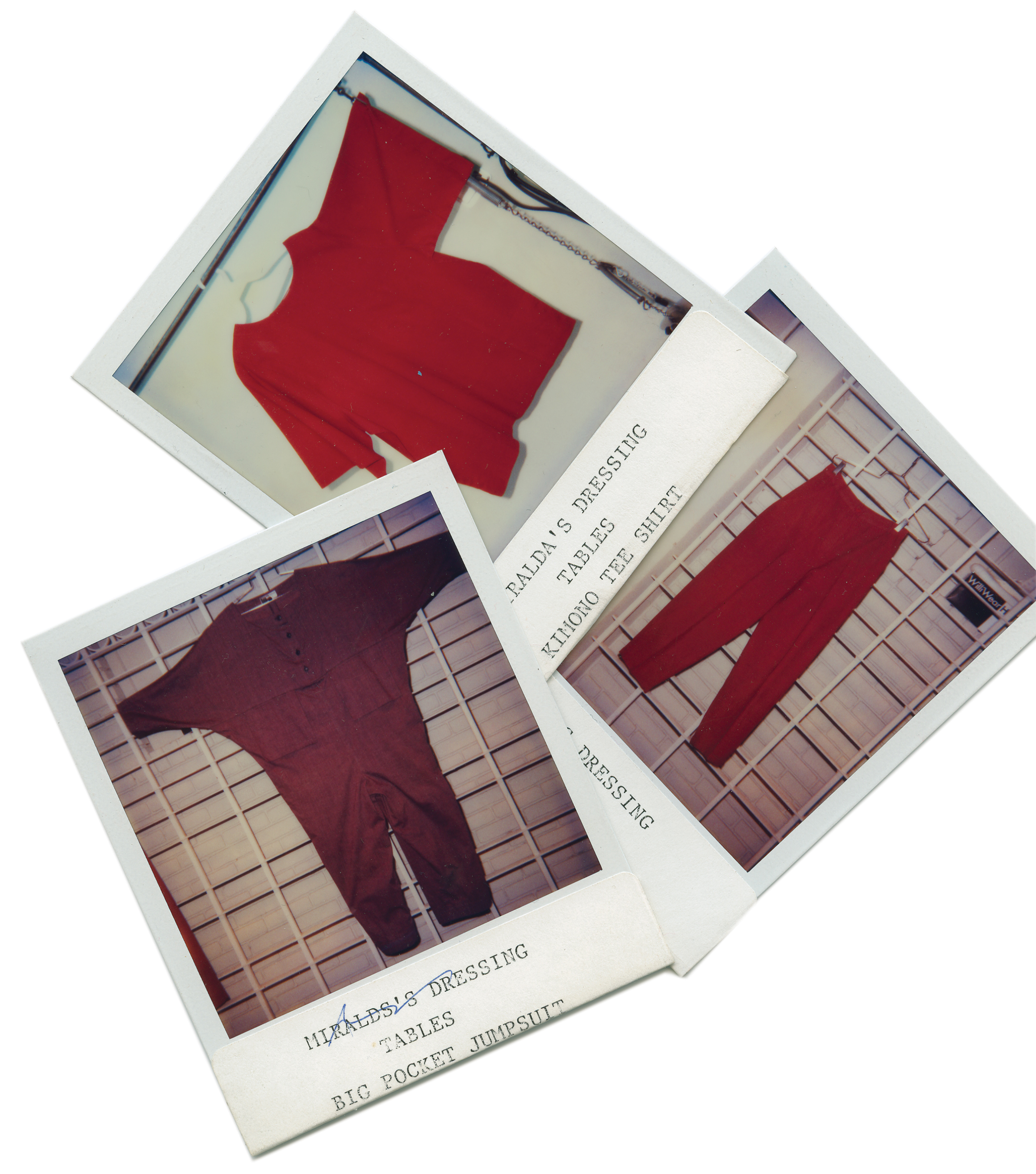 Miralda, Inspiration for Dressing Tables, 1983
Miralda, Inspiration for Dressing Tables, 1983
To celebrate his Coty Award win in 1983, Willi Smith tapped Miralda, the Spanish food artist known for installations such as Edible Landscape, Sangria, and Moveable Feast, to cook up something special in the designer’s showroom. On the menu at Miralda’s Dressing Tables, as the event was billed: three stations shaped to represent a jumpsuit, pants, and a shirt (Smith’s outfit combination of choice), with three different dressings—mustard, ketchup, and mayonnaise.
Generously seasoned with concept, each table had a special color code for drinks that were placed on small mirrors: red drink for chicken with mustard, green drink for asparagus and mayonnaise, blue drink for shrimp with ketchup. A bit hard to swallow by today’s tastes, but the participatory food performance predates the private event-as-food-for-thought efforts of artist Jennifer Rubell by at least two decades. According to the Daily News Record, invitees initially “stared suspiciously at the tables wondering what to do.” After realizing the date and signed “mini-couture” boxes they were given contained shrimp, chicken, and asparagus, guests ate it up with a spoon.
Horacio Silva is the head of content and special projects for Metrograph and is a renowned writer and editor for the world’s most prestigious publications and brands.
Generously seasoned with concept, each table had a special color code for drinks that were placed on small mirrors: red drink for chicken with mustard, green drink for asparagus and mayonnaise, blue drink for shrimp with ketchup. A bit hard to swallow by today’s tastes, but the participatory food performance predates the private event-as-food-for-thought efforts of artist Jennifer Rubell by at least two decades. According to the Daily News Record, invitees initially “stared suspiciously at the tables wondering what to do.” After realizing the date and signed “mini-couture” boxes they were given contained shrimp, chicken, and asparagus, guests ate it up with a spoon.
Horacio Silva is the head of content and special projects for Metrograph and is a renowned writer and editor for the world’s most prestigious publications and brands.
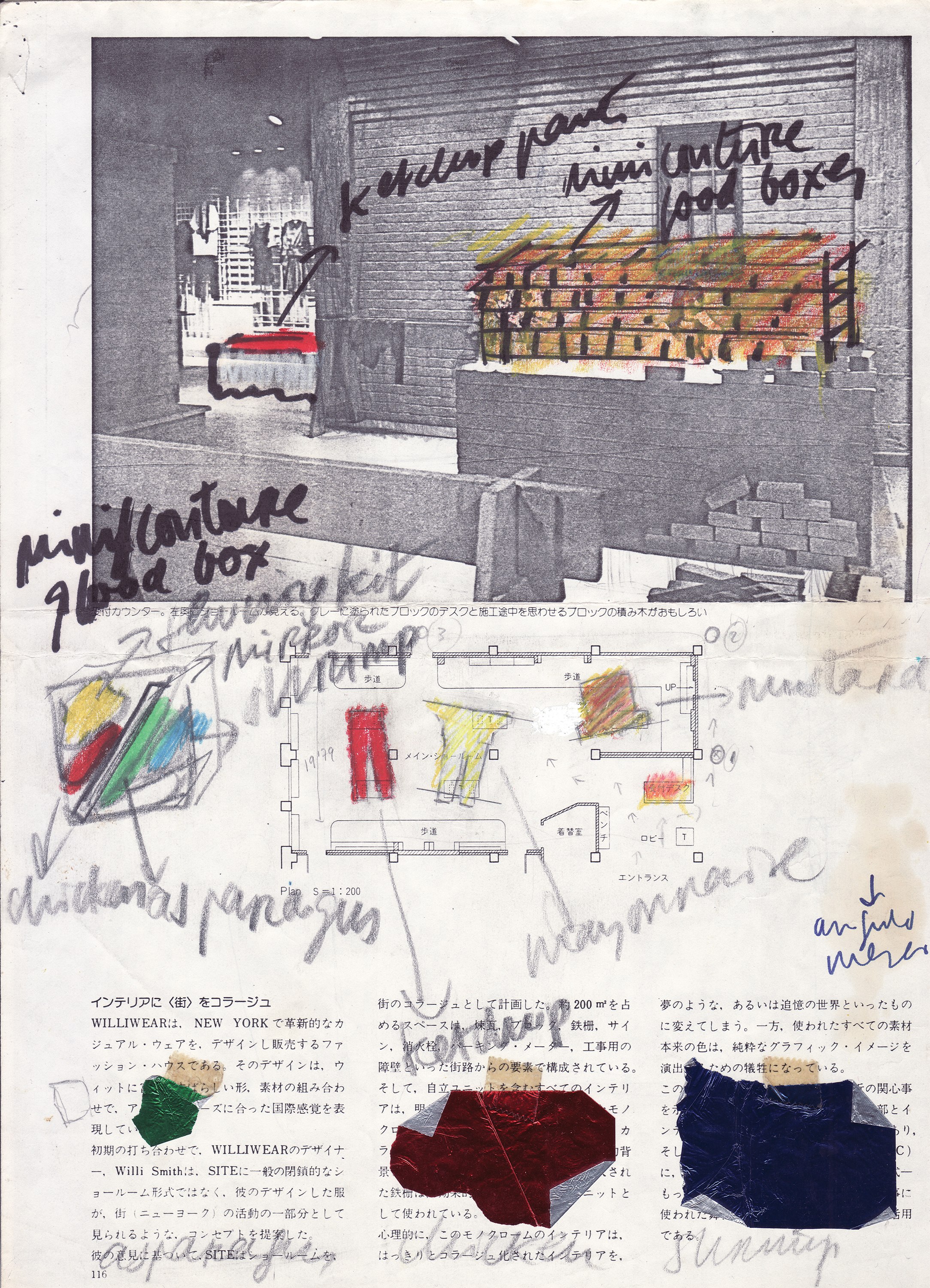
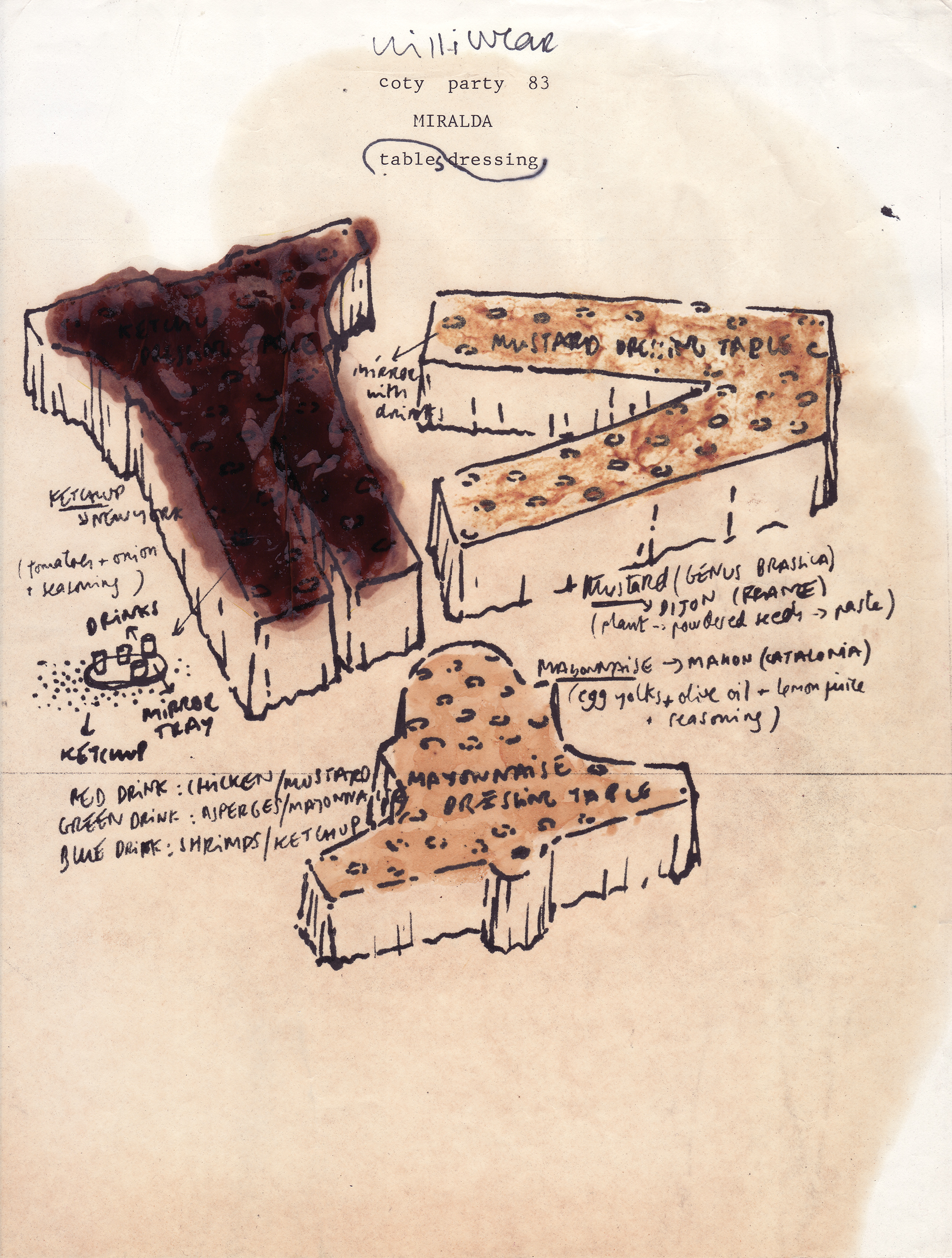



Miralda, Laurie Mallet, and Willi Smith installing Dressing Tables, Photographed by Marta Sentís, 1983
Performance
Smith wanted to see his clothing move on the street and on
the stage. He approached costume design as an opportunity to emphasize the flexibility of his
fashions and to support the work of Black performers uniting dance with Black
sound, storytelling, and queer and cross-racial intimacy.
Smith’s designs for
dancer-choreographer Dianne McIntyre’s and Bill T. Jones/Arnie Zane Dance
Company’s compositions illustrate Smith’s own belief that “being Black also has a lot to do with my being a good designer.” A
multidimensionally informed Black aesthetic infused Smith’s costumes for these
influential productions with a casual familiarity that would appeal to broad
audiences.
Take-Off From a Forced Landing
Take-Off From a Forced Landing, Performance Video, Joyce Theater, New York, 1984, from Cooper Hewiit on Vimeo.
An audio described version of this video is available for individuals who are blind or have low-vision.
Take-Off From a Forced Landing is dancer and choreographer Dianne McIntyre’s tribute to her mother Dorothy Layne who, despite earning her private pilot’s license in 1939, was not able to realize a career in flying. The work combines spoken word, live and recorded music, dance, and lighting effects to narrate the internal and external struggles of a Black family. Smith’s cotton jumpsuits and patterned separates used for the composition reflect his own interest in dressing for utility. He referenced military uniforms and work wear throughout his entire career, beginning in his early collections for Digits.
SITE’s Iconic Ghost Cityscape
Michael Bullock
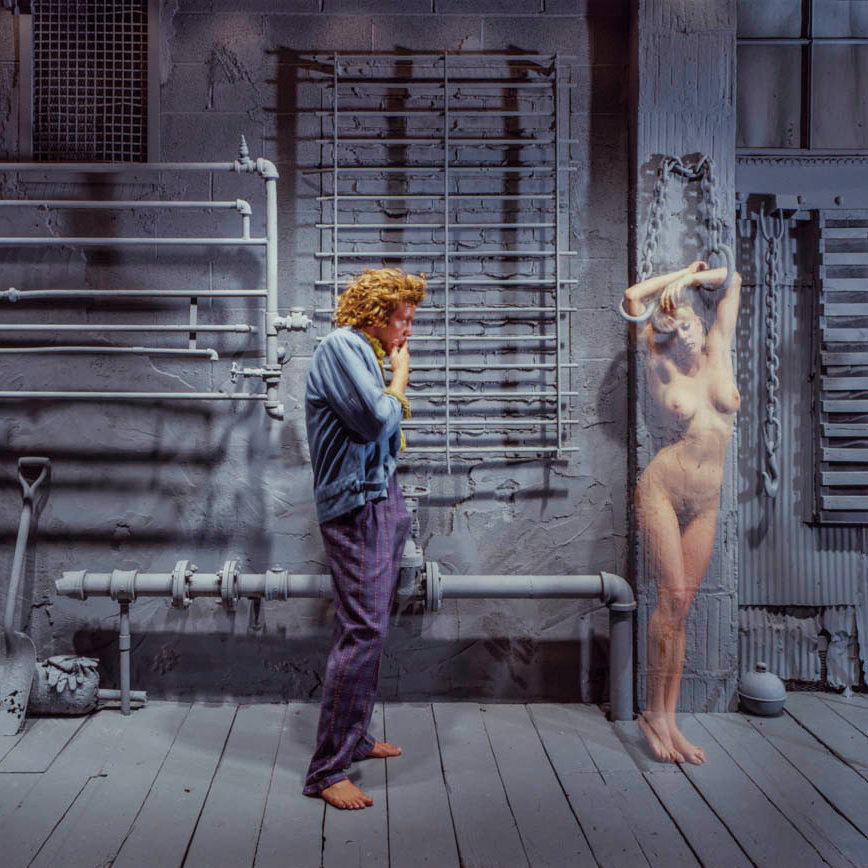 SITE for WilliWear, Showroom, New York, NY, Photographed by Andreas Sterzing, 1982
SITE for WilliWear, Showroom, New York, NY, Photographed by Andreas Sterzing, 1982
Broken windows, concrete sidewalks, bricks, a chain-link fence, industrial piping, rusting abandoned tools, and layers of eroding facades are not materials that come to mind when envisioning the showroom of a New York City−based, multimillion-dollar clothing brand. But designer Willi Smith and his business partner, Laurie Mallet, viewed upending industry convention as an opportunity for reinvention.
Finding the right architects to reimagine the traditional showroom was the result of perfect timing. As Smith and Mallet were walking down Fifth Avenue contemplating possible directions for their new home base in the Garment District, an unusual Rizzoli Bookstore display in Manhattan caught their attention. The window featured a monochrome gray, half-finished brick wall and abandoned tools. Newly released design and architecture books were scattered throughout the simulated construction site. Their covers popped against the muted, unified backdrop. The deconstruction was a bold departure from the current trends in window design and even more unusual for the prestigious uptown art bookseller whose displays typically favored elegance and refinement. The punk anti-design was conceived by SITE, a collective of artists, architects, and engineers that had banded together to challenge the conventions of the built environment with a form of conceptual thinking that had incubated in the seventies’ environmental art movement. Alison Sky, a founding partner, explains, “They had no budget and I noticed a Trump property was being built across the street. So I invited the construction workers to build a brick wall. I directed them to stop halfway and leave all their tools as if they had left for a lunch break. The Rizzoli in-house designer was so threatened by the attention our display received that he had it removed immediately.”
Finding the right architects to reimagine the traditional showroom was the result of perfect timing. As Smith and Mallet were walking down Fifth Avenue contemplating possible directions for their new home base in the Garment District, an unusual Rizzoli Bookstore display in Manhattan caught their attention. The window featured a monochrome gray, half-finished brick wall and abandoned tools. Newly released design and architecture books were scattered throughout the simulated construction site. Their covers popped against the muted, unified backdrop. The deconstruction was a bold departure from the current trends in window design and even more unusual for the prestigious uptown art bookseller whose displays typically favored elegance and refinement. The punk anti-design was conceived by SITE, a collective of artists, architects, and engineers that had banded together to challenge the conventions of the built environment with a form of conceptual thinking that had incubated in the seventies’ environmental art movement. Alison Sky, a founding partner, explains, “They had no budget and I noticed a Trump property was being built across the street. So I invited the construction workers to build a brick wall. I directed them to stop halfway and leave all their tools as if they had left for a lunch break. The Rizzoli in-house designer was so threatened by the attention our display received that he had it removed immediately.”
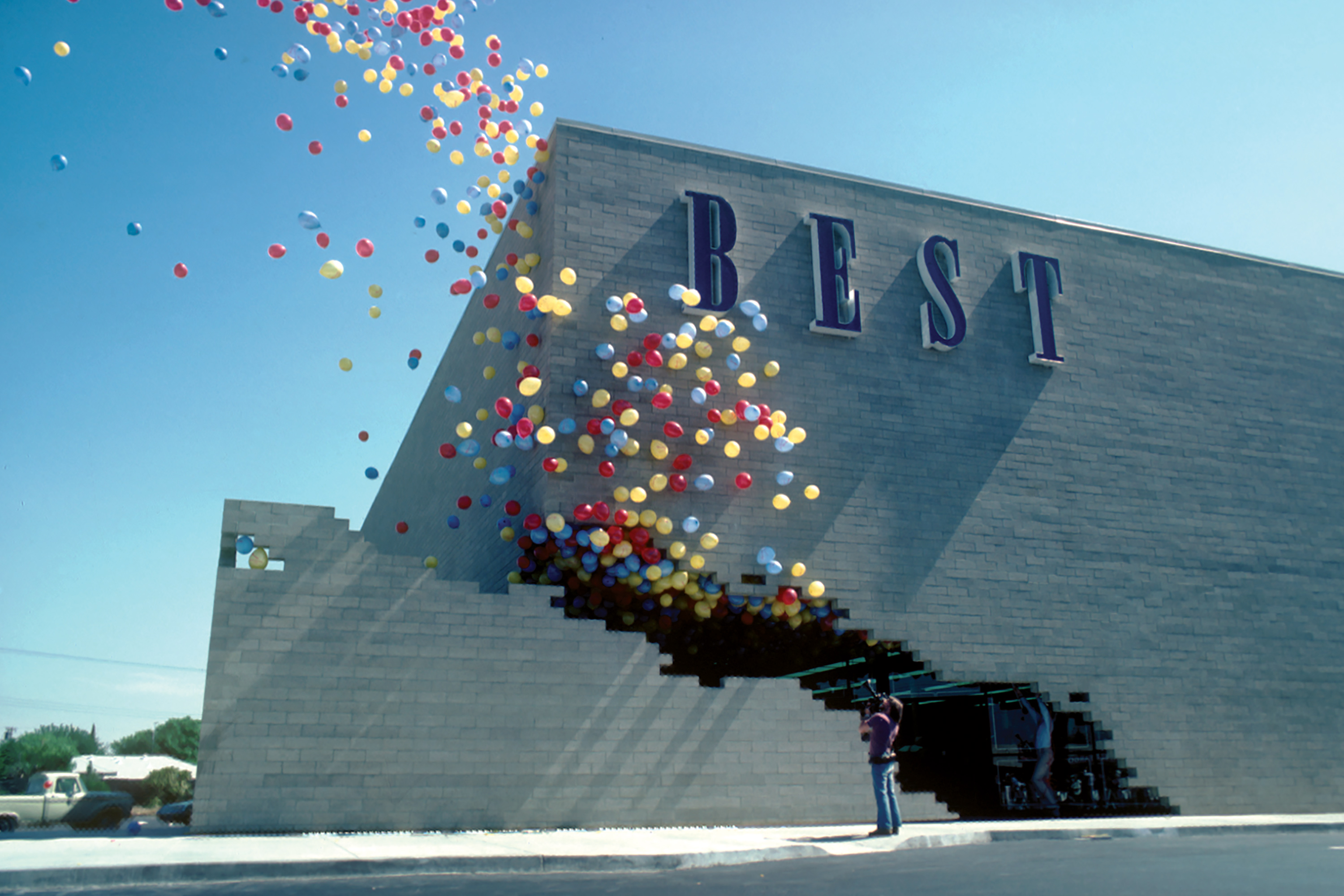 SITE for Best Products Company Inc., BEST Notch Building, Miami, FL, 1979
SITE for Best Products Company Inc., BEST Notch Building, Miami, FL, 1979It is ironic that this window sparked SITE’s collaboration with Smith and Mallet, not only because it was on display for just one day, but also because at that point in the early eighties, SITE had a high-profile international reputation as the subversive pranksters of architecture. Their radical work for BEST chain stores from 1975 to the early eighties achieved something unimaginable. They simultaneously functioned as big box retail stores and giant conceptual sculptures that critiqued the conventions of the big box genre. Eleven different BEST stores were built in total. Each had its own subversive focal point. The 1975 Houston, Texas, store, Indeterminate Facade, featured an apocalyptic roofline of crumbling brick. The 1976 Towson, Maryland, store, Tilt Building, permanently pivoted the entire facade on a 35-degree angle, allowing customers to walk under the resulting chasm and enter through a second hidden glass facade. And the 1980 Richmond, Virginia, store, Forest Building, was designed to allow nature to grow through the facade. “There was lots of controversy swirling around those stores because they used architecture to comment on itself,” explains James Wines, another SITE cofounder.
On paper, the charismatic Wines could have been considered the polar opposite of Smith. Wines is straight, white, and was about fifteen years his client’s senior. Smith was openly gay, Black, and young (early thirties). But beyond these inverse identifying distinctions were two men with profound similarities: both functioned as artists but had chosen to work in commercial fields; both had a taste for fully immersive art, such as theater and land art; both were drawn to works that had a component of social critique; both had a reputation for bucking convention; and both were media darlings.
These affinities sparked an immediate friendship. Wines fondly recalls, “Willi was like an Oscar Wilde character—good looking, charismatic, and not at all pretentious. When you read Wilde you see that he punctures holes in everything and Willi had a bit of that in him too. A conversation with him wasn’t like talking to Donna Karan, it was like talking with an artist. When Alison and I got to know him it was almost like we had known each other our whole lives.”
These affinities sparked an immediate friendship. Wines fondly recalls, “Willi was like an Oscar Wilde character—good looking, charismatic, and not at all pretentious. When you read Wilde you see that he punctures holes in everything and Willi had a bit of that in him too. A conversation with him wasn’t like talking to Donna Karan, it was like talking with an artist. When Alison and I got to know him it was almost like we had known each other our whole lives.”
 James Wines of SITE for WilliWear, Showroom Drawing,
New York, NY, 1980
James Wines of SITE for WilliWear, Showroom Drawing,
New York, NY, 1980“Willi was like an Oscar Wilde character—good looking, charismatic, and not at all pretentious. When you read Wilde you see that he punctures holes in everything and Willi had a bit of that in him too. A conversation with him wasn’t like talking to Donna Karan, it was like talking with an artist.”
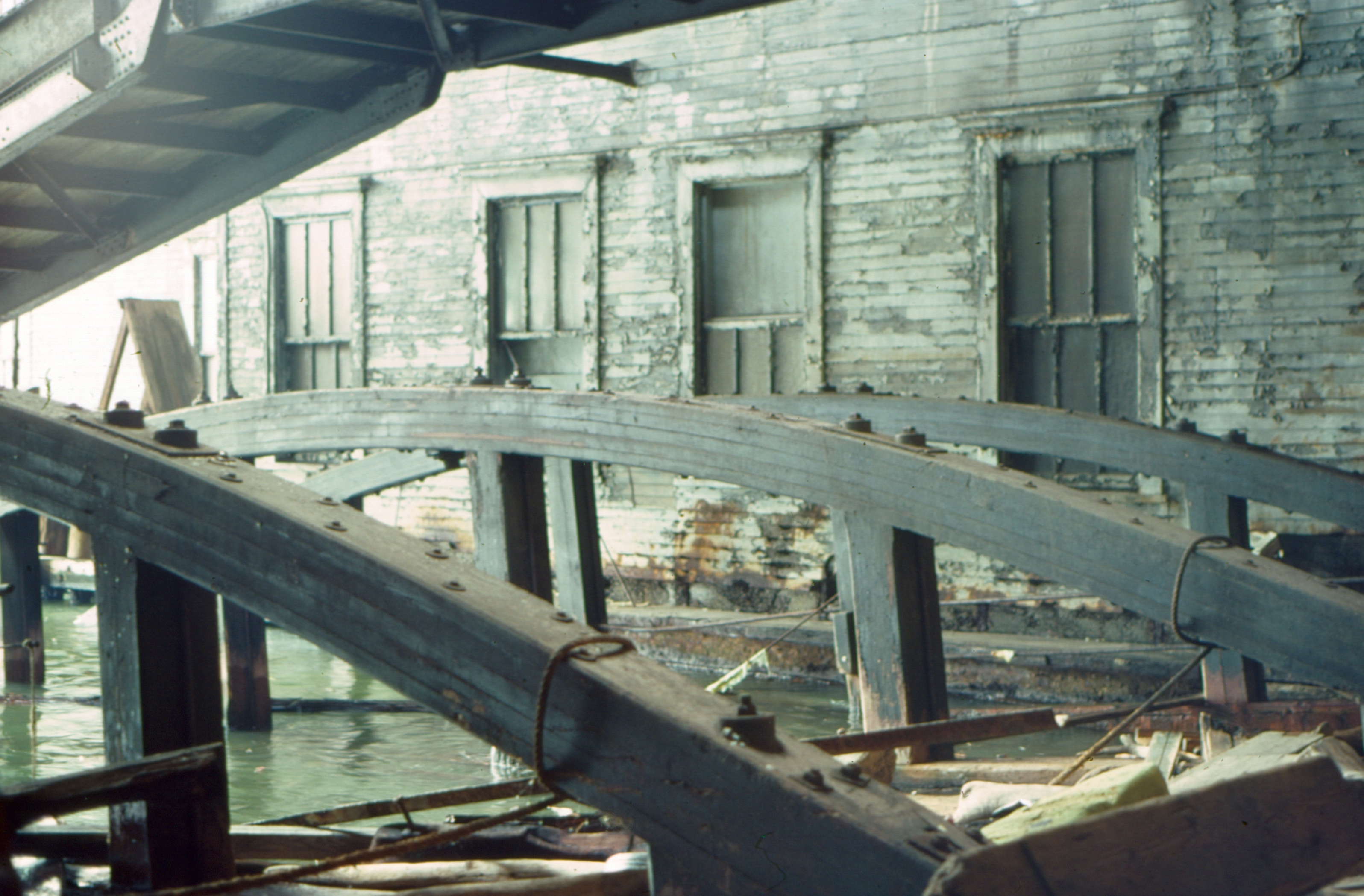
SITE for WilliWear, Showroom Inspiration, 1984
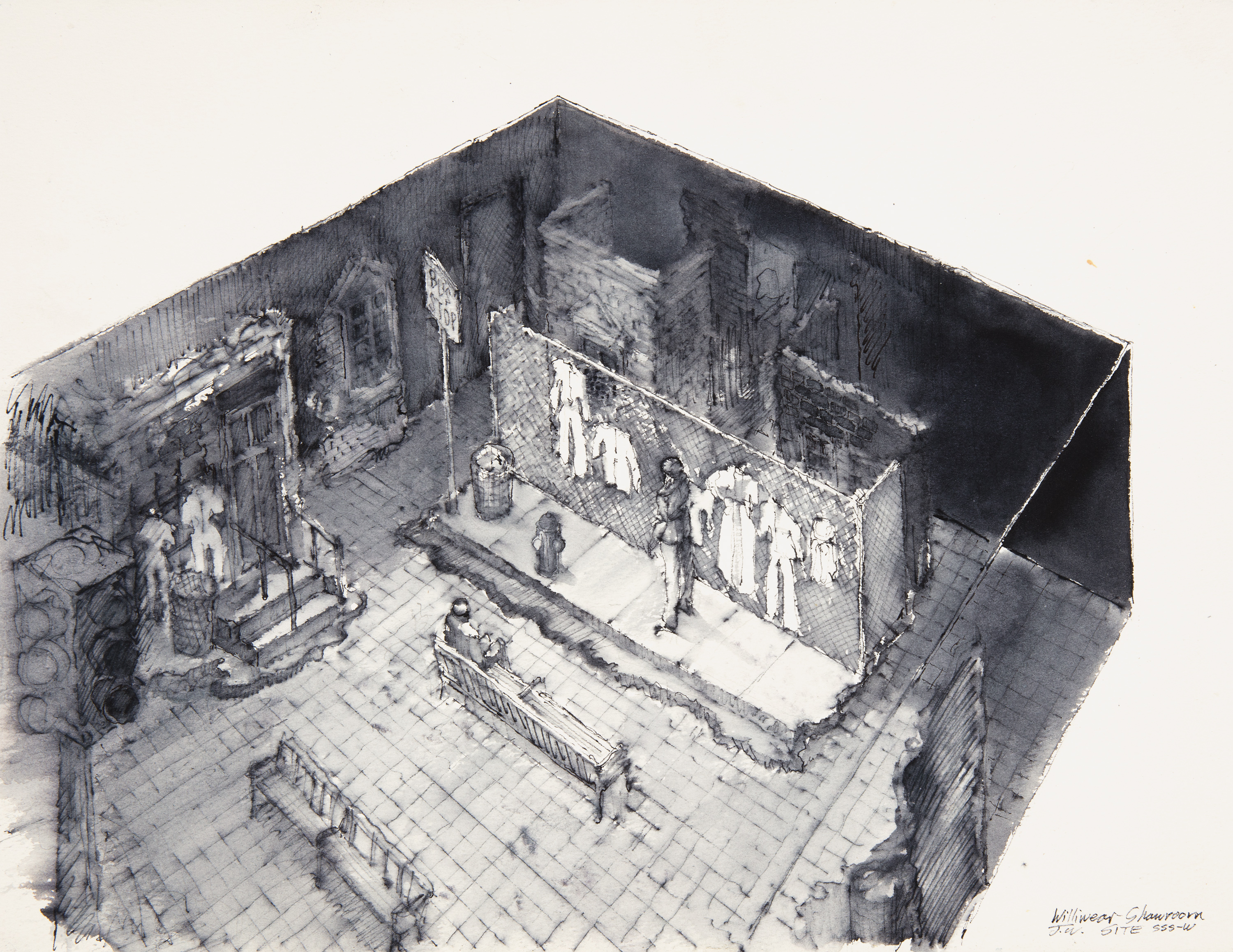
James Wines of SITE for WilliWear, Showroom Drawing, New York, NY, 1983
Sky and Wines interviewed Smith and Mallet in order to understand WilliWear’s goals and dreams. Wines explains, “He told me he wanted his showroom to be the exact opposite of Ralph Lauren. He was not interested in aspirational wealth. He was interested in looking good, being cultured, and enjoying pleasure, and he wanted to share those interests with as many people as possible.” Sky adds, “It can be difficult to answer such simple questions, but when we asked where his inspiration came from he told us it’s from watching people on the street. When he said that, it was so evocative that he didn’t have to say more.” SITE’s conceptual proposal was equally simple. “We said, ‘Let’s just do the street. Let’s bring the street into the showroom.’ And he loved that idea.” For the next step of the process, Smith gave Wines a tour of the Christopher Street Pier, then a notorious gay cruising spot, in order to point out areas that featured his favorite textures, materials, and atmospheres. “He highlighted particular arrangements, specific portions of corrugated metal and pipes. He also took me to the gay bars around the waterfront. He preferred the rough spots: The Hellfire, The Anvil, places that had a very strong character,” recalls Wines. Together SITE and Smith embarked on recreating and repurposing the mood and attitude of places in the city that inspired Smith the most, and formed a team to scour the streets after midnight for authentic discarded materials.
The WilliWear women’s showroom opened in 1982 at 209 West 38th Street in New York City’s Garment District. In many ways it took the original concept from the window display and expanded it into an entire world. The interior featured a detailed streetscape complete with brick and cinderblock facades, multiple doors and windows, sidewalks, window grates, and multiple styles of fencing. In this interior streetscape, elements had multiple functionalities—the city fences and window bars doubled as display racks, which allowed for maximum flexibility for hangers, and the sidewalk doubled as a fashion show runway. Like the bookstore, the reception desk was an unfinished brick wall and the whole interior was painted a specific light pale gray visually unifying the compli- cated space into one cohesive dreamscape. This device animated the vitality in Smith’s work, making the outfits the sole inhabitants of this surrealist ghost city.

SITE for WilliWear, Showroom, New York, NY, Photographed by Andreas Sterzing, 1982



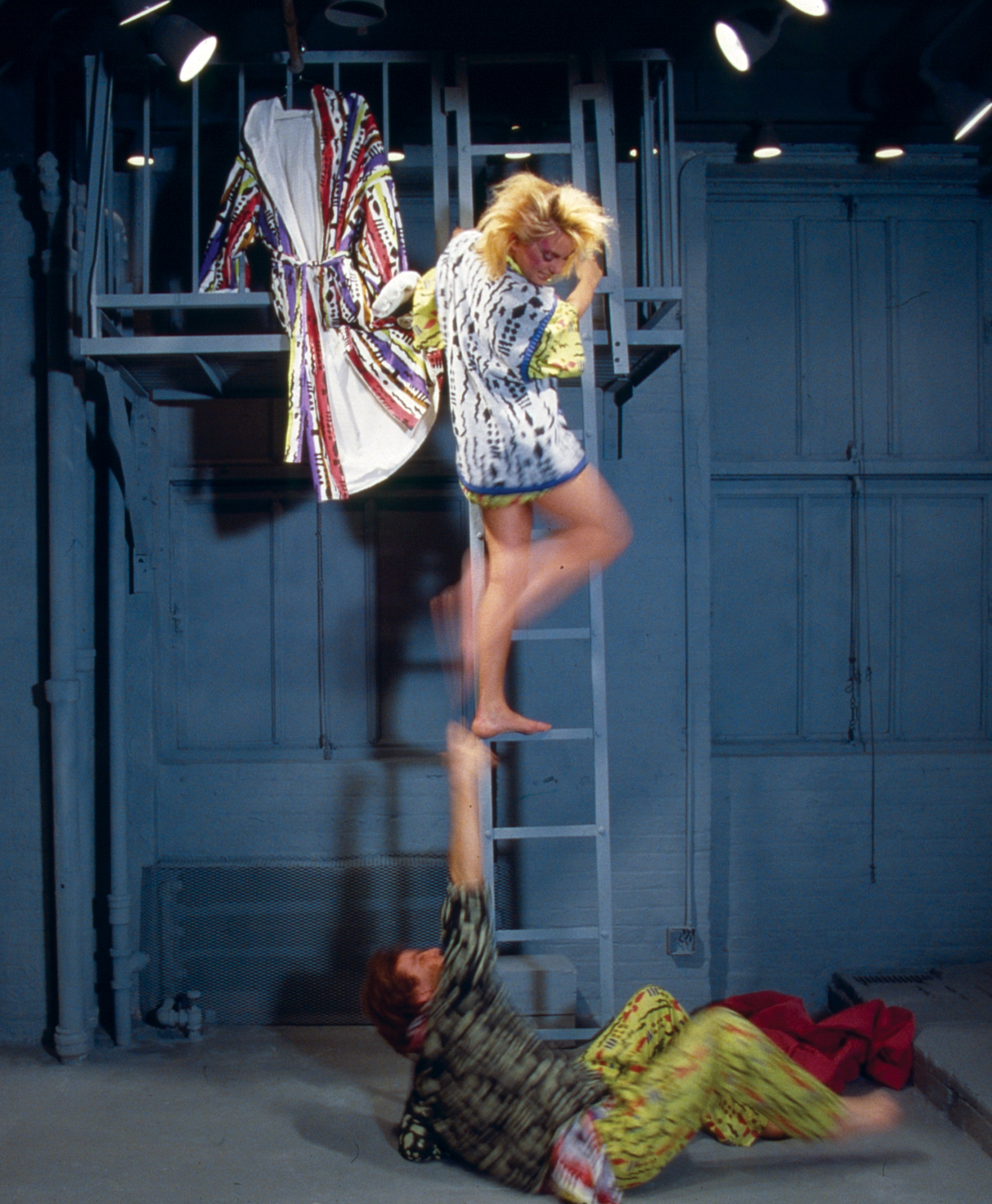
SITE for WilliWear, Showroom, New York, NY, Photographed by Andreas Sterzing, 1984
The men’s showroom opened up later the same year; it utilized the same strategies but visually took its cues directly from the abandoned warehouses on the piers, using as many real materials as possible. “The interiors had architectural plans but their creation was very much about being in the location with the collected materials and collaging the pieces together. The way we work is equally art and design, and art requires you being there and experiencing what works in the moment and making adjustments,” Wines says of their process. Both of these unconventional interiors were extremely successful. As Sky recalls, “They were places people wanted to stay in and functioned
wonderfully for buyers, fashion shows, and celebrations. They were completed by the
vibrant clothing and people who entered.”
In 1997, writer and architectural critic Aaron Betsky’s book Queer Space: Architecture and Same-Sex Desire sought to redefine spaces like the Chelsea Piers during the eighties, describing them as a misuse or deformation of a place, an appropriation of the buildings and code of the city for perverse purposes. Betsky found this type of space liberating and believed it was vital in helping residents alleviate some of the imprisoning characteris- tics of the modern city. But long before queer architecture was validated by academia, Smith harnessed this energy, parading his industry’s crème de la crème—fashion editors, models, and celebrities—through a space modeled after a location notorious for anonymous, public, gay sex; the ultimate subversive political act for a daring, out fashion designer. Whatever his intentions were the designer was quite buttoned up about them. “He may or may not have used the piers for pleasure. That was his private life and it was private. It never seemed to me like Willi had an agenda. I think he was inspired by the piers because they were seductive and real,” Wines explains. Even designer Andre Walker, who worked in the men’s showroom from 1988 to 1989, was not aware of their origins. “The fact that it was a reference to the piers went over my head. I just thought it was a cool street/urban vibe. It’s also quite telling that they didn’t change the showroom decor for over seven years.”
In 1997, writer and architectural critic Aaron Betsky’s book Queer Space: Architecture and Same-Sex Desire sought to redefine spaces like the Chelsea Piers during the eighties, describing them as a misuse or deformation of a place, an appropriation of the buildings and code of the city for perverse purposes. Betsky found this type of space liberating and believed it was vital in helping residents alleviate some of the imprisoning characteris- tics of the modern city. But long before queer architecture was validated by academia, Smith harnessed this energy, parading his industry’s crème de la crème—fashion editors, models, and celebrities—through a space modeled after a location notorious for anonymous, public, gay sex; the ultimate subversive political act for a daring, out fashion designer. Whatever his intentions were the designer was quite buttoned up about them. “He may or may not have used the piers for pleasure. That was his private life and it was private. It never seemed to me like Willi had an agenda. I think he was inspired by the piers because they were seductive and real,” Wines explains. Even designer Andre Walker, who worked in the men’s showroom from 1988 to 1989, was not aware of their origins. “The fact that it was a reference to the piers went over my head. I just thought it was a cool street/urban vibe. It’s also quite telling that they didn’t change the showroom decor for over seven years.”
Building on this momentum, SITE embarked on another round of projects. Next was Smith’s personal office, which was an extension of the pier theme in the men’s showroom. In London they took over a corner of Harrod’s, the prestigious upscale department store, and turned it into a permanent construction site. The Los Angeles showroom was a ghost beach, and the flagship store on Fifth Avenue in Manhattan featured an elaborate urban park in which monochrome light-gray ivy had overtaken the entire retail environment. The final project in 1985 was Mallet’s private residence, which again extended SITE’s strategies, ghosting a Greenwich Village townhouse.

SITE for WilliWear, Showroom, New York, NY, 1984

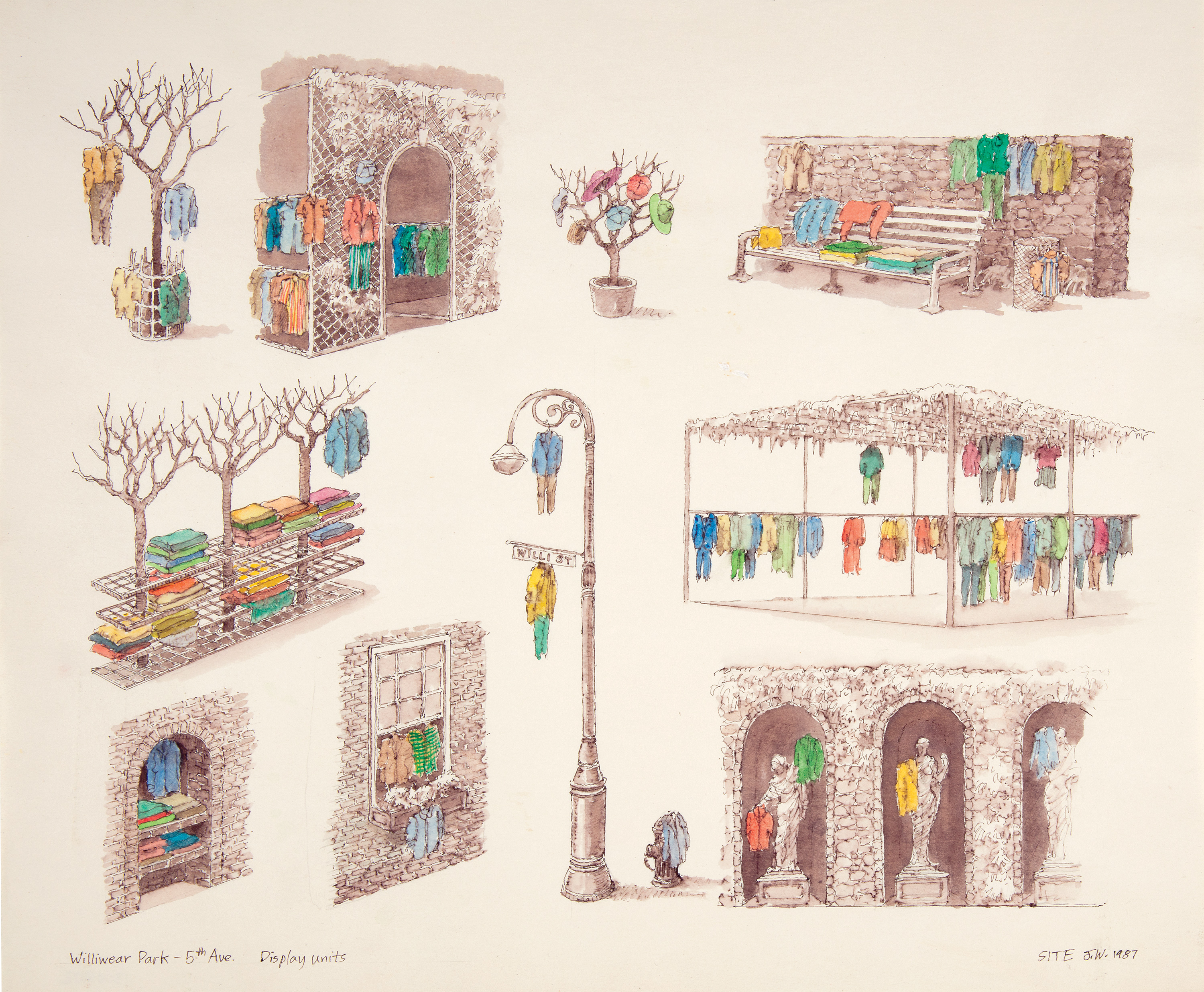
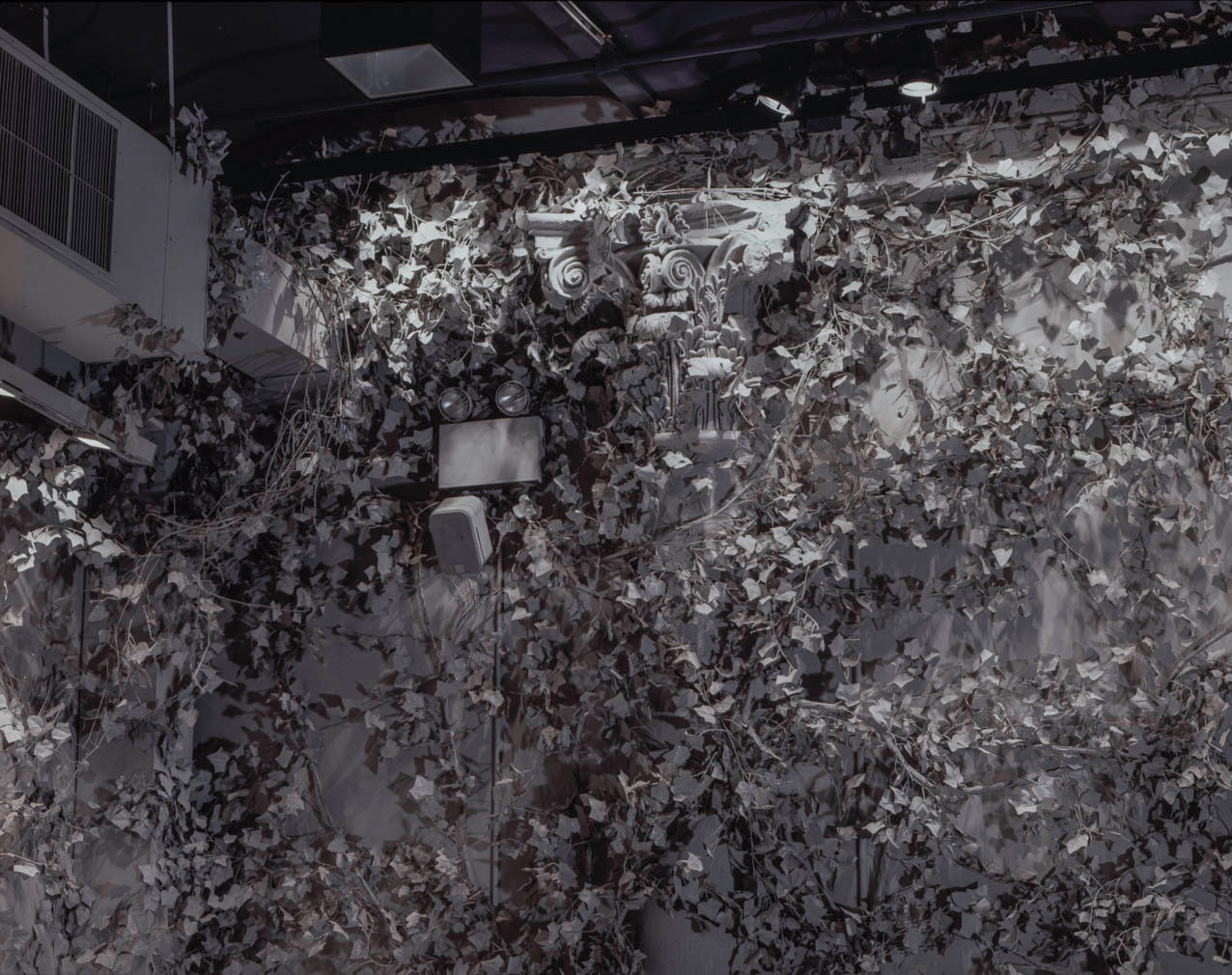

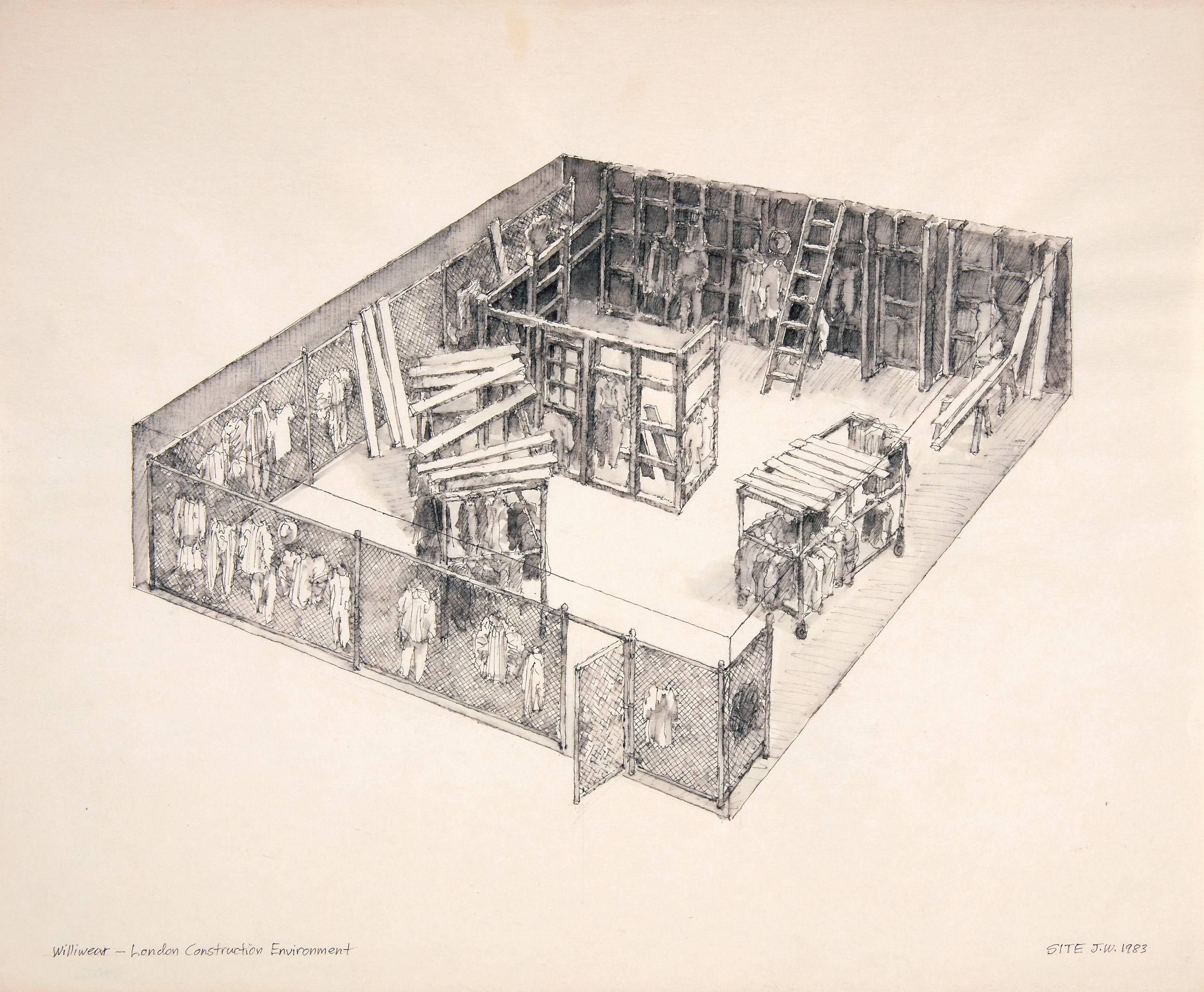

SITE and Smith collaborated successfully because at the
core of their practices was the concept of starting with
common references. Wines elaborates, “In order to make
a strong statement that can affect that most diverse audience, you have to begin with what’s common. We really
shared that, a conception of starting with the commonplace but then making an intervention that changes the meaning. That is a powerful act. Everyone can relate to the ordinary, but then they experience something extraordinary. We both had a mission of putting art in places where you least expected to find it.”
Michael Bullock is a writer who has been actively involved in independent magazine publishing for over a decade. He contributes regularly to the architecture and design publication PIN–UP.
Rebellion in Design: Developing a Blueprint for the Future
Virgil Abloh (Chief Creative Director and founder of Off-White™️ and Men’s Artistic Director at Louis Vuitton) and architect James Wines (Founder, SITE; 2013 National Design Award winner) in conversation with interdisciplinary architect Oana Stănescu on the cross-sections of fashion and architecture as related to the making of spaces and culture, and disrupting hegemony through design.
Willi Smith In Pieces
Jarrett Earnest
 Willi Smith, Photographed by Rosemary Peck, ca. 1982
Willi Smith, Photographed by Rosemary Peck, ca. 1982I.
In August 1972, as the artists Christo and Jeanne-Claude were preparing to unfurl 200,200 square feet of orange nylon between two Colorado mountains, they received a phone call from a young friend in New York, the designer Willi Smith. He wanted to join them. They told him it wasn’t easy to get there—he’d have to fly to Denver, take a bus six hours to Grand Junction, then another for an hour and a half to the town of Rifle, seven miles from the site. He was undeterred. They were delighted. A pair of radical conceptual artists with thick European accents, Christo and Jeanne-Claude were exotic in the rural American West. It would be good to have the company of a fellow cosmopolitan. Then Jeanne-Claude got nervous. She hadn’t seen any Black people in the region. How would the locals react? When she hadn’t heard from him on the afternoon of his arrival, she went to Rifle to investigate. At the town’s cowboy bar she found Smith at the center of a group talking and laughing together. He was festooned with a monkey-fur coat with a crossed-pistol belt buckle.1Smith, then in his early twenties, was already prominent as a designer at the label Digits and a habitué of New York’s art and fashion worlds but little known otherwise. That started to change when he got a call from Laurie Mallet, a student of political science and economics in Paris who was trying to subsidize a New York holiday by selling French textiles to American designers. The two met and instantly liked each other. He hired her as an assistant when she moved to New York. By the mid-seventies they’d both left Digits and were going out on their own, Mallet running a textile company that manufactured shirts out of cotton gauze and Smith planning to launch a brand. She proposed that they travel to India to source fabric. He could design a line they’d put into production, which later she’d figure out how to sell. On the trip, he drew a cartoon of them smiling together, his arm resting on her shoulder and hers wrapped around his waist holding a cigarette emitting a squiggle of smoke. A single line shaped the curves of an unfamiliar skyline “Bombay—1976” is written in the upper left corner, with a little rectangle drawn below it that would evolve into the logo of their joint venture: WilliWear Ltd.
 Willi Smith, Drawing of Willi Smith and Laurie Mallet, 1976
Willi Smith, Drawing of Willi Smith and Laurie Mallet, 1976
Mallet immediately bonded with Smith’s friends Jeanne-Claude and her husband, among others in a growing tribe of WilliWear collaborators. In 1983, when Christo and Jeanne-Claude were about to surround eleven islands in Miami’s Biscayne Bay with floating hot pink polypropylene, WilliWear produced pink long-sleeve shirts with the words “Christo Surrounded Islands” in sky-blue ink on the back left shoulder and matching white caps with cotton flaps down the back. The shirts were worn by the 430 members of the workforce and 120 monitors who patrolled the area during the two weeks of the installation. Several thousand extras made for sale as souvenirs were shopped to stores in Miami, every one of which turned them down, so they were sold off the back of a truck. The shirts proved to be a smash. They complemented Christo’s art of real-world, festive pleasures, accessible to everyone, extending the project beyond the bay and into the city. Then, like countless amateur snapshots that documented the two-week artwork, the shirts assumed an afterlife as mementos.
The experience of Surrounded Islands excited Smith and Mallet to seek collaboration with other contemporary artists in the same avant garde dream of bringing the spirit of “high art” into the lives of regular folks. They reached out to about twenty artists to design T-shirts, including figures of the sixties generation, each in their way dedicated to bridging art and life—Robert Rauschenberg, Les Levine, Nam June Paik, and Arman. WilliWear extended this list to the graffiti artists Dondi, Futura, and Keith Haring, and to such emerging conceptualists as Jenny Holzer, Barbara Kruger, and Lynn Hershman. Completing the artistic family were Christo; SITE; Mallet’s stepfather, the painter Severo, and her then boyfriend, the designer Dan Friedman. The shirts by the cohort, framed and cellophane wrapped, priced at thirty-seven dollars and one-size-fits-all, were shown at the Ronald Feldman Gallery in the summer of 1984.
Barbara Kruger knew of Willi Smith from her work as an editorial designer in the seventies at the counterculture magazine Rags and then at Condé Nast’s Mademoiselle. Relatively unknown as an artist, she jumped at the opportunity offered by WilliWear. Her shirt sports a black-and-white face—eyebrows and lips feminized with heavy cosmetics. Across the eyes runs a slanted black bar with white text: “I can’t look at you.” Another completes the phrase below the chin: “and breathe at the same time.” When one encounters the shirt on a body moving down the street, the image and the captions become legible at different speeds. Interpretation is further shaped by impressions of the person wearing it. Kruger said that the idea of the garment’s accessibility, traveling freely through culture, appealed to her conceptually: “The way people wear corporate logos or political slogans on their clothes is a kind of public construction that displays the broadcast of self, replete with affiliations and hierarchies, and congeals quite simply into both the brilliance and idiocy of fashion.”2
The experience of Surrounded Islands excited Smith and Mallet to seek collaboration with other contemporary artists in the same avant garde dream of bringing the spirit of “high art” into the lives of regular folks. They reached out to about twenty artists to design T-shirts, including figures of the sixties generation, each in their way dedicated to bridging art and life—Robert Rauschenberg, Les Levine, Nam June Paik, and Arman. WilliWear extended this list to the graffiti artists Dondi, Futura, and Keith Haring, and to such emerging conceptualists as Jenny Holzer, Barbara Kruger, and Lynn Hershman. Completing the artistic family were Christo; SITE; Mallet’s stepfather, the painter Severo, and her then boyfriend, the designer Dan Friedman. The shirts by the cohort, framed and cellophane wrapped, priced at thirty-seven dollars and one-size-fits-all, were shown at the Ronald Feldman Gallery in the summer of 1984.
Barbara Kruger knew of Willi Smith from her work as an editorial designer in the seventies at the counterculture magazine Rags and then at Condé Nast’s Mademoiselle. Relatively unknown as an artist, she jumped at the opportunity offered by WilliWear. Her shirt sports a black-and-white face—eyebrows and lips feminized with heavy cosmetics. Across the eyes runs a slanted black bar with white text: “I can’t look at you.” Another completes the phrase below the chin: “and breathe at the same time.” When one encounters the shirt on a body moving down the street, the image and the captions become legible at different speeds. Interpretation is further shaped by impressions of the person wearing it. Kruger said that the idea of the garment’s accessibility, traveling freely through culture, appealed to her conceptually: “The way people wear corporate logos or political slogans on their clothes is a kind of public construction that displays the broadcast of self, replete with affiliations and hierarchies, and congeals quite simply into both the brilliance and idiocy of fashion.”2
Contemporary artists had never before collaborated with a fashion label to create industrially produced clothes, a strategy now ubiquitous in fashion culture. Smith thought people were intimidated by art museums. Of the collaborations he said: “This way we are bringing the artist closer to the people. It’s really street art. I want to see us involved more with art in the community.”3 Keith Haring echoed the sentiment when describing the aims of his Pop Shop, which opened in 1986: “I wanted to continue this same sort of communication as with the subway drawings. I wanted to attract the same wide range of people, and I wanted it to be a place where, yes, not only collectors could come, but also kids from the Bronx. . . . The main point was that we didn’t want to produce things that would cheapen the art. In other words, this was still an art statement.”4
![Laurie Mallet, Willi Smith, and Dan Friedman at The Pont-Neuf Wrapped, Photographed by Mark Bozek, 1985]() Laurie Mallet, Willi Smith, and Dan Friedman at The Pont Neuf
Wrapped, Photographed by Mark Bozek, 1985
Laurie Mallet, Willi Smith, and Dan Friedman at The Pont Neuf
Wrapped, Photographed by Mark Bozek, 1985
![]()
Christo and Jeanne-Claude, The Pont-Neuf Wrapped, Photographed by Wolfgang Volz, 1985
 Laurie Mallet, Willi Smith, and Dan Friedman at The Pont Neuf
Wrapped, Photographed by Mark Bozek, 1985
Laurie Mallet, Willi Smith, and Dan Friedman at The Pont Neuf
Wrapped, Photographed by Mark Bozek, 1985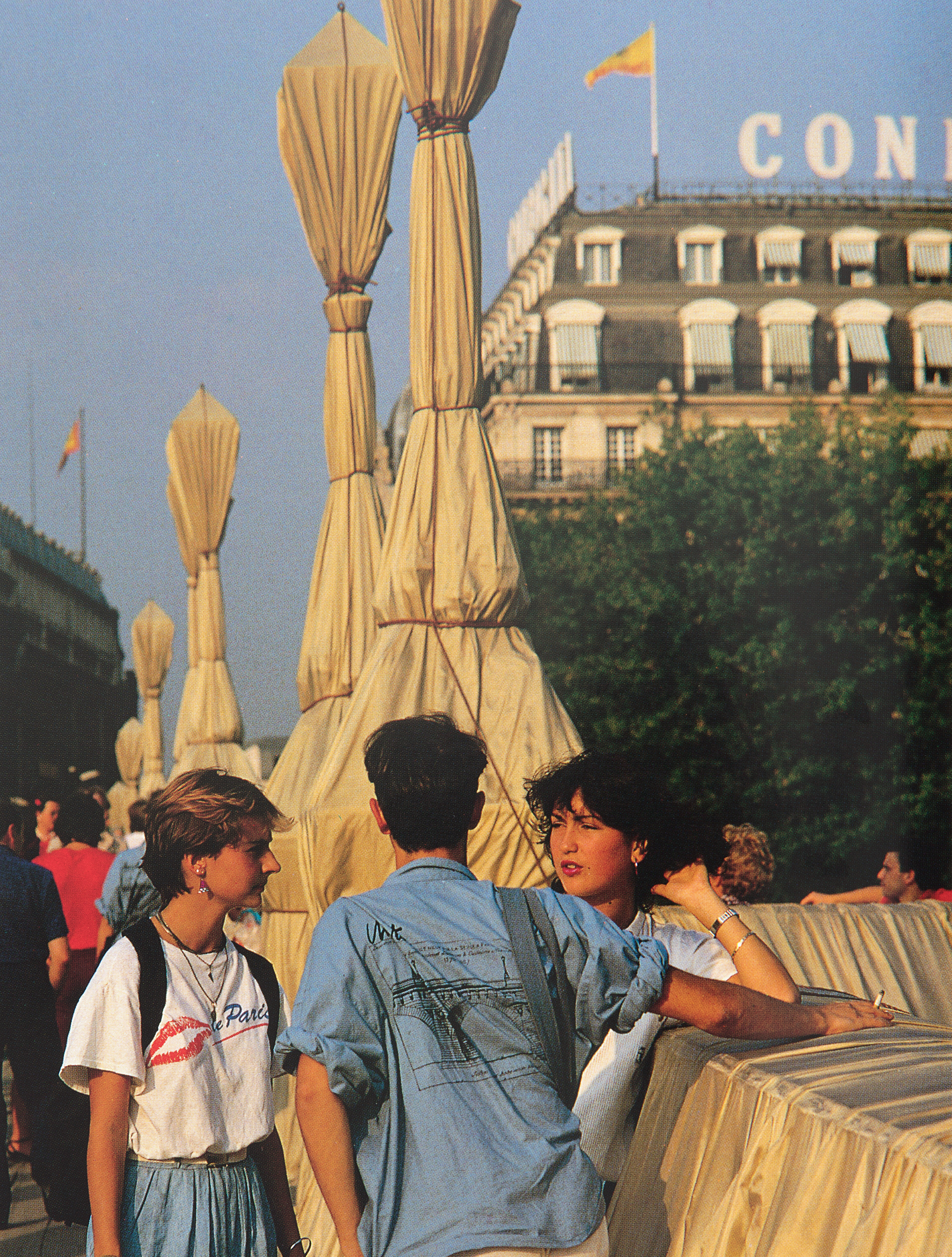
Christo and Jeanne-Claude, The Pont-Neuf Wrapped, Photographed by Wolfgang Volz, 1985
 Christo and Jeanne-Claude, Surrounded Islands Construction Site, Photographed by Wolfgang Volz, 1983
Christo and Jeanne-Claude, Surrounded Islands Construction Site, Photographed by Wolfgang Volz, 1983 Christo and Jeanne-Claude, Surrounded Islands, Photographed by Wolfgang Volz, 1983
Christo and Jeanne-Claude, Surrounded Islands, Photographed by Wolfgang Volz, 1983
In 1985 Christo and Jeanne-Claude finally succeeded in a ten-year campaign to wrap the Pont Neuf. If pink T-shirts were right for scrappy South Floridians, the workers engaging visitors on the oldest bridge in Paris needed something more elegant. Smith designed a loose-fitting sky-blue smock, riffing on the iconic bleu de travail French work jacket, with matching trousers, the blue outfits playing off the tawny champagne of the bridge’s ruched material. Oversized pockets, hung low, could accommodate fabric samples and informational brochures. Like all of Smith’s clothing, it was comfortable and adaptable, for wearing with rolled sleeves or hiked legs or unbuttoned with an undershirt. It was a professionalizing uniform that allowed for maximum individuality. Interviewed at the time, Smith said: “I’m also looking forward to seeing if people can really work in the clothes. I could eventually make some real workwear. . . . Everyone likes the style so much I may put it on the spring line. It may be a new way to develop our artist-in-clothing project.”5 At one point, Christo showed him an advertisement in a Paris newspaper for one of the uniforms. The price: $1,000. Smith laughed and said, “Oh! Now I’m haute couture!”6
“My whole theory about design is to try to solve some of these problems,” Smith once said. “To help people through clothing to solve the problem of getting dressed.”7 The concern wasn’t limited to celebrities on their way to galas. He had devoted himself from the start, in the early seventies, to finding solutions within the reach of almost anyone. One way was to make his designs available as patterns through services like Butterick and McCall’s, a practice that spanned his entire career. He valued people who sewed their own clothes at home, as members of his family had done in working-class Philadelphia. He explained: “To be able to go and buy the fabric. Already you have one exciting purchase—you bought beautiful fabric—and you get excited about that. You might take it home and may not even buy the pattern for two weeks later. Then you go and buy something else which you are equally excited about which is the pattern. And then the excitement of putting it together. It’s like a whole different way of dressing than buying clothes.
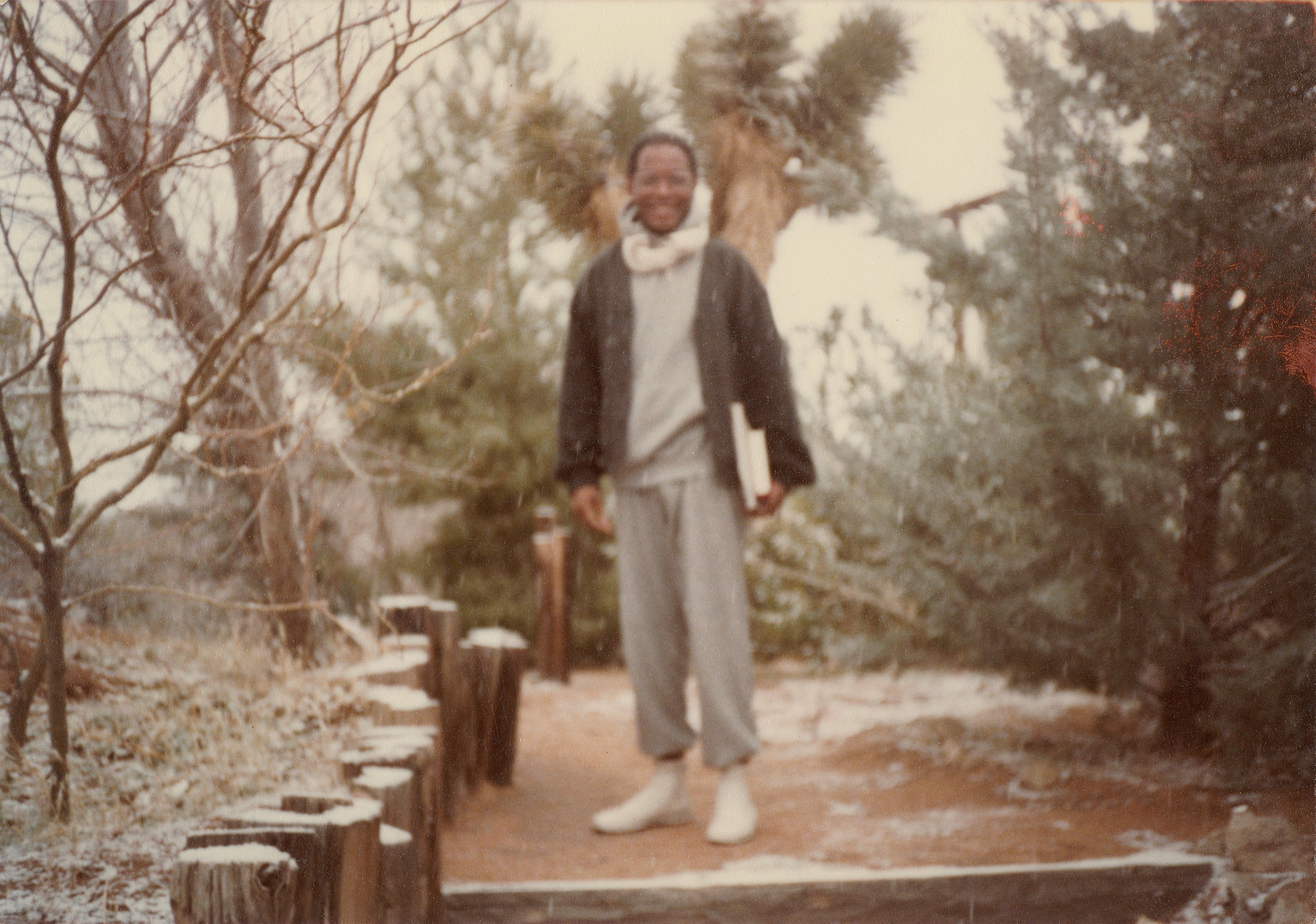
Willi Smith in Palm Springs, CA, Photographed by Rosemary Peck, ca. 1982
“Buying clothes is a one-time thing. You go in and buy something, take it home. You may like it, you may hate it the next minute, it’s a one-time thing. This is a multiple experience, I think. I know, a lot of girls say to me, ‘We really dig your stuff a lot, but sometimes we can’t afford to buy all that we would like to buy,’ so I had no answer for them. Now I feel through this medium that I do.”8 Meanwhile, disdaining to build an elite identity around fashions unwearable in daily life, for one thing, and inaccessible to all citizens, for the clincher, Smith concentrated on designing budget-priced clothes for sale at regular department stores.
“‘Fashion’ was a word we hardly ever used,” recalls Bethann Hardison, who Smith “discovered” walking down Seventh Avenue in 1967, and instantly recruited as model, collaborator, and friend. She understood Smith’s approach to style as holistic, a larger attitude toward being creative than the term “fashion” might imply. “It wasn’t so much he wanted to change the way we looked at fashion,” she says. “It was a way of seeing how much further you can push it. How many more ways you can utilize something, create. So he happened to be a designer, but he was an artist. That is why he appreciated artists so much. Anything he could do—including patterns—was another way of changing what you could get people to see.”9
“‘Fashion’ was a word we hardly ever used,” recalls Bethann Hardison, who Smith “discovered” walking down Seventh Avenue in 1967, and instantly recruited as model, collaborator, and friend. She understood Smith’s approach to style as holistic, a larger attitude toward being creative than the term “fashion” might imply. “It wasn’t so much he wanted to change the way we looked at fashion,” she says. “It was a way of seeing how much further you can push it. How many more ways you can utilize something, create. So he happened to be a designer, but he was an artist. That is why he appreciated artists so much. Anything he could do—including patterns—was another way of changing what you could get people to see.”9
This manifested in his commitment to “basics” that could be worn in many combinations, styled up or down for the occasion, by the person getting dressed. It’s a philosophy further summarized by Mallet: “There is nothing worse than wearing a designer outfit and not feeling good because it’s not you, it’s the designer’s. Once they were sold they were not Willi’s clothes anymore, they became yours. His great talent was creating clothes that you could own.”10
II.
Rosemary Peck remembers first hanging out with Willi Smith in the early seventies. She had just moved with her three children back to New York from Roslyn, Long Island, to pursue her burgeoning jewelry business. The two met through a mutual friend, designer Harriet Selwyn, who had worked with Willi at Digits. One day he invited Rosemary to his apartment on Horatio Street. They talked the day away: he told her about being raised by his grandmother, Gladys Bush, who had worked as a housekeeper to put him through school, supporting his dream of becoming a designer; Rosemary told him about her divorce and how she had started making jewelry to have a life on her own; they fell quiet at times, comfortable being together.

Jerry Isenberg, Willi Smith, Rosemary Peck, and Harriet Selwyn in Los Angeles, CA, Photographed by Jean Desaarin, 1980
Over the next decade he regularly phoned her at her duplex in Chelsea, joined her and her kids for family dinners, and invited her out to see kabuki or to go dancing at downtown clubs. They became part of each other’s families—she hired his mother, June, to help with her jewelry, often traveled with his younger sister Toukie, and met Nana Bush in Philadelphia. Their scene was raucous and extremely social, but she increasingly noticed Smith’s heavy drinking, which helped him cope with the demands of his public life. When Rosemary took a house with an art studio in Joshua Tree, California, in the early eighties, Willi came for Christmas. Because it was the desert, he brought shorts and only light clothes. He was shocked when it snowed. After a drive into Palm Springs to find him something warmer, Rosemary took a picture. In a landscape lightly dusted with white, Willi wears gray sweats, a dark jacket, and a white scarf and holds sketchbooks under one arm. He gazes at her through the lens with vivid affection, beaming. During that visit, he drew her at work painting. She is turned away, contrapposto, with arms and legs at jaunty angles. The style of the drawing recalls the softness of sketches by Christian Bérard, with marks moving in and out of smudges in negative space. The touch is light, immediate, intimate.
“There is nothing worse than wearing a designer outfit and not feeling good because it’s not you, it’s the designer’s. Once they were sold they were not Willi’s clothes anymore, they became yours. His great talent was creating clothes that you could own.”
Theirs was a romance without sex. In matters of style, they were soulmates, bonding over what they found beautiful and sharing an instinct for how to put things together. Smith invited her back to New York to live with him while she decorated his new apartment on Lispenard Street, on the other side of Canal Street from Christo and Jeanne-Claude. He had a collection of African antiques and contemporary art but very little furniture. One night, as they walked home from dinner in Chinatown, Rosemary spotted a stack of battered wooden shipping pallets. She knew they’d work. Smith hired a passerby to help and they brought two to the loft. Snapshots show one used as a coffee table holding a large potted plant, an arrangement of Japanese vessels, an African bust, and a 1978 work by Christo (a wrapped copy of the book Modern Art by Sam Hunter and John Jacobus). The scavenged pallet served those objects well and communed at ease with an Alvar Aalto chair and a wall arrayed with prints from Christo’s series (Some) Not Realized Projects (1971).
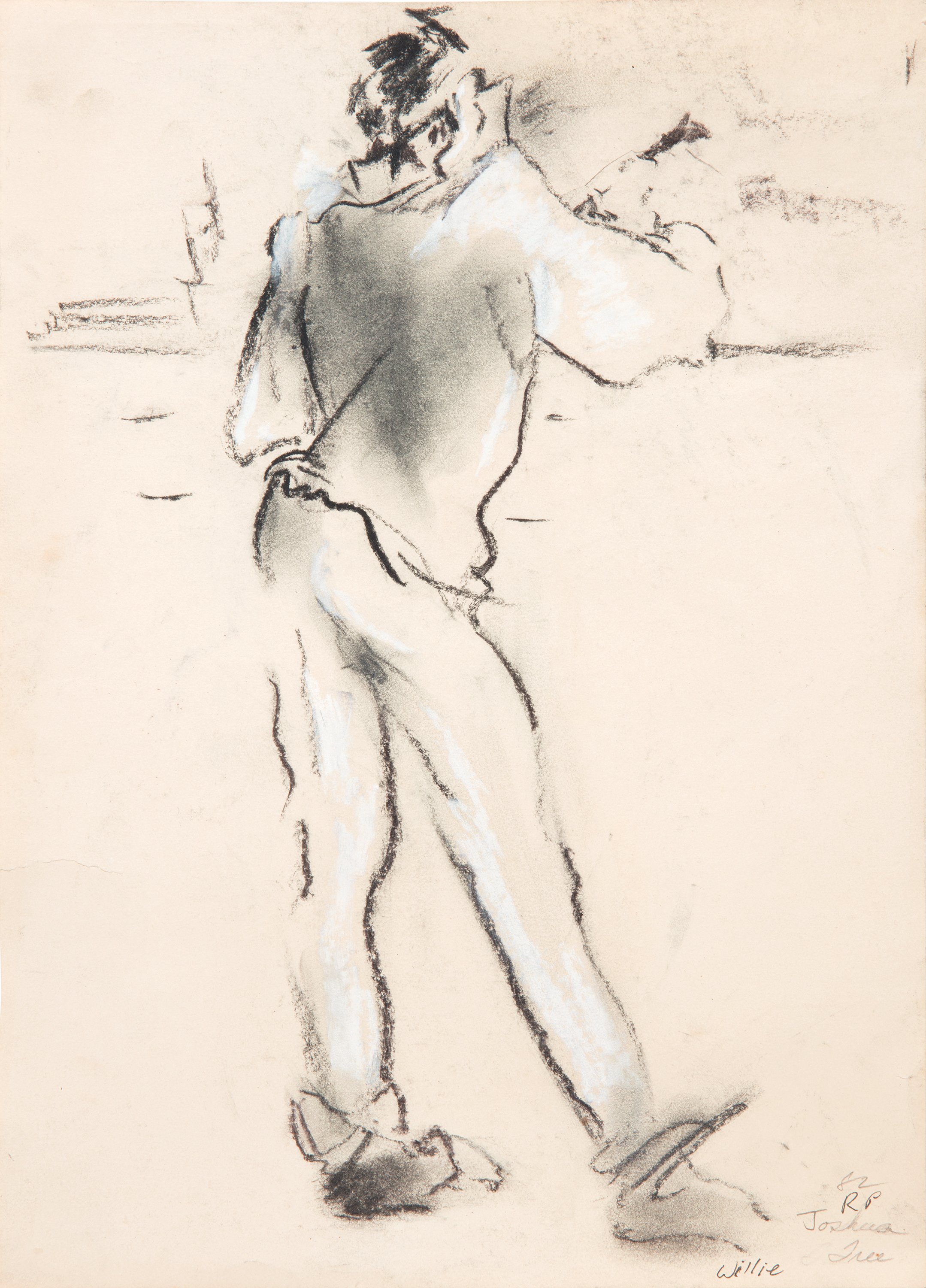
Willi Smith, Sketch of Rosemary Peck, 1982
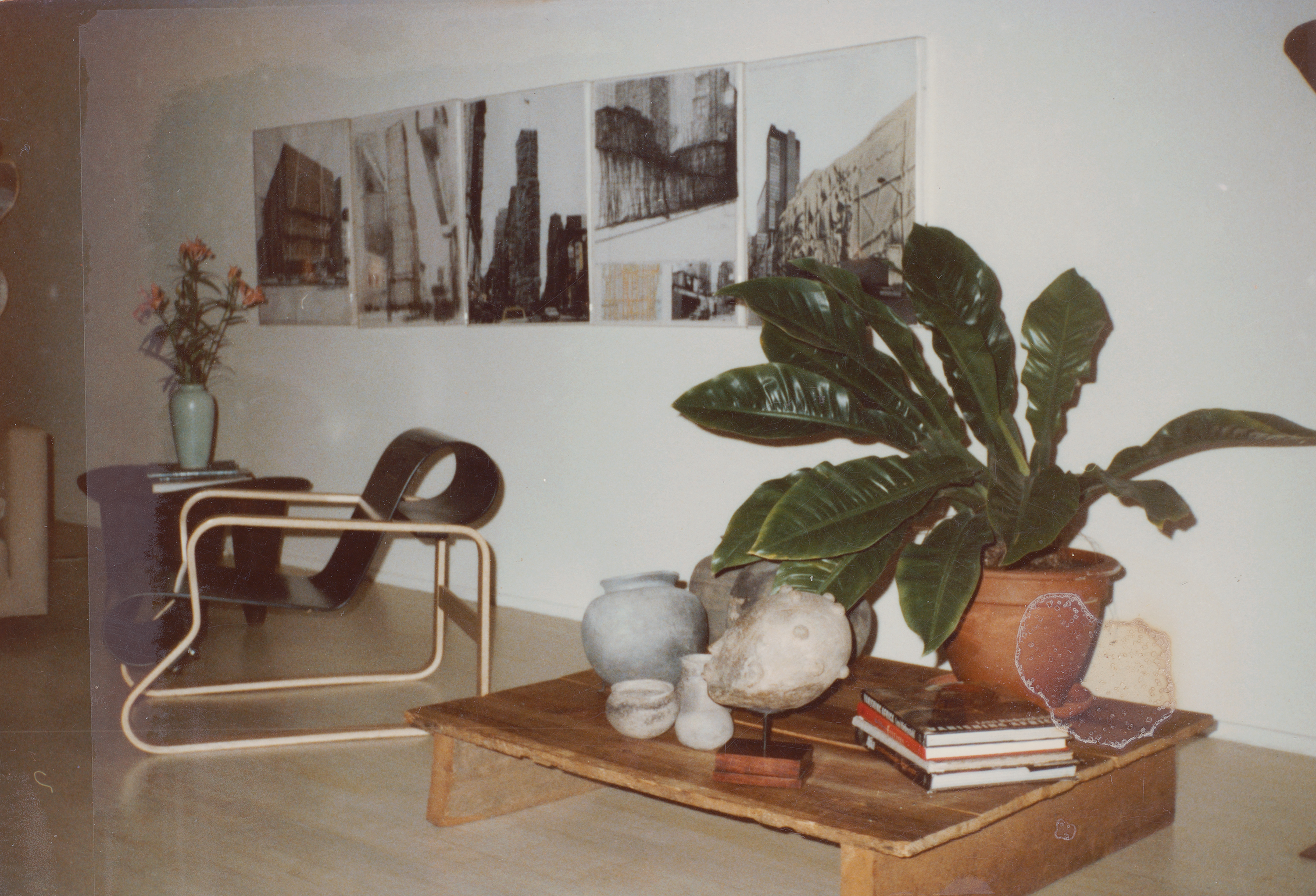 Interior of Willi Smith’s Lispenard Street Loft, Photographed by Rosemary Peck, 1986
Interior of Willi Smith’s Lispenard Street Loft, Photographed by Rosemary Peck, 1986
Interior of Willi Smith’s Lispenard Street Loft, Photographed by Rosemary Peck, 1986
New York magazine celebrated the apartment in “Special Effects,” a twenty-five-page photo-essay by Marilyn Bethany and Oberto Gili, on the reemergence of the “artist craftsman” in interior design (the magazine’s cover was an image of SITE’s remodel of Laurie Mallet’s townhouse).11A six-page spread of Willi’s airy loft called it “artlessly artful”: the walls and couch were white and the furniture and art predominantly black, with painted zebra rugs splitting the difference. The look typified Rosemary’s graphic design aesthetic, favoring white walls as grounds for the color accents of flowers and of people moving in and out of the rooms. The space is fluidly changeable—alive. A large Keith Haring drawing of interlocking figures hangs with the Christo prints. The Modern Art piece occupies a dark green coffee table shaped like the continent of Africa, designed by Dan Friedman. White orchids, Willi’s favorite, abound. Rosemary remembers teasing him that he must have been a prince in a former life. He laughed and said, “Only a prince?!”12
Around the same time, in the spring of 1986, Willi’s mother died. They were very close, but his feelings around her were complex. Many times through the years he and Rosemary had commiserated with one another’s heart-breaks, but dealing with this far heavier blow deepened their bond. For her birthday that May he gave her an advance copy of Susan Vogel’s landmark book African Aesthetics, inscribed: “To my dear friend Rosemary, When I think of beautiful things I think only of you. Losing my mom at this time I feel even closer to you emotionally and spiritually. I really love you Rosemary and value our growing friendship. Happy fifty. . . . love Willi.”
Later that year he visited her new place on Rossmore Avenue in Los Angeles, which she had done up in a California version of a Park Avenue interior. Willi had finally gone to the Betty Ford clinic and gotten sober. He looked like a movie star. When she told him so, he laughed, saying that he’d actually been thinking of working in film, both in front of and behind the camera. On the morning of his return to New York, Willi proposed to her. “We could share a beautiful life together. . . .” She played it off. Then he mentioned that he had a lump at the back of his neck. Rosemary put her hand there. The glands were swollen. Neither uttered the word “AIDS,” but it occurred to her. Driving him to the airport, she took a wrong turn and wound up in Long Beach. She later attributed this to an unconscious wish that he not leave. The next day he flew to India for a month. Upon his return, in early 1987, he told Rosemary over the phone that on the Ganges he had felt someone tap him on the shoulder. It was his mother.
Just before Rosemary left on a business trip to Brazil with Harriet Selwyn, Bethann called in tears. “Rosie, our brother Willi is not well,” she said.
Rosemary remembers begging Harriet to cancel their trip, but it was all arranged and paid for and they had to go. Once she got to the hotel in Brazil a woman approached her, asked her name, and told her she’d had calls. They left that night for New York. On Friday, April 17, 1987, a day after being admitted to Mount Sinai Medical Center, Willi Smith died. He was thirty-nine years old.
Around the same time, in the spring of 1986, Willi’s mother died. They were very close, but his feelings around her were complex. Many times through the years he and Rosemary had commiserated with one another’s heart-breaks, but dealing with this far heavier blow deepened their bond. For her birthday that May he gave her an advance copy of Susan Vogel’s landmark book African Aesthetics, inscribed: “To my dear friend Rosemary, When I think of beautiful things I think only of you. Losing my mom at this time I feel even closer to you emotionally and spiritually. I really love you Rosemary and value our growing friendship. Happy fifty. . . . love Willi.”
Later that year he visited her new place on Rossmore Avenue in Los Angeles, which she had done up in a California version of a Park Avenue interior. Willi had finally gone to the Betty Ford clinic and gotten sober. He looked like a movie star. When she told him so, he laughed, saying that he’d actually been thinking of working in film, both in front of and behind the camera. On the morning of his return to New York, Willi proposed to her. “We could share a beautiful life together. . . .” She played it off. Then he mentioned that he had a lump at the back of his neck. Rosemary put her hand there. The glands were swollen. Neither uttered the word “AIDS,” but it occurred to her. Driving him to the airport, she took a wrong turn and wound up in Long Beach. She later attributed this to an unconscious wish that he not leave. The next day he flew to India for a month. Upon his return, in early 1987, he told Rosemary over the phone that on the Ganges he had felt someone tap him on the shoulder. It was his mother.
Just before Rosemary left on a business trip to Brazil with Harriet Selwyn, Bethann called in tears. “Rosie, our brother Willi is not well,” she said.
“I know, he got a parasite in India.”
“No, it’s much worse than that. . . .”
Rosemary remembers begging Harriet to cancel their trip, but it was all arranged and paid for and they had to go. Once she got to the hotel in Brazil a woman approached her, asked her name, and told her she’d had calls. They left that night for New York. On Friday, April 17, 1987, a day after being admitted to Mount Sinai Medical Center, Willi Smith died. He was thirty-nine years old.
III.
Working nights as a telephone operator in San Francisco, Rod Shelnutt began volunteering as floor manager for the Quilt’s workshop during the day, after losing fourteen friends to AIDS. He had been sewing since he was eleven, starting with outfits for his little sister and then, when making clothes for himself, using Willi Smith patterns. News of Smith’s death was a shock. Shelnutt set to making a panel: black-and-white checkerboard with a central slanted rectangle that read “WILLI SMITH” against a red background. Zigzagging around were neon zippers in yellow, red, green, and blue, and buttons in purple, pink, and aqua. Shelnutt cut the WilliWear label out of one of his tank tops and sewed it on below the name. “I made this for Willi Smith not just because he was a celebrity,” he said, “but because he had a real effect on my life.”13
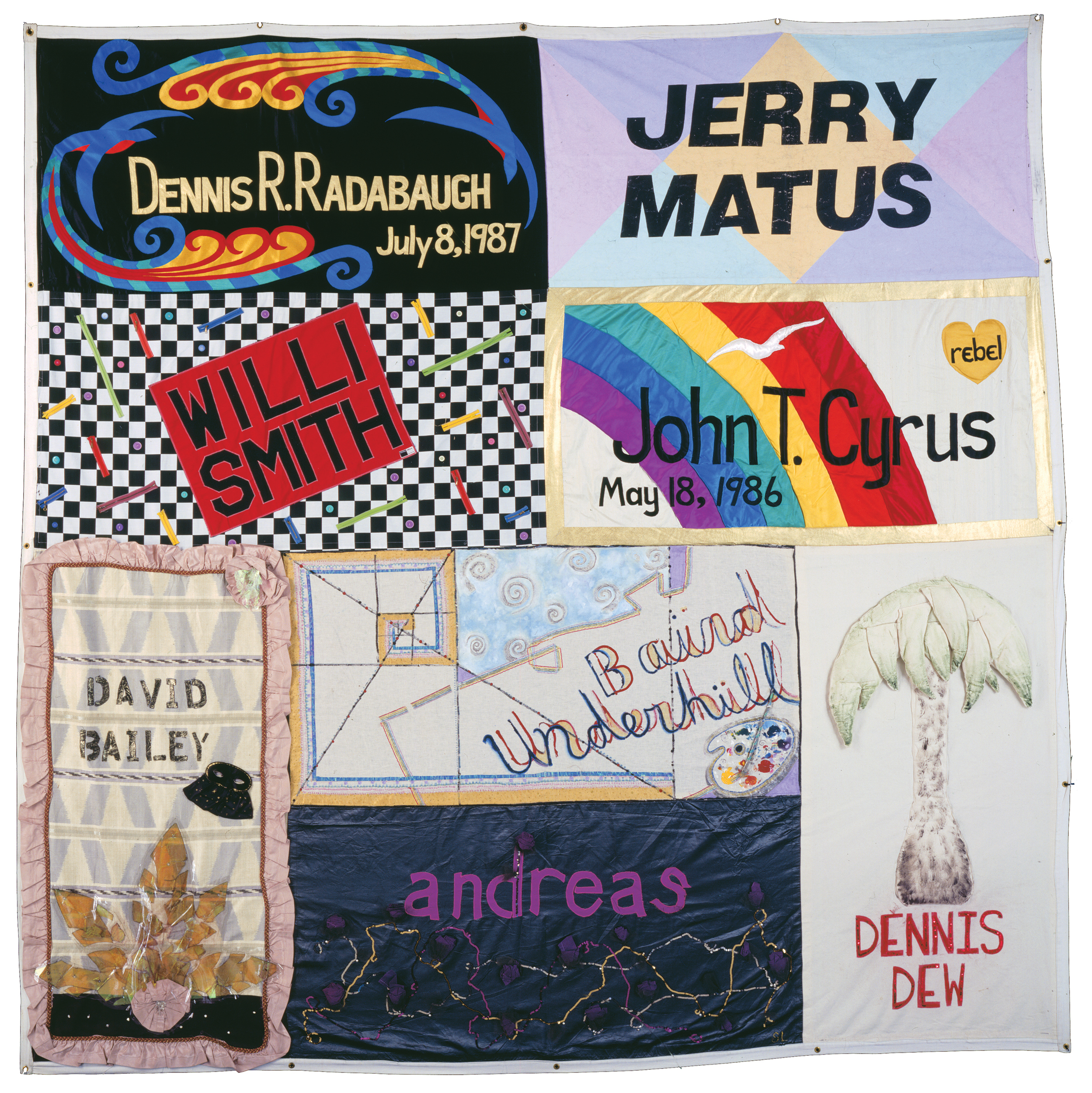
NAMES Project Quilt, 1988
Back issues of magazines in library basements; random slides, contact sheets, photographs in institutional and personal collections; vintage paper patterns you can find online; and shockingly few surviving clothes across the country—that’s what remains of Willi Smith. People consistently tell of wearing their WilliWear for years until it wore out. In 2018, the Pérez Art Museum Miami mounted a documentary exhibition about Surrounded Islands on the installation’s thirty-fifth anniversary.
The show attracted and excited local people who had never experienced contemporary, let alone conceptual, art. Many who had seen the work in situ showed up at the museum wearing their faded, cherished Surrounded Islands WilliWear shirts. Now Willi Smith’s panel on the AIDS Memorial Quilt occupies block number thirteen, along with memorials for David Bailey, John T. Cyrus, Dennis Dew, Jerry Matus, Dennis R. Radabaugh, Baird Underhill, and Andreas. Comprising some 49,000 panels, the Quilt, whole and in parts, has been exhibited continually around the world since 1987.
The show attracted and excited local people who had never experienced contemporary, let alone conceptual, art. Many who had seen the work in situ showed up at the museum wearing their faded, cherished Surrounded Islands WilliWear shirts. Now Willi Smith’s panel on the AIDS Memorial Quilt occupies block number thirteen, along with memorials for David Bailey, John T. Cyrus, Dennis Dew, Jerry Matus, Dennis R. Radabaugh, Baird Underhill, and Andreas. Comprising some 49,000 panels, the Quilt, whole and in parts, has been exhibited continually around the world since 1987.
Today, Rosemary Peck’s home in Southampton is spacious and full of light, with white walls and black accents. White orchids rest on a black Joseph D’Urso table from Knoll, a twin of one she bought for Smith’s Lispenard apartment. Tucked into drawers, she also has snapshots, two drawings, an inscribed book, a slightly grayed WilliWear T-shirt with Jenny Holzer truisms, and a pair of his signature round glasses. On her wall is a photograph by Martine Barrat, an artist who’s spent decades chronicling the public and private lives of Harlem and the South Bronx. Smith was a close friend and the first collector of her work, amassing an entire wall of her photographs. It’s easy to see how closely their interests overlapped, as he once advised, “Most of these designers who have to run to Paris for color and fabric combinations should go to church on Sunday in Harlem. It’s all right there.”14 The portrait shows Willi Smith in a park, leaning forward with his head resting on his left hand and the elbow on a knee, foregrounding a round watch. He wears a rumpled linen blazer with sleeves pushed up to the elbow, a WilliWear Barbara Kruger shirt peeking out. Just like the Kruger image, his face is cropped below the eyes, emphasizing the fine curves of his nose, lips, and chin, modeled in light and resembling a fragment of Egyptian sculpture. Willow branches dangle behind him. His hat sits on a bench. The lapels of his jacket crop the shirt’s slogan from “I can’t look at you” simply to “look.”
![]() Willi Smith, Photographed by Martine Barrat, 1984
Willi Smith, Photographed by Martine Barrat, 1984
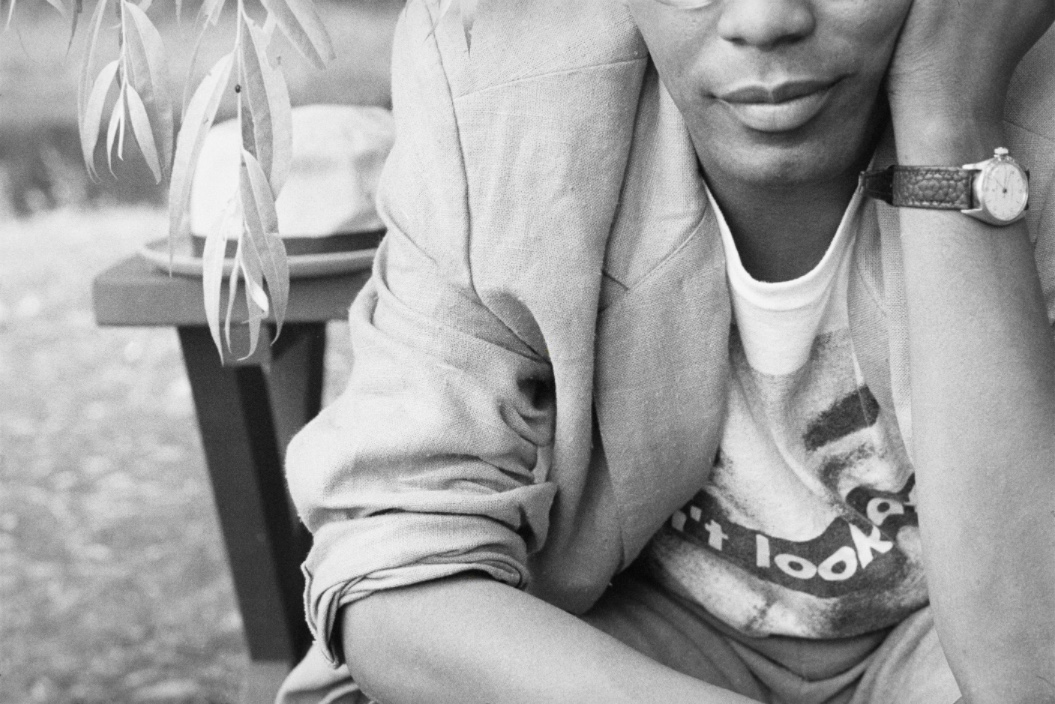 Willi Smith, Photographed by Martine Barrat, 1984
Willi Smith, Photographed by Martine Barrat, 1984
Jarrett Earnest is an artist and writer living in New York City. His interviews and essays have appeared in publications on contemporary art around the world.
- Christo, interviewed by the author, May 7, 2019.
- Barbara Kruger, interviewed by the author, May 21, 2019.
- Quoted in Gay Pauley, “Designer Willi Smith Puts Modern Art on the T-Shirt,” United Press International (February 14, 1984).
- Quoted in John Gruen, Keith Haring: The Authorized Biography (New York: Fireside, 1991), 148.
- Quoted in Joan Lebow, “WilliWear Filming in Africa, Ties in with Christo in Paris,” Women’s Wear Daily (September 13, 1985): 20.
- Christo, ibid.
- Quoted in “Butterick Introducing Willi Smith, ‘Digits’ Collection,” Fabric News (September 1973).
- Ibid.
- Bethann Hardison interview with Alexandra Cunningham Cameron, April 29, 2019.
- Laurie Mallet, interviewed by the author, May 14, 2019.
- Marilyn Bethany, “Special Effects,” New York (April 14, 1986): 46–52.
- Rosemary Peck, interviewed by the author, May 31, 2019.
- Quoted in Cindy Ruskin, The Quilt: Stories from the Names Project (New York: Simon & Schuster, 1988), 100.
- Quoted in “The Bright World of Willi Smith 1948–1987,” Women’s Wear Daily (April 29, 1987).
Knowledge through the Hand
Camille Ann Brewer
 Veronica Webb in Willi Smith for WilliWear, 1984
Veronica Webb in Willi Smith for WilliWear, 1984
The “hand” of a textile communicates the cloth’s physical feel—its crispness, bounce, dampness, weight, and/or silkiness. In response to a reporter’s question “Do you find fabrics a big problem?” Willi Smith responded, “I do. . . . These fiber people have people coming up showing me absolute cardboard, telling me it’s brushed flannel.”1
Arriving on the fashion scene with a discerning hand, Smith identified early on in his career a preference for fine textiles. His former professor at Parsons School of Design Ann Keagy noted in a 1982 Women’s Wear Daily interview that Smith’s student work was elegant and well designed, and that he selected expensive fabrics to complete his projects.2 Within his means, he chose fine textiles to act as the canvas for his designs. Through the knowledge in his hand, Smith understood the importance of a soothing, comfortable, tactile experience providing the material support for the design and creation of his fashion line.
A multigenerational knowledge of a sound textile hand came to the shores of North America, and subsequently the antebellum South, via African farmers, spinners, dyers, and weavers. Enslaved craftspeople with textile construction knowledge commanded higher prices on the slave auction block. Their knowledge was needed because not all of the fiber material generated in the Southern United States was shipped to industrial textile factories in the Northeast and Europe. From the farm field to the ginning and weaving houses, Southern-made cloth was produced by hand with raw fiber, which was seeded and pressed, carded, spun and wound, woven, and sometimes dyed. The cloth makers’ repeated actions of handling cotton, wool, or silk fiber developed an innate knowledge of finely crafted textiles. Through the oral histories of formerly enslaved Americans collected by the Works Progress Administration (later named the Work Projects Administration) in the mid thirties, we learn that a majority of antebellum households had a working hand loom in the domicile. Many of the interviewees reported that, as children, they would fall asleep at night to the sound of an active, beating loom located in an adjoining space.3
Arriving on the fashion scene with a discerning hand, Smith identified early on in his career a preference for fine textiles. His former professor at Parsons School of Design Ann Keagy noted in a 1982 Women’s Wear Daily interview that Smith’s student work was elegant and well designed, and that he selected expensive fabrics to complete his projects.2 Within his means, he chose fine textiles to act as the canvas for his designs. Through the knowledge in his hand, Smith understood the importance of a soothing, comfortable, tactile experience providing the material support for the design and creation of his fashion line.
A multigenerational knowledge of a sound textile hand came to the shores of North America, and subsequently the antebellum South, via African farmers, spinners, dyers, and weavers. Enslaved craftspeople with textile construction knowledge commanded higher prices on the slave auction block. Their knowledge was needed because not all of the fiber material generated in the Southern United States was shipped to industrial textile factories in the Northeast and Europe. From the farm field to the ginning and weaving houses, Southern-made cloth was produced by hand with raw fiber, which was seeded and pressed, carded, spun and wound, woven, and sometimes dyed. The cloth makers’ repeated actions of handling cotton, wool, or silk fiber developed an innate knowledge of finely crafted textiles. Through the oral histories of formerly enslaved Americans collected by the Works Progress Administration (later named the Work Projects Administration) in the mid thirties, we learn that a majority of antebellum households had a working hand loom in the domicile. Many of the interviewees reported that, as children, they would fall asleep at night to the sound of an active, beating loom located in an adjoining space.3
This affinity for and knowledge of fine, well-made textiles was retained in the hand and mind, passed down, and embraced by subsequent generations of African Americans. Garments constructed with fine textiles signaled to all viewers that the wearer of such fine clothing had a sense of self and pride, which projected style, elegance, and knowledge of how to “put it together.” Smith revealed in a 1973 interview that his mother and grandmother were very fashion conscious,4 and it was this exposure to beautiful cloth and thoughtful, purposeful fashion styling that informed his textile and fashion design sensibilities.
When Smith traveled to India in 1976 to explore the idea of designing and manufacturing a clothing line with Laurie Mallet, he arrived in a textile-rich culture with a centuries-long history of cotton textile production specifically designed for export for use by foreign consumers in global markets.5 India’s flexibility in working with foreign markets provided Smith with the opportunity to employ direct agency in the design of the textile itself.
When Smith traveled to India in 1976 to explore the idea of designing and manufacturing a clothing line with Laurie Mallet, he arrived in a textile-rich culture with a centuries-long history of cotton textile production specifically designed for export for use by foreign consumers in global markets.5 India’s flexibility in working with foreign markets provided Smith with the opportunity to employ direct agency in the design of the textile itself.
India’s dedicated use of natural fiber materials in its textile manufacturing industry aligned with Smith’s philosophy of fiber use, as he keenly understood the physical relationship between cloth and the body and preferred to use natural over synthetic fibers, which began flooding the textile industry in the seventies. As he stated in a 1980 interview, “I use natural fabrics, not for a snob reason; I just think they’re healthier for you.”6 As we currently assess the polluting effects of textile production and waste on our natural environment, it’s clear that Smith’s vision for fiber use and garment construction was decades ahead of its time, well before the early twenty-first-century slow fashion movement. Smith’s execution of his signature loose-fitting silhouettes in natural fibers echoes contemporary zero-waste pattern design, which produces minimal textile fallout waste.
Smith sought out and used fabrics that were in many cases built through hand processing, hand carding, hand spinning, hand weaving, and hand dyeing. By directly handling and manipulating the material through each construction step, a craftsperson’s repeated touch on the cotton fibers adds layers of patina to the fiber threads. This hand patina relaxes the individual cotton fibers and creates in the textile softness, suppleness, smoothness, and beautiful drape. The hand-constructed cloth afforded physical comfort and ease, billowing cloth movement, and an elegant surface aesthetic Smith sought out in his singular design vision. Each garment’s textile hand spoke for itself down to its most basic elements.
Camille Ann Brewer, MFA, MLIS, is a hand weaver and an
archivist based in Detroit, Michigan.
- “Designer Round Table,” Women’s Wear Daily 127, no. 40 (August 27, 1973).
- Mark Sullivan, “Ann Keagy: Honors for a Special Teacher,” Women’s Wear Daily (October 19, 1982).
- Federal Writers’ Project, Born in Slavery: Slave Narratives from the Federal Writers’ Project, 1936 to 1938 (Washington, D.C.: Library of Congress, 2001).
- “In the World of High Fashion, His Name Is at the Very Top,” Ebony Success 2 (1973).
- John Gillow and Nicholas Barnard, Traditional Indian Textiles (London: Thames and Hudson, 2005).
- “Willi Smith’s Message to Retailers: Clothing should be fun.” California Apparel News (August 29, 1980).
Design for Willi Smith
Polymode

Willi Smith for WilliWear, Spring 1986 Presentation, Photographed by Peter Gould, 1985
In 1999, when we were just entering college, the World Health Organization estimated that 14 million people had died of AIDS,1 448,060 of those in the United States.2 They were friends and fathers, sons and daughters. They were able teachers, leaders, creators, and guides. Our young minds were still grappling with what it meant to be sexual beings, let alone with what it meant to be “gay.” We had to process the profound anxiety surrounding unsafe sex—the terror that being gay equaled death by AIDS. At the time, we observed the public crash of that first wave: MTV, Benetton, Ryan White, the AIDS Quilt, Magic Johnson, Keith Haring.
We did not know then that as we grew older we would have a shortage of mentors. In the trove of human and cultural queer existence, where was the light in the dark, the hermit holding that lamp of truth, the disco ball illuminating our radiant and sweaty frames? Who would hold that space? We felt the absence: who do we talk to? How do we handle this fire hydrant of feelings? Why do these taboos feel so good? When will this shame go away? How do we transmute this anger into art? Ghosts don’t answer; they haunt, linger, and fade.
When Cooper Hewitt approached us to create a graphic identity and typographic system to communicate Willi Smith’s ingenious, multivalent, and complex body of work, we saw an opportunity to honor a design ancestor’s legacy. This has been one of our studio’s most challenging, inspiring, and heart-healing projects to date.
Smith excelled at collaborating with discipline-crossing visionaries that defied genre by manipulating text, image, and material form. In the beginning stages of our research, we were especially drawn to WilliWear’s collaborations with Dan Friedman and Bill Bonnell. Friedman was one of the few queer designers referenced by our largely heterosexual faculty. His dynamic typo-graphic experiments reflected both the rational lineage of the Bauhaus and an upstart postmodern approach.3 The wild graphics and interior design Friedman designed for WilliWear upended societal expectations of corporate branding and space by embracing a queer sensibility. Similarly, Bonnell’s work for WilliWear captured the brand’s explosive creativity within the still traditional fashion system.
We did not know then that as we grew older we would have a shortage of mentors. In the trove of human and cultural queer existence, where was the light in the dark, the hermit holding that lamp of truth, the disco ball illuminating our radiant and sweaty frames? Who would hold that space? We felt the absence: who do we talk to? How do we handle this fire hydrant of feelings? Why do these taboos feel so good? When will this shame go away? How do we transmute this anger into art? Ghosts don’t answer; they haunt, linger, and fade.
When Cooper Hewitt approached us to create a graphic identity and typographic system to communicate Willi Smith’s ingenious, multivalent, and complex body of work, we saw an opportunity to honor a design ancestor’s legacy. This has been one of our studio’s most challenging, inspiring, and heart-healing projects to date.
Smith excelled at collaborating with discipline-crossing visionaries that defied genre by manipulating text, image, and material form. In the beginning stages of our research, we were especially drawn to WilliWear’s collaborations with Dan Friedman and Bill Bonnell. Friedman was one of the few queer designers referenced by our largely heterosexual faculty. His dynamic typo-graphic experiments reflected both the rational lineage of the Bauhaus and an upstart postmodern approach.3 The wild graphics and interior design Friedman designed for WilliWear upended societal expectations of corporate branding and space by embracing a queer sensibility. Similarly, Bonnell’s work for WilliWear captured the brand’s explosive creativity within the still traditional fashion system.
The poster for Bonnell’s landmark exhibition Post-Modern Typography: Recent American Developments introduces “visual design that uses typography not only to inform but to express—type that explains an idea and in cases almost visually becomes the idea.”4 We channeled this ethos into a design concept for Willi Smith: Street Couture that reflects Smith’s playful fusion of practicality and individual expression for everyday living.
Smith worked with a spirit of utilitarian accessibility in the design of his clothes while transcending the trappings of socially constructed identity. He celebrated his Blackness and embraced his queerness. In the process of selecting typography for Willi Smith, we felt it was important to find a type designer and type family that could speak to both a queer black lineage and the no-nonsense practicality of WilliWear’s separates. We found this in the Halyard type-face, conceptualized by Joshua Darden in collaboration with Eben Sorkin and Lucas Sharp and released by Darden Studio in 2017. Halyard Display creates a bold graphic statement that we believe would have pleased Smith, who once remarked to Women’s Wear Daily, “I hate to see good clothes displayed in a non-special way, without saying anything.”5 The companion Halyard Text is drawn as a “workhorse” typeface; it functions well at smaller point sizes, supporting extended reading of the deep research and precious memories archived in the book.
Willi Smith: Street Couture uses a modular grid that pushes between structure and freedom in homage to Smith’s many facets and many worlds. The gray tones and tints reference SITE’s groundbreaking WilliWear interiors that merged street and showroom through a wash of monochrome. By screening swatches of gray back to a lighter percentage, we ghosted headlines, images, and quotes throughout the book. These veils of transparency serve as navigation tools while also evoking a memorial to Smith and the traces of his impact.
Smith worked with a spirit of utilitarian accessibility in the design of his clothes while transcending the trappings of socially constructed identity. He celebrated his Blackness and embraced his queerness. In the process of selecting typography for Willi Smith, we felt it was important to find a type designer and type family that could speak to both a queer black lineage and the no-nonsense practicality of WilliWear’s separates. We found this in the Halyard type-face, conceptualized by Joshua Darden in collaboration with Eben Sorkin and Lucas Sharp and released by Darden Studio in 2017. Halyard Display creates a bold graphic statement that we believe would have pleased Smith, who once remarked to Women’s Wear Daily, “I hate to see good clothes displayed in a non-special way, without saying anything.”5 The companion Halyard Text is drawn as a “workhorse” typeface; it functions well at smaller point sizes, supporting extended reading of the deep research and precious memories archived in the book.
Willi Smith: Street Couture uses a modular grid that pushes between structure and freedom in homage to Smith’s many facets and many worlds. The gray tones and tints reference SITE’s groundbreaking WilliWear interiors that merged street and showroom through a wash of monochrome. By screening swatches of gray back to a lighter percentage, we ghosted headlines, images, and quotes throughout the book. These veils of transparency serve as navigation tools while also evoking a memorial to Smith and the traces of his impact.
We wanted our design for Willi Smith to create a meaningful container for the Cooper Hewitt curatorial team’s painstaking research, the contributors’ scholarship, and the vivid memories of Smith’s friends and collaborators, allowing Smith’s life and work to shine on as a lighthouse. It is our hope that this approach gives structure to Smith’s message, and leads to a better understanding of how he saw the world and wanted us to play within it. Let this be our offering to his memory.
Polymode
Polymode is the bicoastal design studio of Silas Munro and Brian Johnson. Polymode has designed identities and publications for exhibitions of Jacob Lawrence at MoMA, Mark Bradford at the 2017 Venice Biennale, and Great Force for the ICA at VCU.
Polymode
Polymode is the bicoastal design studio of Silas Munro and Brian Johnson. Polymode has designed identities and publications for exhibitions of Jacob Lawrence at MoMA, Mark Bradford at the 2017 Venice Biennale, and Great Force for the ICA at VCU.
- World Health Organization, The World Health Report 1999: Making a Difference, 1999, Link.
- “HIV and AIDS—United States, 1981–2000,” Center for Disease Control, June 1, 2001, Link.
- Chris Pullman, “Dan Friedman,” AIGA, September 1, 2015, accessed September, 30, 2019, Link.
- Dan Friedman, Post Modern Typography: Recent American Developments, May 8–26 Ryder Gallery, ca. 1975, offset lithograph on white wove paper, 16 3/16 x 10 7/16” (41.1 x 26.5 cm), Cooper Hewitt, Smithsonian Design Museum, New York, Link.
- Barbara Ettore, “The Leisure Class,” Women’s Wear Daily (May 14, 1974):4–5.
Polydisciplinary
Magnetism
Judith Barry, Prem Krishnamurthy, and Forest Young
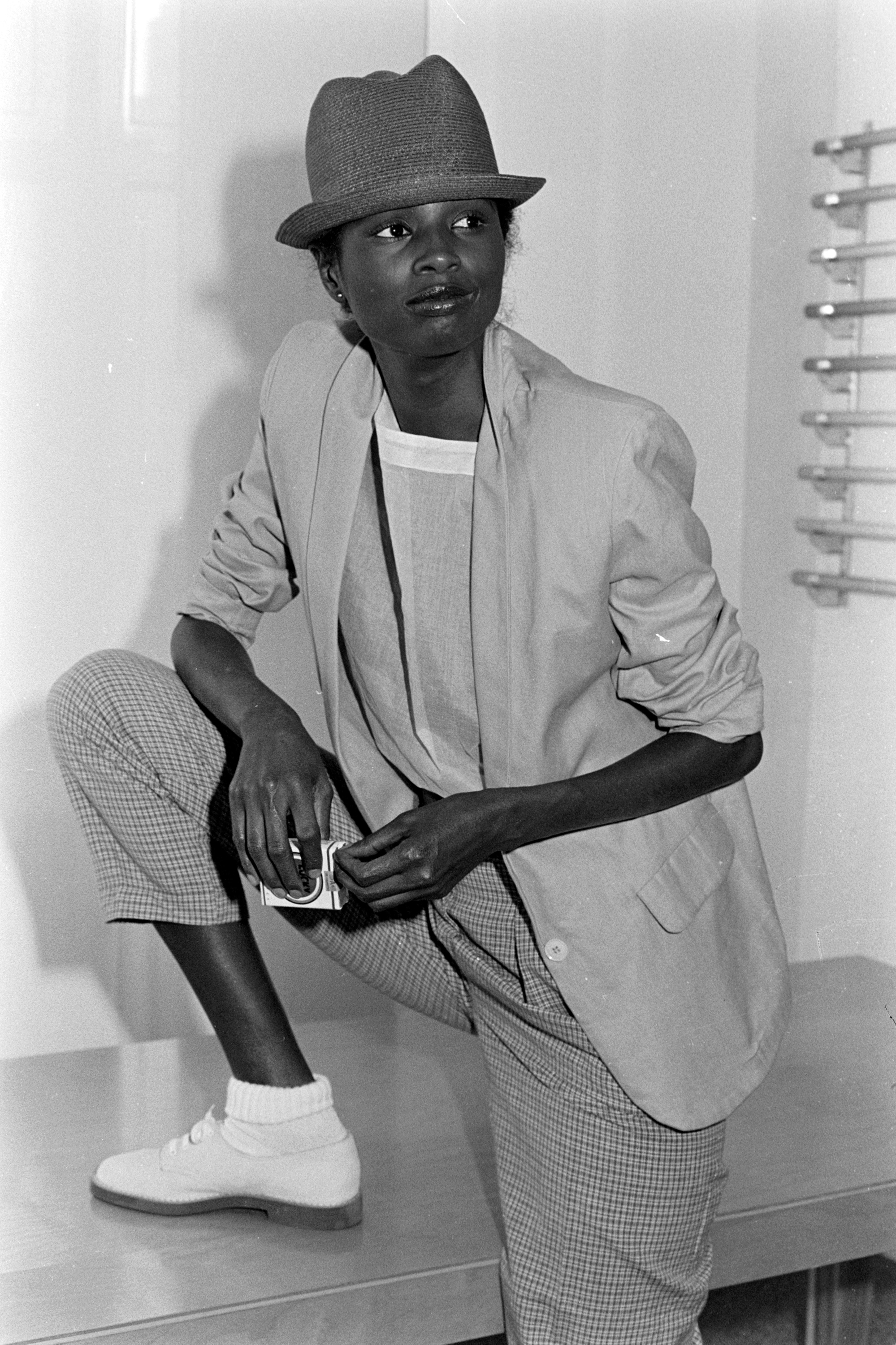 Willi Smith for WilliWear, Resort 1979 Collection, 1978
Willi Smith for WilliWear, Resort 1979 Collection, 1978Prem Krishnamurthy:
Judith Barry:
I am a relative newcomer to Willi Smith; I was first introduced to his work through James Wines and the designs that SITE created for WilliWear in the eighties. As a model, WilliWear brings up important questions around the politics of distribution. The brand stood for accessibility and affordability—essential parts of the modern project, as in canonical examples like Jan Tschichold’s design for Penguin Books—and demonstrated that mass production and broad appeal can go hand-in-hand with aesthetic quality. This approach to distribution is an ideological position in itself. At the same time, Willi Smith pioneered the idea of collaborating with artists and creative practitioners from other fields, in ways that still seem fresh today.
When Alexandra [Cunningham Cameron] asked me to help convene this conversation, it seemed like a perfect opportunity to touch on these topics and others in dialogue with practitioners who have a longer exposure to and understanding of WilliWear. In her critical artistic work since the eighties, Judith Barry has consistently explored the consumer gaze, the politics of display, and the productive frictions between design and art. Forest Young brings extensive experience working within branding on a global level, while also collaborating with artists such as Titus Kaphar on critical, socially oriented projects that incorporate design. Both of them have known Willi Smith’s work for a long time and bring their perspectives to bear on it.
I’m so glad that you both could join and am excited to hear your thoughts.
Judith Barry:
I didn’t personally know Willi Smith, although I did know the clothes, and he lived across the street from the editor of the Architect’s Newspaper, William Menking. Several friends wore and collected his clothes, including Lynne Tillman. My interest in his work was based on the performativity of his fashion in particular, and its functionality, and that it appealed to everyone. I codesigned two shows that considered fashion as a performative collaborative activity: [Impresario] Malcolm McLaren and the British New Wave at the New Museum in 1988 with Ken Saylor and a retrospective on Geoffrey Beene in 1994 at the Fashion Institute of Technology with J. Abbott Miller. Both used the exhibition space as a way to make visible how fashion constructs ways in which to inhabit physical space while simultaneously embodying the people wearing the clothes. Willi Smith’s clothing does that as well.
For me, thinking about Willi Smith is also an invitation to think about the place of fashion in our contemporary culture. And that raises all kinds of questions about the body in clothes, the function of the muse in fashion, and the exchange between the wearer of the clothing and the physicality of space itself as a boundary condition. Contemporary films like Phantom Thread address this somewhat, and even though I found that film problematic, I did see it as an attempt to situate fashion within the realm of psychoanalysis, alluding to moments where fashion as fetish takes on a life of its own, recalling the nineteenth-century stories of Guy de Maupassant; whereas Willi Smith’s clothing was active, putting the body into motion, and figuratively provoking dance.
Forest Young:
It’s interesting to situate Willi Smith within a specific continuum of fashion. Street Couture is his emblematic celebration of the “street” as a source of inspiration, echoing Prem’s concise focus into the democratization of fashion and the designer’s famous remark of designing for the royal passersby and not the queen herself.
As Virgil Abloh’s Figures of Speech show is finishing its run at the Museum of Contemporary Art Chicago, there is a chain of influence that we could collectively imagine—from Charles James to Arthur McGee to Smith, to a contemporary polymath like Abloh. We first observe visionary craft, then a context shift of influence from the runway to the street to a final blurring of disciplinary lines altogether. We can deduce by wearing WilliWear clothes and engaging in conversations like these that freedom of movement, literally and metaphorically, was a distinguishing center of gravity for his work. It is a mature take on democratization, both in terms of price point but also an ethos with integrity. The point that Judith raises about the body and his focus on comfort and a completely nonironic fascination with fit and mass appeal prefigures the trend of democratization we will see with Halston and later Isaac Mizrahi, not as a diffusion line, but as the brand itself. Willi Smith had an undeniable polydisciplinary magnetism. But his prescient reframe of accessibility is worth noting.
JB:
Yes, I totally agree. The comfort in his clothing is important because you could actually transform yourself in his clothing from the day to the night. I had friends who wore his clothing to go to work at jobs where you had to dress a certain way, but then would go out at night dancing because you could really twirl in his clothes. I remember friends in his long skirts especially, and they would be whirling around in them. It was a happy moment of transformation. He seems to have made a very conscious decision to make his clothes appealing for women, giving them a certain kind of power with his suits and wide shoulders while still being feminine. You could dress well without having to spend a huge amount of money. That was extremely important to him.PK:
Judith, your work in the eighties—I’m thinking of Casual Shopper in particular—thought deeply about the state of consumer culture during that particular moment. Your comment about conflating the daytime with the nighttime is quite interesting because it speaks to movements in between so-called work and so-called life. In your experience, how were those binaries set up in the eighties era?
JB:
For Casual Shopper, I was thinking about the question of desire and how desire and fantasy circulate within fashion and are further evoked in the activity of shopping. When I first came to New York as a student, in the late seventies, New York was really inexpensive. The downtown art world was tiny— Andy Warhol, the Velvet Underground, Jonas Mekas, performance, conceptual, and minimal art, and most galleries were in SoHo. And punk culture existed alongside this as well. There was a huge divide between “high art” and “popular culture.” Gradually over the eighties this divide started to meld together. During the seventies, most clubs were punk like CBGB, the Red Bar, the Mudd Club et al. Then in the eighties, with Studio 54 for dancing, the Pyramid Club for staging performance and reoccurring soap operas, and Nell’s which was a louche supper club, the demographic became much more mixed.
There were also other dramatic changes. In just ten years, rents ballooned from forty to four hundred dollars. Meanwhile, in 1977, Douglas Crimp’s Pictures exhibition was at Artists Space. This effectively launched postmodernity and signaled the embrace of the art market, and a very different relationship between art and popular culture. Artists rented storefronts in the East Village showing their colleagues’ work, and suddenly artists were dealers. Postmodernity was a unifying discourse despite its analytical approach and included feminisms of many different stripes, as well as psychoanalysis, semiotics, post-structualism, film, and literary and political theory. Also, the art world expanded to allow subject matter that previously was not considered part of the art discourse, such as fashion. I always wondered if fashion designers were reading Laura Mulvey’s article “Visual Pleasure and Narrative Cinema”? Many seemed to have as sophisticated a relation to questions about the place of women in culture as artists had.
Willi straddled that period: from the seventies—a gritty New York with punk clubs—into the glamourous eighties—Studio 54, AREA, Palladium, Danceteria, and many others. Artists were perceived as glamorous as well, and each day brought invitations to club parties—artists were invited gratis as lures, as window dressing, and we were all transforming alongside all of this as well. Willi, I think, was very aware of this, and his clothes reflected the fun of this as well as the reality of what was happening, and the possibilities.
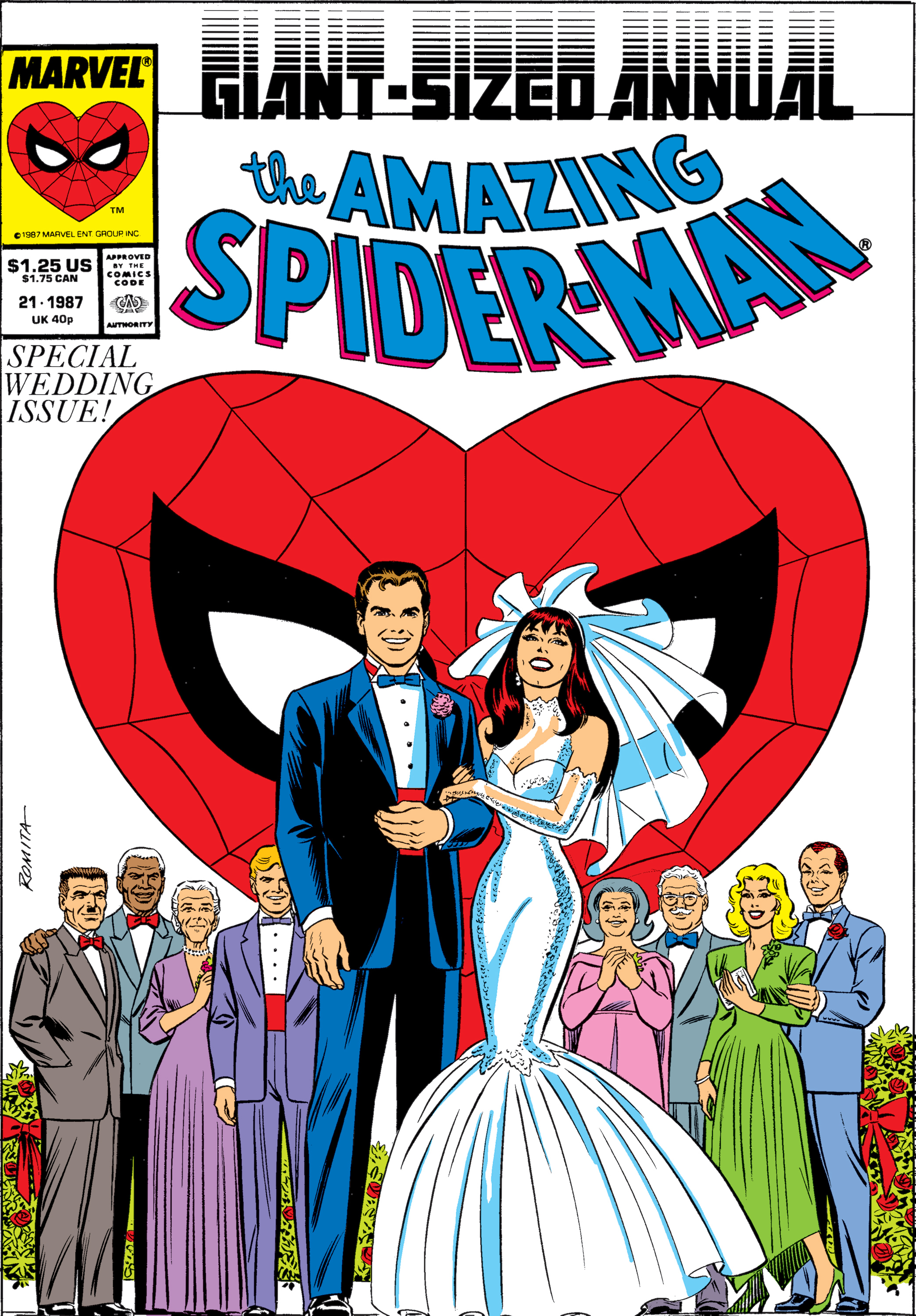 Willi Smith for Marvel, Mary Jane Wedding Dress,
Amazing Spider-Man Annual, 1987
Willi Smith for Marvel, Mary Jane Wedding Dress,
Amazing Spider-Man Annual, 1987
Willi’s adherence to accessibility as a creative constraint is remarkable. It can’t be limited by the simple boundaries of affordability and human factors; it is also about tapping into a cultural fabric, a pulse.
PK:
FY:
This image sets the stage for considering the interaction between the art world and the fashion world. Forest, I’m curious about something you mentioned. On the one hand, Willi Smith represents the example of a fashion entrepreneur who emphasizes the affordability of his clothes. He even makes patterns available for his designs. He wants people to be able to buy them. At the same time, he’s working with the art world’s prominent players on a high level. Do you see this as a contradiction?
FY:
This is really interesting—expansive influence via collaboration. We could conjure Ruth E. Carter’s early work for School Daze; Willi’s focus on the theatrical experience with Bill T. Jones, Arnie Zane, and Keith Haring; and his posthumously realized design for Mary Jane’s wedding dress for the Spider-Man wedding at Shea Stadium—forever preserved in The Amazing Spider-Man Annual #21. The latter, one of Marvel’s greatest promotions of all times, nods to the superhero zeitgeist decades away, and Carter’s monumental follow-up in Black Panther.
The point: there is nothing more accessible than comic books as an approachable, time-based experience; the comic book cells in #21 speak to how Willi is weaving in and out of culture at a very adept level. He is present as part of this design fiction that’s also happening in real life, which speaks to his ability to reconcile the transformative power of a cultural experience with affordability. Collapsing streetwear and high fashion is now commonplace and full-tilt Off-White and LVMH are proof of this. In contrast, Willi’s adherence to accessibility as a creative constraint is remarkable. It can’t be limited by the simple boundaries of affordability and human factors; it is also about tapping into a cultural fabric, a pulse.
JB:
Yes, comic books were read across class, race, and gender boundaries. But what he was doing was not something seen in fashion at the time. Willi collaborated with Barbara Kruger, Keith Haring, Nam June Paik, Juan Downey, and Miralda. He had a deep understanding of street culture, possibly through graffiti because graffiti art was a kind of diversity platform. It didn’t matter what color you were, and don’t forget it was all over New York City in the late seventies and mid-eighties. Many artists and designers were collaborating. Jenny Holzer and Lady Pink, Steven Sprouse and Keith Haring, and especially Fashion Moda in the South Bronx, directed by Stefan Eins, Joe Lewis, and William Stout, which had deep ties to the South Bronx neighborhood and which paved the way for the art world’s acceptance of graffiti art and the birth of DIY, especially in music such as hip hop.

 Bill Bonnell for WilliWear, Invitation, Spring 1984 Presentation, 1983
Bill Bonnell for WilliWear, Invitation, Spring 1984 Presentation, 1983FY:
I’m going to piggyback on something, Judith, that I think is totally apropos, which is this relationship between cost and value. The cost of a spray can versus the perceived value of being able to canvas a subway car or a facade at a major intersection. In the eighties, whether owed to the emergence of hip hop or a particular distance from disco, way of expressing oneself with nothing other than your body, a piece of cardboard, or a spray can became commonplace. A Radio Raheen–esque boombox you save up all your money to have for the purposes of street envy. It becomes possible to manifest a complete, hyperlocal atmosphere.
While disco required the apparatus of a club, DJ, and bell-bottomed costuming, the eighties ushered in an era of ad hoc expression. The use of the body was essential to what was happening on the street and bled into artistic movements. Contemporary artists were using the body as the primary tool of making, like David Hammons’ body prints or hand-rolled “Bliz-aard” balls.
JB:
PK:
I agree and was trying to think of other artists from that period who were using their bodies—Faith Ringgold, Adrian Piper, and Lorraine O’Grady, of course. Certainly Jean-Michel Basquiat. Mel Edwards, Rafael Ferrer, and David Hammons, as Forest mentioned—although he was hard to find because he kept under the radar, but was often at the Nuyorican Poets Cafe run by Bob Holman. Martin Puryear was sometimes there. There was also a lot of poetry in the East Village after punk ended. Musicians and poets were often included on the same slam bills.
PK:
There is the inevitable question around race and Willi’s work. He did express concerns that the fashion industry often qualified his work through his race. I couldn’t help but notice in the WilliWear communications and graphics designed by people like Tibor Kalman and Bill Bonnell that there’s often a play with dichotomies of white and black, mirrored forms, or positive and negative compositions. I’m curious if that stood out to you, Forest.
 M&Co. for WilliWear, Postcard, 1987
M&Co. for WilliWear, Postcard, 1987
FY:
JB:
Looking across the ecosystem of WilliWear artifacts through a graphic and typographic lens, there’s a considerable amount to discuss. Bill Bonnell brought equal parts graphic potency and textural sensitivity to the WilliWear expression.
Bonnell employs an unassuming, traditional cut of Futura for the WilliWear wordmark. The black-and-white squares that contain the letterforms echo a sixties op-art note, or earlier Japanese Nōtan, as the typography vibrates alongside a high-contrast motif. Over time we observe an element of play and whimsy embedded within those elongated twin Ls. The two Ls peek above the cap height at varying lengths, sometimes drawn to cap height, sometimes elongated further and even on rare occasions enclosing the entirety of the wordmark.
This dance of pragmatism and surprise was an essential ingredient of “radical modernism,” a phrase coined by Dan Friedman, who helped to facilitate the collaboration between both parties. The twin Ls echo contemporary brands like Billie, and a discernible return to sans serif expression across the realm of fashion. In retrospect, this identity is a lovely complement to Bonnell’s “In every child who is born . . .” poster from 1971 for the Container Corporation of America.
Bonnell is also unusually skilled in bringing texture to an otherwise 2D graphic scheme. From material choices, like the paper stock for the WilliWear business cards, hand-drawn elements alongside vibrant graphic fields, and compelling surface applications, the WilliWear graphic experience translates the materially rich environs created by SITE into takeaway ephemera.
JB:
That reminds me again of the question of design in fashion, and also that even in the eighties “design as design” occupied the position of “that which could not be named.” If you look at minimal art from a design perspective, you see how indebted that art movement is to industrial design. By the mid-nineties, and the ebbing of postmodernity, design could be openly discussed. When I designed Damaged Goods as my artist’s contribution to that exhibition at the New Museum in 1986, it was unusual to foreground exhibition design as an artist strategy. Early on, Willi posed the questions “What is design?” and “What is fashion?” in a very subtle, playful way. His installation at P.S. 1, Art as Damaged Goods, from 1982, is a good example of this.
Forest’s discussion about branding reminded me of T. J. Clark’s The Painting of Modern Life. Clark discusses shopgirls in the mid-nineteenth century as mutating into different people over the course of a day. First, arriving in Paris from rural areas and changing into shopgirl uniforms, then changing after work into bourgeois clothing where these girls are suddenly indistinguishable from their department store clientele, and later, perhaps donning an evening dress, perhaps shared among them, to go out with a male friend. Artists in the eighties often evoked similar strategies in their use of fashion and design codes to signify particular meanings. If you think about Cindy Sherman’s Untitled Film Stills in relationship to Édouard Manet’s Le Déjeuner sur l’herbe or Olympia, you can see that all rely on a reading of very specific codes in order to produce their meanings. On a primary level this is their overt content, and on a secondary level these are the meaning associations conveyed more subtly through mise-en-scène, color, accessories, hair and makeup, and so on. I’m trying to argue that fashion design, at the level of the garment, and when it is successful, can conjure a sense of an inhabitable world that the wearer embodies. And certain fashion designers, such as Willi, produce this with an economy of means.
FY:
That’s a really good point. He legitimately pioneered what he called “street couture,” which I think is very interesting, Prem, to your point earlier about his prefiguring what we now see at LVMH and elsewhere. JB: In short, he possessed a deft understanding of street culture as the nexus point for innovation and collaboration. In practice, he managed to blend the graphic opulence of haute couture with the immediacy of the everyday. This, married to a high-margin supply chain with a bespoke component at the top. He reinserted the street within a historical legacy that merges all of the plastic arts, establishing fashion as one of the many vehicles affecting culture.
 Willi Smith for WilliWear, Spring/Summer 1987
Presentation, 1986
Willi Smith for WilliWear, Spring/Summer 1987
Presentation, 1986 Willi Smith for WilliWear, Spring/Summer 1987
Presentation, 1986
Willi Smith for WilliWear, Spring/Summer 1987
Presentation, 1986
JB:
PK:
FY:
PK:
That’s true. His silhouettes give a nod to French fashion post-World War II, such as Chanel and Dior, who emerged from austerity with drapery plus an abundance of fabric. But Willi found a way through the color, pattern, and affordability of his line to introduce choice and allow a variety of women to construct their own identities wearing his clothes differently. Many other designers of the eighties couldn’t quite pull off the eclectic exuberance of his clothing. He designed clothes that allowed for many possibilities.
Forest, you mentioned owning some Willi Smith clothes. How did you first encounter his work?
FY:
Shopping with the family. There was a ritual phenomenon that existed—the moment of discovering WilliWear had to be followed by a loud “Willi!” I’m imagining I was eight or nine years old. This was the eighties, and I was just totally smitten by the alliteration of the brand name. It’s an incredibly seductive thing to say over and over again and possibly in an annoying way. There was a subtly celebratory quality to this, both knowing the creator was a designer of color and that it was within a price point to be acquired immediately. The clothes were there to move in and have fun in an innocent, straightforward way. He was somehow able to exact fun in the form of an object. As an intentional commodity. I will wear my WilliWear coat to the opening of the exhibition if it’s still cold outside.
PK:
It makes me think about joy, too. One of the things that strikes me is that when we think about so-called collaborations between fashion and art today, the goal often seems to be to encourage aspirational thinking, to raise the value and potentially the price point of the clothing itself. On the other hand, when I think about Willi Smith’s collaborations with SITE or other artists, the relationship seems more exploratory, mutual, and productive (for both sides). He also seemed to pursue his ongoing collaborations with cutting-edge artists, architects, and designers with the goal of making the work even more broadly accessible, without necessarily raising its price point. Is it naive of me to think of this as a democratizing, almost collective, impulse?
JB:
PK:
JB:
I don’t think so. When he emerged in the seventies and through the eighties, he made a conscious decision to make clothes that were affordable for women. This really comes through when you see the clothes and know the price point. And in those days designers hadn’t collaborated with artists in this way. He created his own particular kind of storytelling in his clothes. I guess that’s what I’m trying to say. This was a very different story than the one being imparted in Yohji Yamamoto’s clothes. Or Steven Sprouse’s or Rei Kawakubo’s.
PK:
You mentioned before, Judith, that you hadn’t thought of his work in a long time. Forest, has his work come up more recently for you? Do you have any ideas around why it is that his work largely disappeared from view, and why it now seems relevant in our particular moment to rediscover it?
JB:
It might be because his clothes weren’t seen as valuable because you didn’t pay a lot of money for them, so you might not have saved them. Whereas you might collect an Armani suit for preservation and possibly sell it later as vintage. I think Willi anticipated our present moment when fashion would become unaffordable for the middle class. The moment we live in now needs WilliWear more than ever. He was designing clothes that appealed to a broad demographic as both fashionable and hip, and fun and affordable. Not many designers are able to do that.
FY:
Judith Barry is an artist and writer whose work crosses a number of disciplines—film/video, performance, installation, sculpture, architecture, photography, and new media—and she has exhibited internationally at such venues as the Berlin Biennale, Venice Biennale(s) of Art/Architecture, Sharjah Biennial, and São Paolo Biennial.
Prem Krishnamurthy is a designer, exhibition maker, teacher, and writer based in Berlin and New York. He is a partner of the design studio Wkshps (formerly Project Projects) and director of the exhibition space and curatorial practice P!.
Forest Young is a design leader, educator, and speaker. He is a global principal at Wolff Olins, which was recently named the Most Innovative Company for Design by Fast Company, and has led technological initiatives for the world’s influential companies and cultural institutions.
Today, collaborative creation is much faster and more transparent. If somebody is doing a collab, you’re going to hear about it on Instagram, and it’s probably going to have a hashtag and be on a work-back calendar that editors are looking at. And so collaboration has become, I wouldn’t say corrupted, but certainly monetized in the absolute sense. And I like Judith’s notion that Willi Smith is perhaps the designer that we most need in today’s climate. Someone who believes that any person desiring affordable and stylish comfort should have access to it; there is a beauty to this sentiment that for me forms a halo around the collections. Affordability today is not nearly as exquisite, or sincere. His clothing has an incredible humility both in terms of the simplicity of the construction and purity of the material, but also a genuinely selfless sense that they weren’t about him. They embody inclusivity without the need for a moniker.
Judith Barry is an artist and writer whose work crosses a number of disciplines—film/video, performance, installation, sculpture, architecture, photography, and new media—and she has exhibited internationally at such venues as the Berlin Biennale, Venice Biennale(s) of Art/Architecture, Sharjah Biennial, and São Paolo Biennial.
Prem Krishnamurthy is a designer, exhibition maker, teacher, and writer based in Berlin and New York. He is a partner of the design studio Wkshps (formerly Project Projects) and director of the exhibition space and curatorial practice P!.
Forest Young is a design leader, educator, and speaker. He is a global principal at Wolff Olins, which was recently named the Most Innovative Company for Design by Fast Company, and has led technological initiatives for the world’s influential companies and cultural institutions.
Les Levine
Artist/Video Director
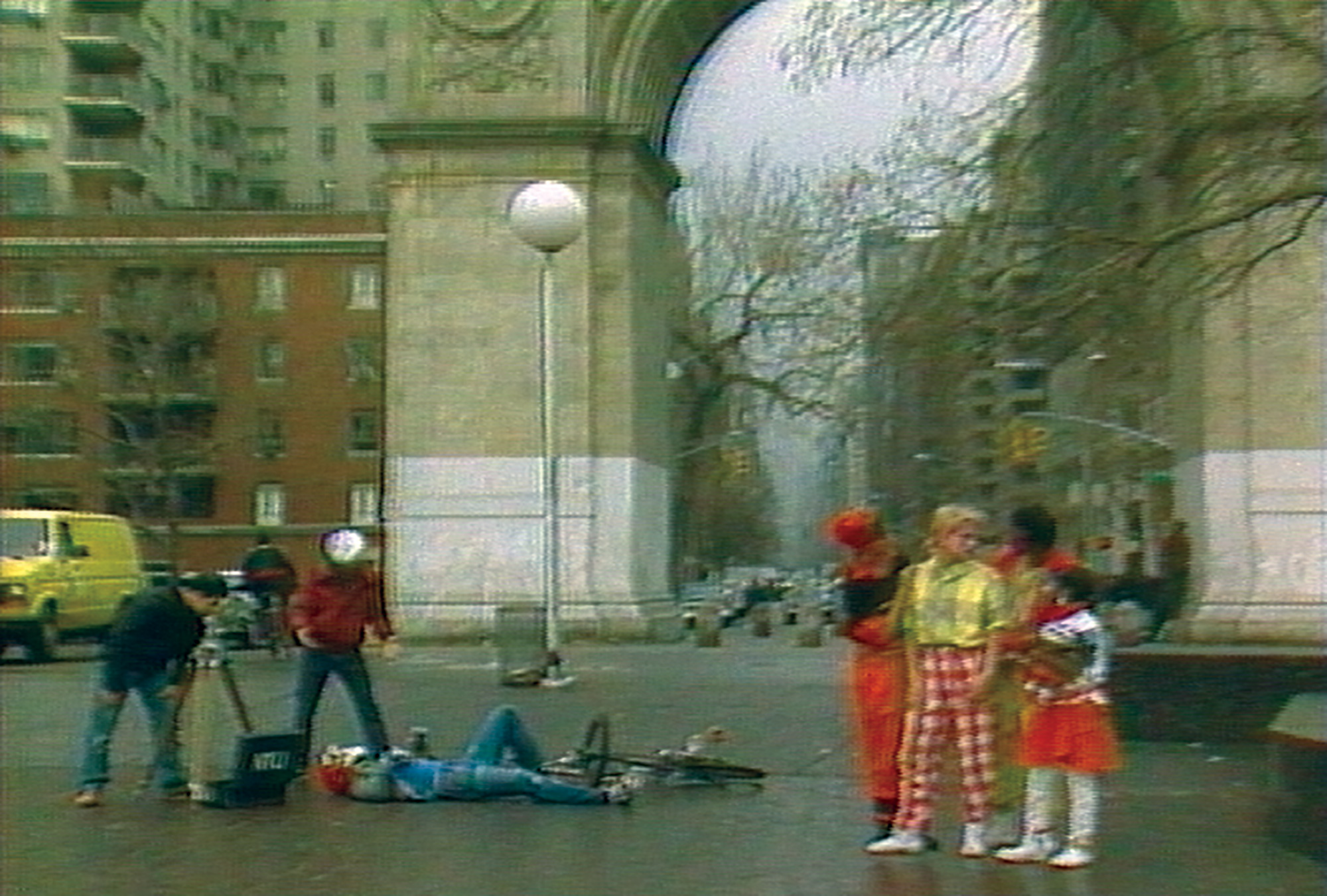 Les Levine, Still from Made in New York, 1984
Les Levine, Still from Made in New York, 1984
When Laurie Mallet asked me to make a videotape for the WilliWear launch of the artist T-shirts in 1984, I imme- diately thought I had to come up with something that represented both Willi and his zeitgeist. So, of course, Made in New York is not only the title, it is a metaphor for Willi and his tuned-in, street-smart design.
Everything about New York was included: art, dance, theater, people hoping to make it, glamour, fashion, street jazz. Willi knew how to incorporate all of these elements into what young people wanted to wear to both stand out and blend in. Mark Bozek and Sophie Craze supplied us with clothes and models.
Everything about New York was included: art, dance, theater, people hoping to make it, glamour, fashion, street jazz. Willi knew how to incorporate all of these elements into what young people wanted to wear to both stand out and blend in. Mark Bozek and Sophie Craze supplied us with clothes and models.
I needed a storyline to make it all work. A young woman comes to New York to establish herself as an artist. She makes friends in the art scene and the fashion world. She’s running from one scene to the next trying to take everything in. She goes to the artists’ studios. She asks them the meaning of their art. They ask her why she doesn’t make T-shirts. Other things happen. She goes to galleries. Her purse is snatched on 42nd Street. She sees a not-so-glamorous side of New York, and all the time she’s interacting with people on the streets.
This was our starting point, the skeleton. Of course, it changed dramatically during production. Mary Beth of Bumble & Bumble, a fantastic makeup artist, came to the studio and told me I had to hire her. When I saw her first made-up face, I knew we had a glamour machine. Then Arnie Zane and Bill T. Jones did an amazing perfor- mance, and the production was in high gear. With Willi’s clothes and Mary Beth’s faces and Arnie Zane and Bill T. Jones and artist T-shirts, we had a very professional- looking product.
This was our starting point, the skeleton. Of course, it changed dramatically during production. Mary Beth of Bumble & Bumble, a fantastic makeup artist, came to the studio and told me I had to hire her. When I saw her first made-up face, I knew we had a glamour machine. Then Arnie Zane and Bill T. Jones did an amazing perfor- mance, and the production was in high gear. With Willi’s clothes and Mary Beth’s faces and Arnie Zane and Bill T. Jones and artist T-shirts, we had a very professional- looking product.
At this point performers started showing up at the studio saying, “I want to be in the Willi video,” and often they would add, “Can I get some of Willi’s clothes?” We were incorporating more elements, more dancers, more singers. We tried to show every aspect of New York: art galleries, museums, cafeterias, street life, and the city and its architecture from all points of view. After about a week of production I realized that we had a creative snowball that was just gathering more and more layers of action each day.
We added a number of children on camera and asked them questions to which they gave answers such as, “You look very pretty today” and “I really like your hair,” amplifying the notion of cute humor. We added computer-generated transitions by Linda Gottfried. We traveled up and down Manhattan to show all its points of view and, of course, to show the T-shirts in a great variety of situations. Everywhere we went we would be asked about the exciting clothes the performers were wearing. The response in the streets was really happy.
Finally, we went to the Garment District, turning heads left and right as we made our way to the WilliWear showroom for the final scene and an interview with Willi. He was calm and thoughtful, very much connected to the streets, to the people and how they looked, to the culture, to the arts, to the glamour, to the vibrancy of color and nightlife. He had a joy in his vision. He knew the New York world upside down and inside out and how those New Yorkers wanted to look and have fun and be alive. The video is continually in motion, covers the whole city, is very upbeat, and shows the joy of the clothing. It is a metaphor for the spirit of Willi Smith and his New York.
We added a number of children on camera and asked them questions to which they gave answers such as, “You look very pretty today” and “I really like your hair,” amplifying the notion of cute humor. We added computer-generated transitions by Linda Gottfried. We traveled up and down Manhattan to show all its points of view and, of course, to show the T-shirts in a great variety of situations. Everywhere we went we would be asked about the exciting clothes the performers were wearing. The response in the streets was really happy.
Finally, we went to the Garment District, turning heads left and right as we made our way to the WilliWear showroom for the final scene and an interview with Willi. He was calm and thoughtful, very much connected to the streets, to the people and how they looked, to the culture, to the arts, to the glamour, to the vibrancy of color and nightlife. He had a joy in his vision. He knew the New York world upside down and inside out and how those New Yorkers wanted to look and have fun and be alive. The video is continually in motion, covers the whole city, is very upbeat, and shows the joy of the clothing. It is a metaphor for the spirit of Willi Smith and his New York.
Ruth E. Carter on School Daze
Interview by Darnell-Jamal Lisby
In 1987, film director Spike Lee convinced twenty-seven-year-old Ruth E. Carter to design costumes for his second film, School Daze, beginning their acclaimed collaboration of more than thirty years. School Daze transports audiences into the realms of historically Black colleges and universities (HBCUs), depicting variations of Black contemporary experience never before seen in movies. Lee encouraged Carter to integrate fashion by prominent African American designers, and Willi Smith was recruited to outfit the film’s extravagant homecoming court. Now an Academy Award−winning costume designer, Carter reflects on this formative experience, and how Smith’s collaborative spirit echoed across her life and career.
Darnell-Jamal Lisby:
Ruth E. Carter:
DJL:
REC:
Darnell-Jamal Lisby:
To begin, how did you come to be the costume designer for School Daze?
Ruth E. Carter:
I was living in Los Angeles and was a part of the theater community there. Spike Lee came to LA and we were hanging out—we were all very young. This was in the late eighties and Spike was telling me how to get more film experience, though I was not really interested in filmmaking. I wanted to be a theater designer. Shortly after that Spike called and asked if I wanted to do School Daze. I couldn’t say no.
DJL:
Do you know how Willi Smith got involved in the project?
REC:
Spike was always very conscious of including designers of color in his projects, and he knew of Willi Smith. Spike gave me his address and phone number and told me to make an appointment and talk to him about designing some pieces, which I did. He was a seasoned pro and I was beginning my first project, so I was kind of intimidated, but he was super friendly and really lovely to me. I remember it was winter and he looked at my coat—and I don’t know what he thought—but he gave me one of his long ones. It was full length, cotton, gray, kind of heathered, and had a black collar. At the time I worried that he thought my coat wasn’t warm enough, but the one he gave me wasn’t warm either! But really, he just gave me a gift. I loved it so much and wore it anyway, layering underneath it to make it work in any weather.
He was very busy but was happy to collaborate on School Daze. We decided that he should design for the homecoming queens and their courts, and he submitted sketches. The gowns were beautiful velvet and tulle—so great!
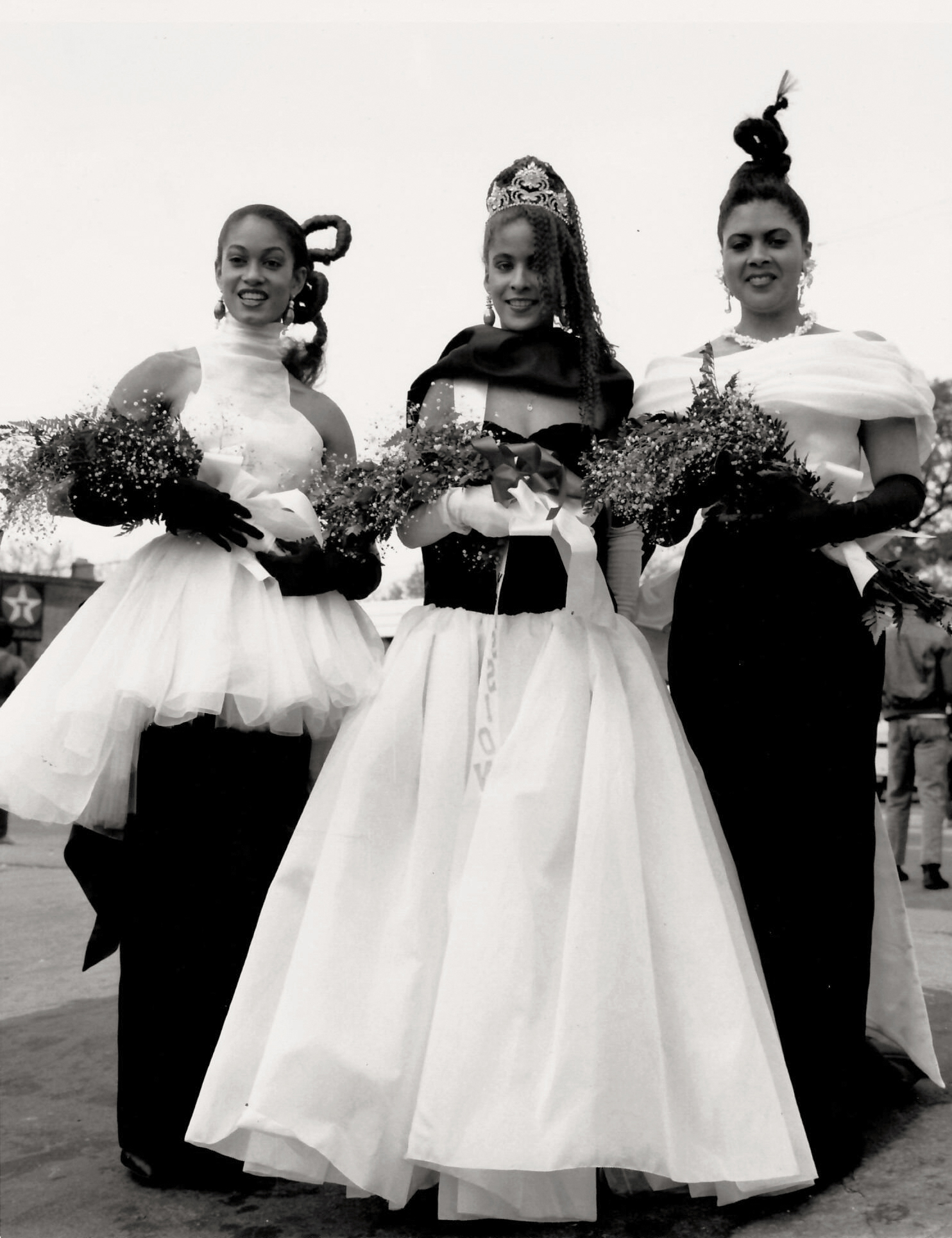
Willi Smith for School Daze, Homecoming Court Costumes, 1987
DJL:
REC:
DJL:
What was the conversation like getting Willi Smith to understand HBCU culture and your vision for the film’s aesthetic?
REC:
We shared our information with him, about what we were doing in our film to highlight the social aspects of Black college life, which I don’t believe he came from. Our conversations were about how all that looked. Toukie Smith, his sister, was very much in the fashion and New York society. She was dating Robert De Niro at the time. I believe Willi was designing for her, and she displayed his fashions on the red carpet. I represented Spike, who was a young filmmaker treading into new territory, showing Black excellence and Black beauty on screen. We had a dynamic that was very similar. Willi was groundbreaking in terms of his voice and his sister Toukie was a very curvaceous, beautiful woman who challenged mainstream body-type ideals at the time. Plus, New Yorkers support each other. They know how hard the trek can be. . .
DJL:
I’m curious to know more about your own process working on the film.
REC:
DJL:
REC:
Well, I came from an art background with my family. I didn’t study art. I pretty much worked in costume design on my own in college. It was not really a specific field of study, so I kind of created it myself. Because I am a self-starter, my process on School Daze was doing sketches and having those sketches produced, then having moodboards—they were just kind of inspirational photographs from magazines. I had gone to an HBCU so I knew what that looked like. There was a moment of gathering the things that I needed for sororities and designing thei sorority T-shirts and fraternity T-shirts and sweatshirts. I was knee-deep in college paraphernalia and was creating our own versions. It was a daunting task. I remember going to all the stores on 14th Street in Manhattan and just buying them out shoes and tank tops and skirts—a little bit like Fashion Nova online today, but it was 14th Street then.
DJL:
Were you given a fair amount of creative freedom?
REC:
Oh, it’s always collaborative. Spike is interested in seeing what your ideas are and he wants to help you. He’s written these characters, so he gives you insights into what he imagines. There’s a big part for me to project my artistic voice, but it still has to be approved. You have to share your ideas and show what you’re doing. Spike went to Morehouse. I went to Hampton. I was familiar with Spelman and I had friends at Spelman. So we were of the same mindset.
DJL:
REC:
DJL:
REC:
I would also like to know about the process of bringing in a commercial fashion designer like Willi Smith to participate in costuming a film. How does that work?
REC:
Well, it’s another world. I’ve been approached many times by producers to involve their favorite designer in the process. Fashion and costume designers go about it very differently. For starts, their timelines are very different. In fashion the things they’re currently showing usually haven’t even been produced. Overall, fashion is about a development of a personality in the world, usually based around a real person that is a celebrity or a muse. Costume design is creating the psychology of the fictional character and the person behind the clothes. When fashion designers give you something, they don’t expect you to, like, dirty it up. They don’t expect you to make it look oversized or rumpled. But with costuming, the clothes are part of telling a story. That story could be that the actors slept in their car. So it’s often really hard to incorporate commercial design because we’re working with different goals in mind.
Willi was generous. He knew he was donating these pieces to the production.
DJL:
A lot of twentieth-century costume design, especially in early Hollywood, looked to Paris couture as a source of inspiration. What has been your relationship with the fashion industry in your own work?
REC:
Back in those days, Willi Smith and Patrick Kelly were my introduction to African American designers in the fashion industry. Also, we were working with people on other films, like Sabato Russo, the Italian designer out of New York who designed a lot of things for me for Mo’ Better Blues [1990]. Just having that connection to New York and the fashion industry every time I did a Spike Lee film was something that I liked. He always wanted the style of his films to be elevated by high-end fashion and couture anytime we could. And it was my job to select the things that would create a character, using the realm of fashion in a very modern and contemporary way to tell a story through color, composition, and style.

Willi Smith for School Daze, Homecoming Court Costumes Illustration, 1987
Now I’ve begun to look online to see what designers are coming up with, not only just the top designers, but all designers. I believe it was in Mo’ Better Blues when we took a look at the innovation that someone like Alexander McQueen or Balenciaga created. I was very much inspired by it, but a lot of times, you just can’t take something from Gareth Pugh or Rick Owens and apply it directly because it would overwhelm the scene. I feel like the studios fantasize that some designer is going to come in and give them lots of money and clothing. This happened when Armani bought the license for Shaft [2000]. The licensing deal through the attorneys took forever, and we were basically given carte blanche in the store whenever Samuel Jackson needed a turtleneck, or another character needed a coat or something. Even though that was spectacularly fun to do, I still had to select things that were very Shaft-like and in keeping with the idea of the character and the story arc, as well as create the Shaft coat in case the Armani coat didn’t come through in time. We selected a laser-cut leather jacket that they were producing at the time, and it ended up that Jackson wore my Shaft coat, which was full length and less shiny.
Fashion does merge itself into the costume industry and we have to find its place. Most of the time, it is difficult for a lot of costume designers to accept the fashion industry because doing one character doesn’t necessarily speak to the whole complete story.
DJL:
REC:
Have you seen the relationship with fashion and the costume design worlds evolve?
REC:
The fashion and costume design worlds don’t intersect naturally. It’s a relationship that is often forced by other agendas. In rare cases, the two parties are mutually excited about collaboration. When Arianne Phillips was chosen to be costume designer for Tom Ford’s film Nocturnal Animals [2016], he told her, “I can never do what you do.” And this is Tom Ford recognizing that there is a great difference in creating characters and designing garments. So that is very rare. I don’t think fashion designers consider themselves as costume designers. We are inspired by each other; we want that relationship to work, but it’s usually a very short-term engagement.
A film like Black Panther [2018] couldn’t have been a better platform for me to show my design, my capabilities, my artistry, to the largest possible audience. It was the perfect storm.
DJL:
I know that you research extensively before you produce costumes for any film. How do you balance historical accuracy with creating a character?
REC:
If I’m trying to create a character based on research, I’m like Ralph Lauren or anyone who is inspire by beautiful 1930s cotton or the Great Gatsby look. Part of it is not trying to correct history. I think when things look more authentic, they are more appealing. And when things look like they are derivative, it depends on all of the elements that are being presented. Is the drape loosely inspired by the period? Is the color palette dead-on? Are the navies and the whites combined in the same way they were in the photograph that’s inspiring you? There is a strict balance that I’m always trying to achieve.
DJL:
REC:
Smith was often conflicted about being seen as a “Black designer.” He told Essence in 1986, “It took me a while to accept that responsibility because I wanted to be left alone—let me do my work and stop looking at me. But finally, I said to myself, ‘Willi, it is up to you, because of all the designers from the sixties, you are the one who was really there and you are the one who is still here.’ And to me, that goes beyond the fact that I have some talent, because a lot of people have talent. I feel good, I feel good.” How has race played a role in your career?
REC:
I understand what Willi was trying to do by not wanting to be considered a Black designer, but when the outside looks in, they see a Black designer and there’s nothing anyone can do to change that. At some point he had to embrace it and realize that it’s okay to be Black. And the other part is that we can’t change racism. We can only create models for ourselves or our community in hopes that they will have a larger impact.
Hollywood is no different. Hollywood was built on racism. I can see where maybe someone like Willi was not getting opportunities, or his shows weren’t invited to some of the venues that other designers were, but there comes a point where it does boil down to how good you are. If you keep striving to be better, then someone will take notice.
I think the numbers really play a factor in how successful my films are and will determine how many people notice. I always said that winning the Oscar was a bit of a popularity contest: the more popular the film, the more people see it, the more votes you’re probably going to get in the end. A film like Black Panther [2018] couldn’t have been a better platform for me to show my design, my capabilities, my artistry, to the largest possible audience. It was the perfect storm. Willi’s designs could be see by the masses and be embraced and stand beside some of the highest-ranking fashion designers, and I desire the same thing for myself. He just died way too soon, before he could realize the full extent of his greatness.
Traveling through your career as an African American, you will have the door shut in your face, or you won’t even get to the door or invited to the door—never mind opening it—you won’t even know about the door. You have to make amends with that. You have to not label yourself—but everything you touch has to be at the highest level, and be what you want for it. That’s how I pursued my career. I get it, we can’t change who we are. We can’t really change overnight how the world is. But it’s a journey.
Ruth E. Carter is an Academy Award-winning costume designer whose work has been featured in films such as School Daze, Do the Right Thing, Selma, and Marvel’s The Black Panther. Trailblazing the way for many young costume designers of color, her work has been acclaimed by organizations such as Essence and the Costume Designers Guild.
Darnell-Jamal Lisby is a fashion historian and project curatorial assistant at Cooper Hewitt, Smithsonian Design Museum. His contributions to various publications and curatorial efforts explore the art historical context surrounding Blackness and the history of fashion.
Future Crossings
Brendan Fernandes
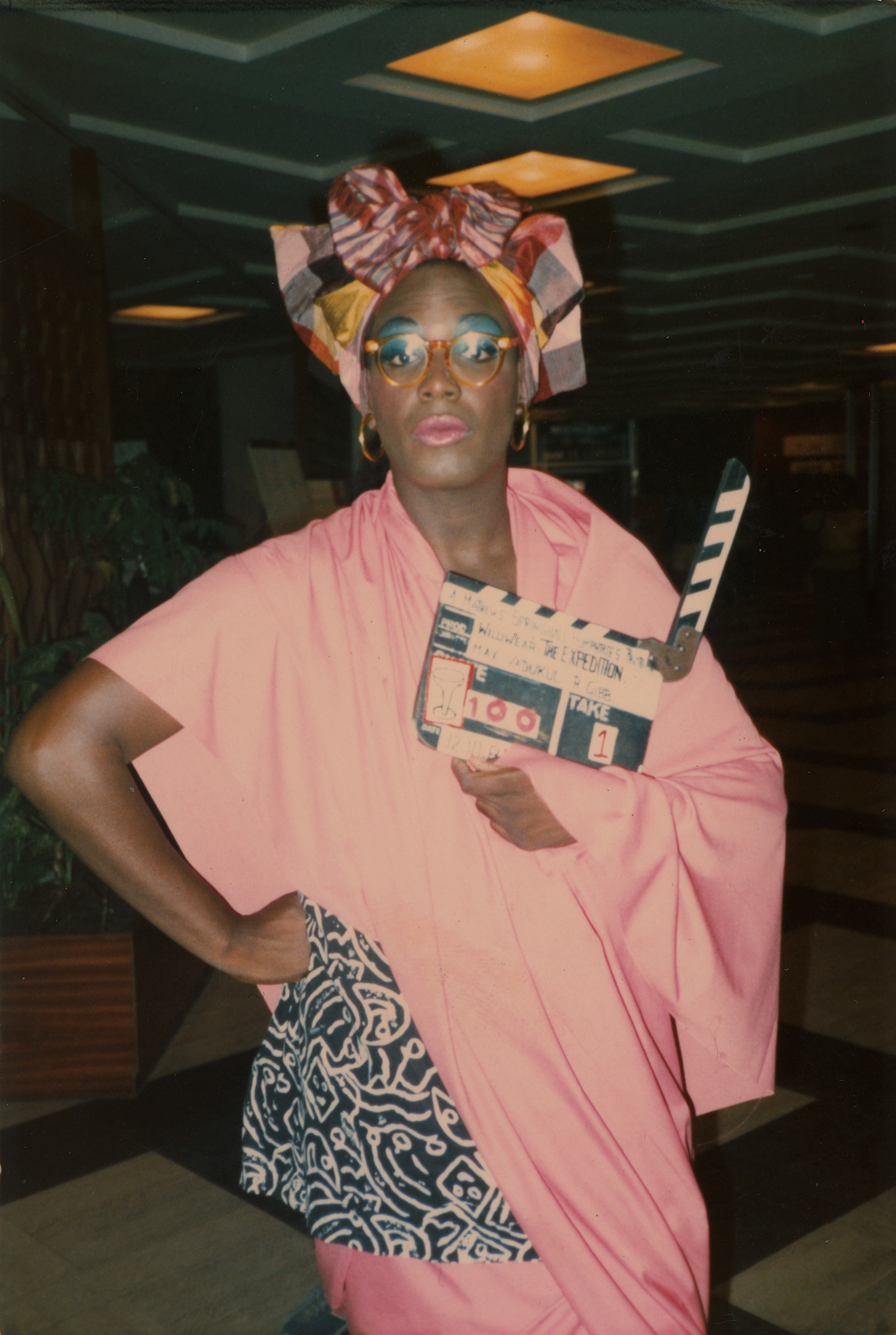 Willi Smith on Set, Expedition, Willi Smith for WilliWear, Spring 1986
Collection, Photographed by Mark Bozek, Dakar, Senegal, 1985
Willi Smith on Set, Expedition, Willi Smith for WilliWear, Spring 1986
Collection, Photographed by Mark Bozek, Dakar, Senegal, 1985
In 1984, when I was five years old, my family traveled from Nairobi, Kenya, to Calgary, Canada. Leaving the African continent for the first time to visit family in North America, my mother had my two sisters, father, and me dressed in matching tailored outfits: khaki suits à la safari with details in plaid—an ode to what we understood as Western style. We didn’t have a lot of money, but the question of how we were going to express our “African” selves in North America was important for us. At that early age, with few resources and clever tailoring, my mother instilled in my sisters and me the value of self-presentation. Today the question of how I present myself as a queer, Brown, border-crossing man is of serious personal and physical consequence.
One year after my family’s journey, Willi Smith produced Expedition (1985), an experimental short film that could be considered the inverse of my family’s experience. Shot by Kenyan-born photographer Max Vadukul with a score by Peter Gordon, the film follows Chicky, a caricature of a white man, as he travels in “Afrique,” the nonexistent place that the African continent occupies in the Western imagination. As he is subjected to an over-the-top border inspection upon arrival, a family of WilliWear models escape from his suitcase and begin to vogue, model, mischief, and make for a bathroom break in Smith’s brightly patterned fall collection. The film is a camp-fest reversal of stereotypes. The white man is made the outsider, and Smith pokes critical fun at the perception of African bodies as refugees or smuggled goods. Subverting the cliché of cross-border experience with humor may have been exactly what my mother had in mind with her own stylized border-crossing.
One year after my family’s journey, Willi Smith produced Expedition (1985), an experimental short film that could be considered the inverse of my family’s experience. Shot by Kenyan-born photographer Max Vadukul with a score by Peter Gordon, the film follows Chicky, a caricature of a white man, as he travels in “Afrique,” the nonexistent place that the African continent occupies in the Western imagination. As he is subjected to an over-the-top border inspection upon arrival, a family of WilliWear models escape from his suitcase and begin to vogue, model, mischief, and make for a bathroom break in Smith’s brightly patterned fall collection. The film is a camp-fest reversal of stereotypes. The white man is made the outsider, and Smith pokes critical fun at the perception of African bodies as refugees or smuggled goods. Subverting the cliché of cross-border experience with humor may have been exactly what my mother had in mind with her own stylized border-crossing.
What we can take from these images is that self-presentation changes our claim to space. Smith’s spectacular WilliWear runway shows created space for individual expression. Taking street fashions and church tailoring from Harlem to international runways, Smith’s ethos created new spaces for the people who wore his collections. Ever conscious of the kinds of spaces he designed for, Smith emphasized that WilliWear needed to be affordable, saying that his mother and grandmother taught him that “you didn’t have to be rich to look good . . . good clothes don’t have to be expensive.”1 He intended to change people’s perceptions of themselves by giving them the tools—the clothes—to both present themselves and see themselves presented in new spaces.
However, as we can see in Expedition, Smith’s work went further than expanding representation. His garments challenged space and questioned its occupancy. The silhouettes and bold color draw attention, creating a kind of hypervisibility. In the fictional world of Expedition, this hypervisibility functions as a kind of camouflage, whereby the WilliWearers go unnoticed, but their plain-clothes porter is questioned and hindered at every stage of his journey. Smith’s work suggests that while mere visibility can be humiliating, even dangerous, hypervisibility can be an effective strategy for both subversion and survival.
Another quote from Smith resonates deeply with my own experience of clothing: “In my house growing up, we had more clothes than food; the emphasis was on how you looked.’’2 Clothing is kin to survival. He suggests a powerful principle—in a world that emphasizes appearances, social mobility is available to those who can “look” a certain way. The craft of making clothes, then, is a kind of social engineering. My grandmother was a seamstress. She made many of the clothes we wore and through this she taught my mother that how you present yourself to the world can change the way the world receives you.
My mother passed this intelligence on to my sisters and me, and we have since passed this down to the next generation. Appearance can allow you to position yourself regardless of class and capital. Conversely, when you do this, the systems of class and capital become a lot more porous than they at first appear.
However, as we can see in Expedition, Smith’s work went further than expanding representation. His garments challenged space and questioned its occupancy. The silhouettes and bold color draw attention, creating a kind of hypervisibility. In the fictional world of Expedition, this hypervisibility functions as a kind of camouflage, whereby the WilliWearers go unnoticed, but their plain-clothes porter is questioned and hindered at every stage of his journey. Smith’s work suggests that while mere visibility can be humiliating, even dangerous, hypervisibility can be an effective strategy for both subversion and survival.
Another quote from Smith resonates deeply with my own experience of clothing: “In my house growing up, we had more clothes than food; the emphasis was on how you looked.’’2 Clothing is kin to survival. He suggests a powerful principle—in a world that emphasizes appearances, social mobility is available to those who can “look” a certain way. The craft of making clothes, then, is a kind of social engineering. My grandmother was a seamstress. She made many of the clothes we wore and through this she taught my mother that how you present yourself to the world can change the way the world receives you.
My mother passed this intelligence on to my sisters and me, and we have since passed this down to the next generation. Appearance can allow you to position yourself regardless of class and capital. Conversely, when you do this, the systems of class and capital become a lot more porous than they at first appear.
My definition of queerness goes beyond gender and sexuality. Queer is about how we perceive and position ourselves in relation to hegemonies. In this sense, Smith queered space. He played with the borders and loosened the boundaries.

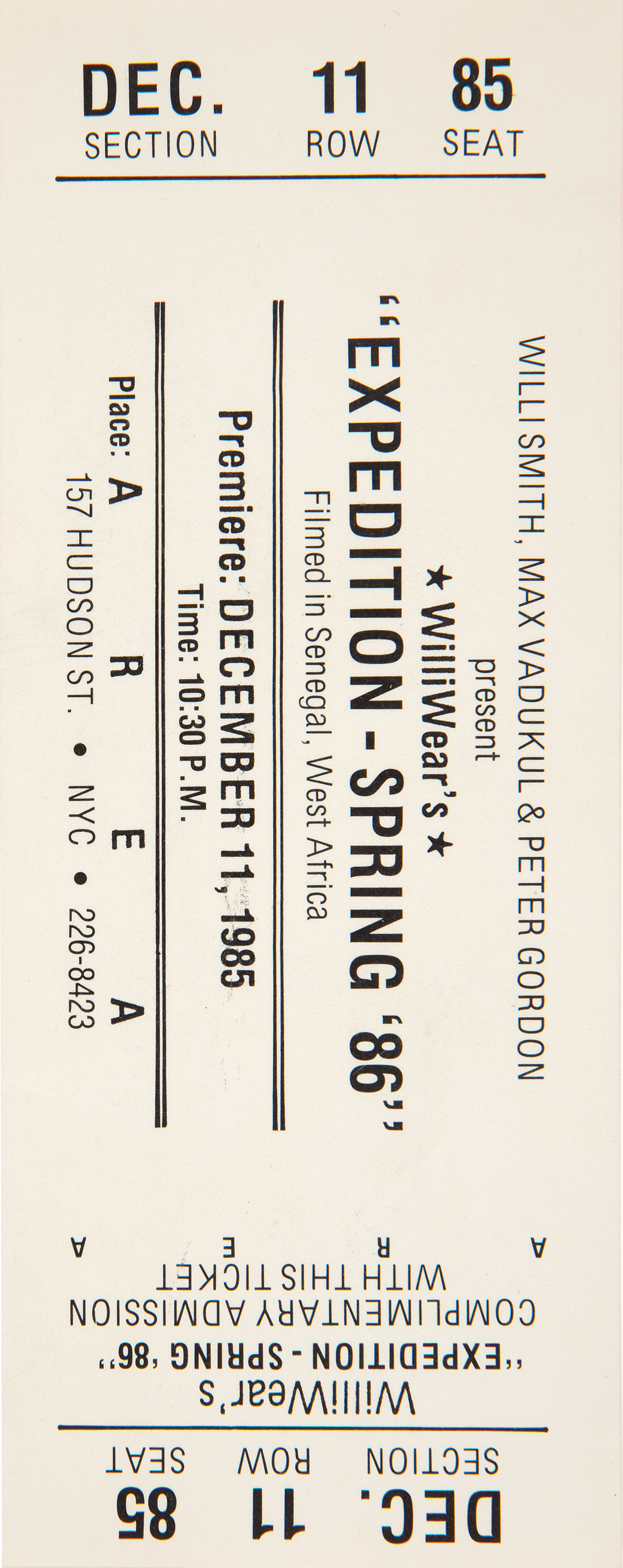
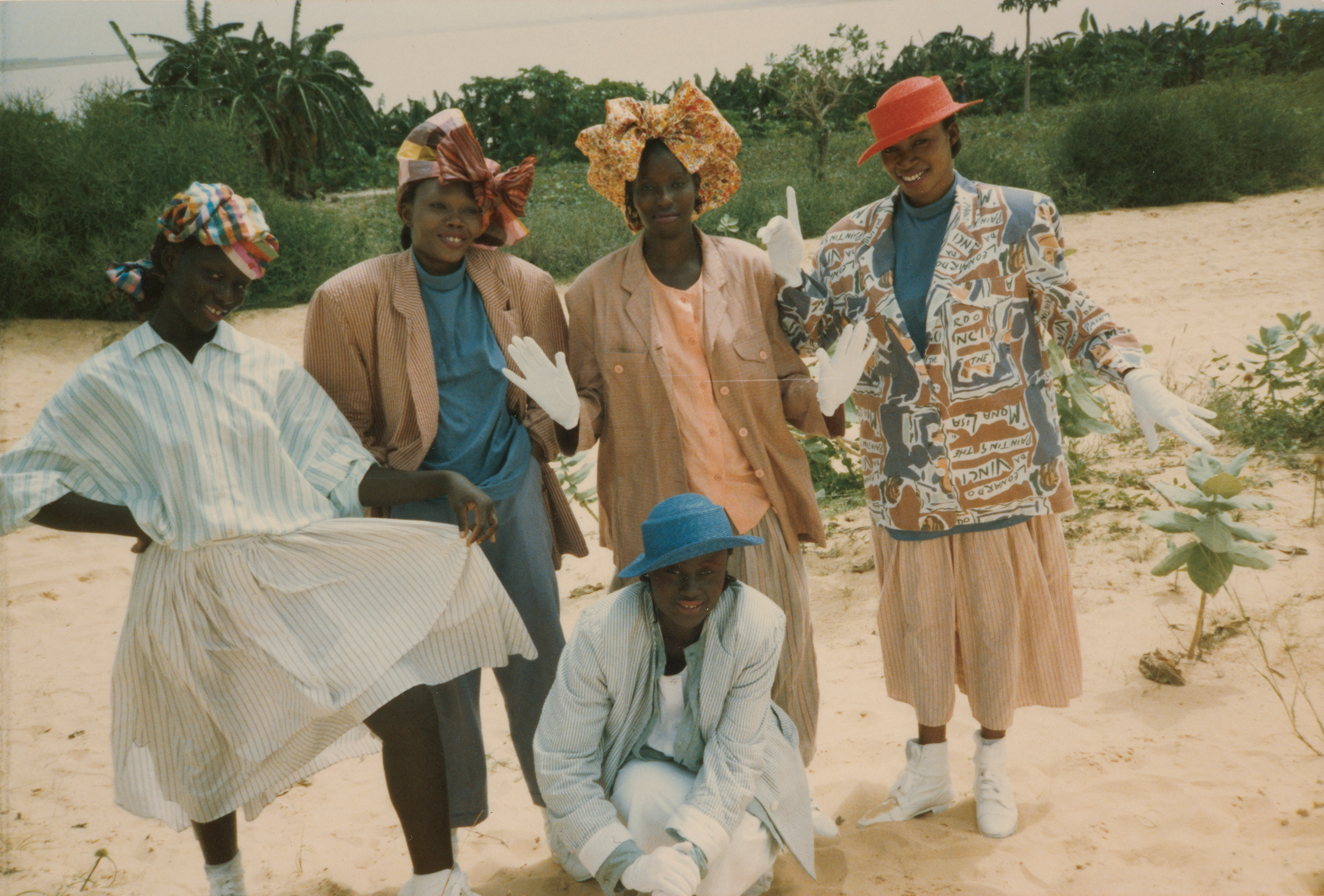

 Theatre National Daniel Sorano Dancers on Set, Expedition, Willi Smith for WilliWear, Spring 1986 Collection, Photographed by Mark Bozek, Dakar, Senegal, 1985
Theatre National Daniel Sorano Dancers on Set, Expedition, Willi Smith for WilliWear, Spring 1986 Collection, Photographed by Mark Bozek, Dakar, Senegal, 1985
My definition of queerness goes beyond gender and sexuality. Queer is about how we perceive and position ourselves in relation to hegemonies. In this sense, Smith queered space. He played with the borders and loosened the boundaries. He created opportunities for origin, class, and expectation to be transgressed. In doing so he opened up new space for people to come together.
Collaboration is what happens when we arrive in space with others. It’s the process through which many new things become possible and imaginable. For me, it’s an important reason why we cross borders in the first place. It’s a purpose for why we gather and a reason why coming together and finding solidarity can be so uplifting in difficult times.
Willi Smith collaborated frequently, relying on partnerships with artists, photographers, theater and dance companies, film teams, and designers in other fields to amplify his ideas. A notable collaboration for me was WilliWear’s commission from the artists Christo and Jeanne-Claude to design the uniforms for security and welcome staff at their renowned Pont-Neuf Wrapped (1985) installation. Smith’s uniforms created a sense of task and authority, and simultaneously disrupted expectations of what security and authority might look like. Where one might expect an official seal or authoritative text, Smith placed a screenprint of a Pont Neuf drawing. Where one might expect a utilitarian, militaristic silhouette, Smith’s uniforms were loose to the point of requiring each wearer to deal with the excess fabric by individually styling their look. In this way, the uniforms echoed the Pont Neuf installation itself. How we clothe structures of authority changes how we understand the power and future of those structures.
![Linda Mason and Willi Smith on Set, Expedition, Willi Smith for WilliWear, Spring 1986 Collection, Photographed by Mark Bozek, Dakar, Senegal, 1985]()
Linda Mason and Willi Smith on Set, Expedition, Willi Smith for WilliWear, Spring 1986 Collection, Photographed by Mark Bozek, Dakar, Senegal, 1985
Collaboration is what happens when we arrive in space with others. It’s the process through which many new things become possible and imaginable. For me, it’s an important reason why we cross borders in the first place. It’s a purpose for why we gather and a reason why coming together and finding solidarity can be so uplifting in difficult times.
Willi Smith collaborated frequently, relying on partnerships with artists, photographers, theater and dance companies, film teams, and designers in other fields to amplify his ideas. A notable collaboration for me was WilliWear’s commission from the artists Christo and Jeanne-Claude to design the uniforms for security and welcome staff at their renowned Pont-Neuf Wrapped (1985) installation. Smith’s uniforms created a sense of task and authority, and simultaneously disrupted expectations of what security and authority might look like. Where one might expect an official seal or authoritative text, Smith placed a screenprint of a Pont Neuf drawing. Where one might expect a utilitarian, militaristic silhouette, Smith’s uniforms were loose to the point of requiring each wearer to deal with the excess fabric by individually styling their look. In this way, the uniforms echoed the Pont Neuf installation itself. How we clothe structures of authority changes how we understand the power and future of those structures.

Linda Mason and Willi Smith on Set, Expedition, Willi Smith for WilliWear, Spring 1986 Collection, Photographed by Mark Bozek, Dakar, Senegal, 1985






A friend recently described to me the feeling of wearing a piece of WilliWear in their collection. They confessed that the clothes still feel empowering to wear, that they create a sense of character and confidence. Imbued with Smith’s legacy, the clothes have accumulated, rather than lost, power and relevance. In our difficult political time, the transformations of perception and embodiment that Smith’s works create remain a striking point by which we might reorient ourselves toward more open, queer, and collaborative futures.
Willi Smith died at thirty-nine, the same age I am now. How might the present look had there been more future for Smith? And how might we continue to disrupt and empower, to teach and poke fun? How might the style continue to facilitate crossings? These questions should face us not with regret, but with task. What futures can we continue to imagine? What futures can we enact in our work and in how we face the world? What futures can we embody?
Brendan Fernandes is an internationally recognized Canadian artist working at the intersection of dance and visual arts. His projects address issues of race, queer culture, migration, protest, and other forms of collective movement, and have been shown at the Guggenheim Museum, the Museum of Modern Art, the Getty Museum, and the National Gallery of Canada.
Willi Smith died at thirty-nine, the same age I am now. How might the present look had there been more future for Smith? And how might we continue to disrupt and empower, to teach and poke fun? How might the style continue to facilitate crossings? These questions should face us not with regret, but with task. What futures can we continue to imagine? What futures can we enact in our work and in how we face the world? What futures can we embody?
Brendan Fernandes is an internationally recognized Canadian artist working at the intersection of dance and visual arts. His projects address issues of race, queer culture, migration, protest, and other forms of collective movement, and have been shown at the Guggenheim Museum, the Museum of Modern Art, the Getty Museum, and the National Gallery of Canada.
- Eleanor Lambert Collection, Willi Smith Biography Coty “Winnie” Nominee 1978, 1978, 214.3.111, Fashion Institute of Technology|SUNY, FIT Library Special Collections and College Archives, New York, NY.
- “The Bright World of Willi Smith 1948–1987,” Women’s Wear Daily (April 20, 1987): 10.


Film
WilliWear used film as a creative tool for defining the
brand’s values and keeping the attention of an audience increasingly distracted
by the emergence of new electronic media such as 24-hour cable television news
and home shopping networks.
Smith wanted film “to be a whole new way to show
clothes . . . a sort of fashion photo come to life.” Les Levine’s Made in
New York (1984) and Max Vadukul’s Expedition (1985) stand out as
short films produced by WilliWear that position fashion as a form of
entertainment and reinforce the brand’s emphasis on multicultural exchange.
Expedition
Expedition filmed by Max Vadukul, Screened at Ziegfeld Theatre, New York, 1985, from Cooper Hewitt on Vimeo.
An audio described version of this video is available for individuals who are blind or have low-vision.Smith conceived Expedition as a new format for presenting the WilliWear spring 1986 collection. The film was shot by Max Vadukul in Dakar, Senegal, in 1985 and featured several of Smith’s regular collaborators including Mark Bozek, Linda Mason, and Peter Gordon. Smith cast the film with locals and the Theatre National Daniel Sorano dance troupe, styling actors in WilliWear looks inspired by the streets of Dakar. Expedition embodies WilliWear’s embrace of film as a mechanism for disseminating fashion concepts beyond the runway and Smith’s desire to draw inspiration from and reflect on his African heritage while encouraging his audience to explore African cultures.
Patterns for You
Darnell-Jamal Lisby and Luiza Repsold França
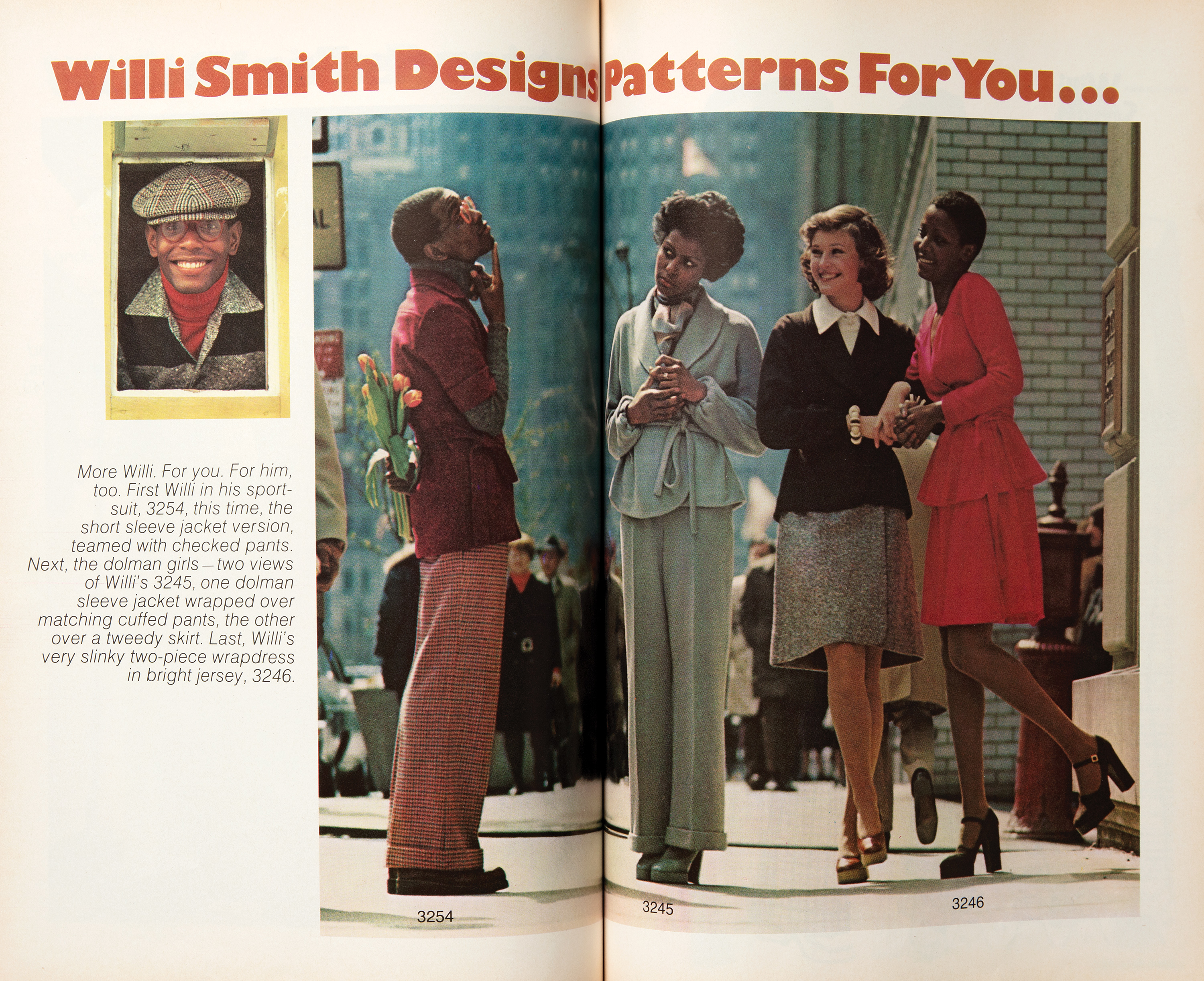
This Willi Smith for Butterick Patterns 3254, 3245,
and 3246, 1973, catalogue editorial presents several
of the first patterns that Smith designed, including a menswear pattern that Smith is modeling in the
photo. These designs echo Smith’s fall 1973 collection for Digits, which was inspired by Christian Dior’s
influential spring 1947 “Corolle” line. This haute
couture collection was coined the “New Look” byHarper’s Bazaar editor-in-chief Carmel Snow for
reintroducing feminine cinched-waist silhouettes
after seasons of somber wartime fashion.
As the popularity of home sewing grew in the sixties
and seventies, commercial sewing pattern companies expanded their advertising budgets and invested in alternative promotional techniques, including recruiting celebrity spokespeople and models to promote their patterns. Pattern companies evolved their garment categories to include African-inspired designs, such as the dashiki, and began actively engaging with African American models and designers.1
Willi Smith began designing patterns for Butterick in 1973 while he was still the creative mind behind the sportswear label Digits.2 His first collection published in Butterick’s catalogue during the spring of 1973 featured six patterns, including one menswear design that was meant to be replicated in wool for the fall.3 The collection was also publicized through the July issue of Mademoiselle magazine, a promotional partnership with the Wool Bureau and eight textile mills, as well as through a traveling fashion show featuring variations of each style.4 When Smith designed for Butterick from 1973 to 1981, his patterns were featured alongside the likes of Betsey Johnson and Kenzo in the Young Designers section of each issue. In 1982 when Smith partnered with McCall’s Pattern Company, his designs were extremely similar to his WilliWear collections, comprising billowing, layered pieces for consumers to reproduce. McCall’s integrated the patterns that Smith and his fellow designers created throughout its issues in various sections of the catalogue, further democratizing the designers’ patterns within the company.
In a 1979 interview with On-Ke Wilde for Women’s Wear Daily, Smith said, “There are also a lot of men who sew these days, and I don’t just mean designers,” prefacing how attuned he was to the growing number of male home sewers who used his patterns made for a predominantly female audience.5 Supporting Smith’s claim, Wilde included a brief quote from the design director of Butterick, Diane Vega, adding, “I know that there are men who have used Willi’s patterns for themselves; some of his designs can be used for both sexes.”6 Following the introduction of the first WilliWear menswear collection in 1983, Smith began creating patterns with explicitly gender-fluid designs, a concept already practiced in his runway shows and presentations. Smith’s patterns usually included tailored shirts, blazers, and pants in his characteristic mix of cultural and fashion-historical references, and featured illustrations with male and female figures wearing the same garments.
and seventies, commercial sewing pattern companies expanded their advertising budgets and invested in alternative promotional techniques, including recruiting celebrity spokespeople and models to promote their patterns. Pattern companies evolved their garment categories to include African-inspired designs, such as the dashiki, and began actively engaging with African American models and designers.1
Willi Smith began designing patterns for Butterick in 1973 while he was still the creative mind behind the sportswear label Digits.2 His first collection published in Butterick’s catalogue during the spring of 1973 featured six patterns, including one menswear design that was meant to be replicated in wool for the fall.3 The collection was also publicized through the July issue of Mademoiselle magazine, a promotional partnership with the Wool Bureau and eight textile mills, as well as through a traveling fashion show featuring variations of each style.4 When Smith designed for Butterick from 1973 to 1981, his patterns were featured alongside the likes of Betsey Johnson and Kenzo in the Young Designers section of each issue. In 1982 when Smith partnered with McCall’s Pattern Company, his designs were extremely similar to his WilliWear collections, comprising billowing, layered pieces for consumers to reproduce. McCall’s integrated the patterns that Smith and his fellow designers created throughout its issues in various sections of the catalogue, further democratizing the designers’ patterns within the company.
In a 1979 interview with On-Ke Wilde for Women’s Wear Daily, Smith said, “There are also a lot of men who sew these days, and I don’t just mean designers,” prefacing how attuned he was to the growing number of male home sewers who used his patterns made for a predominantly female audience.5 Supporting Smith’s claim, Wilde included a brief quote from the design director of Butterick, Diane Vega, adding, “I know that there are men who have used Willi’s patterns for themselves; some of his designs can be used for both sexes.”6 Following the introduction of the first WilliWear menswear collection in 1983, Smith began creating patterns with explicitly gender-fluid designs, a concept already practiced in his runway shows and presentations. Smith’s patterns usually included tailored shirts, blazers, and pants in his characteristic mix of cultural and fashion-historical references, and featured illustrations with male and female figures wearing the same garments.
Smith did not see his sewing patterns for Butterick
and McCall’s as competing with his ready-to-wear collections; rather, he found that the two markets complemented each other.7 Pattern designs were selected and adapted from the previous season’s collection of his ready-to-wear line, fulfilling his desire to expand his brand while also making his clothing even more affordable and accessible.8
Smith respected the home sewers’ awareness of their bodies and willingness to take risks, and saw this audience as more intimately connected to fashion as a means of individual expression than the ready-to-wear shoppers who followed the colors and trends of the runway.9 He understood how choosing the pattern, selecting a custom fabric, and assembling the full garment allowed many possibilities for invention. A dynamic design for a top, for example, allowed sewers to create a blouse, a tunic, and a dress all from a single base pattern.10 Smith, an inherently collaborative spirit, was driven by how pattern design allowed him to share the design process with his consumers.
Luiza Repsold França supported Willi Smith: Street Couture as a Peter A. Krueger Intern at Cooper Hewitt, Smithsonian Design Museum. Originally from Rio de Janeiro, she is a senior at the University of Pennsylvania pursuing a B.A. in the history of art and minoring in fine art and English with a focus on Latinx culture and the intersection of craft and fine art.
Darnell-Jamal Lisby is a fashion historian and project curatorial assistant at Cooper Hewitt, Smithsonian Design Museum. His contributions to various publications and curatorial efforts explore the art historical context surrounding Blackness and the history of fashion.
and McCall’s as competing with his ready-to-wear collections; rather, he found that the two markets complemented each other.7 Pattern designs were selected and adapted from the previous season’s collection of his ready-to-wear line, fulfilling his desire to expand his brand while also making his clothing even more affordable and accessible.8
Smith respected the home sewers’ awareness of their bodies and willingness to take risks, and saw this audience as more intimately connected to fashion as a means of individual expression than the ready-to-wear shoppers who followed the colors and trends of the runway.9 He understood how choosing the pattern, selecting a custom fabric, and assembling the full garment allowed many possibilities for invention. A dynamic design for a top, for example, allowed sewers to create a blouse, a tunic, and a dress all from a single base pattern.10 Smith, an inherently collaborative spirit, was driven by how pattern design allowed him to share the design process with his consumers.
Luiza Repsold França supported Willi Smith: Street Couture as a Peter A. Krueger Intern at Cooper Hewitt, Smithsonian Design Museum. Originally from Rio de Janeiro, she is a senior at the University of Pennsylvania pursuing a B.A. in the history of art and minoring in fine art and English with a focus on Latinx culture and the intersection of craft and fine art.
Darnell-Jamal Lisby is a fashion historian and project curatorial assistant at Cooper Hewitt, Smithsonian Design Museum. His contributions to various publications and curatorial efforts explore the art historical context surrounding Blackness and the history of fashion.
- Joy Spanabel Emery, A History of the Paper Pattern Industry: The Home Dressmaking Fashion Revolution (New York: Bloomsbury, 2014), 188–92.
- “Butterick Introducing Willi Smith, ‘Digits’ Collection in the September-dated Catalog,” Fabric News (April 1973).
- Ibid.
- Ibid.
- On-Ke Wilde, “Counter-Points,” Women’s Wear Daily 138, no. 117 (June 19, 1979): 30.
- Ibid.
- Ibid.
- Ibid.
- Ibid.
- Ibid.
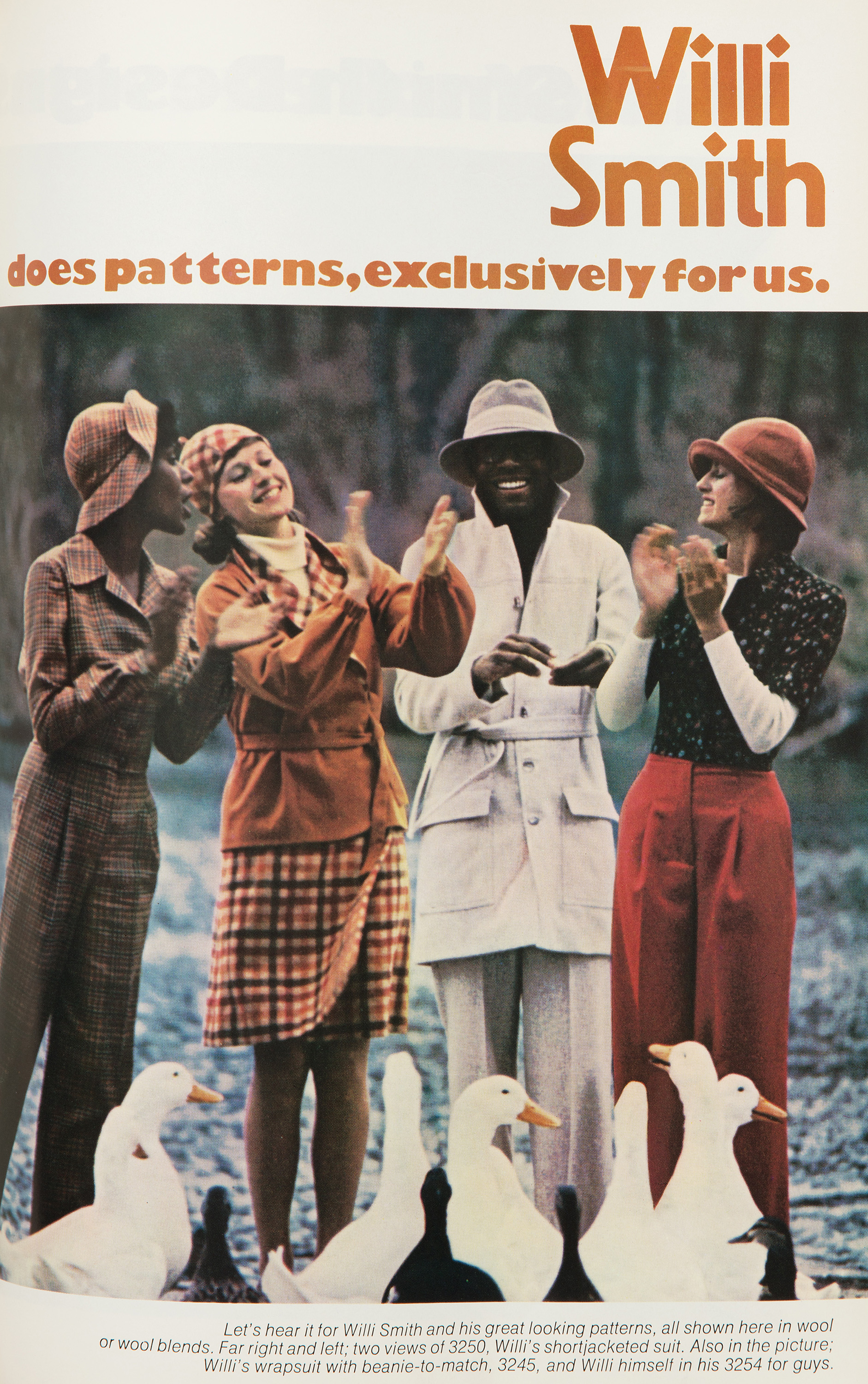
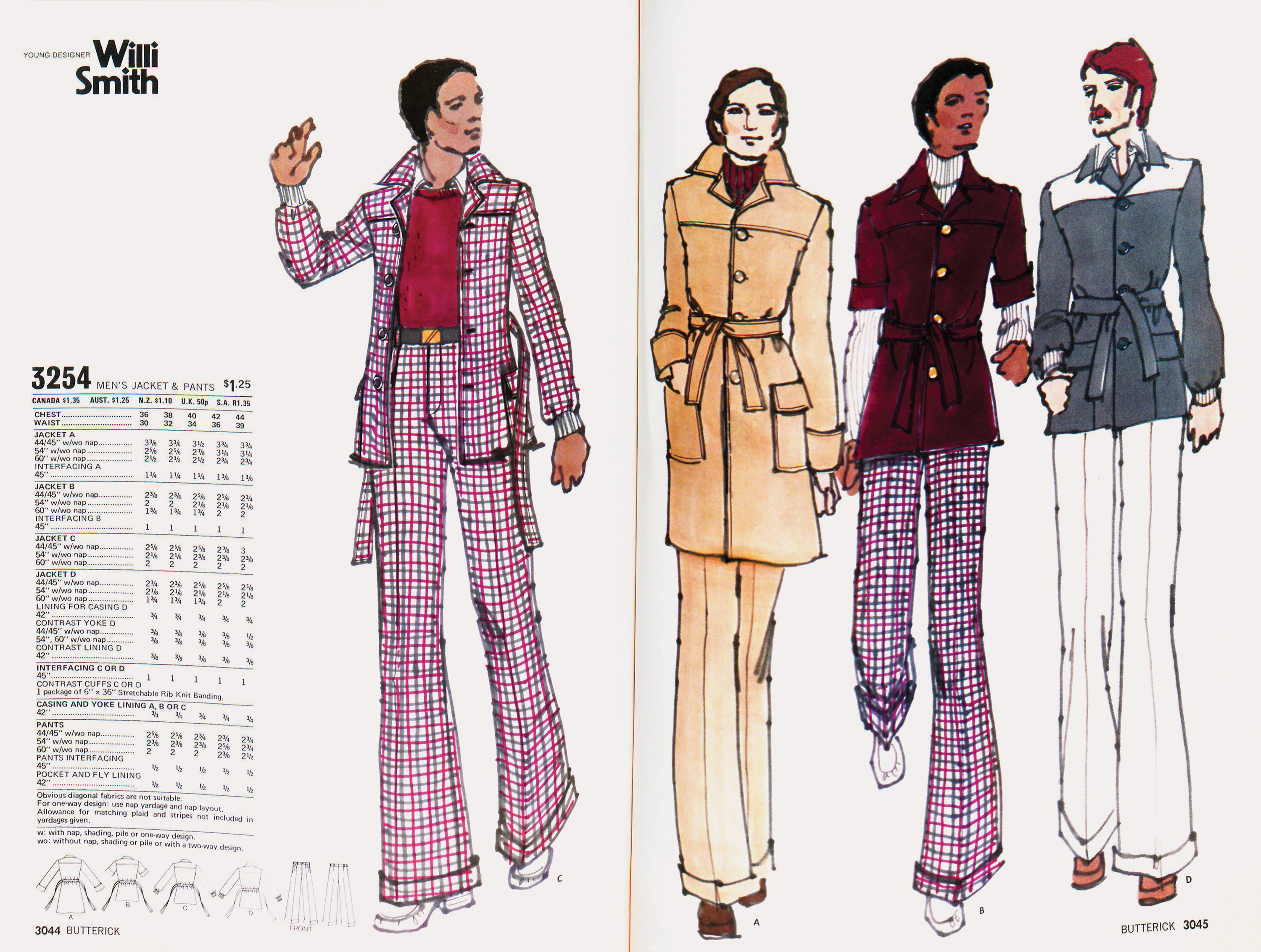
Willi Smith for Butterick Pattern 3254 from 1973 introduces a menswear set that interprets the Norfolk jacket, a staple of men’s sportswear in England during the second half of the nineteenth century often adapted for military and law-enforcement uniforms. This pattern illustrate an early example of Smith’s interest in uniform dress, a reference he adapted frequently throughout his career.
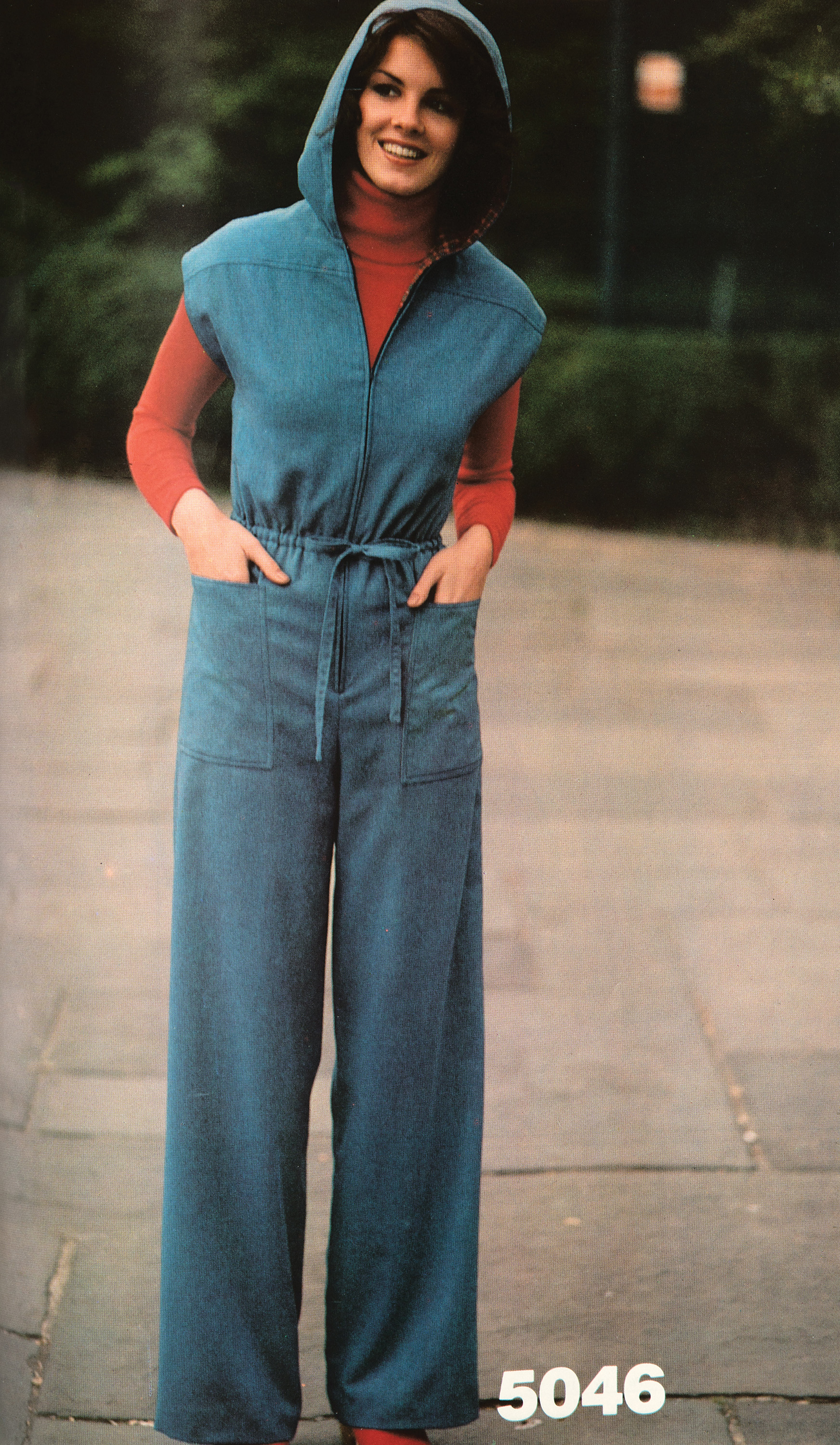

Willi Smith for Butterick Pattern 5046 from 1976 illustrates Smith’s love affair with the jumpsuit, a garment with origins in both the artistic community and dress history. H. D. Lee Mercantile Company (which later became known for Lee jeans) introduced the Lee Union-All one-piece coverall in 1913, worn predominately by blue-collar workers, while futurist artist Thayaht (pseudonym of Ernesto Michahelles) is credited with introducing the jumpsuit into civilian closets in 1919 after being inspired by parachute jumpers.
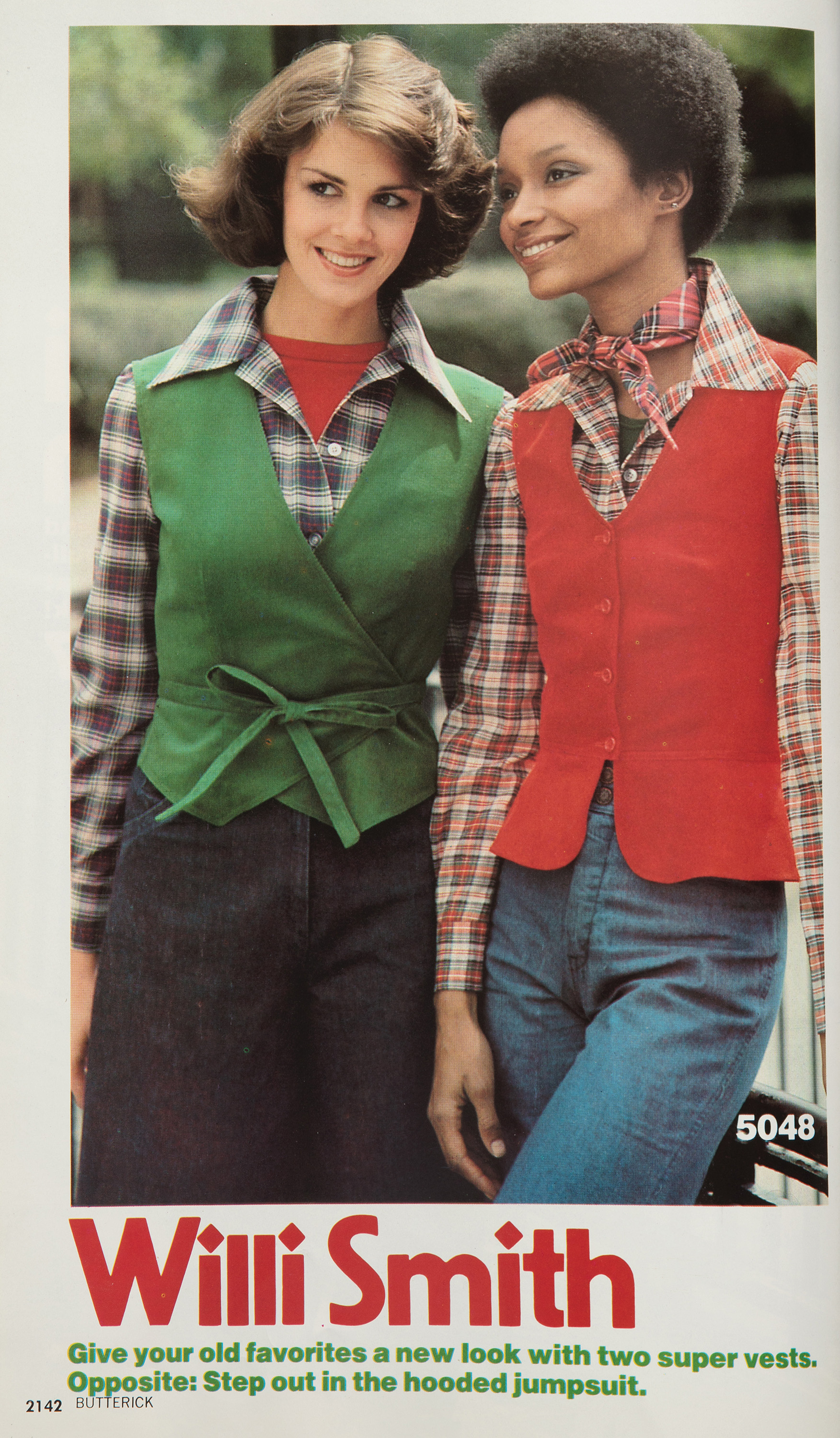

Willi Smith for Butterick Pattern 5048 from 1976 emphasizes voluminous sleeves and a streamlined vest reminiscent of womenswear in the thirties and forties, decades Smith pulled from in collections for Digits and eventually WilliWear. These patterns are shown in a tartan wool twill and styled with a complementary bandana, revealing Smith’s interest in dress associated with nostalgic imagery of the American West.


Willi Smith for Butterick Pattern 5047 from 1976 marries two of Smith’s major creative inspirations: dress native to communities in South and Central Asia, depicted here as a version of the salwar kameez, a tunic and trouser ensemble worn by people of all classes, and uniform dress, referenced here in a generous apron pocket. Smith frequently designed garments that could transition from domestic to public spaces, and this particular expression reveals his experimentation with combining multi- cultural democratic garments to create a new adaptive wardrobe.
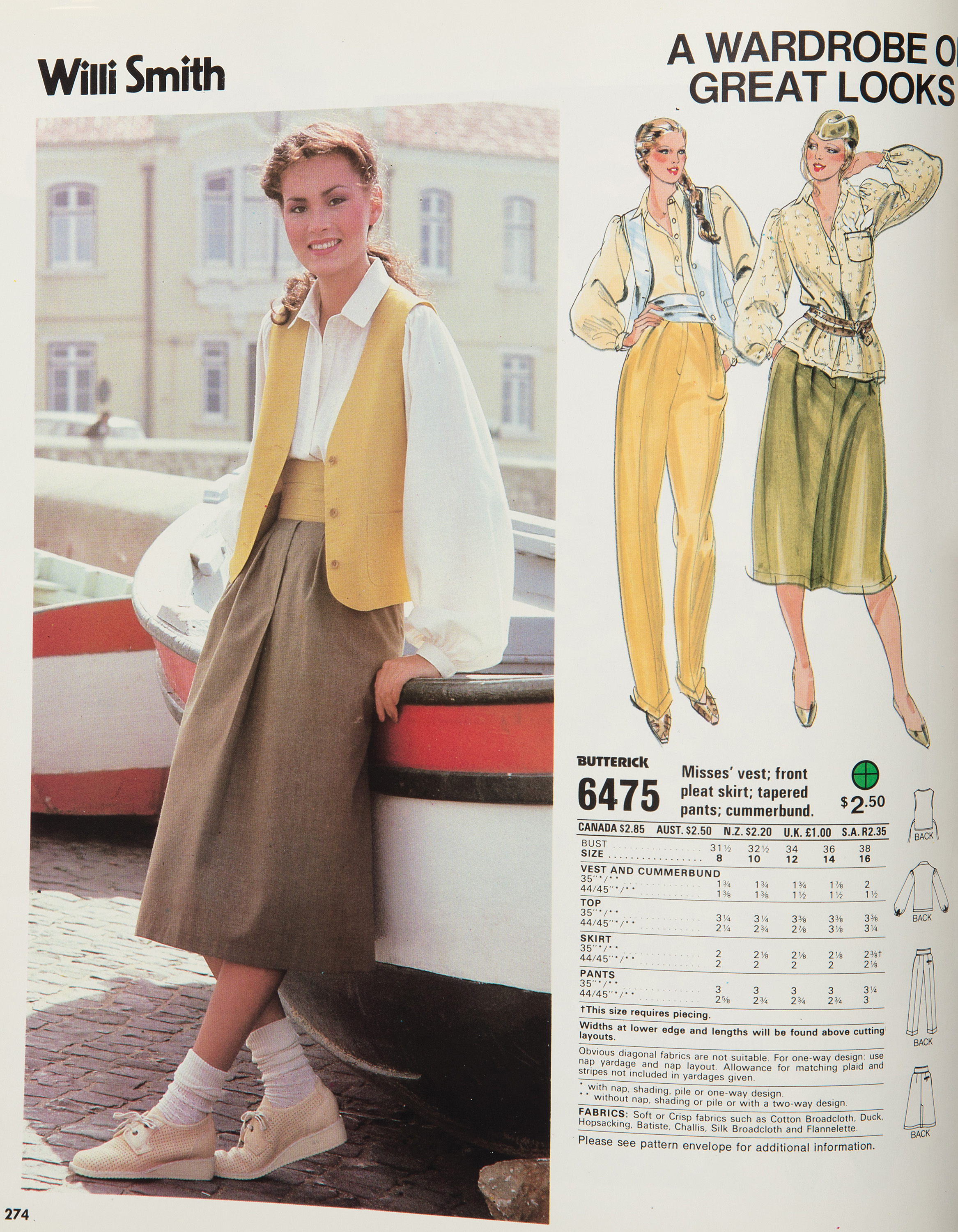 Willi Smith for McCall’s Pattern 6475 from 1979 emulates Smith’s WilliWear fall 1978 “musketeer”-inspired collection, which feminized traditional masculine ensembles through layered blouses cinched with cummerbunds under fitted vests with tapered bodies and padded shoulders. Like the collection, these patterns are a romantic reinterpretation of seventeenth-century men’s and women’s styles.
Willi Smith for McCall’s Pattern 6475 from 1979 emulates Smith’s WilliWear fall 1978 “musketeer”-inspired collection, which feminized traditional masculine ensembles through layered blouses cinched with cummerbunds under fitted vests with tapered bodies and padded shoulders. Like the collection, these patterns are a romantic reinterpretation of seventeenth-century men’s and women’s styles. WilliWear for McCall’s Pattern 7947 from 1982 suggests a slight leg-of-mutton sleeve, which pays homage to the development of ready-to-wear womenswear in the 1890s by way of the shirtwaist, a button-down blouse made for the evolving active lifestyles of women during this period. The voluminous, fashionable silhouette at this time was modeled after the athletic “Gibson Girl” archetype that utilized the leg-of-mutton sleeves as a way to visually broaden a woman’s shoulders.
WilliWear for McCall’s Pattern 7947 from 1982 suggests a slight leg-of-mutton sleeve, which pays homage to the development of ready-to-wear womenswear in the 1890s by way of the shirtwaist, a button-down blouse made for the evolving active lifestyles of women during this period. The voluminous, fashionable silhouette at this time was modeled after the athletic “Gibson Girl” archetype that utilized the leg-of-mutton sleeves as a way to visually broaden a woman’s shoulders.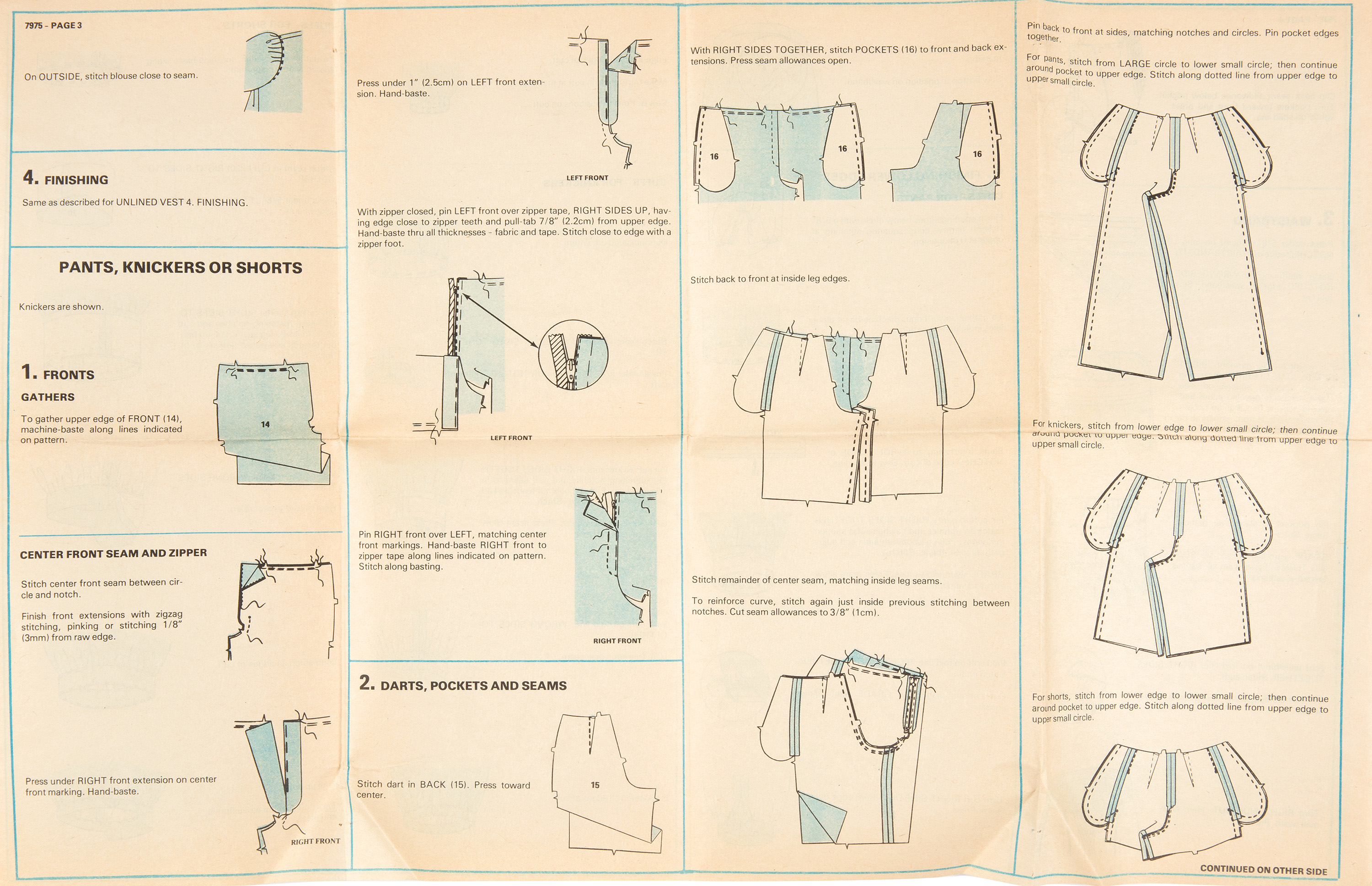
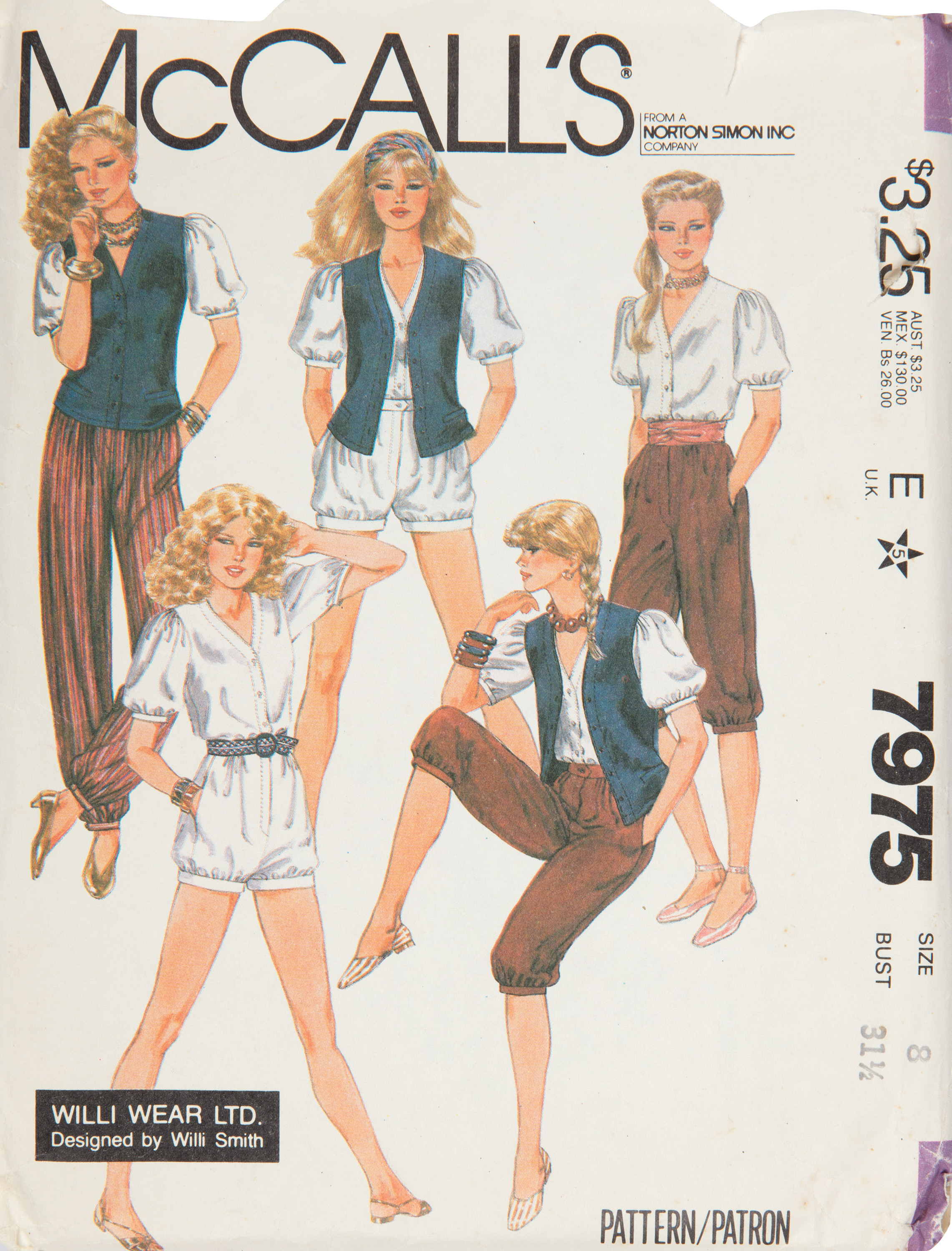
WilliWear for McCall’s Pattern 7975 from 1982 evokes late nineteenth century bloomers, championed by women’s rights activist Amelia Bloomer as a liberating alternative to petticoats. Smith’s cheeky play on dynamic underwear as outerwear was previously employed in his spring 1982 WilliWear collection and plastered in his Art as Damaged Goods installation at P.S. 1 that same year.
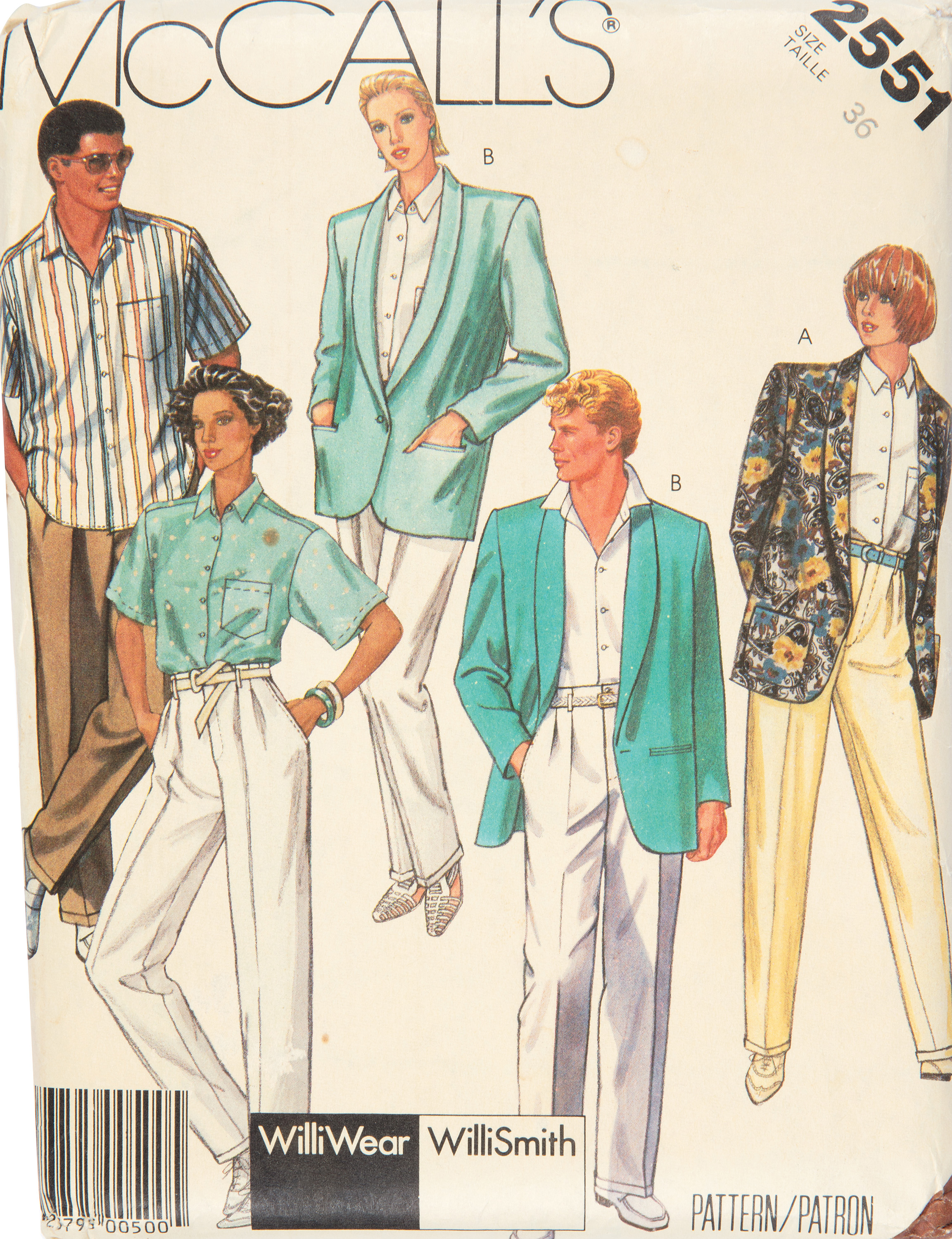

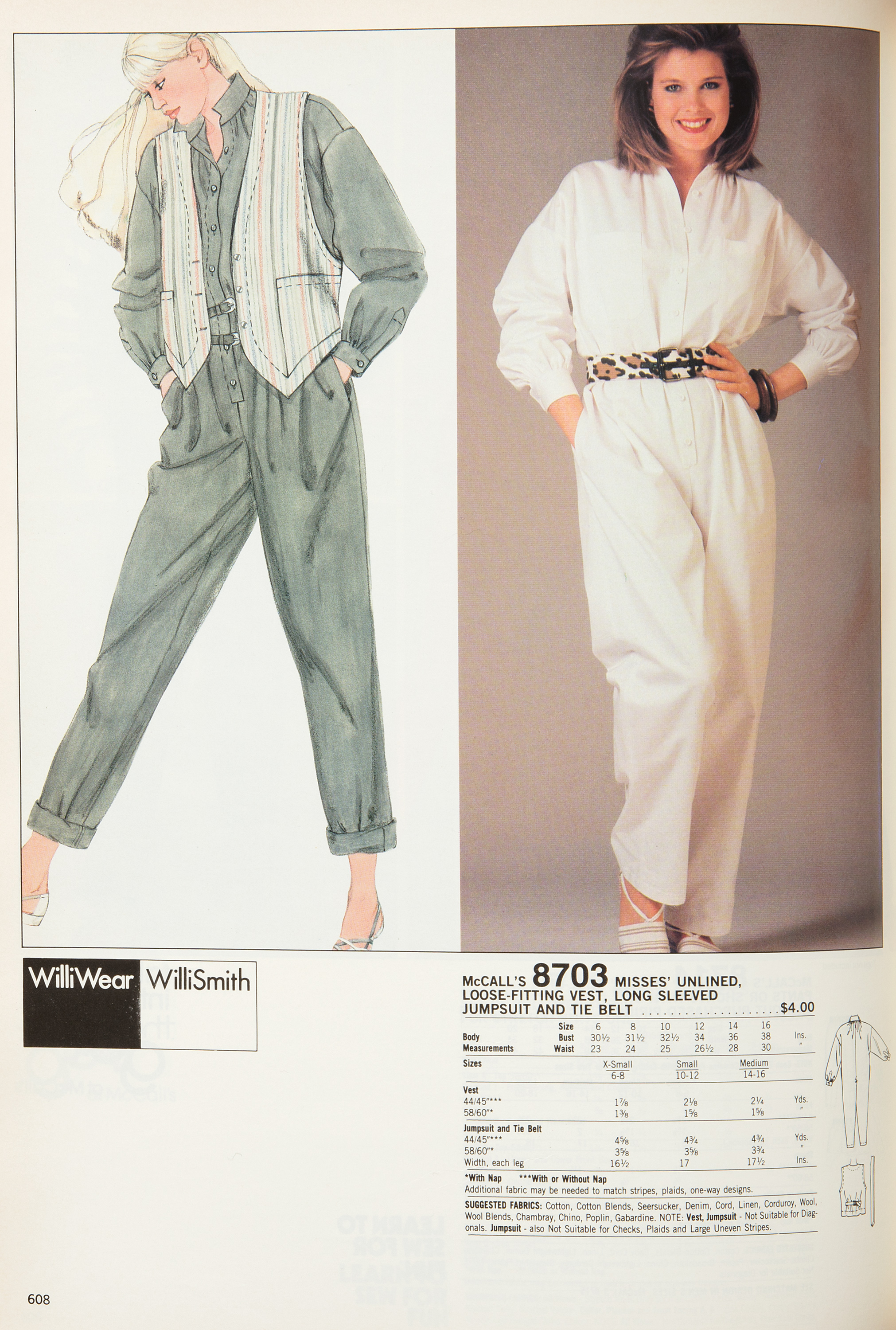
WilliWear for McCall’s Pattern 8703 from 1983 melds coveralls with Western accessories for women. The image of U.S. women in coveralls became iconic during World War II when women temporarily transitioned into blue-collar jobs traditionally held by men. Westinghouse Electric’s popular depiction of “Rosie the Riveter” has become a familiar symbol of female empowerment. Vests were commonly worn by men during the height of migration to the West during the nineteenth century, but the vests that cowboys wore consisted of durable materials such as animal hide to minimize snagging on foliage. Vests also provided easy access to small objects cowboys couldn’t store in their pants while they were riding. Smith’s introduction of the vest over the coverall creates a strong amalgamation of historically masculine utility clothing, styled for women.
 WilliWear for McCall’s Pattern 8535 from 1984 encourages sewers to use natural fibers such as linen and cotton to render the long jacket, trousers, and shorts. Seen in Smith’s 1985 film Expedition, this safari suit reboot alludes to Smith’s awareness of colonialism and frequent integration of elements associated with the history of colonial dress in West Africa and Southeast Asia.
WilliWear for McCall’s Pattern 8535 from 1984 encourages sewers to use natural fibers such as linen and cotton to render the long jacket, trousers, and shorts. Seen in Smith’s 1985 film Expedition, this safari suit reboot alludes to Smith’s awareness of colonialism and frequent integration of elements associated with the history of colonial dress in West Africa and Southeast Asia.
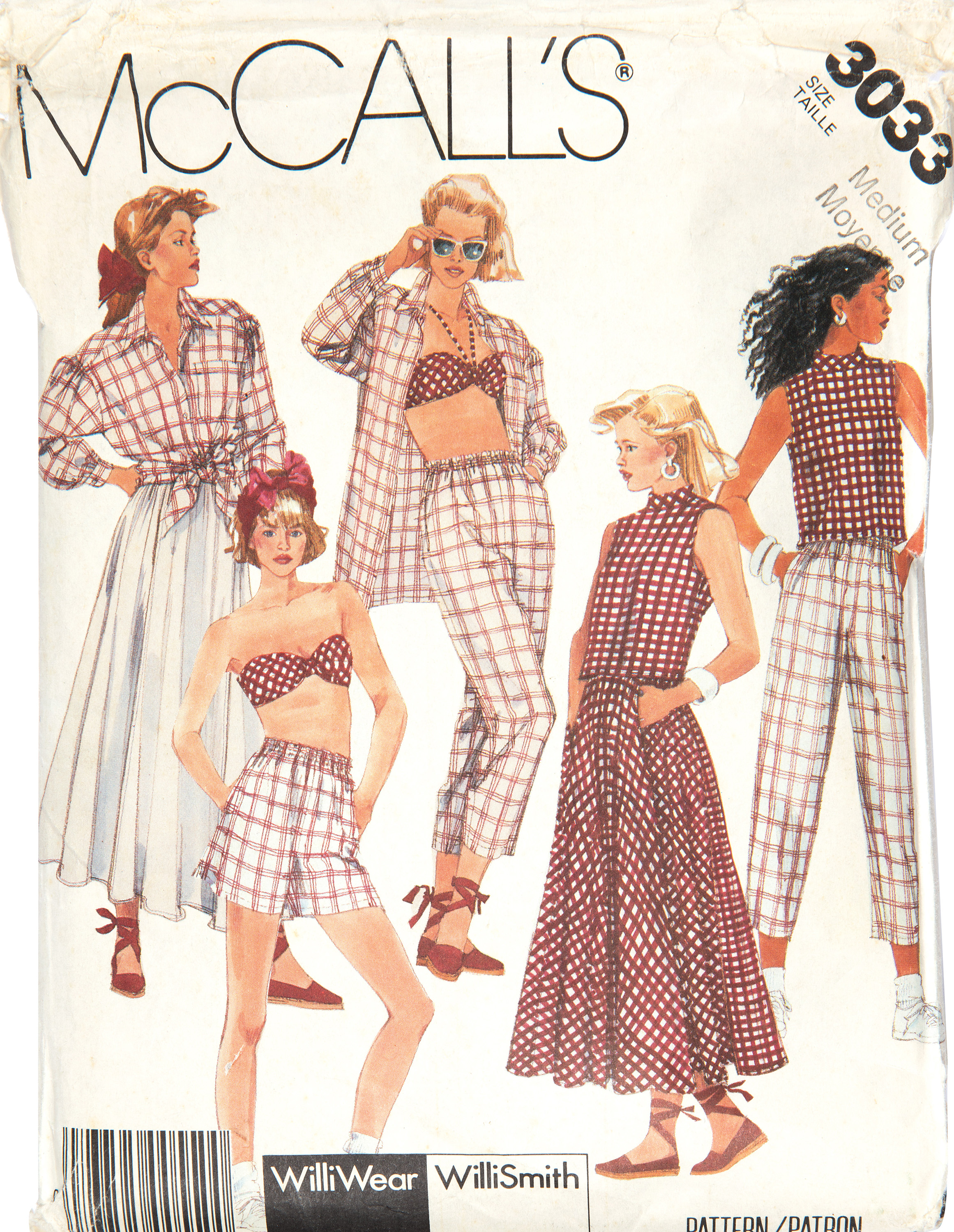
WilliWear for McCall’s Pattern 3033 from 1984, highlights Smith’s frequent use of gingham, which has histories of use in Japan, India, and Africa. Gingham, a plain-woven textile, typically cotton, with a checked colored pattern, was a major export of mills in Manchester, England, during the eighteenth century due to its inexpensive and reversible composition, and has been produced in the United States for centuries. The decision to illustrate these familiar WilliWear basics in gingham alludes to Smith’s attraction to affordable utilitarian fabrics, uniform dress, and the tartan wool designs worn in the American West.
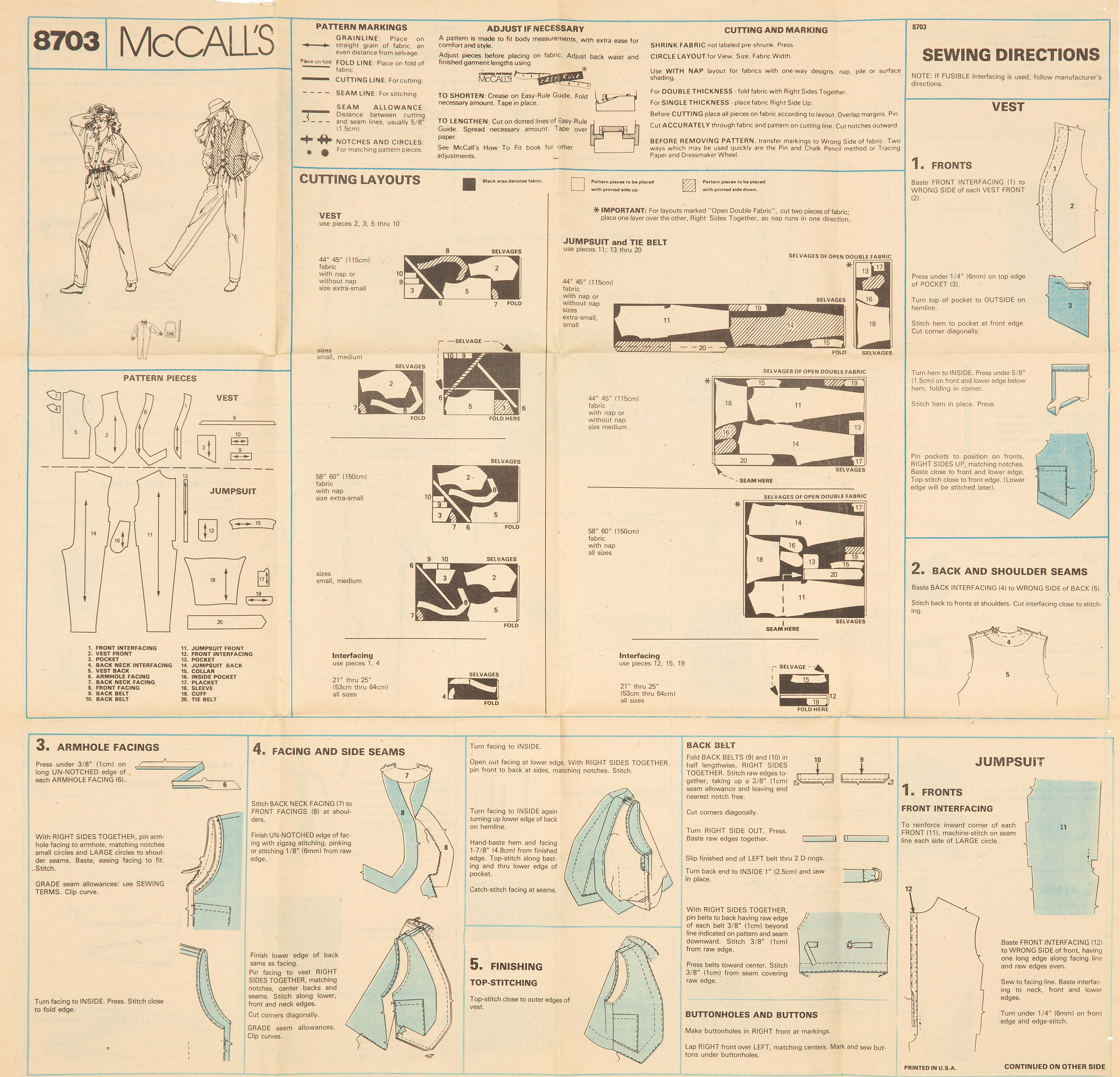
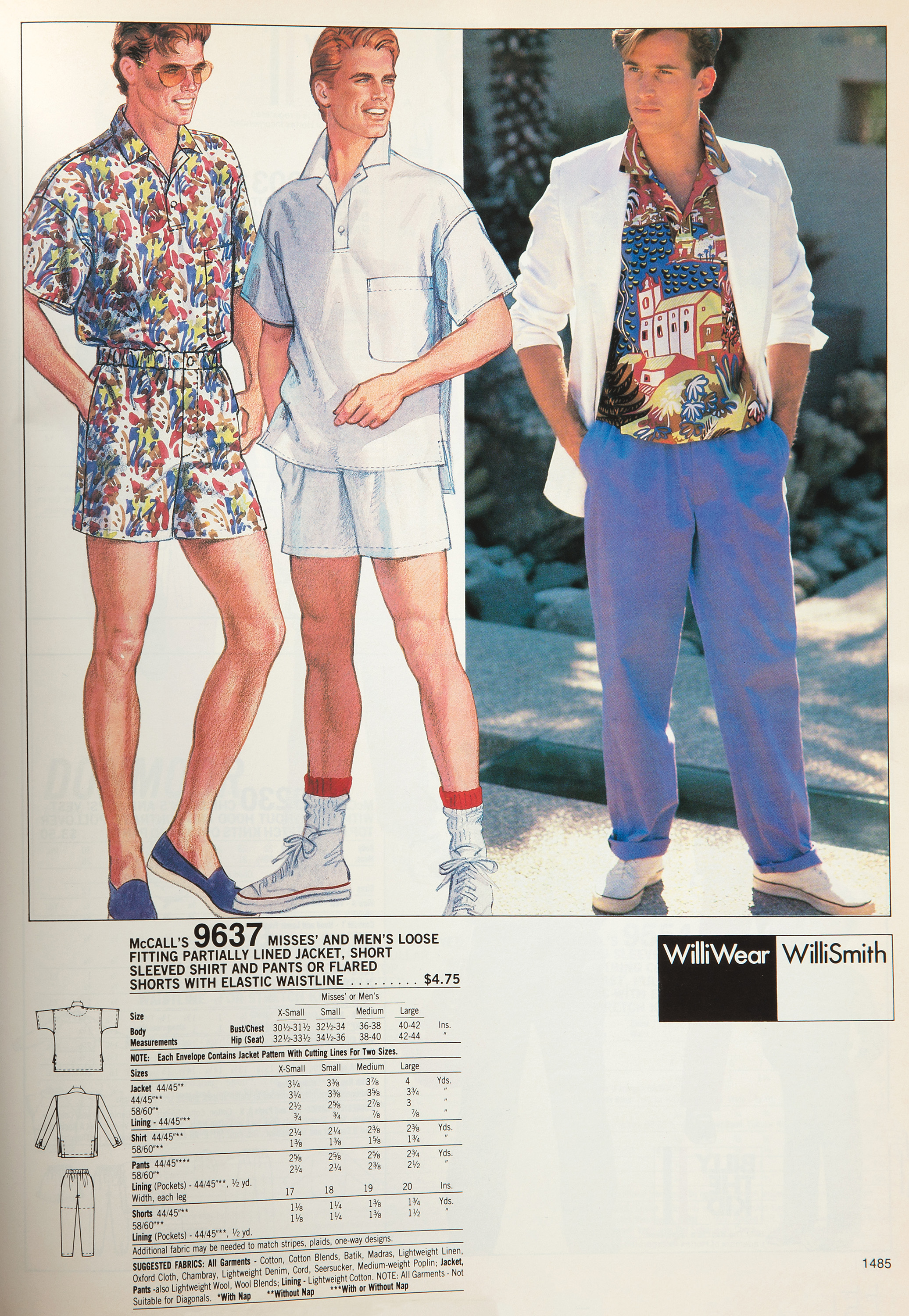
 WilliWear for McCall’s Pattern 9637 from 1985 presents Smith’s continued play with gender norms for general public consumption. Floral prints in menswear date back to eighteenth-century men’s banyans and eventually coats, but they fell out of favor as the nineteenth century progressed, as that level of ostentation was seen as too frivolous and feminine. The use of this print celebrates the reintroduction of bold floral prints for men in the sixties and the normalizing of gender-neutral style in the seventies in the United States at a time when gender norms were being reintroduced into mainstream fashion.
WilliWear for McCall’s Pattern 9637 from 1985 presents Smith’s continued play with gender norms for general public consumption. Floral prints in menswear date back to eighteenth-century men’s banyans and eventually coats, but they fell out of favor as the nineteenth century progressed, as that level of ostentation was seen as too frivolous and feminine. The use of this print celebrates the reintroduction of bold floral prints for men in the sixties and the normalizing of gender-neutral style in the seventies in the United States at a time when gender norms were being reintroduced into mainstream fashion.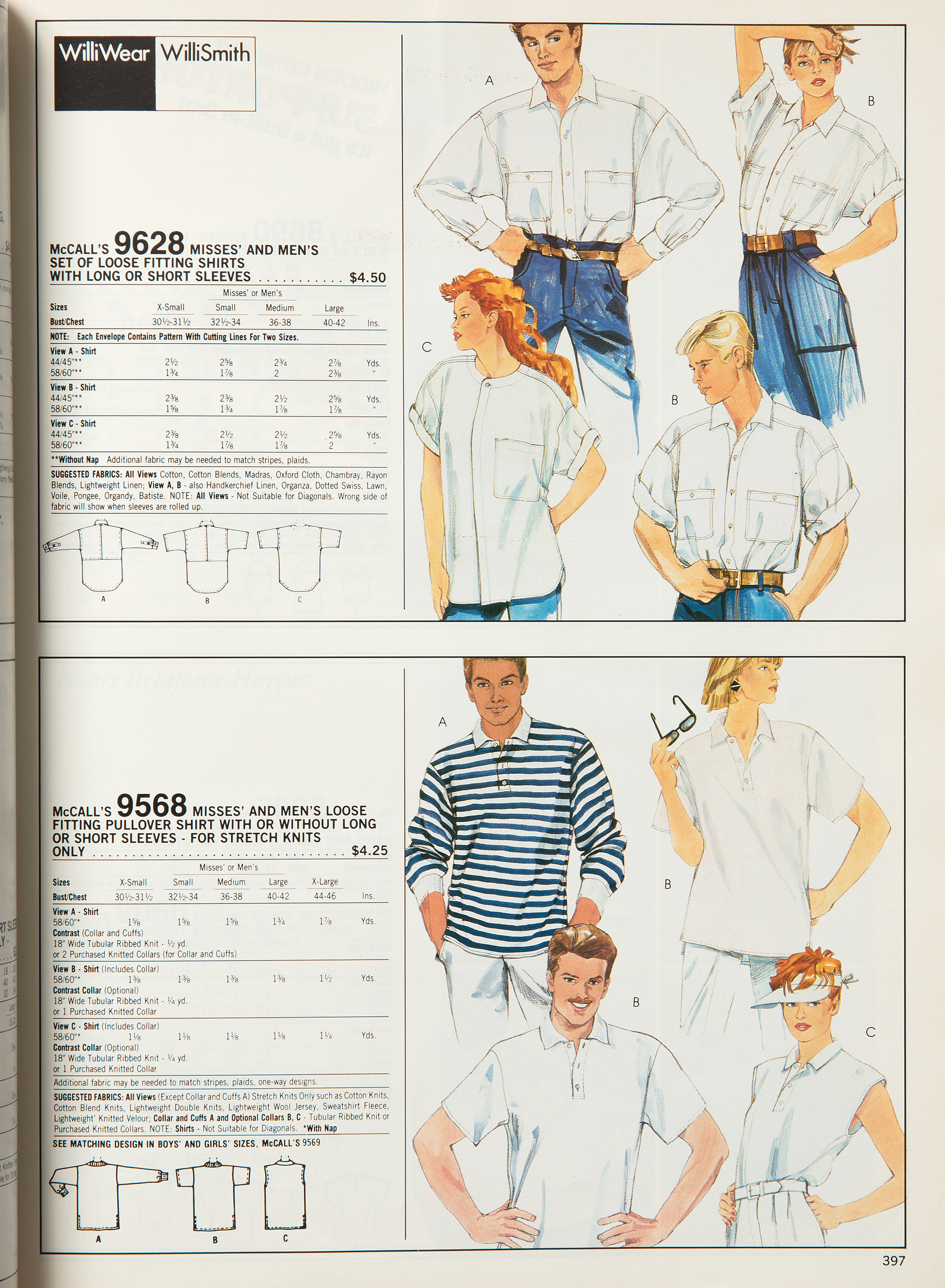
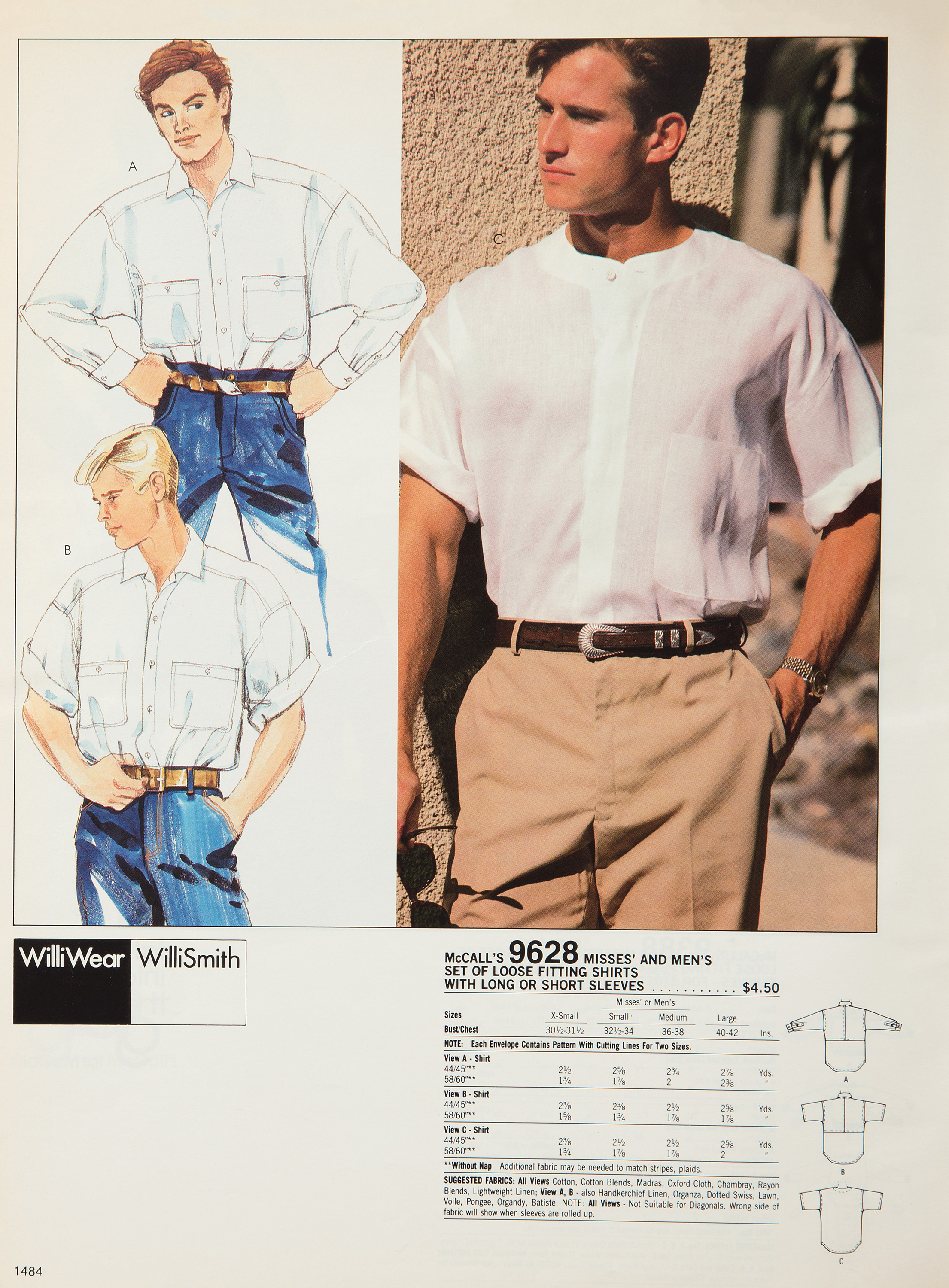 WilliWear for McCall’s Pattern 9628 from 1985 points to typical Smith fusion, combining dress associated with Southeast Asian communities with American Western wear and military dress. The slight standing collar of the shirt pattern represents a mixture of the kurta tunic and the Nehru jacket, a style associated with the uniform of Jawaharlal Nehru, the first prime minister of India; it was originally derived from the silhouette of the jackets worn by Chinese mandarins, government officials during the Qing dynasty. Smith’s pattern for the shirt is paired with blue jeans and khaki pants with a thin belt, accessorized in the editorial photograph as a Barry Kieselstein-Cord design that Smith was often photographed wearing.
WilliWear for McCall’s Pattern 9628 from 1985 points to typical Smith fusion, combining dress associated with Southeast Asian communities with American Western wear and military dress. The slight standing collar of the shirt pattern represents a mixture of the kurta tunic and the Nehru jacket, a style associated with the uniform of Jawaharlal Nehru, the first prime minister of India; it was originally derived from the silhouette of the jackets worn by Chinese mandarins, government officials during the Qing dynasty. Smith’s pattern for the shirt is paired with blue jeans and khaki pants with a thin belt, accessorized in the editorial photograph as a Barry Kieselstein-Cord design that Smith was often photographed wearing.

Prakash Kundalia, Willi Smith, and Vijay Agarwal outside of airport in Mumbai, India, ca. 1978
Vijay Agarwal
WilliWear’s beginnings, in December 1975, roughly coincided with my own factory’s beginning. From the outset, our destinies were intertwined, and I could not ask for better people or company with whom to take this journey. In 1975, for most designers in the U.S., producing high-end apparel in India was a taboo! It took Laurie and Willi’s pioneering spirit, a great eye for potential and possibility, and tolerance and patience to develop and manufacture WilliWear successfully in India. Willi painstakingly guided us through many processes and production steps and worked patiently with our pattern masters and sample makers to produce inspired designs and apparel from simple fabrics, which were readily available in India.
Willi and Laurie were extremely close and complemented each other very well. One of my favorite memories of working with them was during a drive in Bombay, when Willi suddenly asked the driver to stop at a traffic circle: he loved the shorts the traffic policeman was wearing. He asked me to get them for him. We managed to get them and the humble shorts, called the “Bombay Shorts” in his collection, went on to become one of his best-selling shorts in the early years.
On another occasion, he saw some school children playing on a playground and was inspired by their simple outfits. From these uniforms, he made a simple blouse which made the inside cover of the New York Times Fashion of the Times issue in his second or third year in business. We also all remember his fatigue pants and poet’s shirt—two styles that helped both of our companies to grow significantly. We couldn’t make enough! Again, the fabrics and designs were very simple.
I also have memories of how, when he would come to India, he would take a large room at the traditional Taj Hotel, and the first thing he would do would be to put up white fabric on all the walls. His goal was to remove all color from his environment, which would allow him to come up with his own inspirations.
One season, when he came to India to develop a collection, he was working morning to evening in his cabin and had completed his designs. It took him three weeks. And then one morning, while sitting in a coffee shop, he started scribbling on tissue paper and in one night, he had changed all of the styles he developed in the last three weeks. In the next few days, we had to make all of the samples once again, and that season was one of the best seasons in WilliWear history.
When I think of Willi, I think of him more as a person than as a designer. The world has seen his genius and his accomplishments, but what has stayed with me are his qualities as a person. I saw how fluidly designs would flow from within him. Like many great artists, he made creativity look simple. I have often been struck by how we could both look at the same picture, and how he would pick up so much more from the picture than I would. Again, this could be due to his sensitive nature as an artist.
I saw in him a great perception for beauty and a strong desire to share this with his friends. He used to collect many artifacts during his visits to India. His colleagues shared with me that once he went to every employee of his company and left a beautiful piece of artisanal work on their desks. His love for sharing beauty could also be seen when he presented his collections to the press; he could hold me captivated watching how he thought about and presented his collections.
He was also very generous and helpful to his friends. I heard that once he met a fellow designer friend at the airport who was struggling. He took out his pad and quickly sketched a top and gave it to her. She later told him that she did very well with the style, and that it helped her tremendously in her business.
He had a zest for life. His capacity to enjoy life, and his love for music and dance were inspiring to watch. He was also very appreciative of other artists and creators across multiple disciplines. He truly was a fashion designer for people on the street!
One season, when he came to India to develop a collection, he was working morning to evening in his cabin and had completed his designs. It took him three weeks. And then one morning, while sitting in a coffee shop, he started scribbling on tissue paper and in one night, he had changed all of the styles he developed in the last three weeks. In the next few days, we had to make all of the samples once again, and that season was one of the best seasons in WilliWear history.
When I think of Willi, I think of him more as a person than as a designer. The world has seen his genius and his accomplishments, but what has stayed with me are his qualities as a person. I saw how fluidly designs would flow from within him. Like many great artists, he made creativity look simple. I have often been struck by how we could both look at the same picture, and how he would pick up so much more from the picture than I would. Again, this could be due to his sensitive nature as an artist.
I saw in him a great perception for beauty and a strong desire to share this with his friends. He used to collect many artifacts during his visits to India. His colleagues shared with me that once he went to every employee of his company and left a beautiful piece of artisanal work on their desks. His love for sharing beauty could also be seen when he presented his collections to the press; he could hold me captivated watching how he thought about and presented his collections.
He was also very generous and helpful to his friends. I heard that once he met a fellow designer friend at the airport who was struggling. He took out his pad and quickly sketched a top and gave it to her. She later told him that she did very well with the style, and that it helped her tremendously in her business.
He had a zest for life. His capacity to enjoy life, and his love for music and dance were inspiring to watch. He was also very appreciative of other artists and creators across multiple disciplines. He truly was a fashion designer for people on the street!
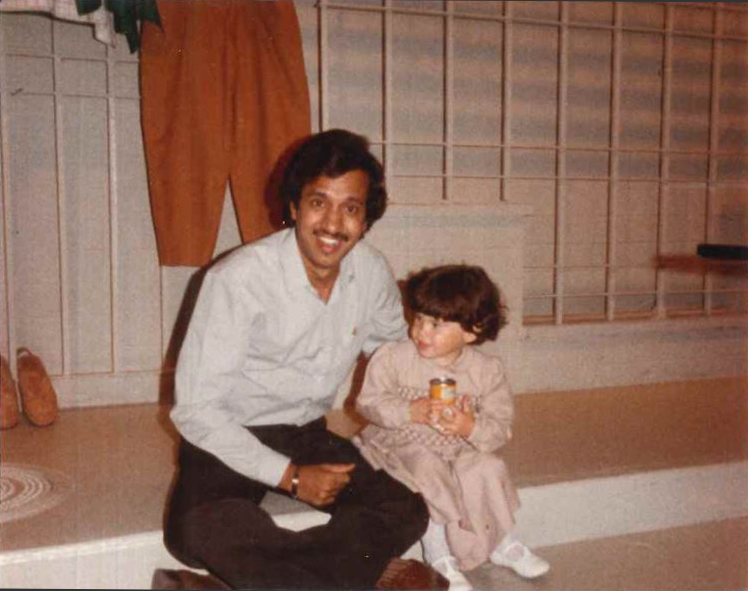

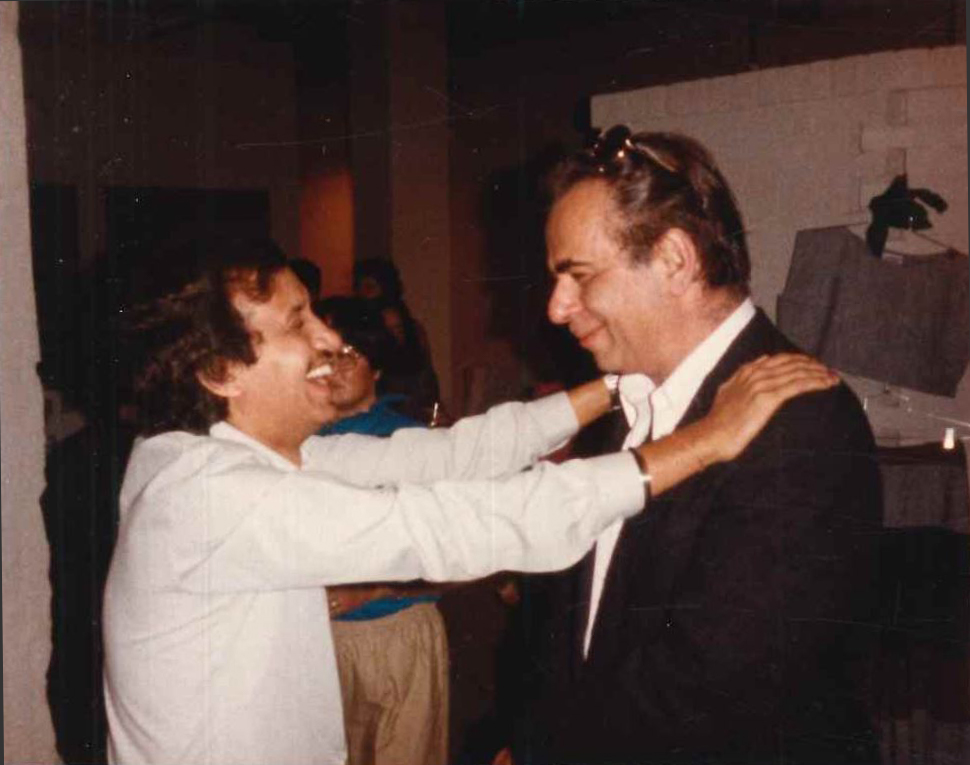
Juan-Manuel Alonso
I was hired by Willi Smith to design his menswear collection and be his right-hand man from the second men’s collection, which if I recall well, was a pre-fall collection. I know that all of my time there was amazingly creative and the most fun I have had in any of the positions I have had. Do not get me wrong, we worked extremely hard and very long hours, but since it was something we all enjoyed, time was relative. The studio worked as one big family. Willi was the head of this outlandish and creative group—which included the design staff, the pattern makers for both menswear and womenswear, as well as the sample room. We all worked as a timepiece and related to each other as a big family—dysfunctional at times but with great care for what we did. The main thing was getting the collection done and being on target for the different markets that were covered in each collection. With time, the routine of ending and starting a new season became as involuntary as breathing in and out in order to create and outdo oneself with each new season arriving. Being Willi's right hand got me involved in many wonderful projects—from private clients, for whom we made and designed clothes, to designing and continuing with different collaborations with artists—including the Bill T. Jones/Arnie Zane dance company, Twyla Tharp, Sounds in Motion, then-upcoming artist Keith Haring, as well as many others from the downtown creative crowd. On a daily basis, we knew when to come in but had no idea till what time we would work.
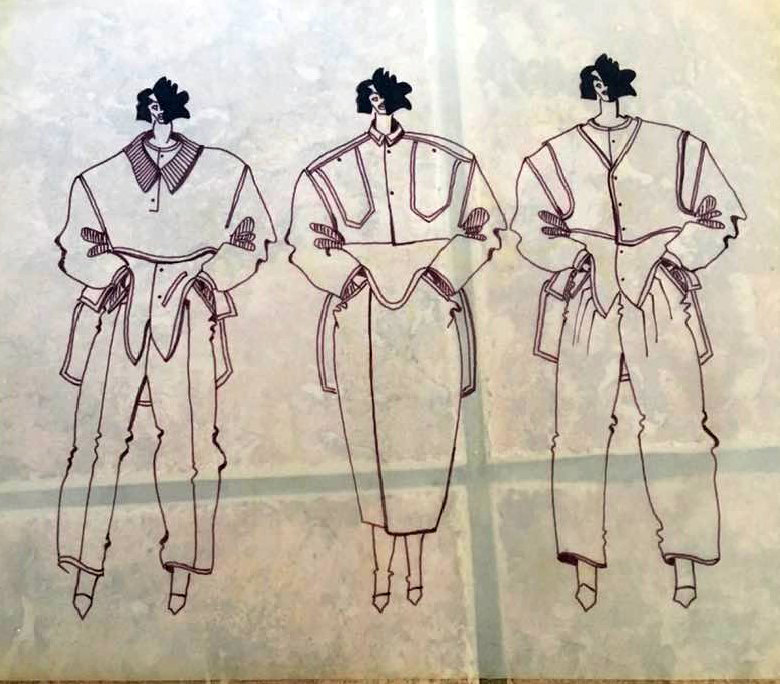
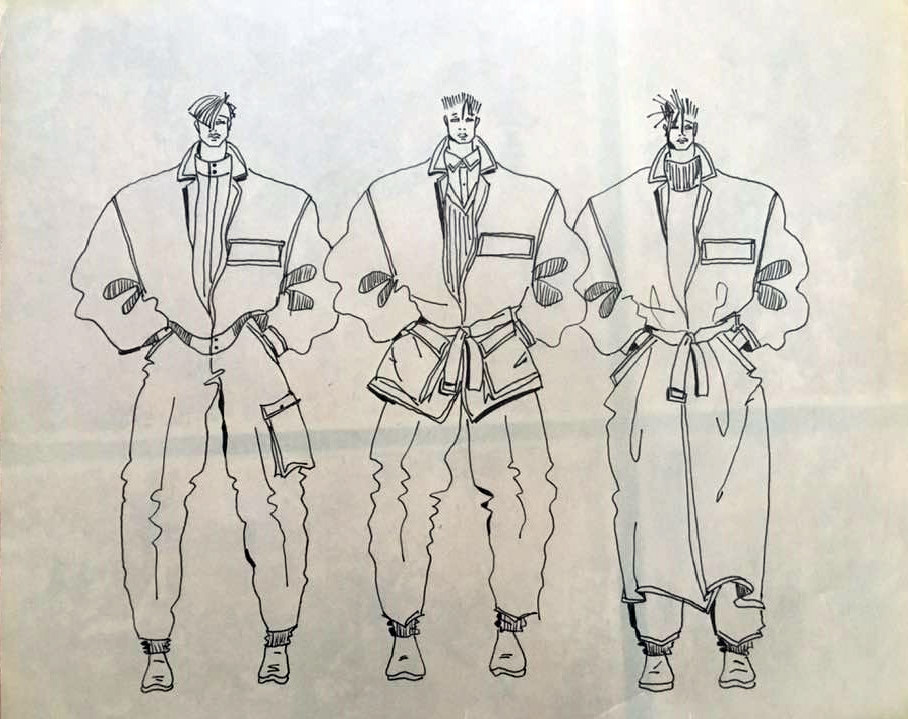

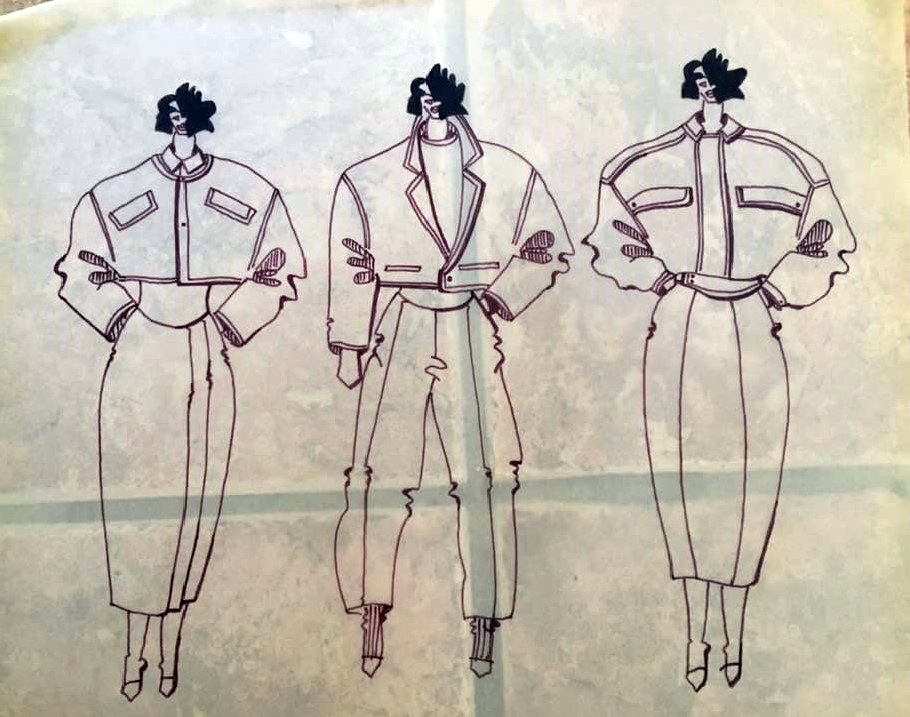
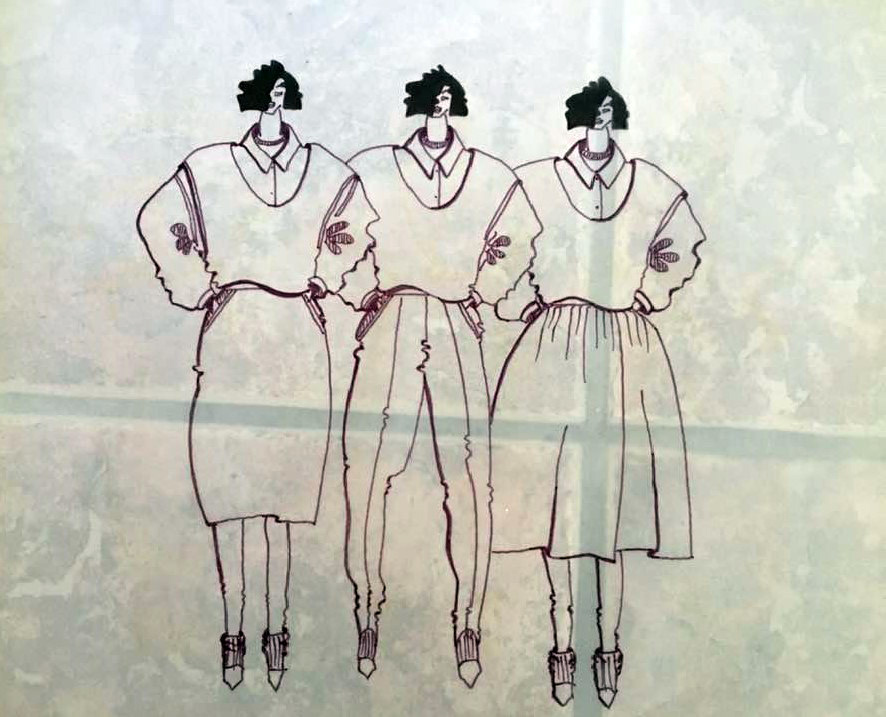
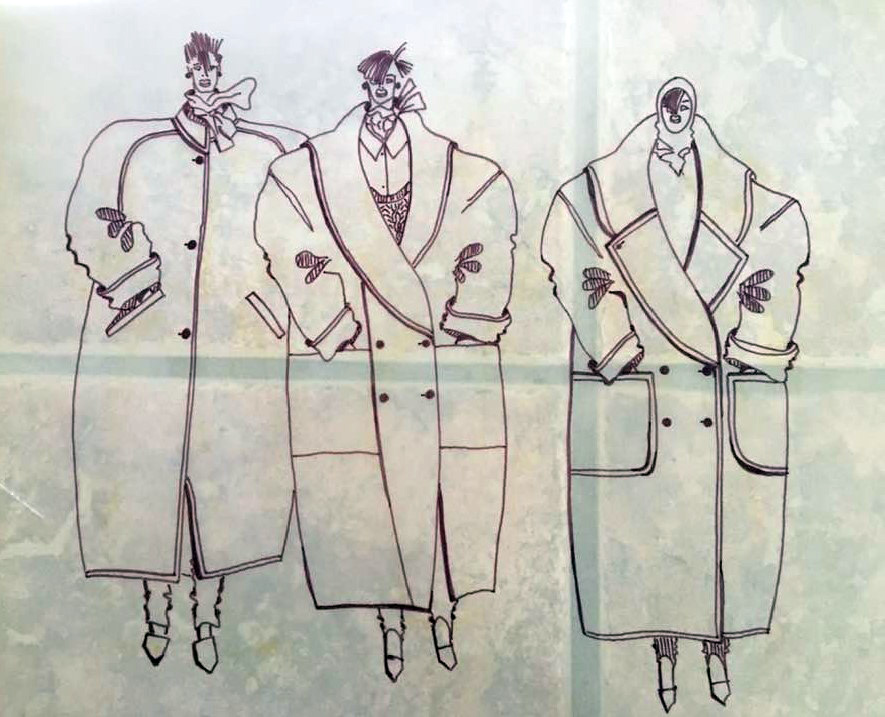
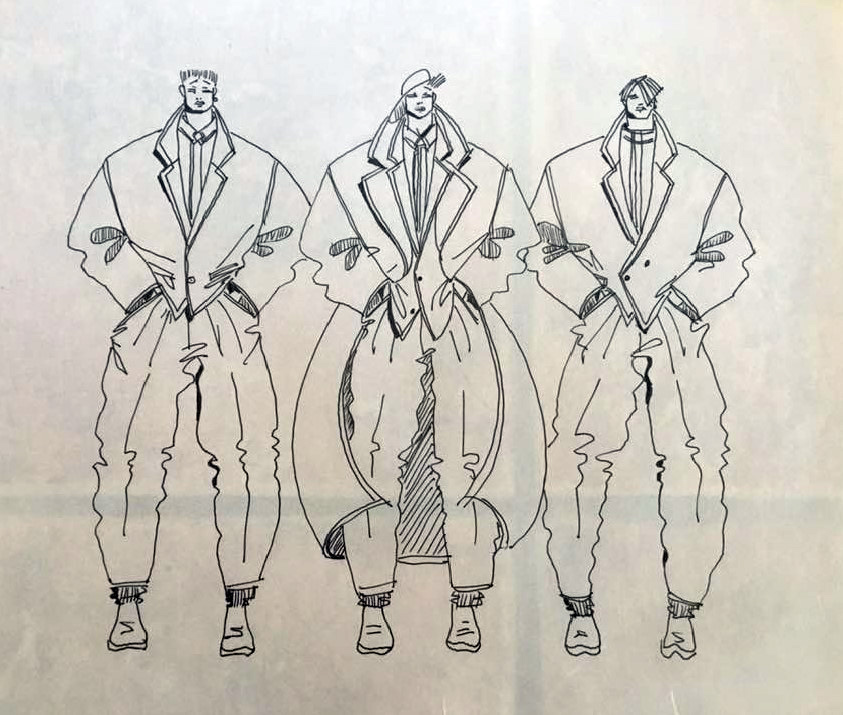
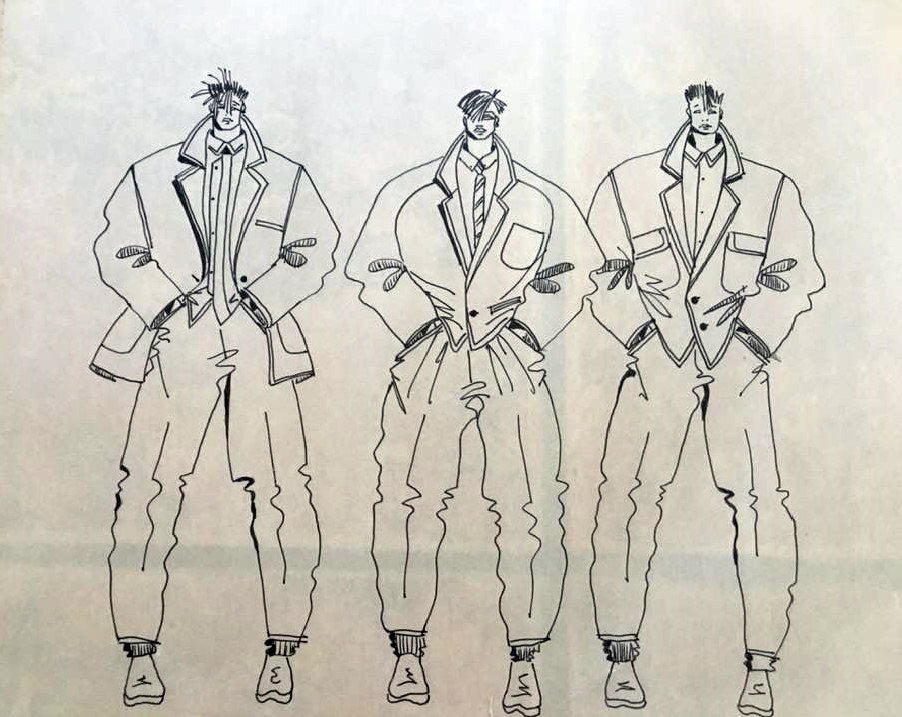
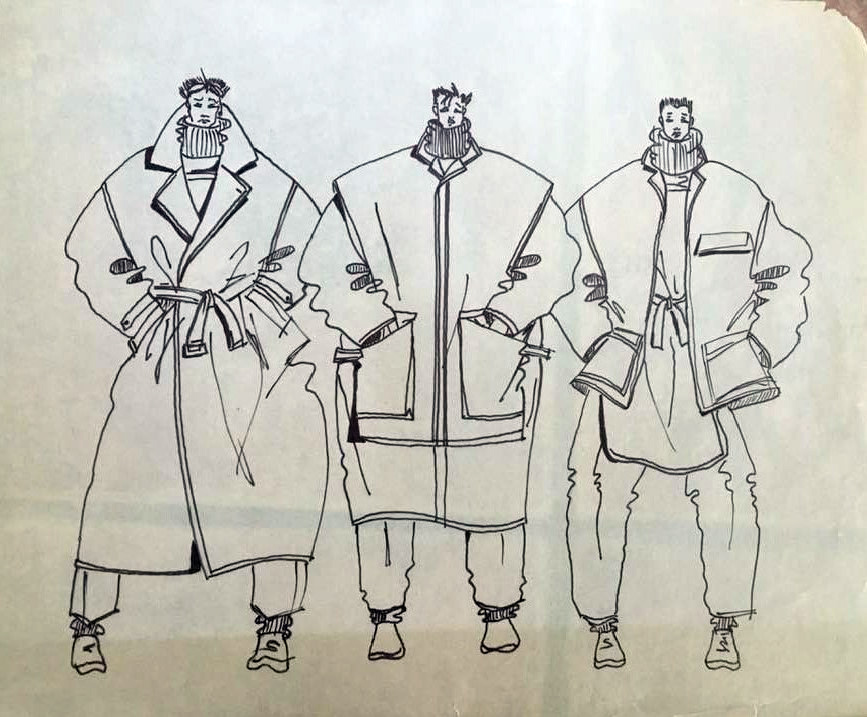

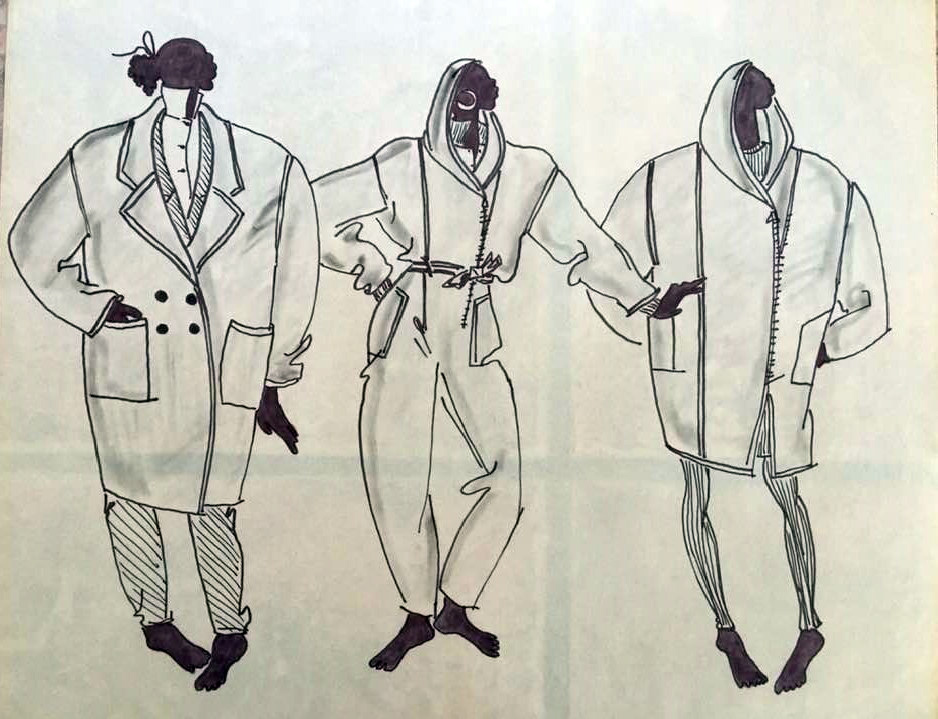
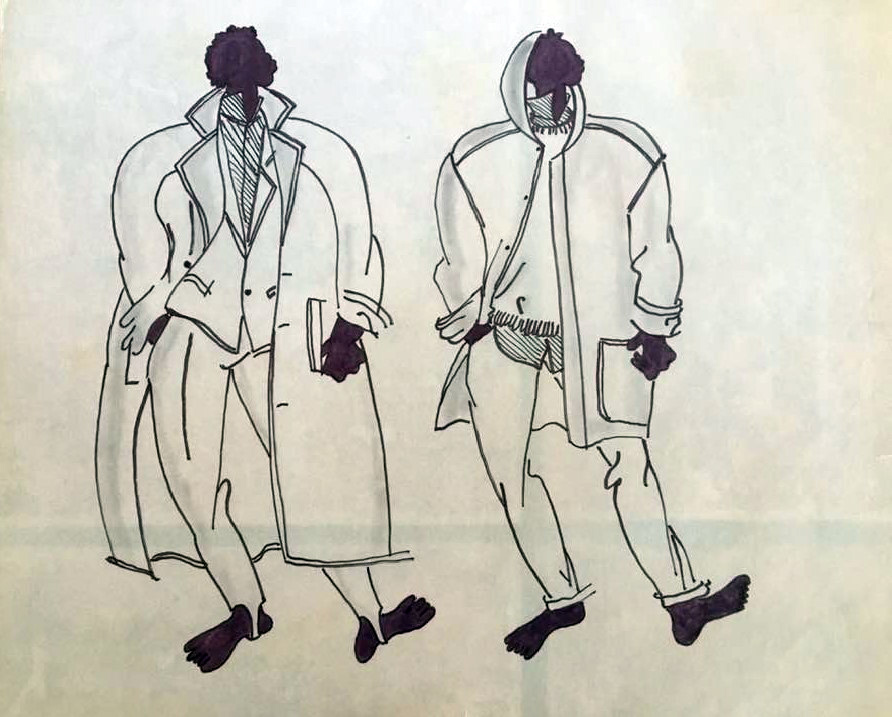
Sketches designed by Juan-Manuel Alonso for WilliWear
Christopher Andrews
I cannot remember exactly when I heard the name “Willi Smith” or his label WilliWear, but it must have been in some department store when I saw the tag on a suit. It was a box cut suit in a very soft fabric. It was in the eighties, and American sportswear was changing, becoming even more minimal and functional than before. I was entering my teens and discovering clothes for myself. My friends started talking about WilliWear and about Willi Smith being African American. This was something to talk about because, at the time, we scarcely knew of any Black designers, especially ones creating clothes that were young, spirited, and on par with the labels we already knew, like Calvin Klein and Perry Ellis. I remember once a classmate saved his money to buy a WilliWear suit. He proudly wore it to class, complete with the tags dangling from it. Everyone stopped him; everyone asked about WilliWear.
I had a red and gray woven WilliWear shirt that buttoned asymmetrically; it fit as if it were made for me. I, too, was asked about it often. Willi designed clothes that were understated, easy to understand, but captured you, the wearer, and anyone you passed. I was never sure how he did that. I don't think anyone has managed that kind of magic since.
![]() SITE for WilliWear, Showroom, New York, NY, Photographed by Andreas Sterzing, 1982
SITE for WilliWear, Showroom, New York, NY, Photographed by Andreas Sterzing, 1982
 SITE for WilliWear, Showroom, New York, NY, Photographed by Andreas Sterzing, 1982
SITE for WilliWear, Showroom, New York, NY, Photographed by Andreas Sterzing, 1982Stacey Appel
I was twelve years old in 1987, at the time when the Philadelphia Inquirer printed the comic strip of Peter Parker and Mary Jane Watson’s wedding from Marvel’s Amazing Spider-Man comic series. In the wedding, depicted in the Amazing Spider-Man Annual in 1987, Peter Parker married Mary Jane Watson, who wore a form-fitting wedding dress designed by Willi Smith before his passing. I cut the strip out and managed to keep it all these years—I kept it in a box with fashion drawings I had done as a kid.
I’m from Philadelphia and wanted to be a fashion designer since I was young. Willi Smith was my favorite designer—I assume I was exposed to him because of the Philly connection. I never got to wear any of his clothes, although I’ve gotten into the habit of going on eBay and trying to find his pieces every now and then! His style back then inspires how I dress now.
I also collect vintage fashion magazines and acquired the November 1978 issue of Life Magazine, which included a story called “Three Black Designers” with pieces on Willi Smith, Stephen Burrows, and Scott Barrie. I found it at a flea market a few years ago and drew a fashion illustration from the piece on Willi Smith.

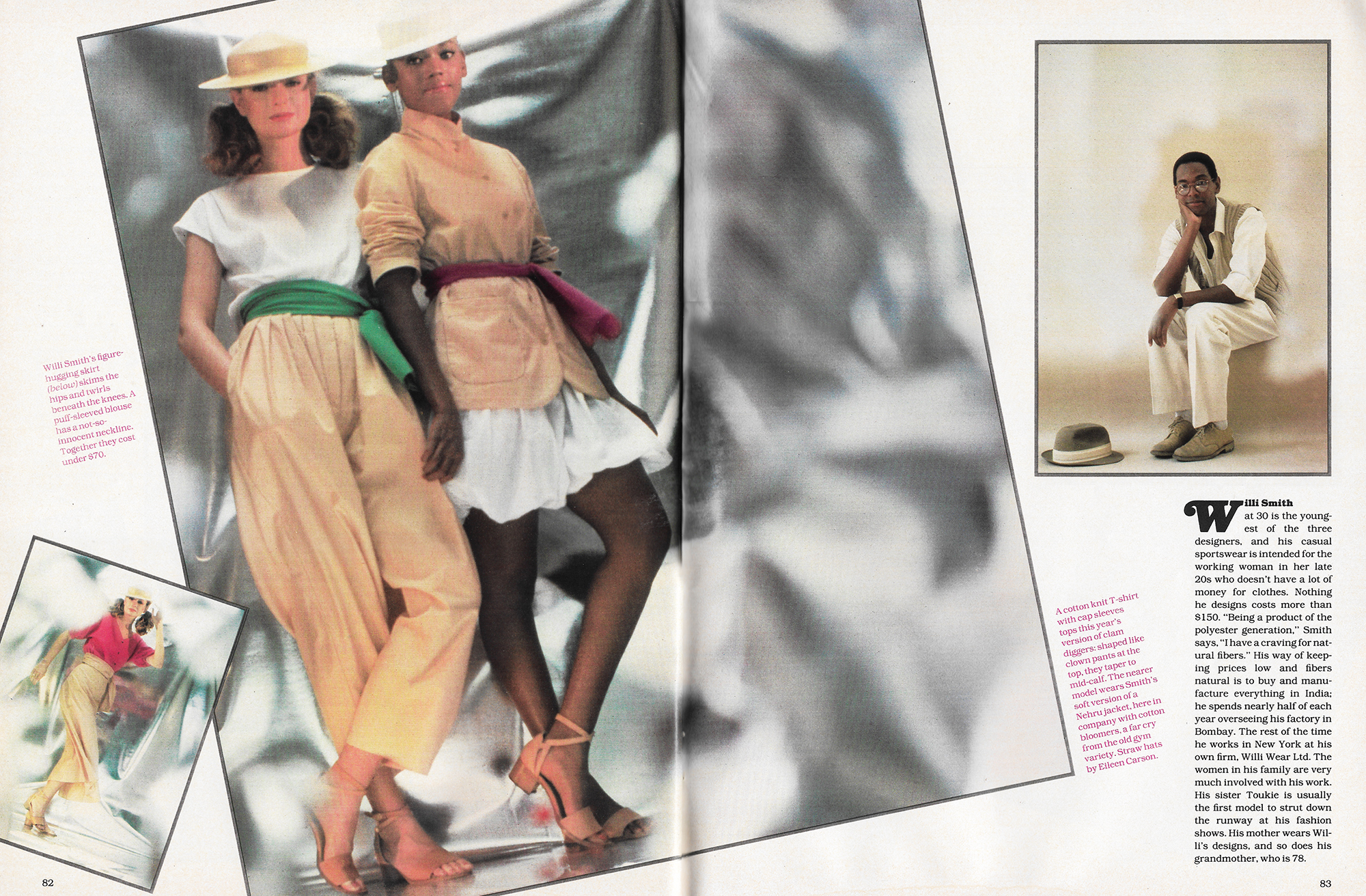
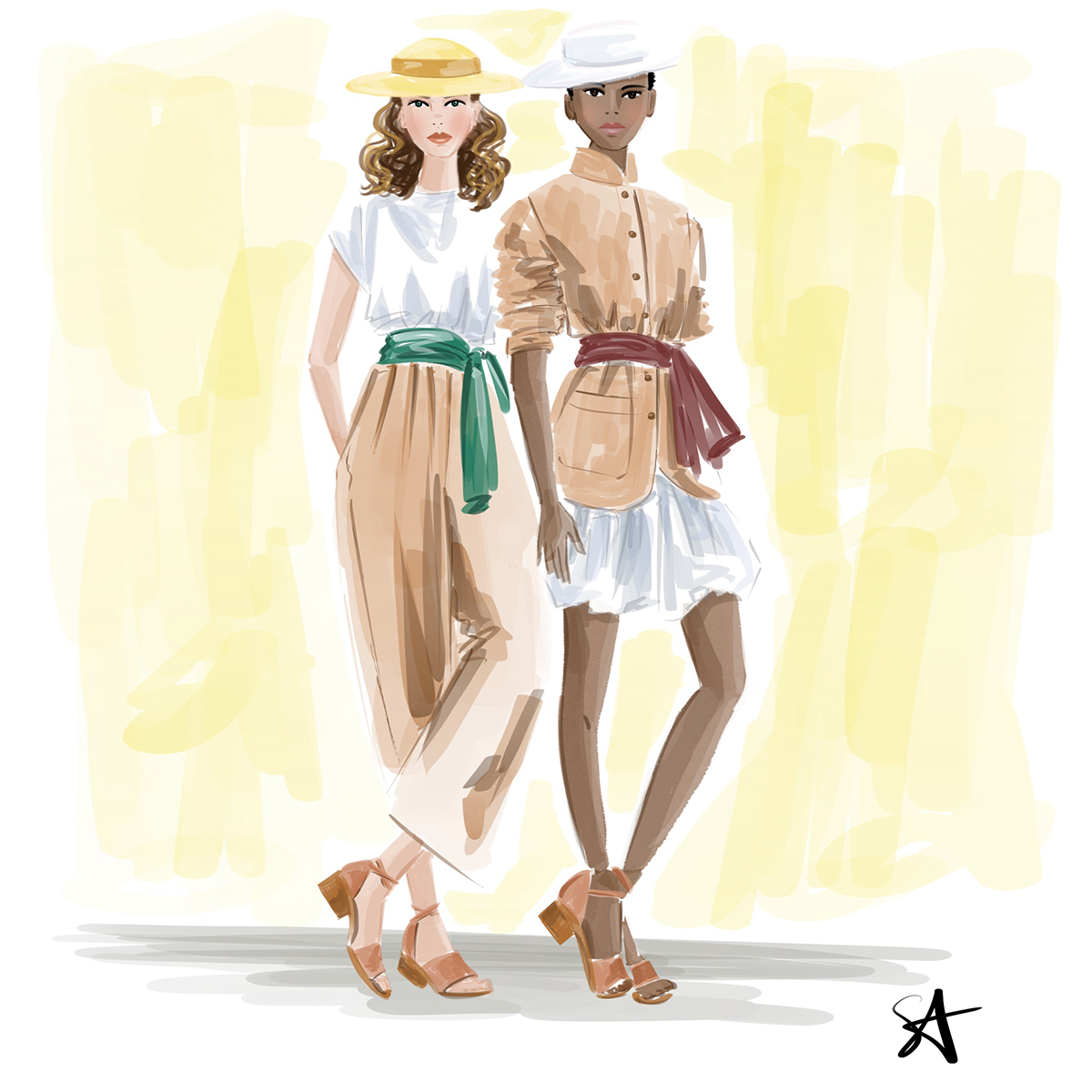
X Baczewska
Before I even moved back to NYC, I made—from a WilliWear Butterick pattern—a pair of jodhpurs with a wide, wrapped waistband. I did them in magenta chintz! Then, when I lived in the East Village, someone directed me to THE WilliWear source—an Indian clothing store called the Dress Shoppe on 9th Street, where I met the lovely (recently deceased) Goyal and bought a WilliWear black ankle-length jumpsuit. I wore it for years with Norma Kamali socks (from Daffy’s when they were in Elizabeth, NJ) and my orthopedic, Cuban-heeled, lace-up peep-toe grannies ($10 from Eneslow). Those were the days.
 X Baczewska illustration of jodhpurs made using a Willi Smith for Butterick pattern
X Baczewska illustration of jodhpurs made using a Willi Smith for Butterick pattern
